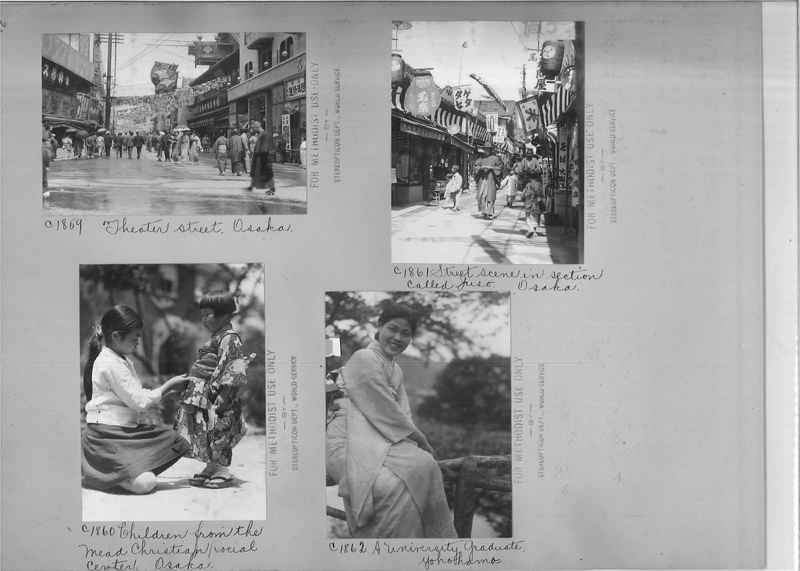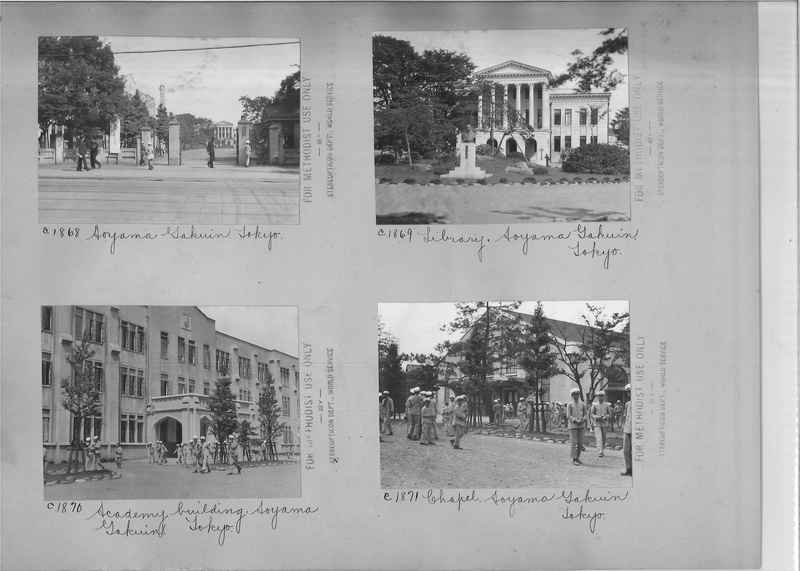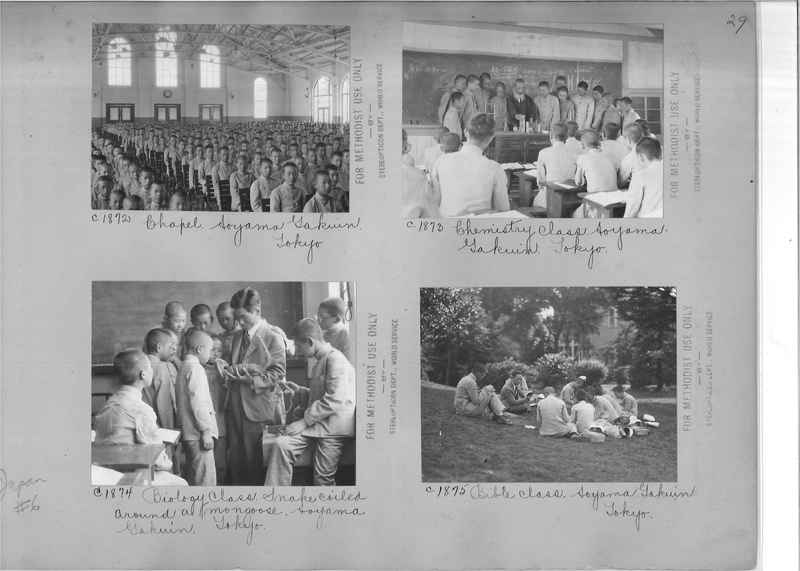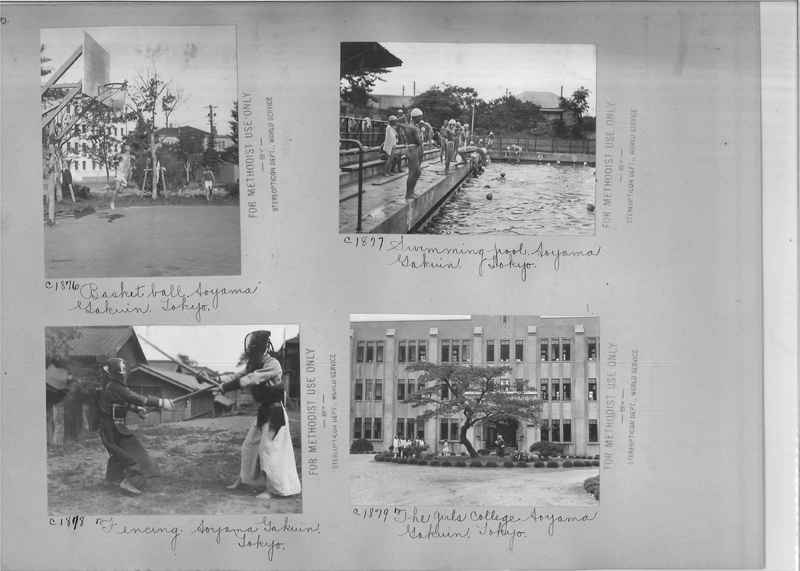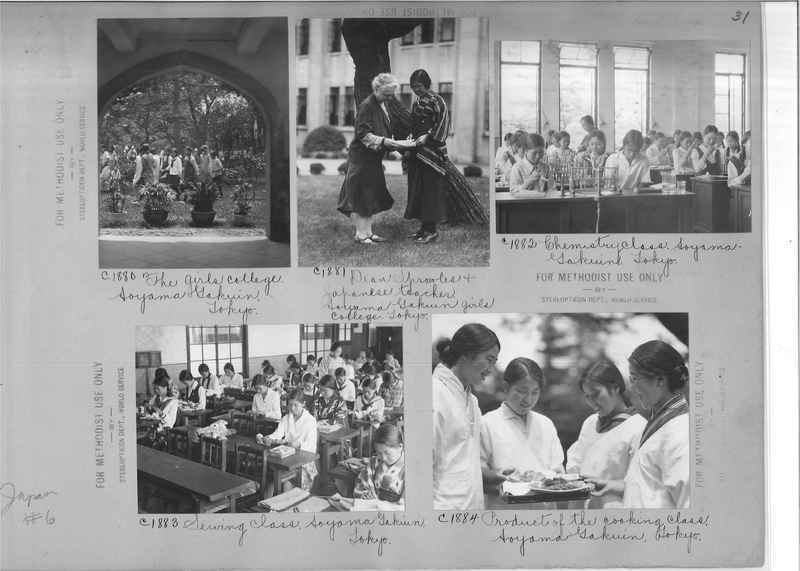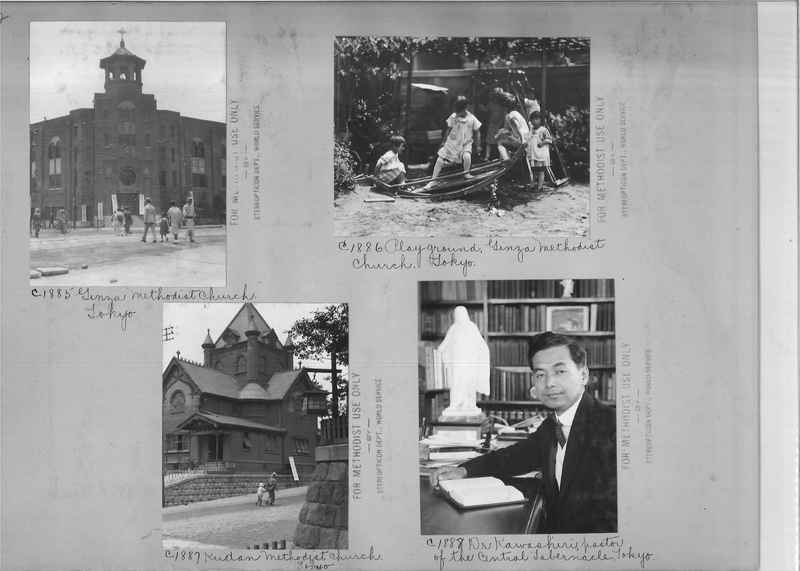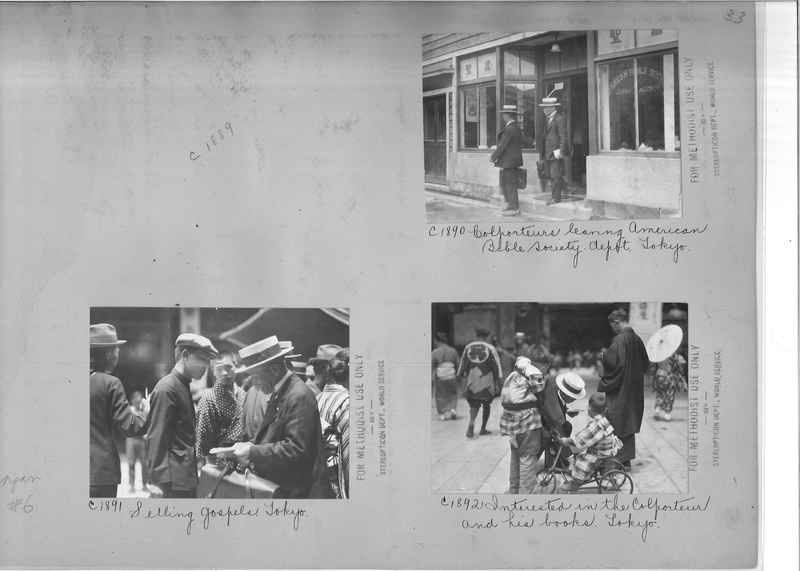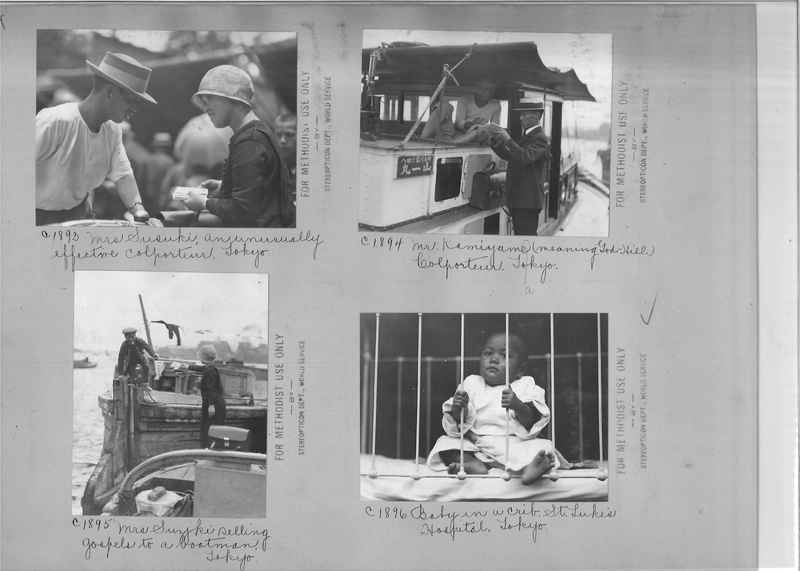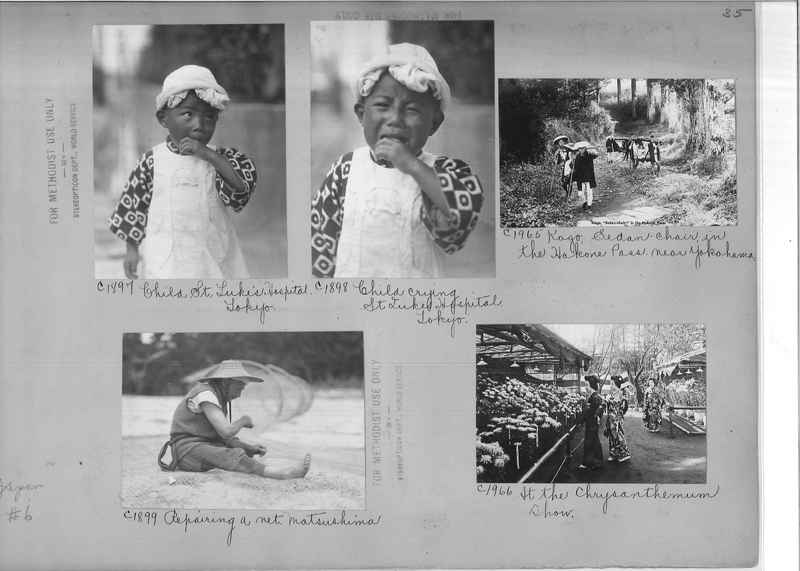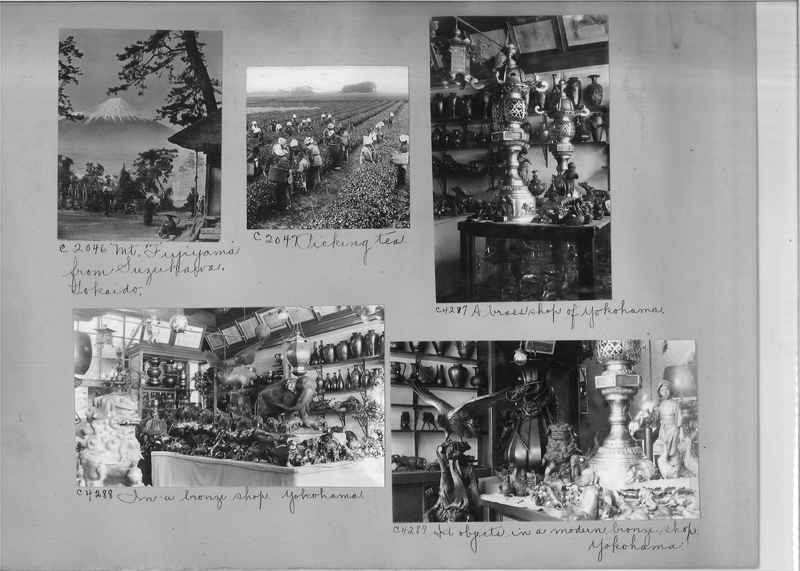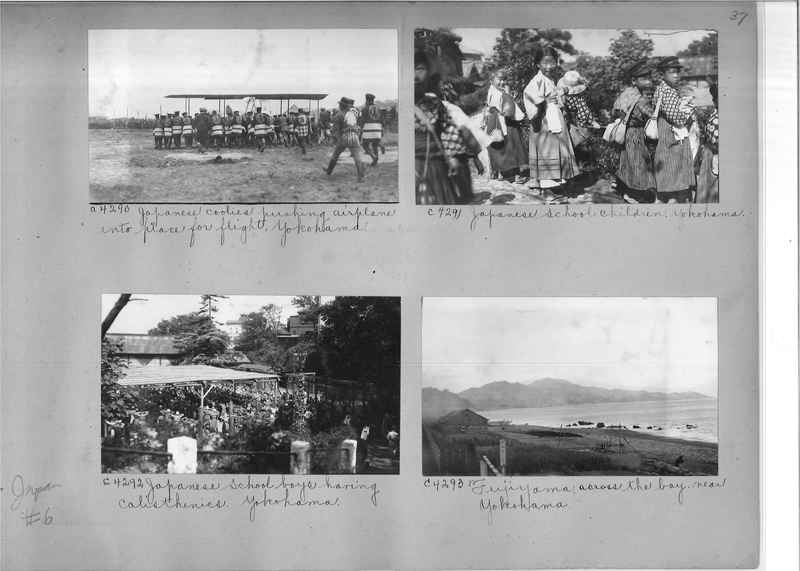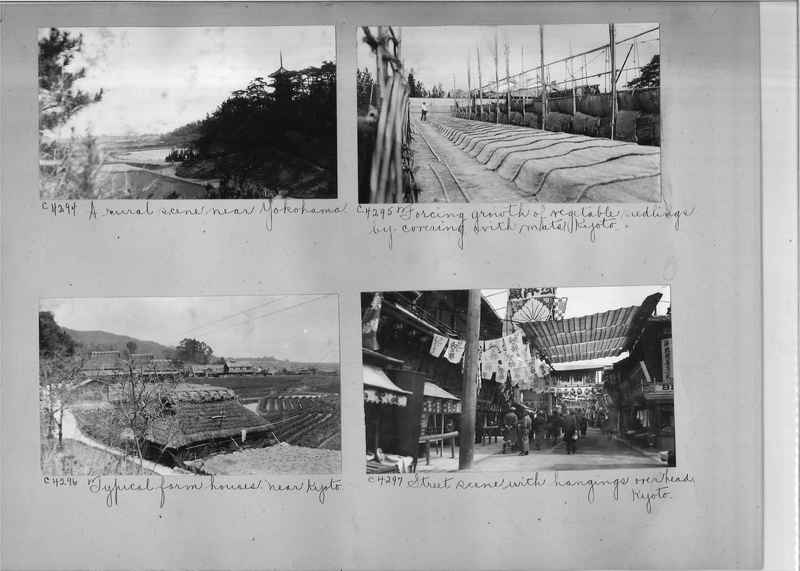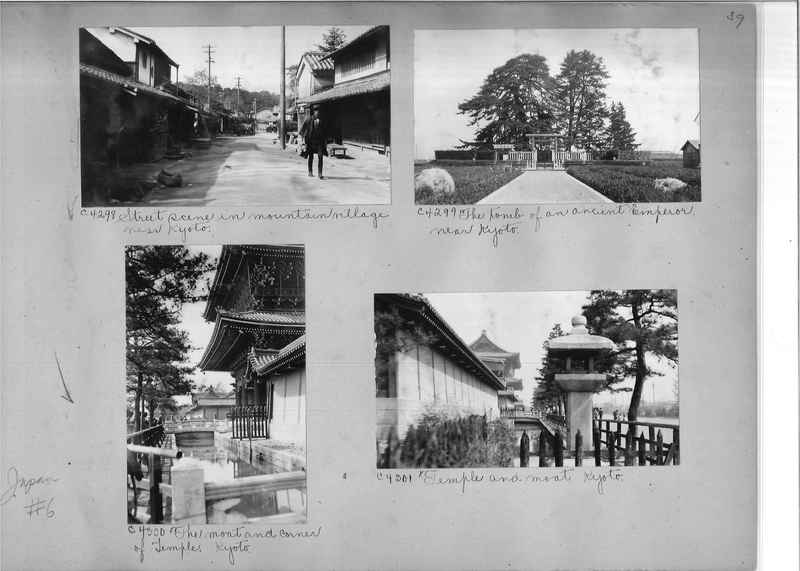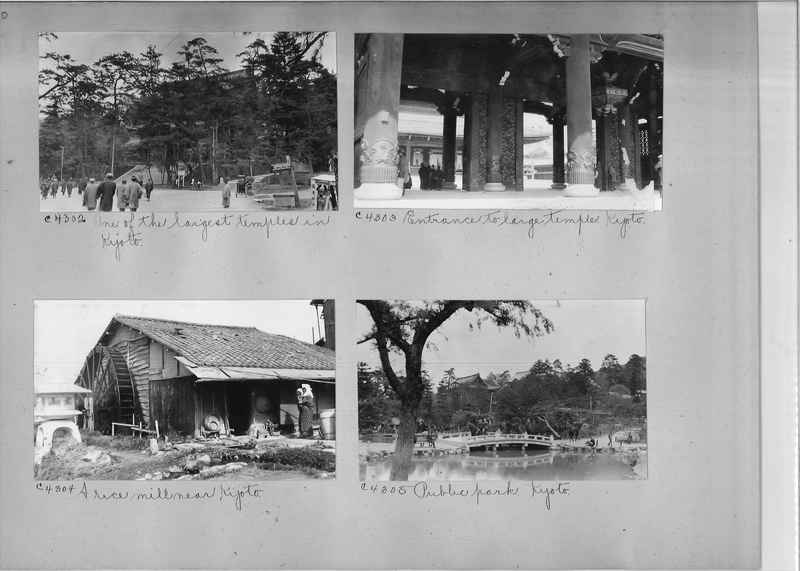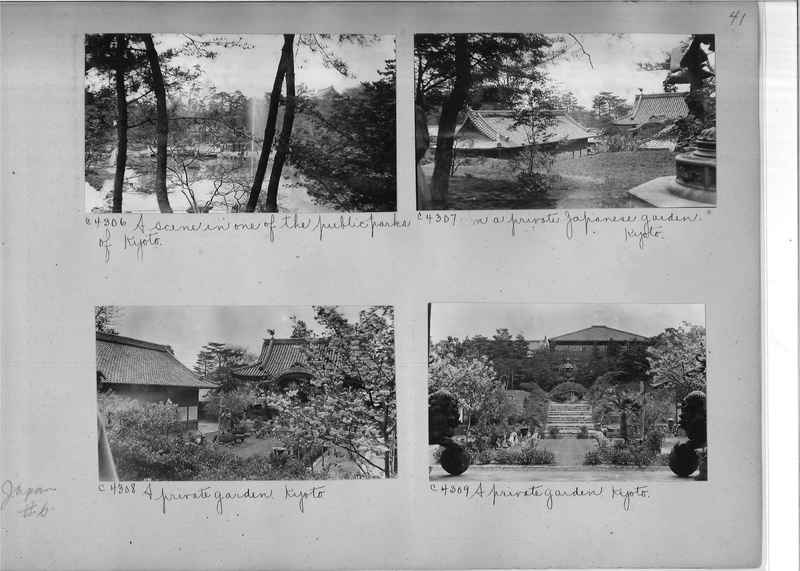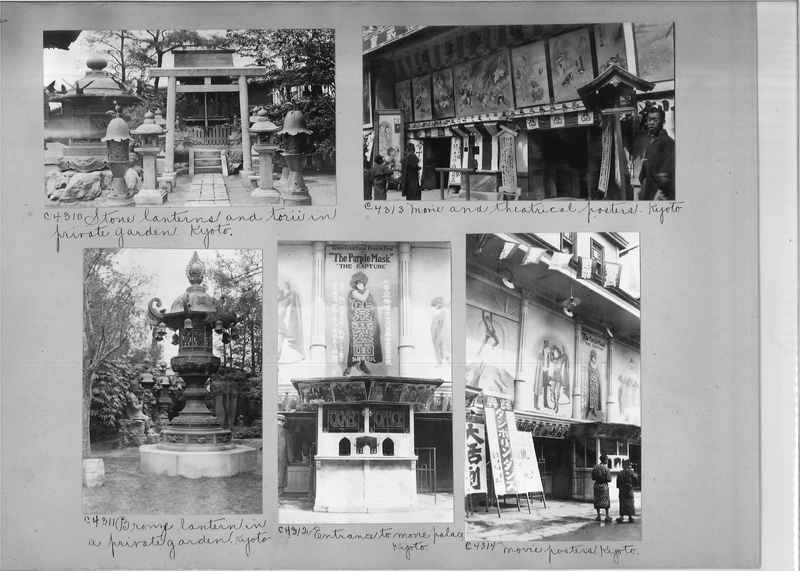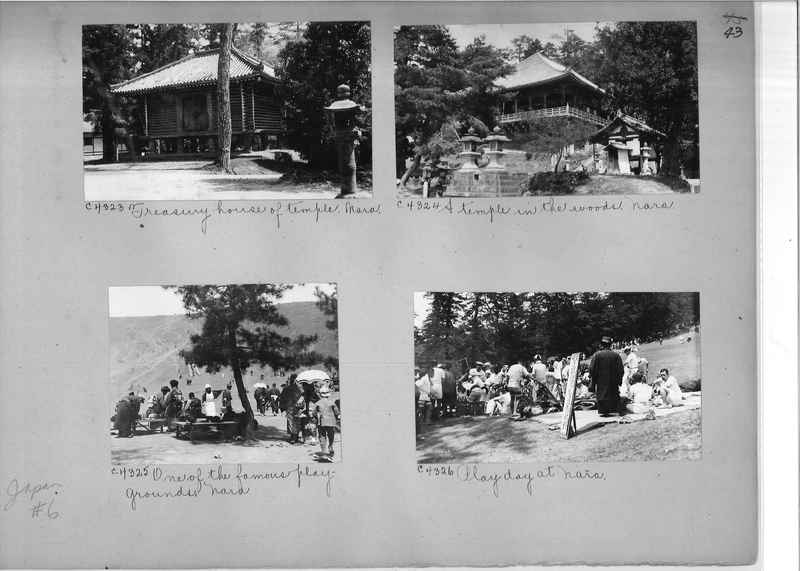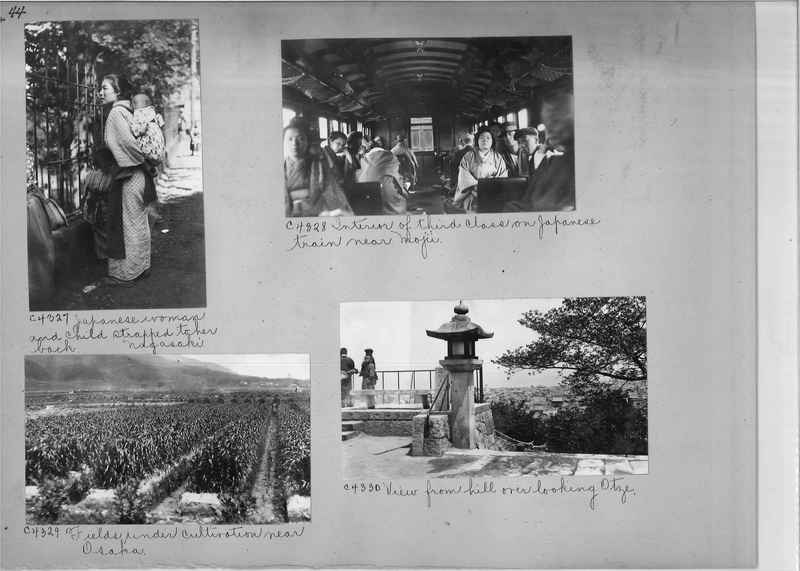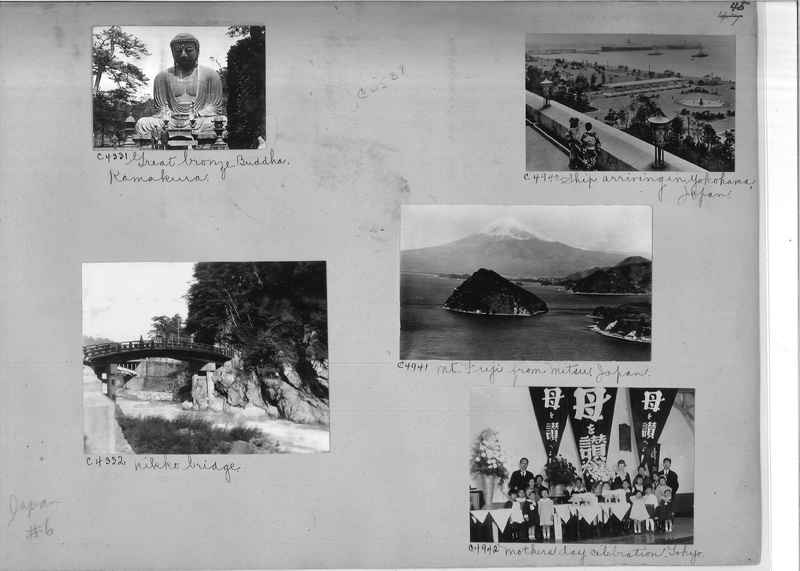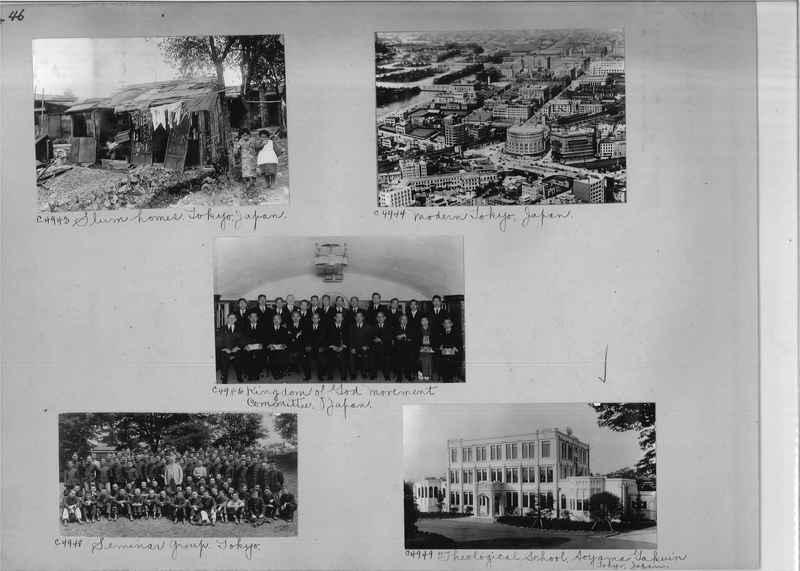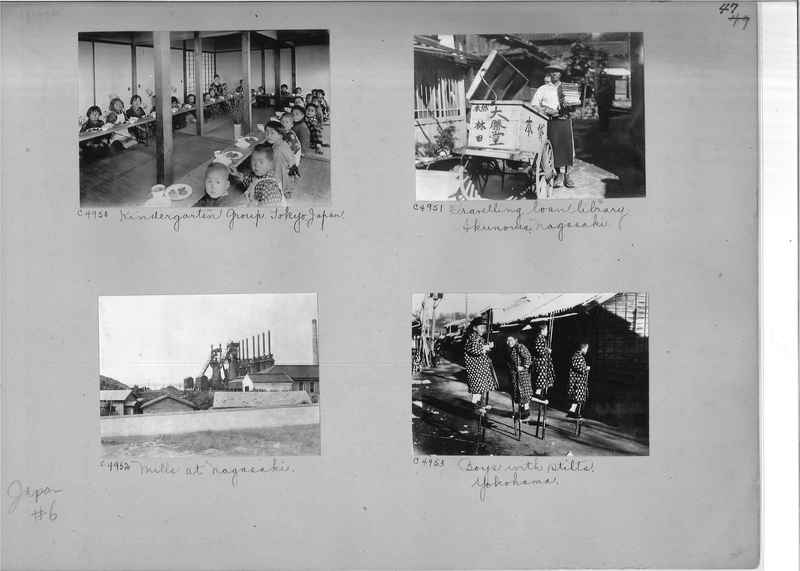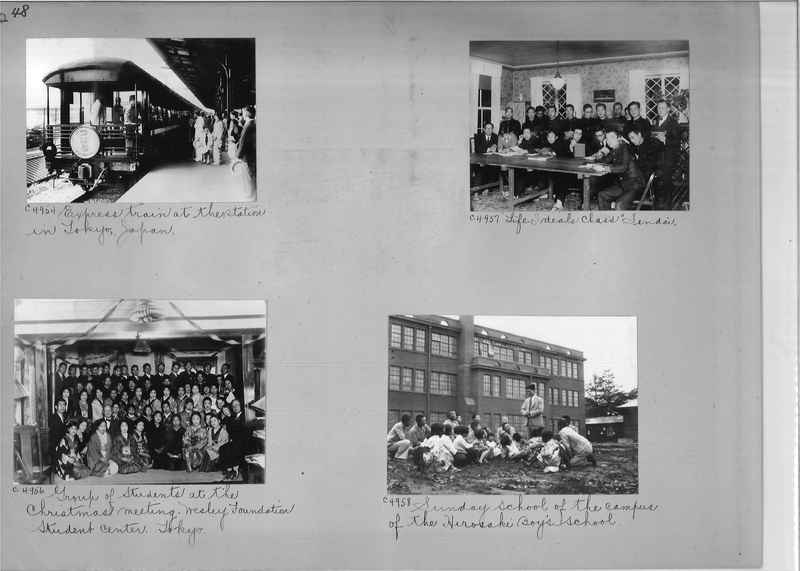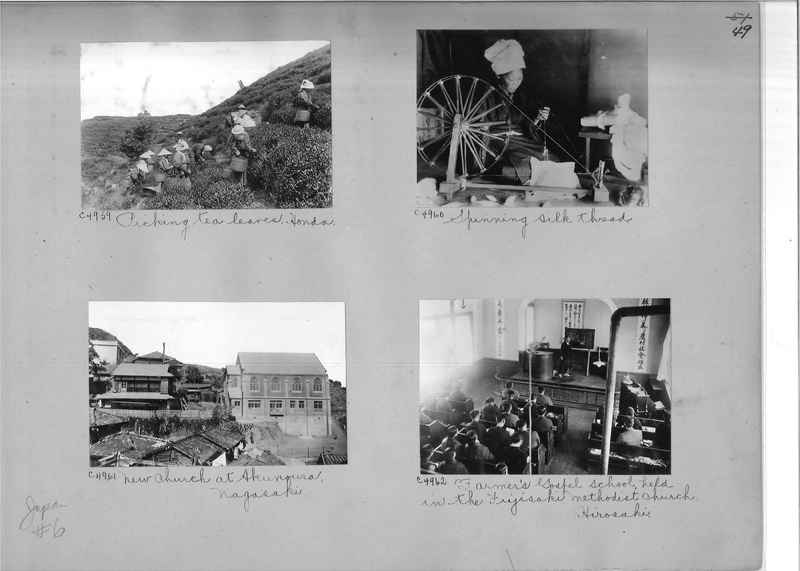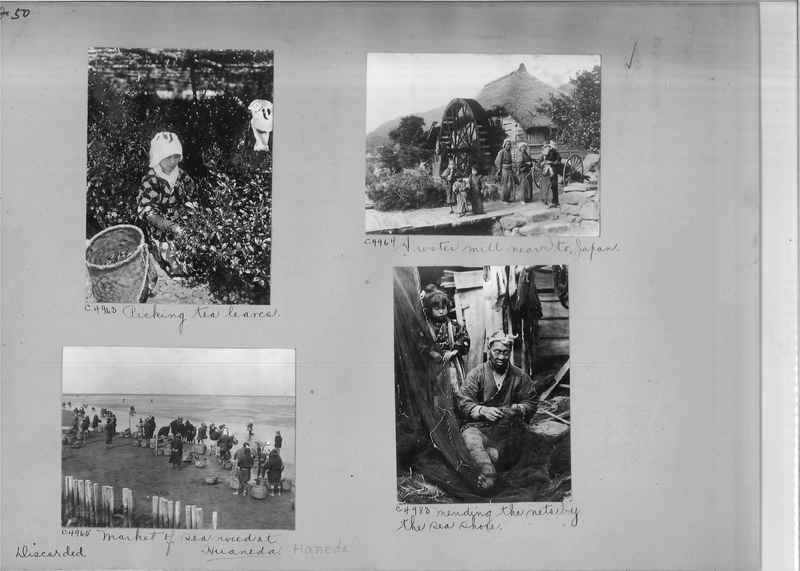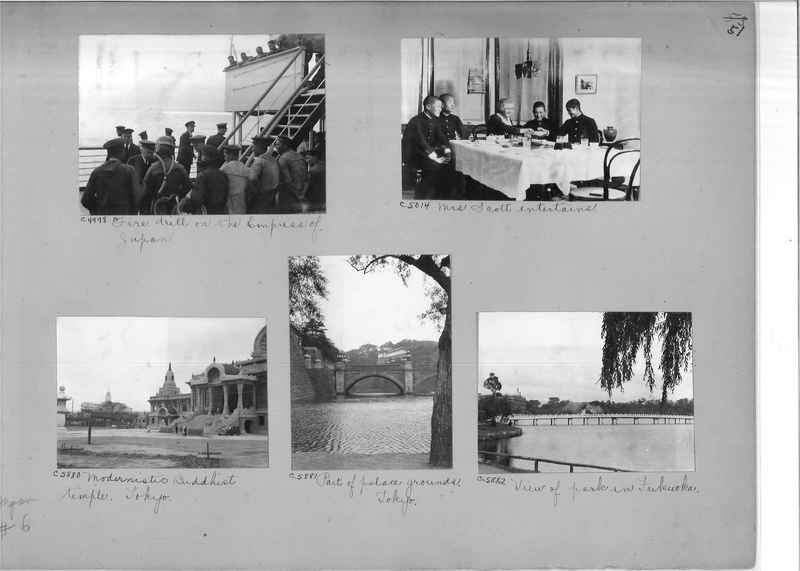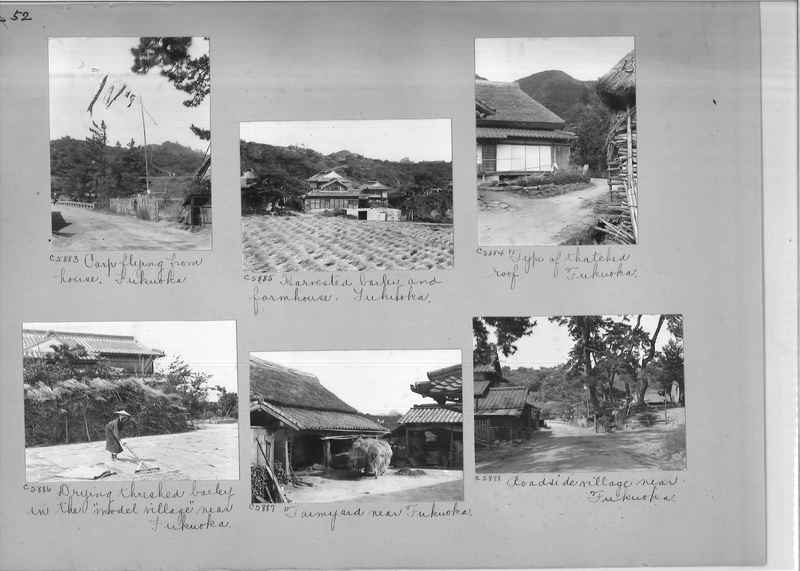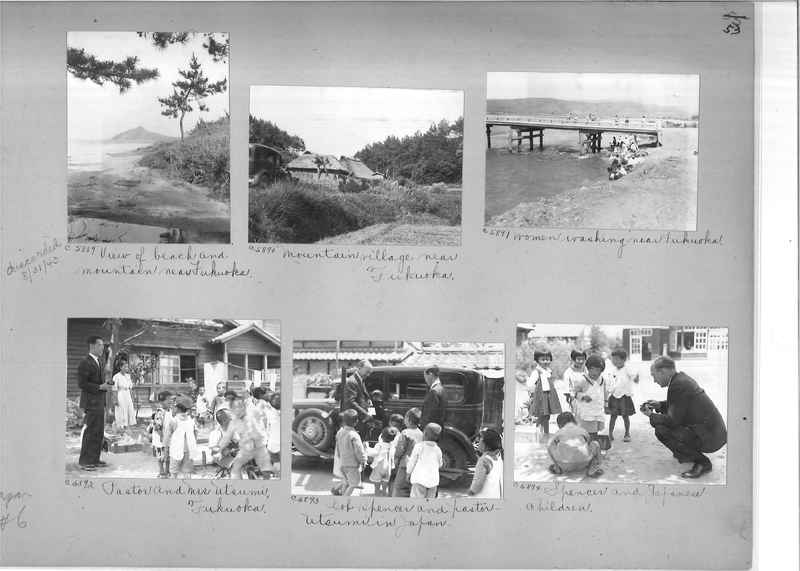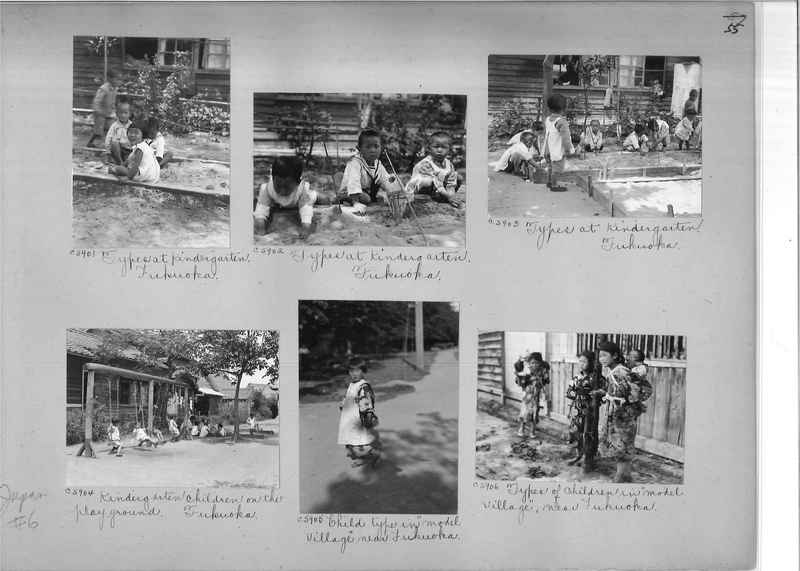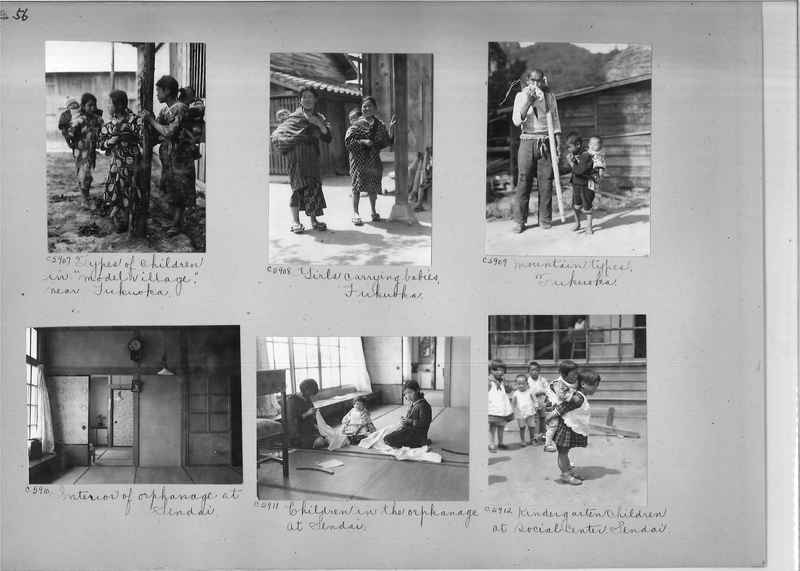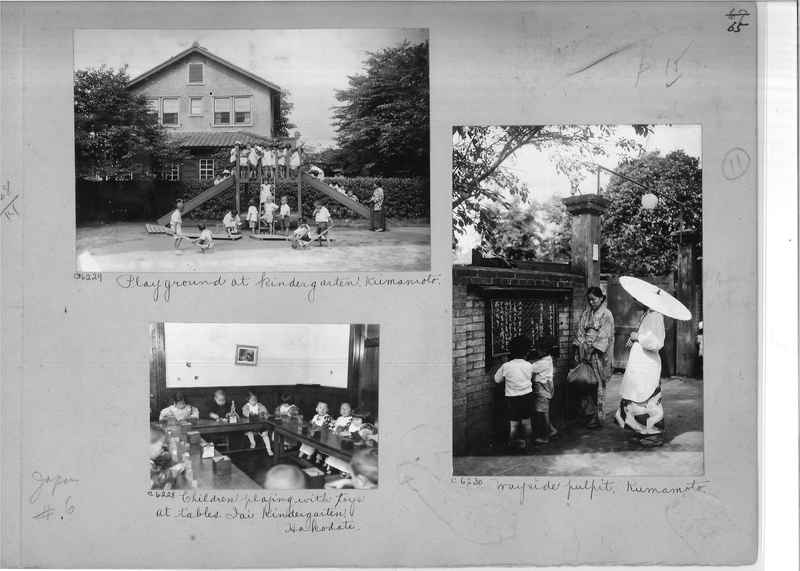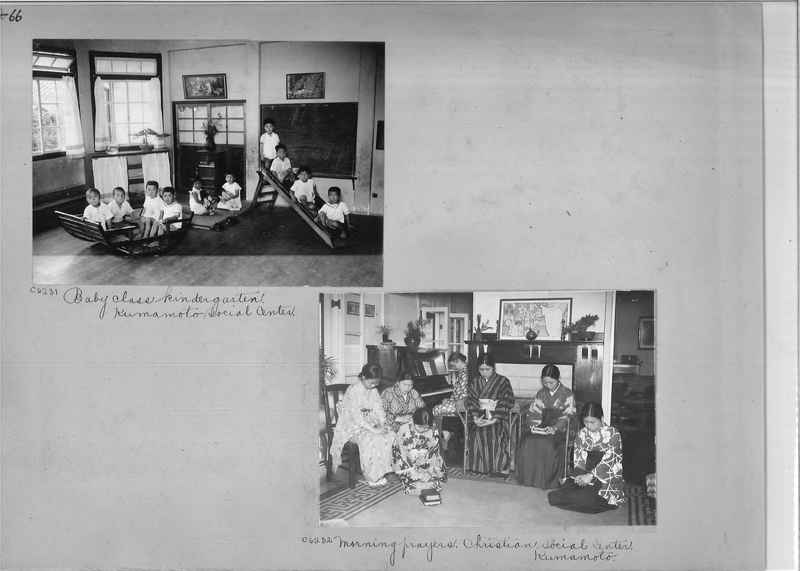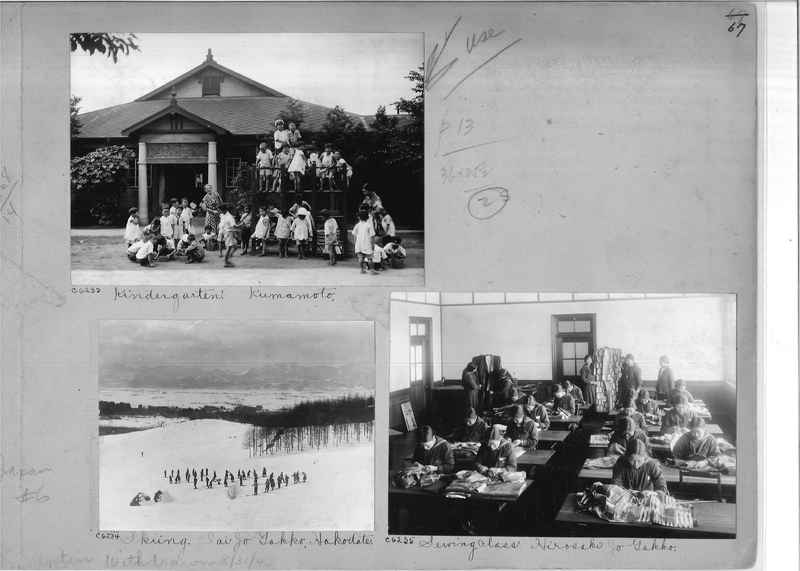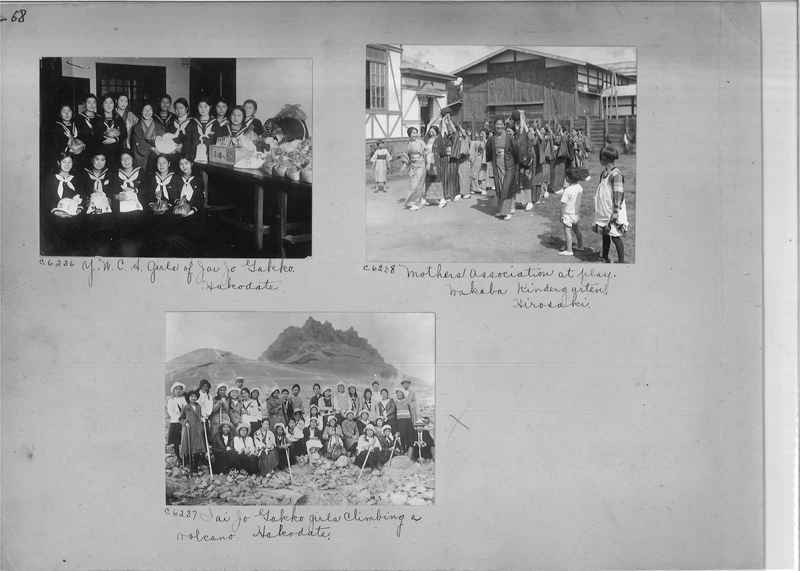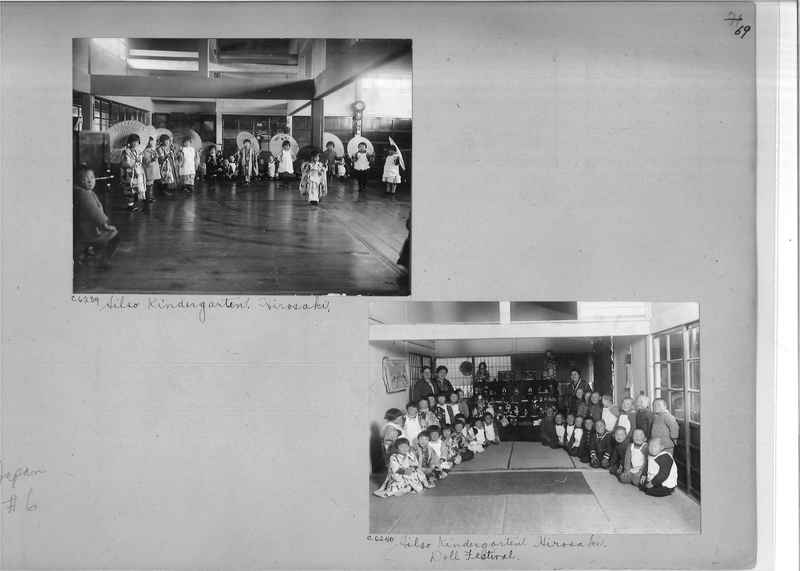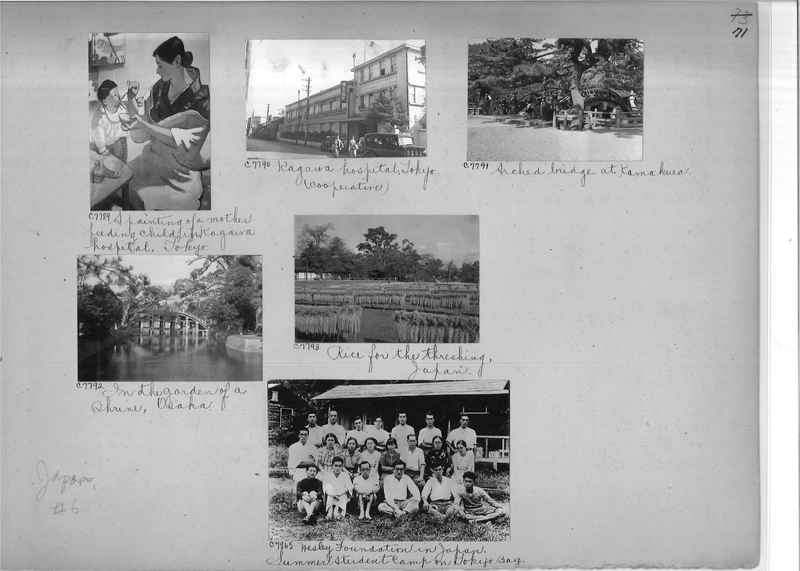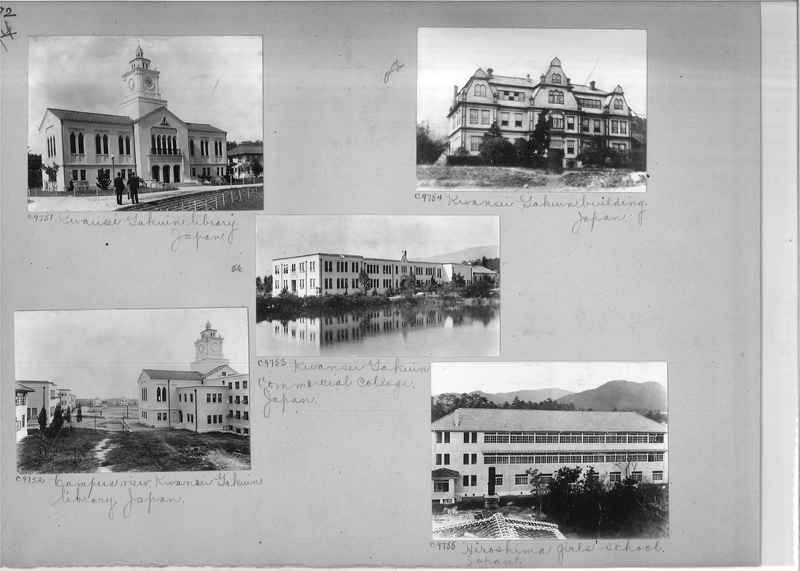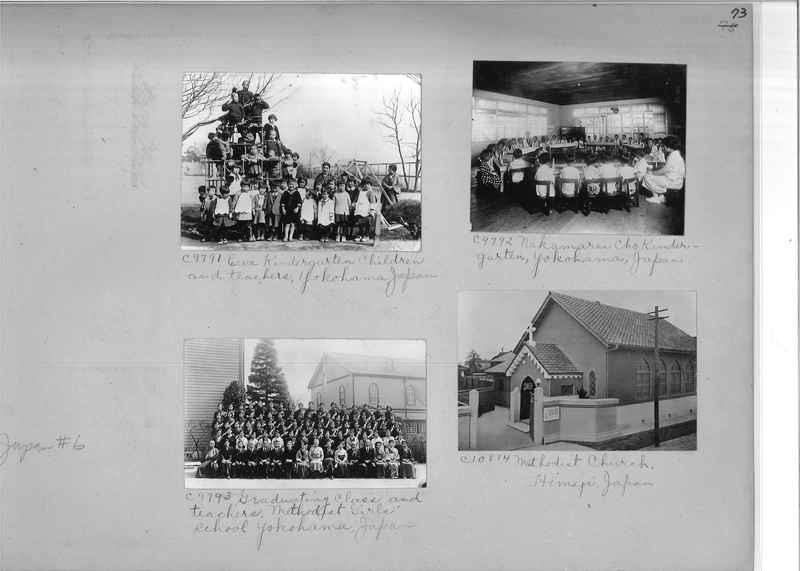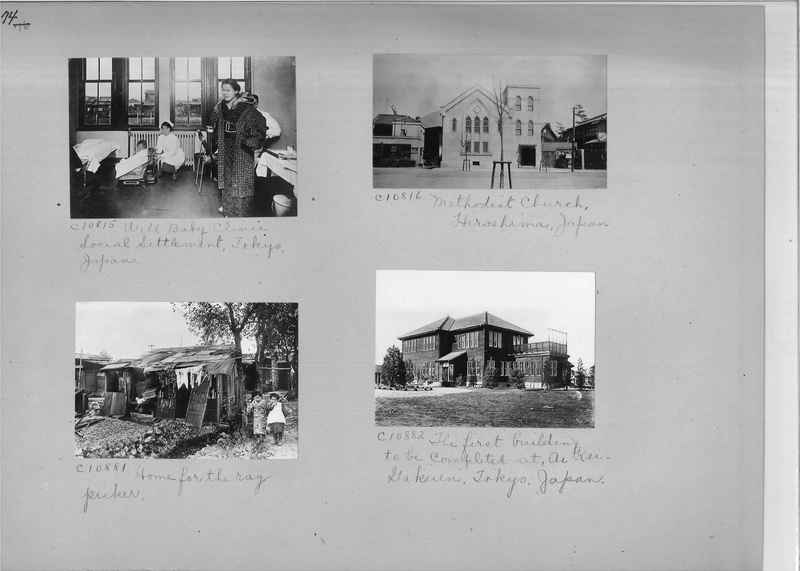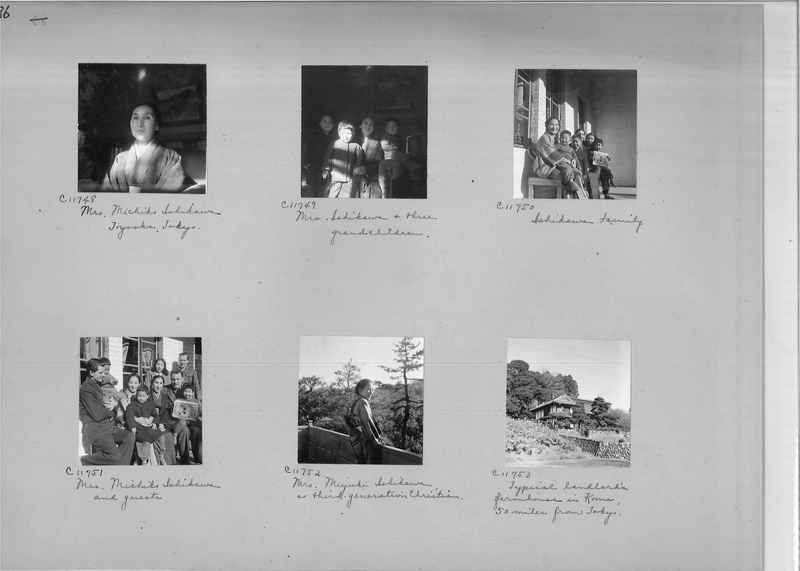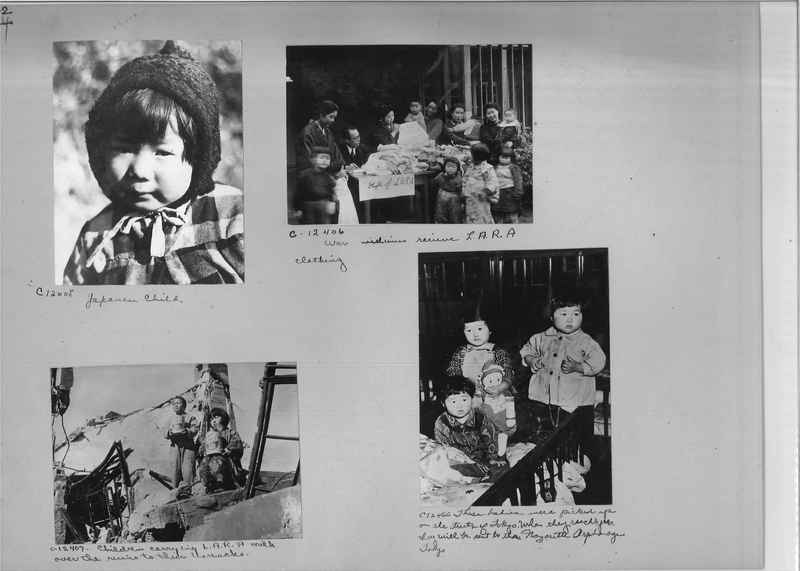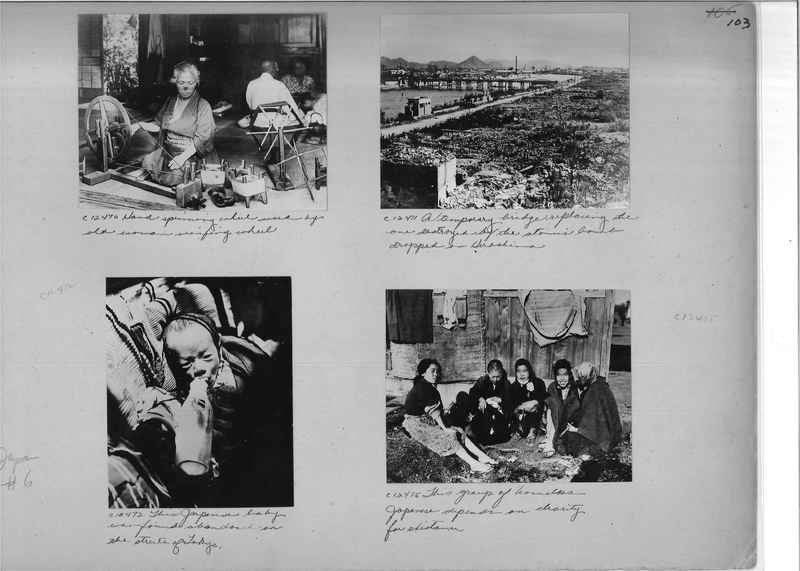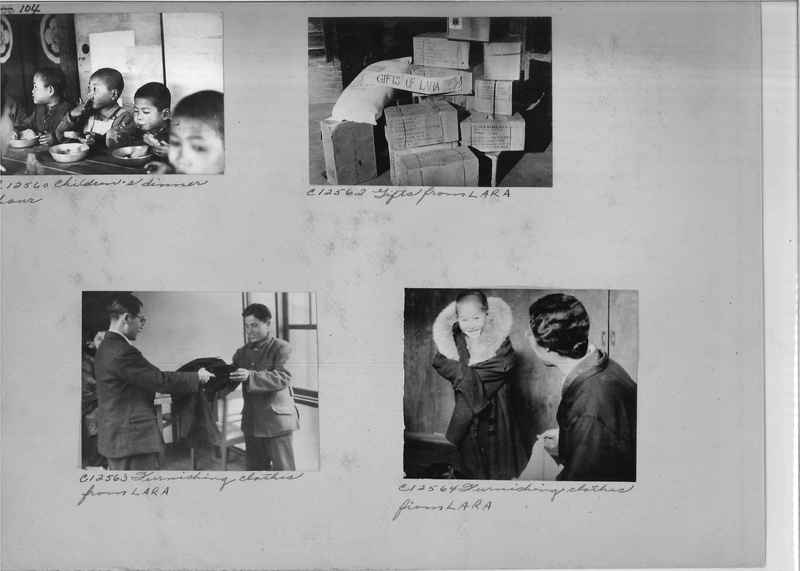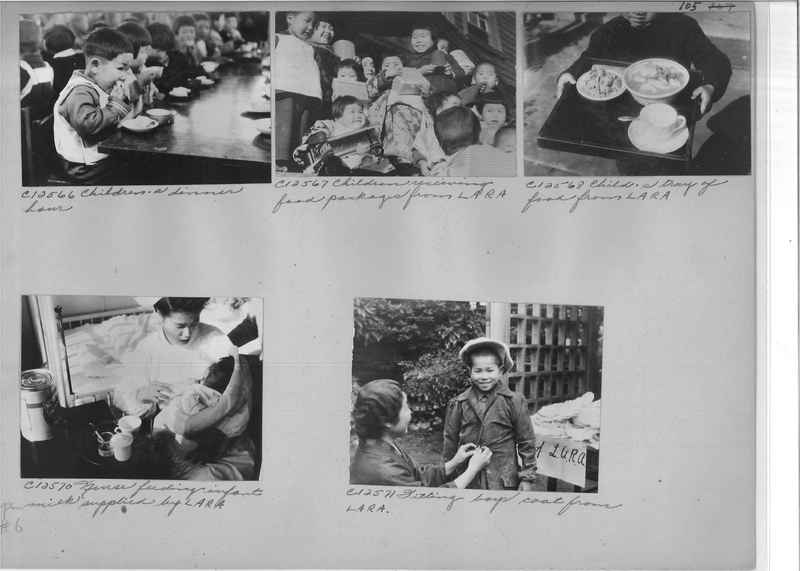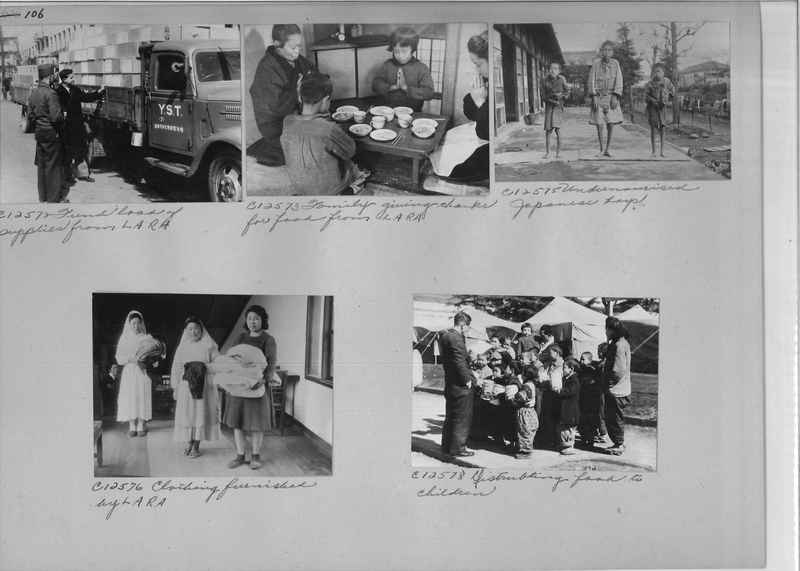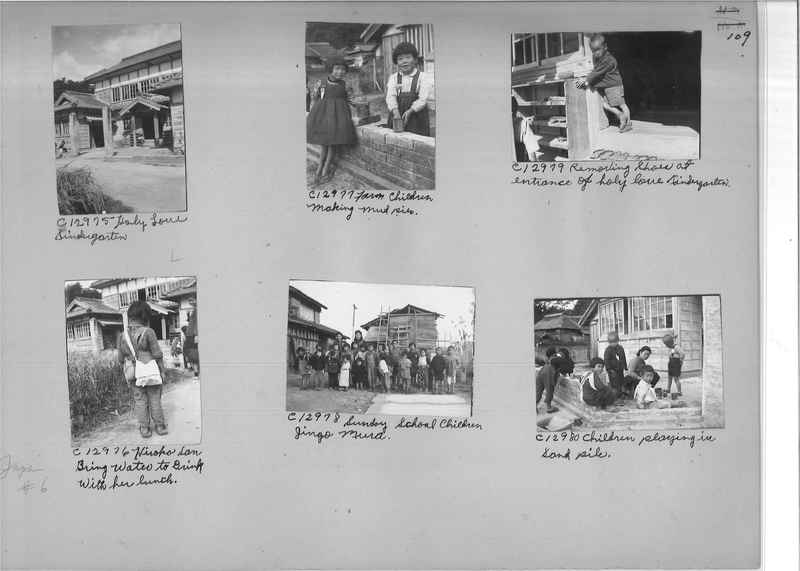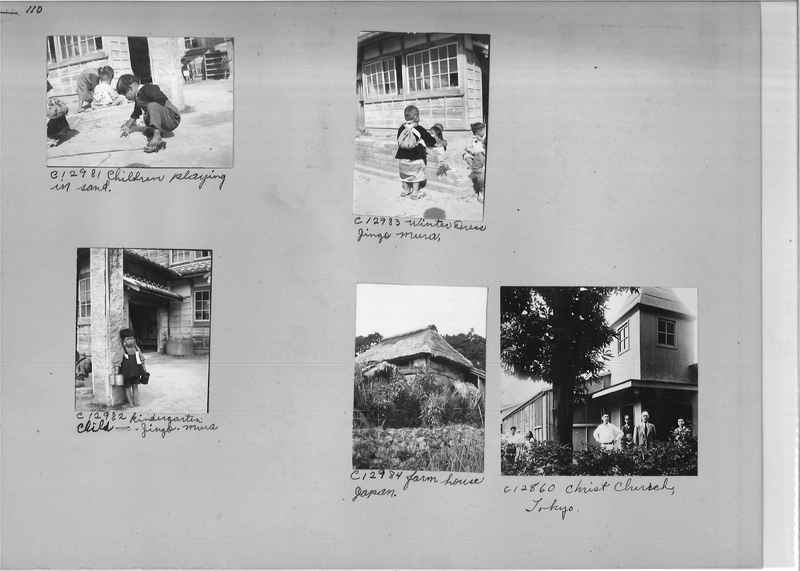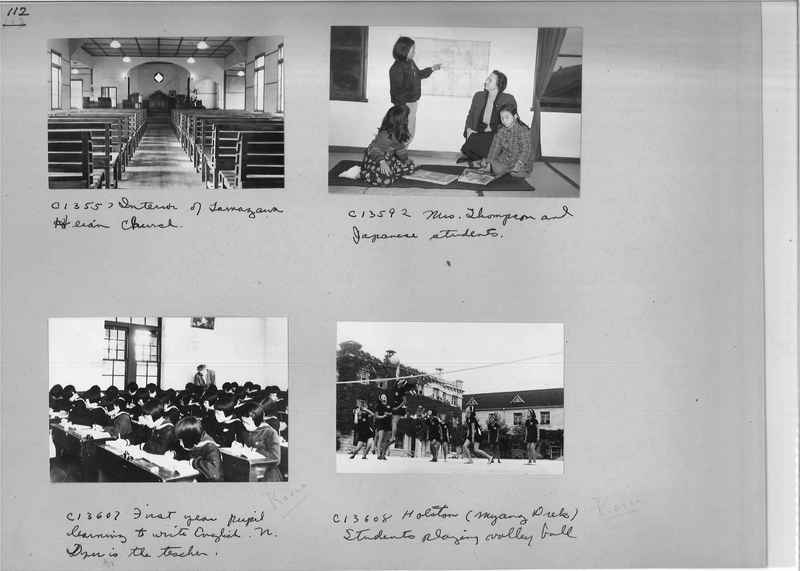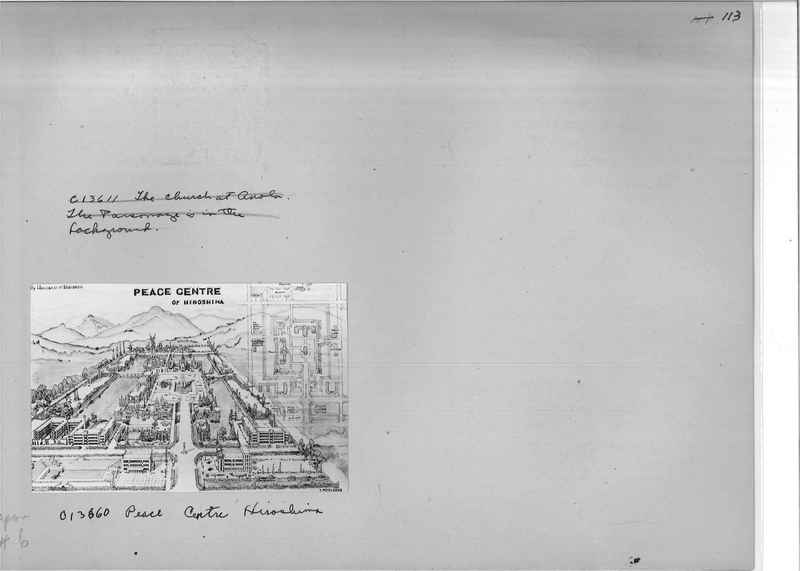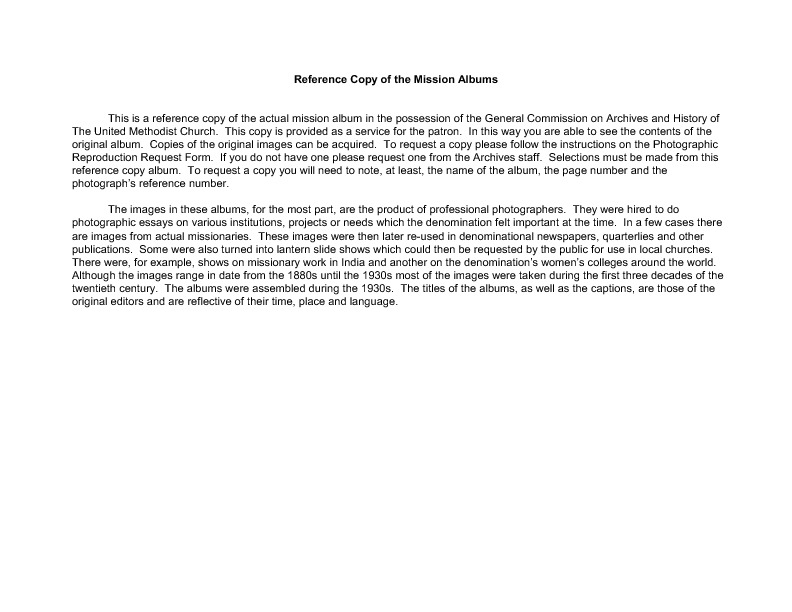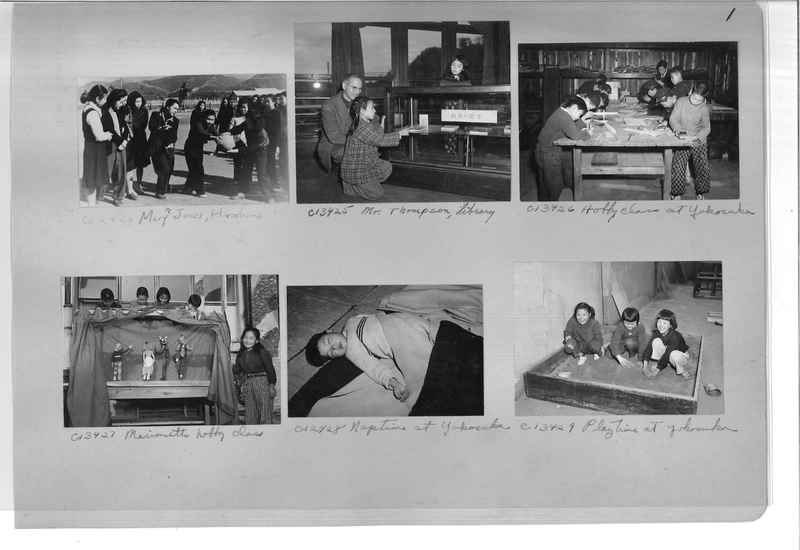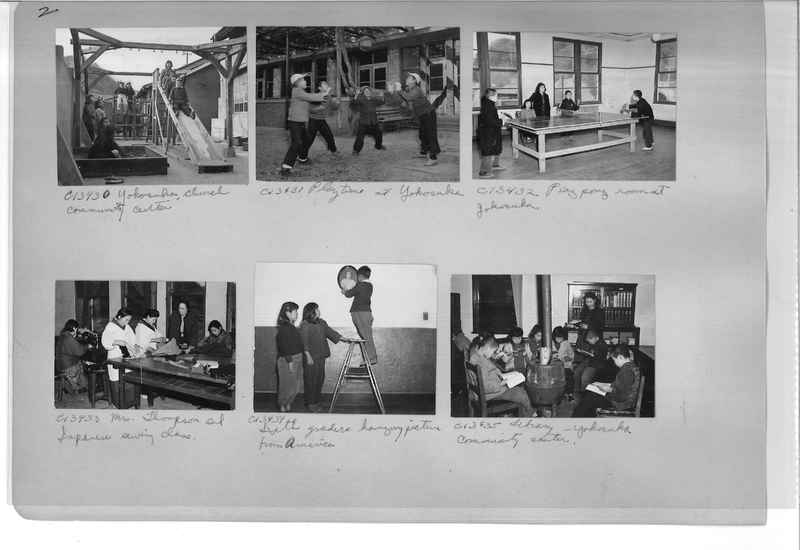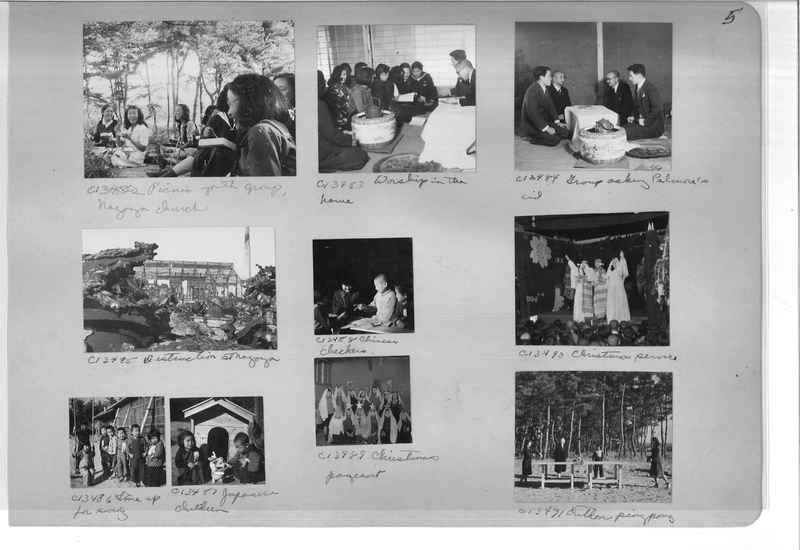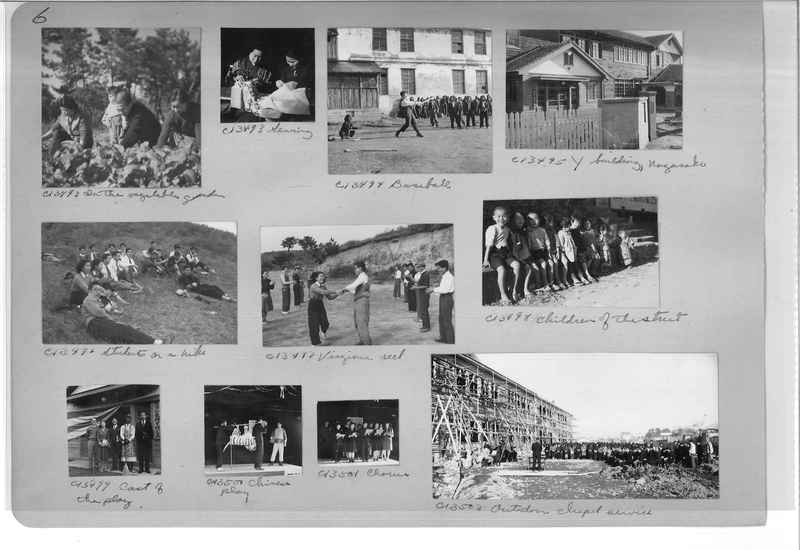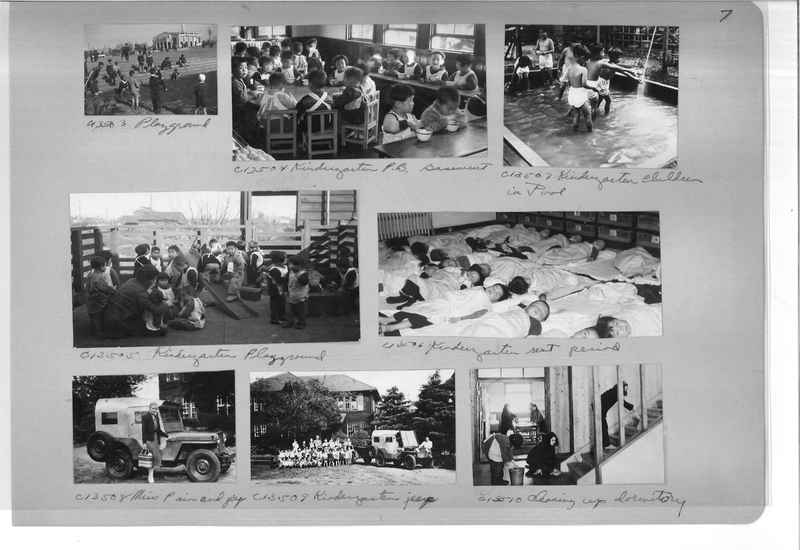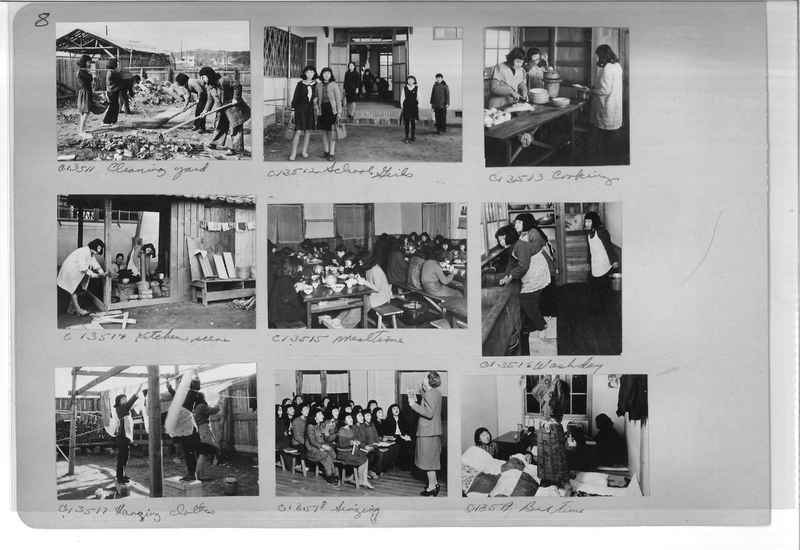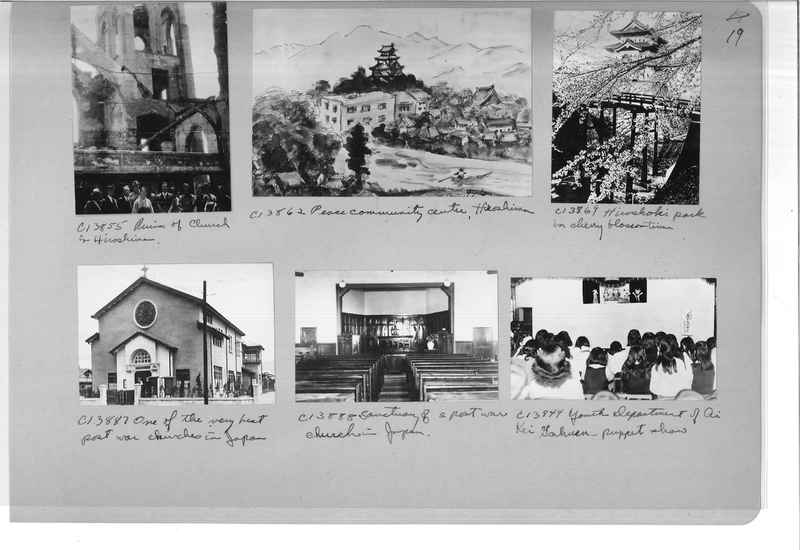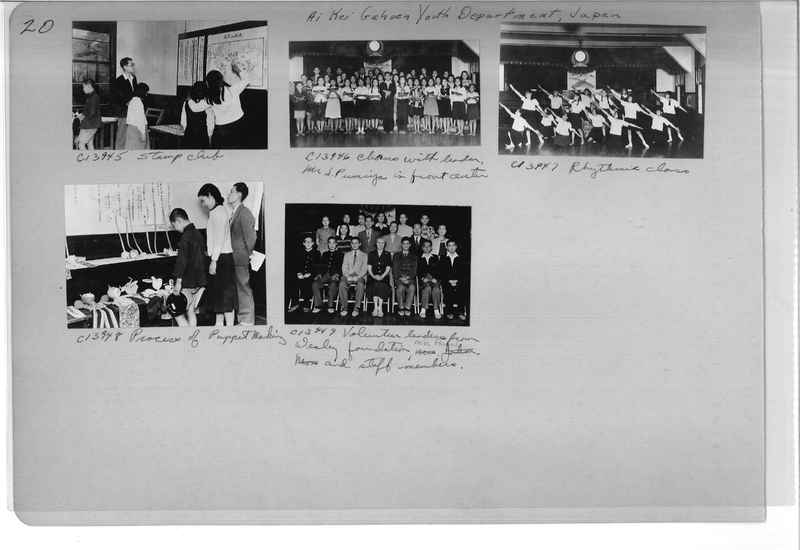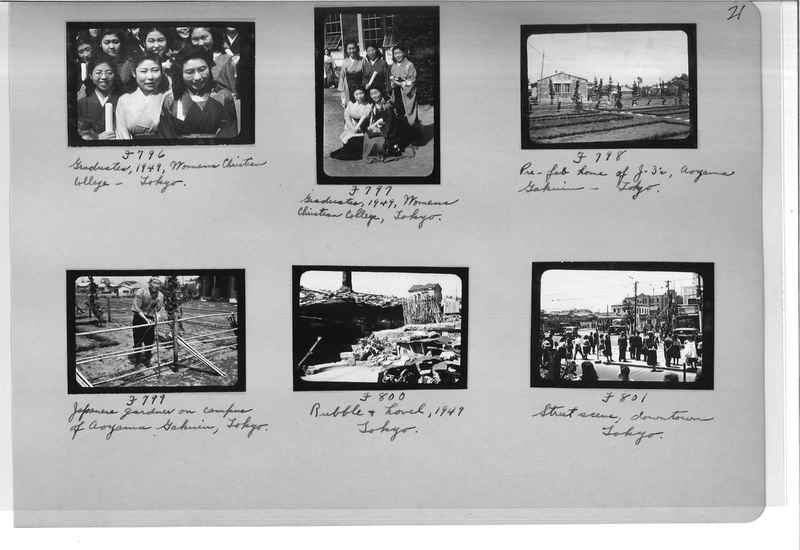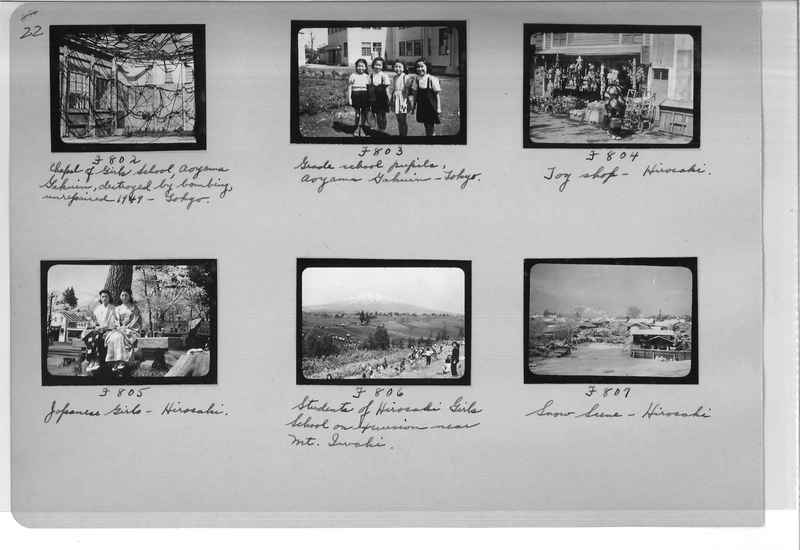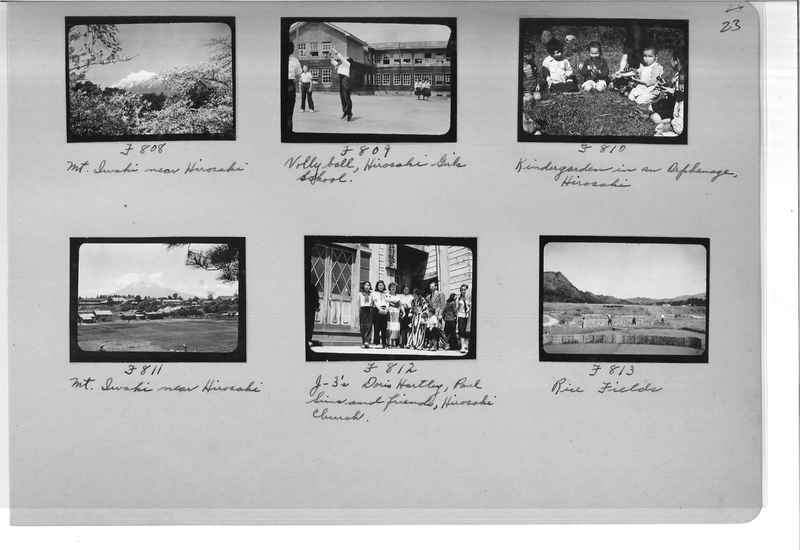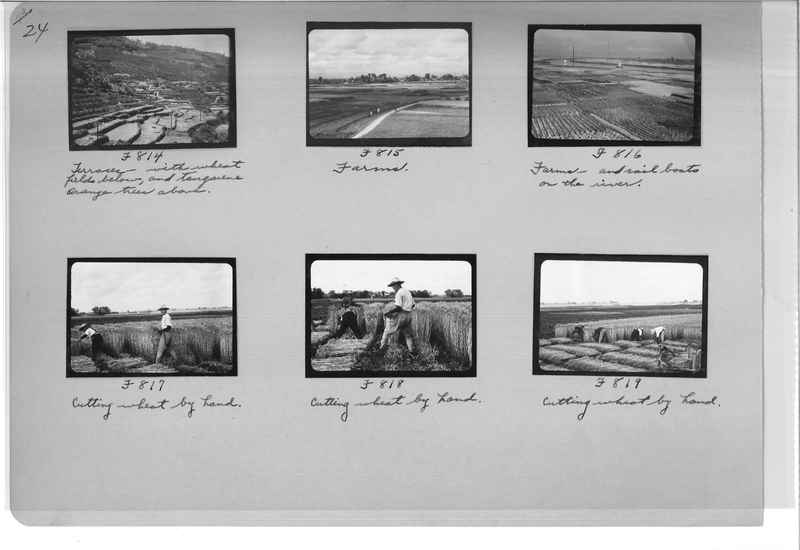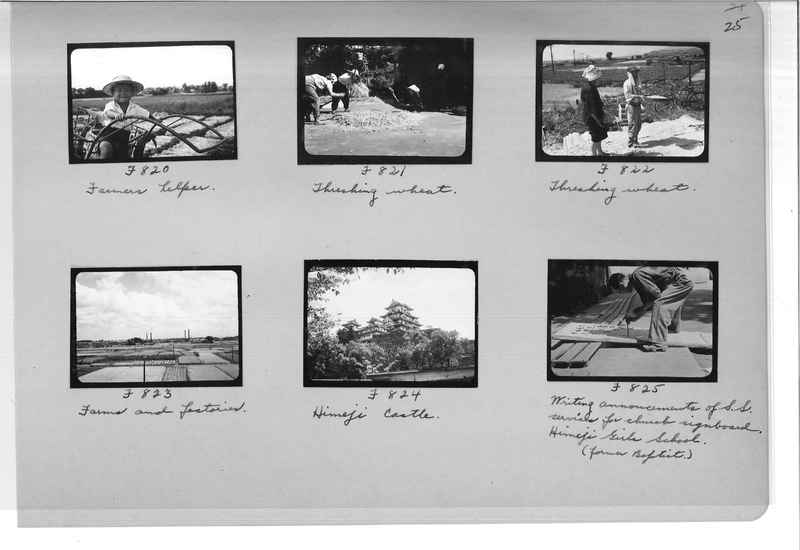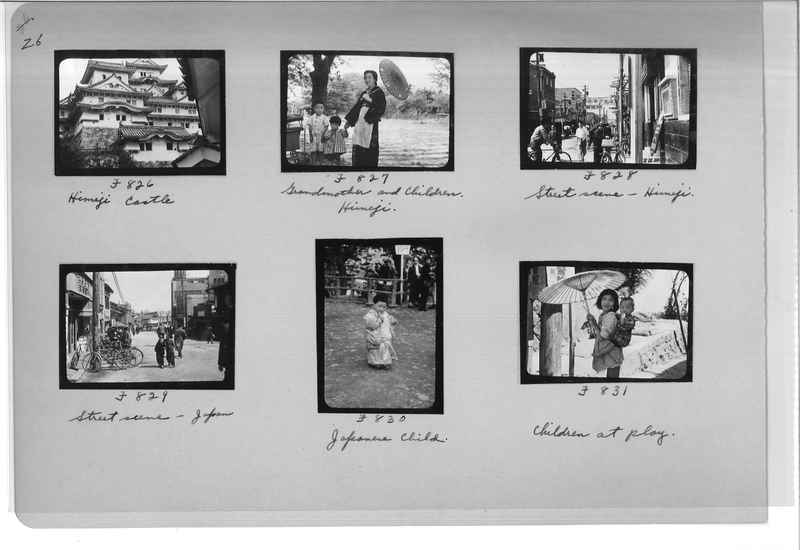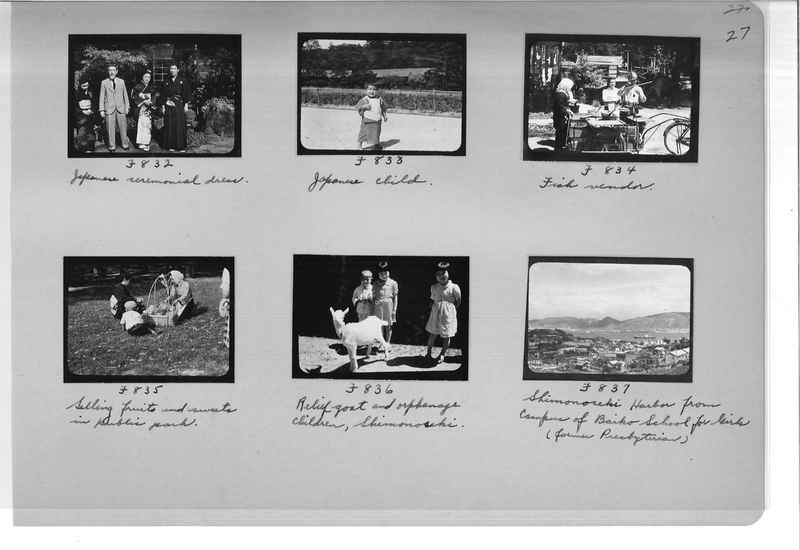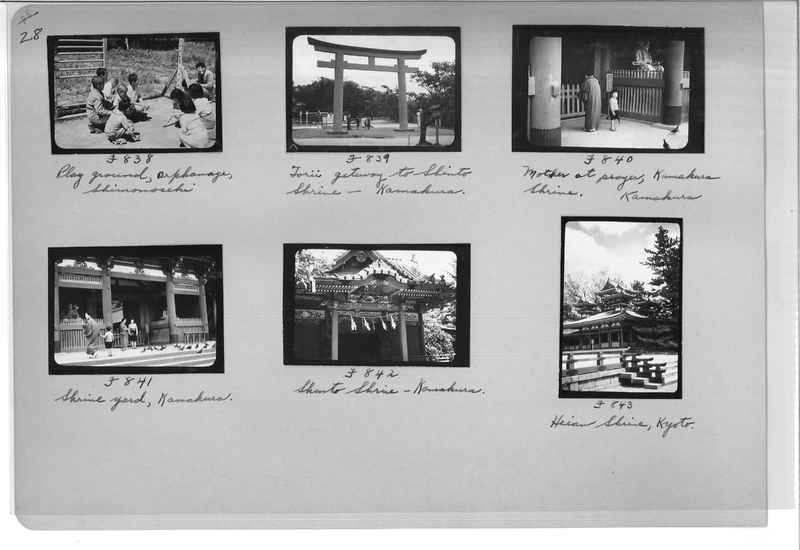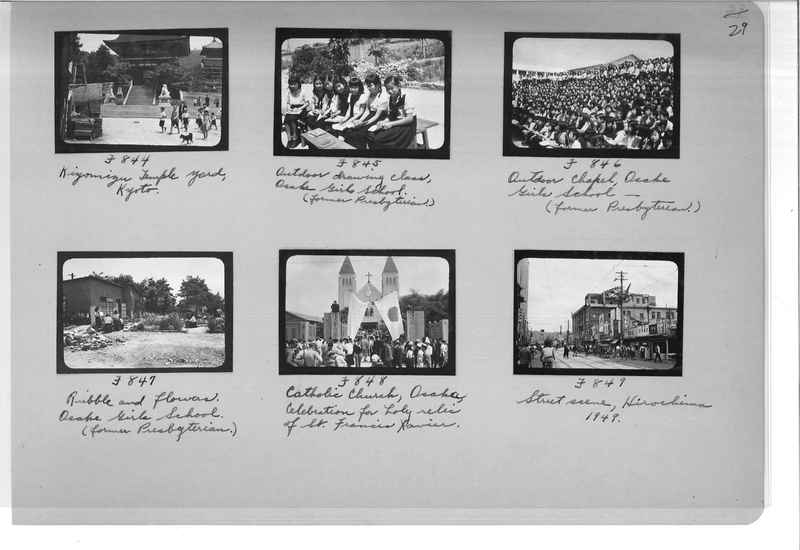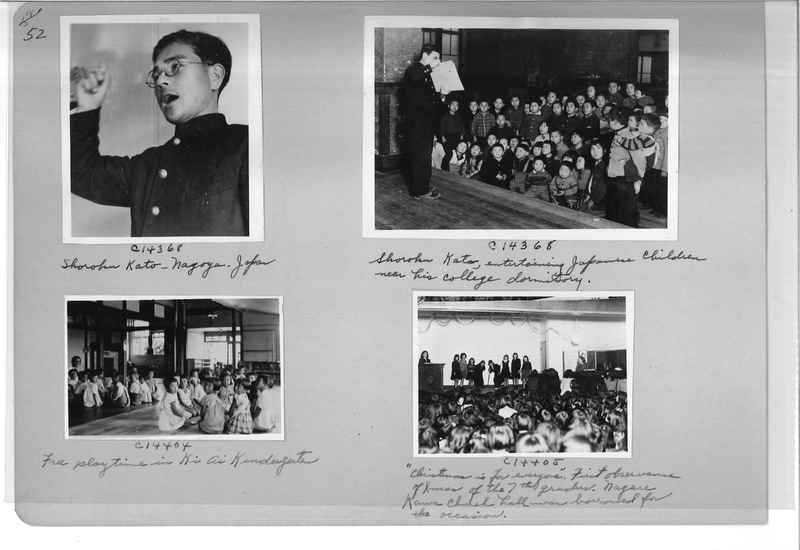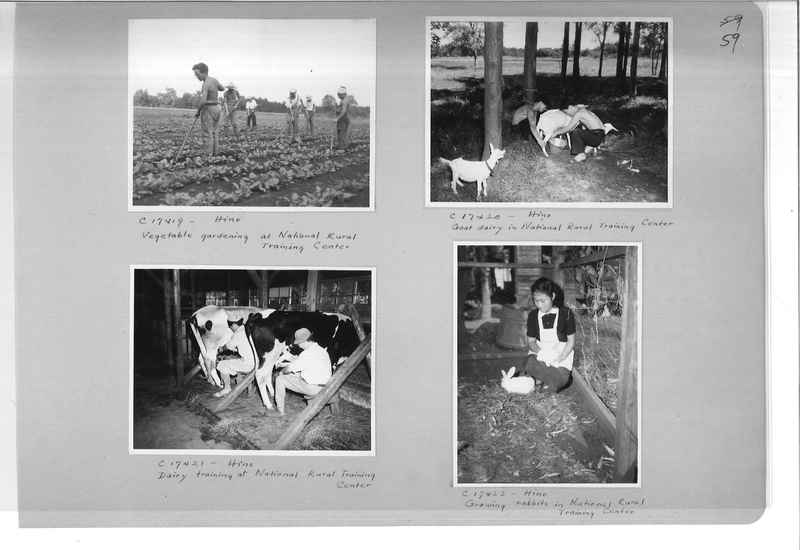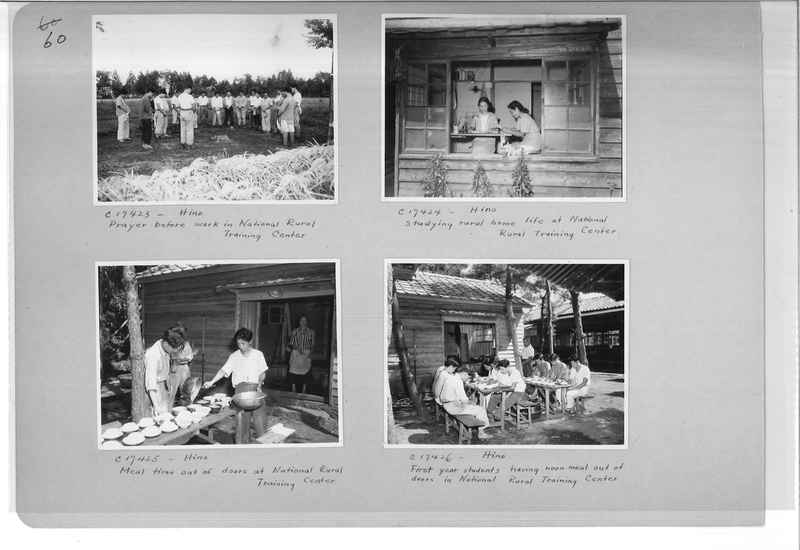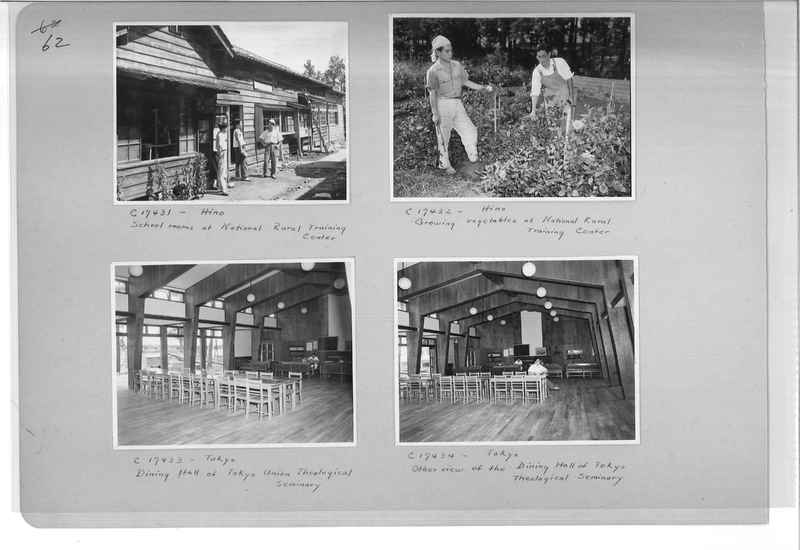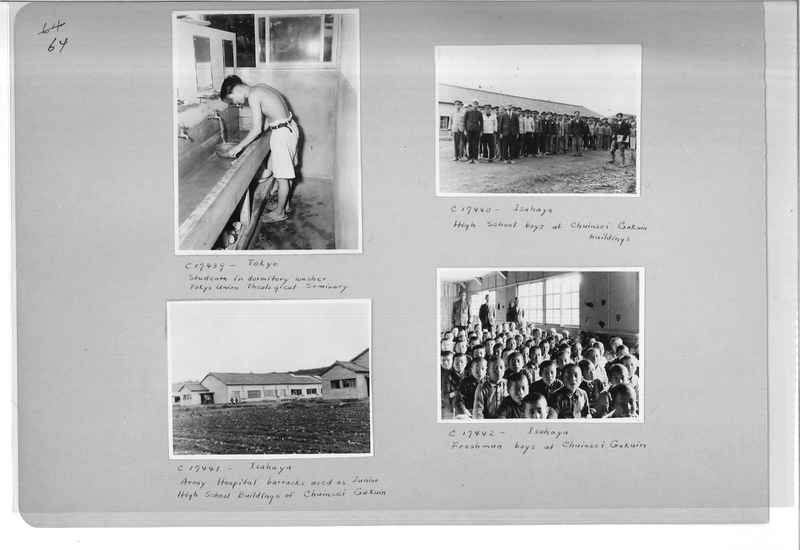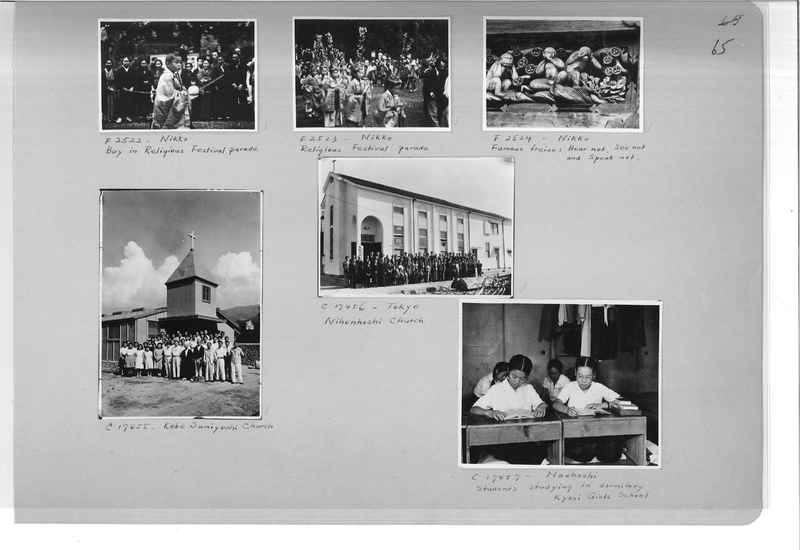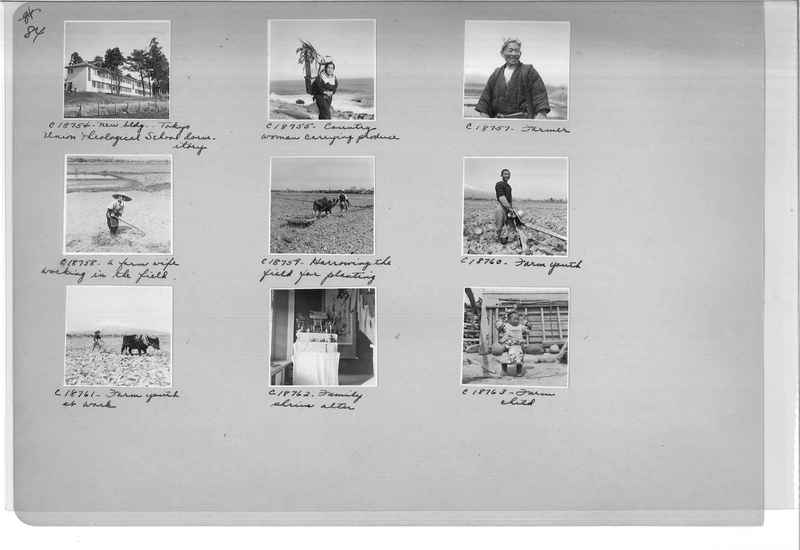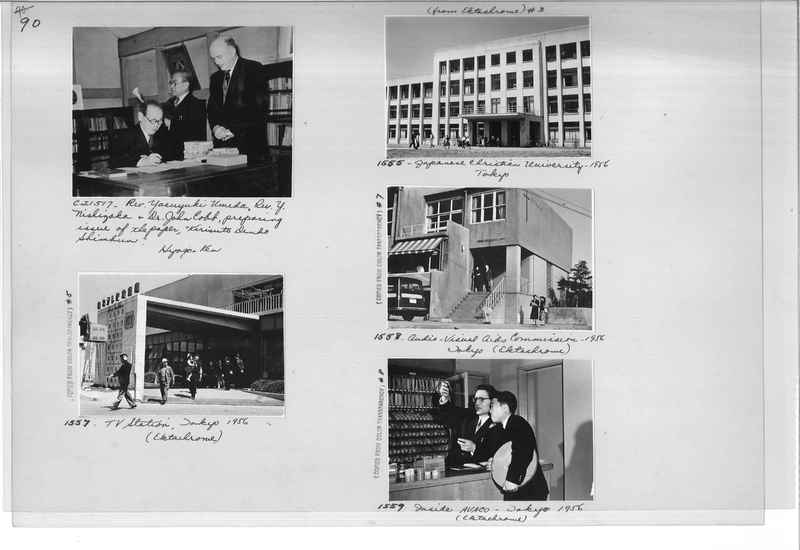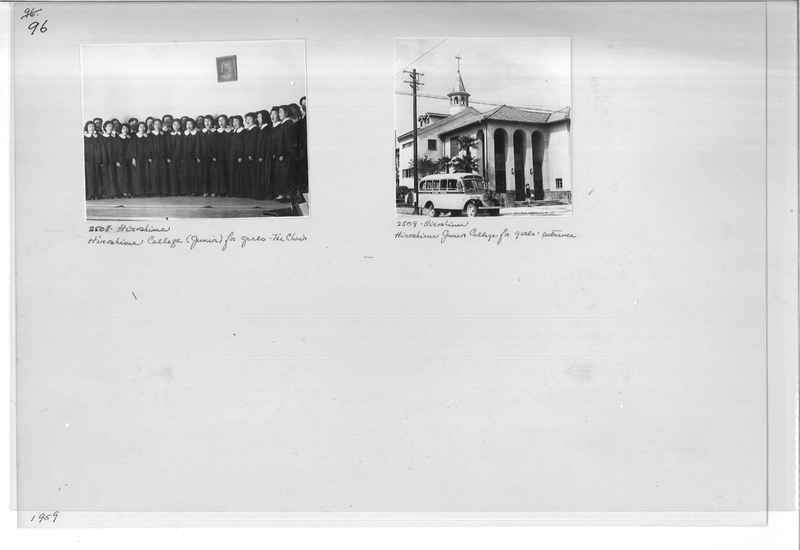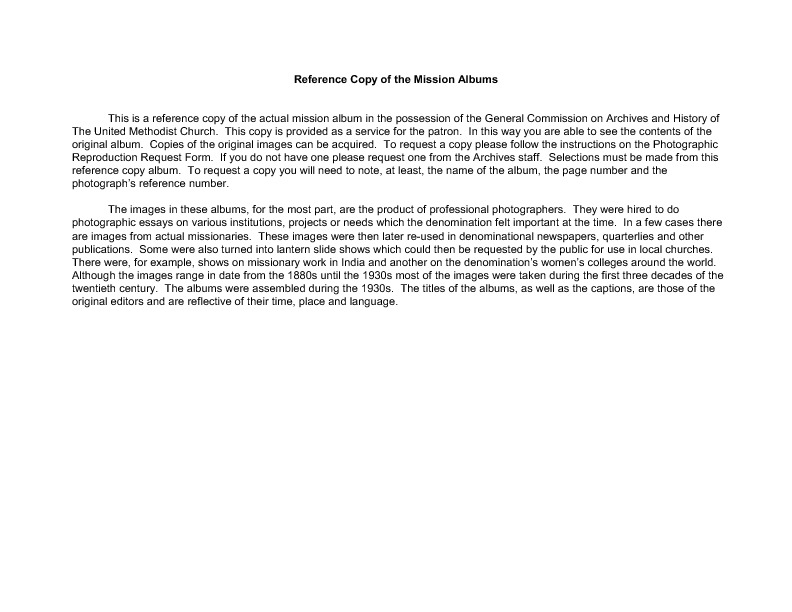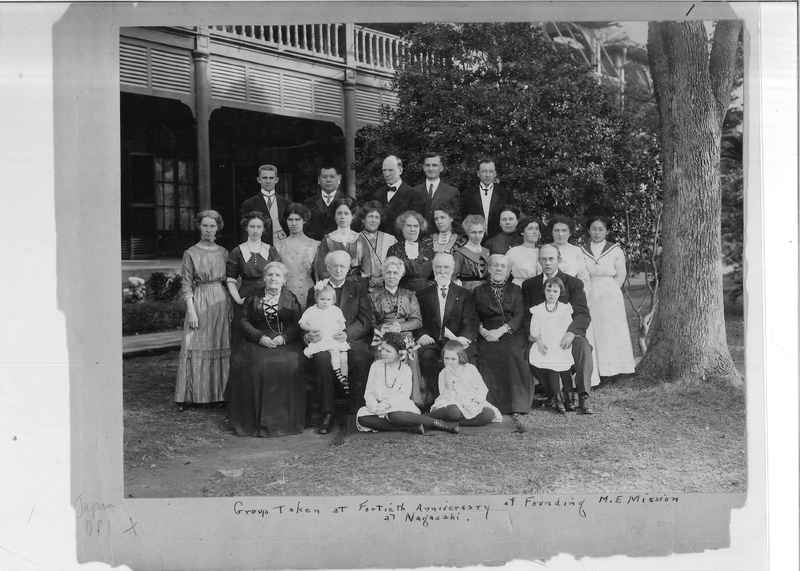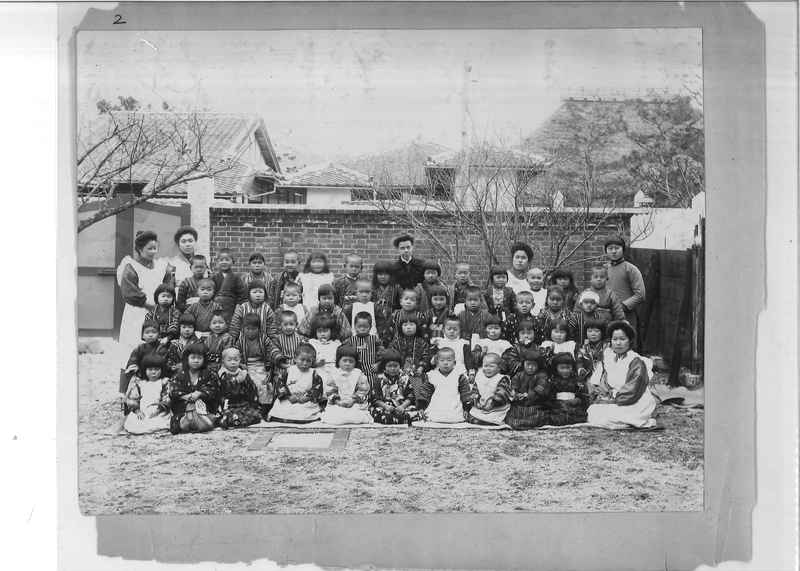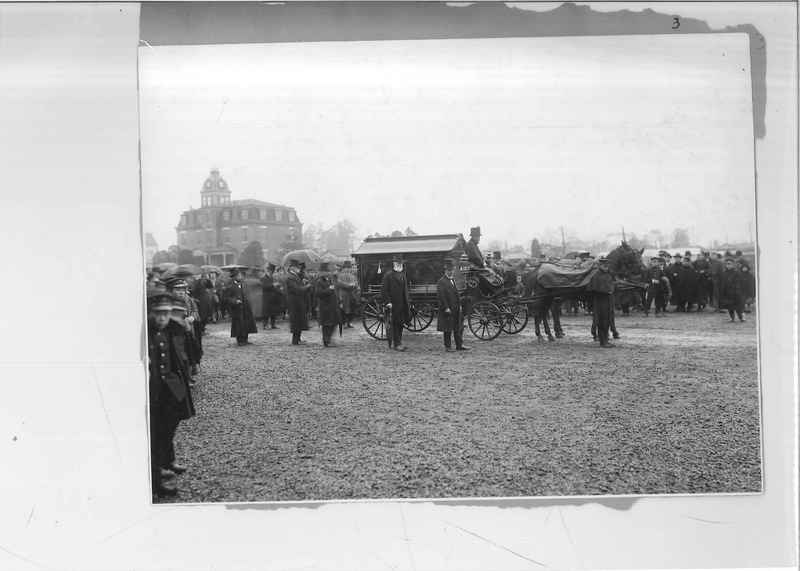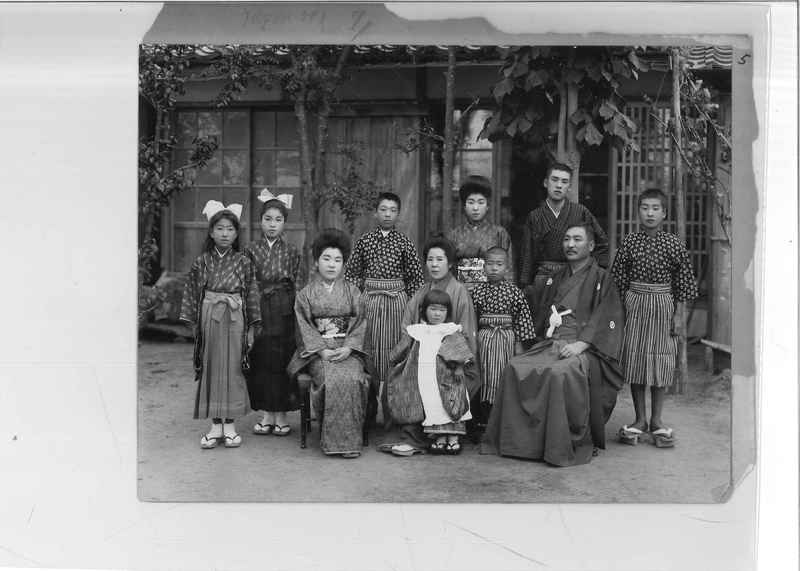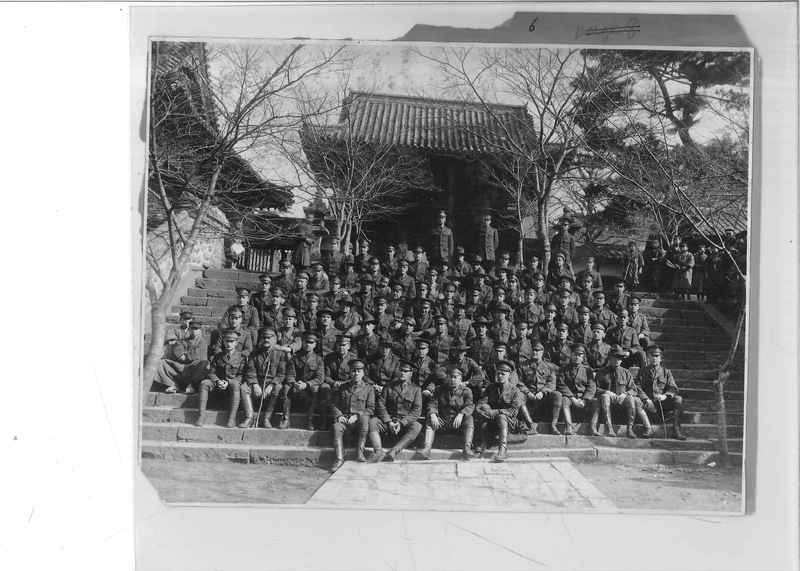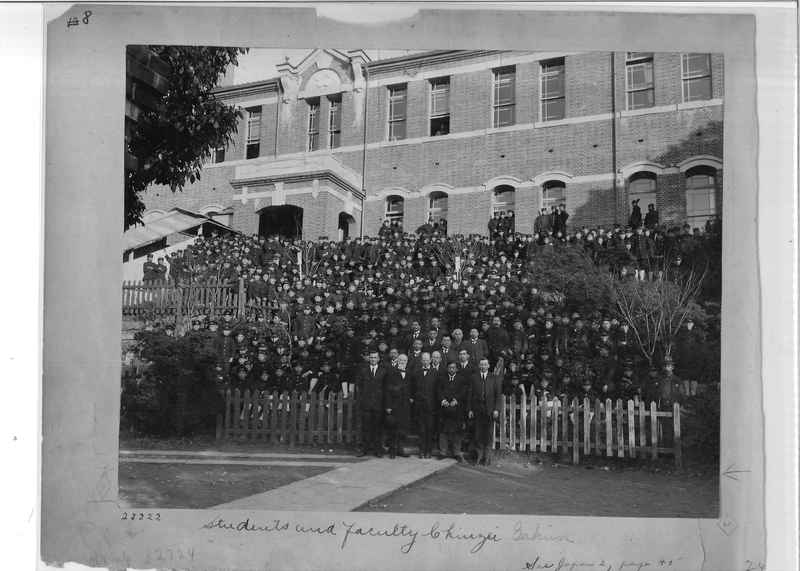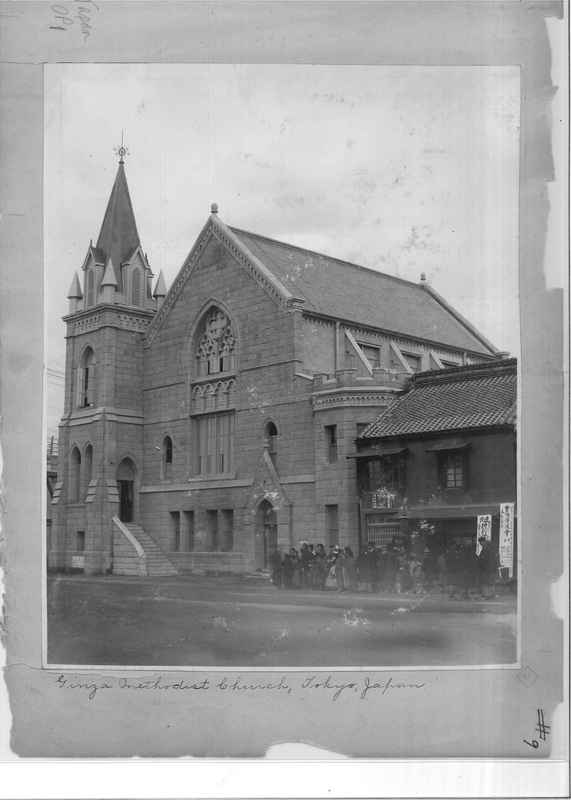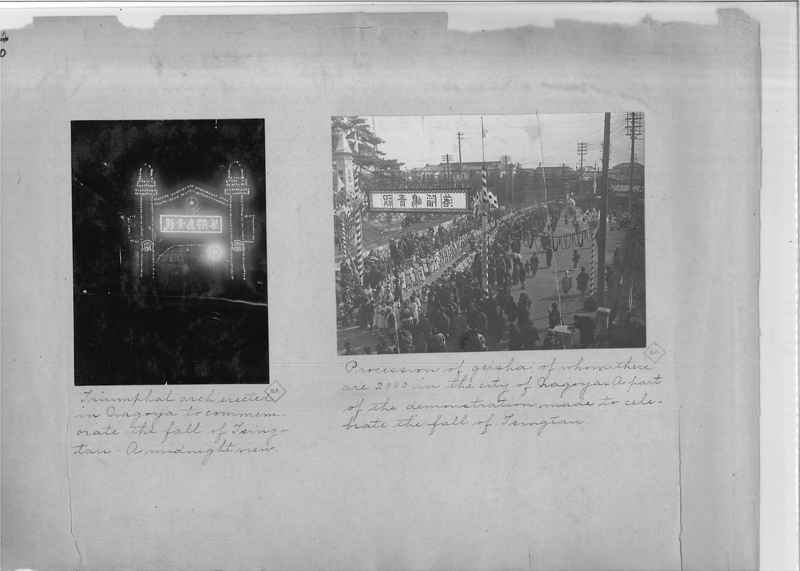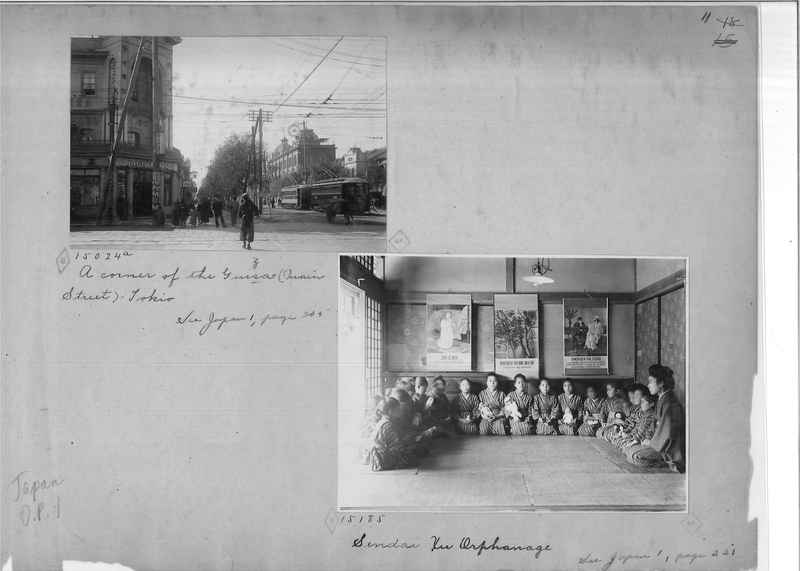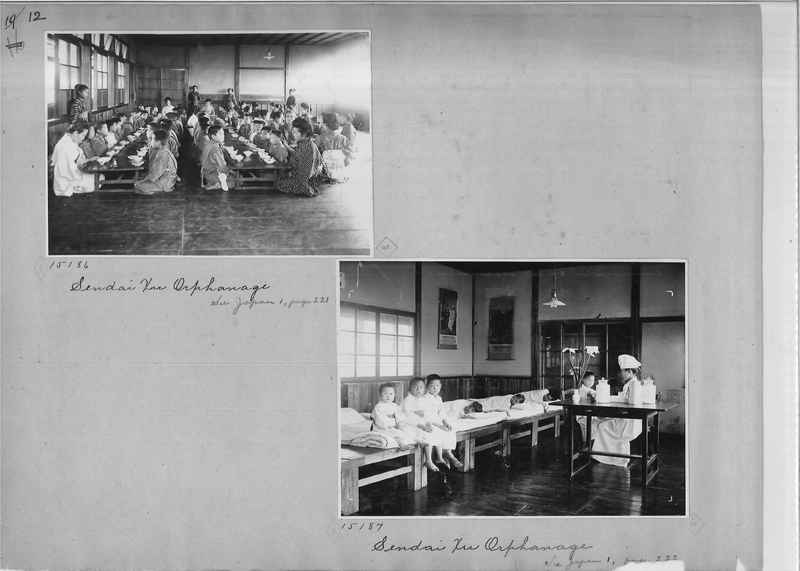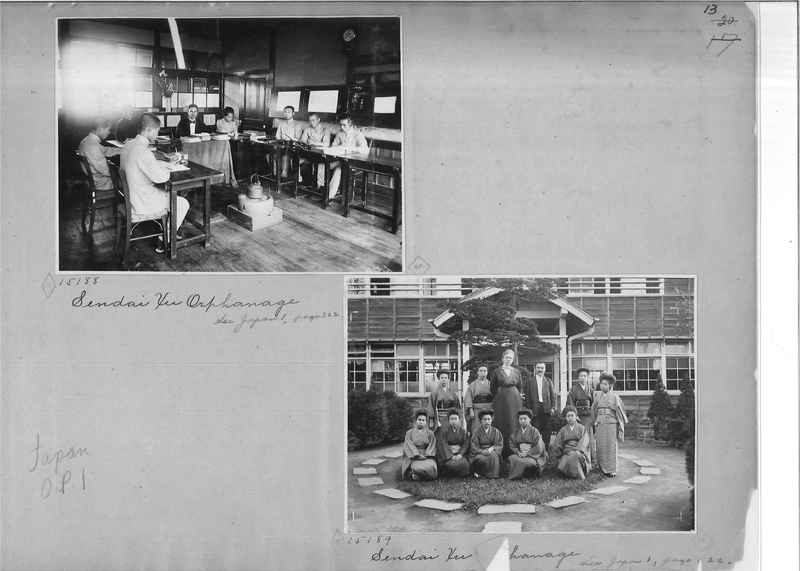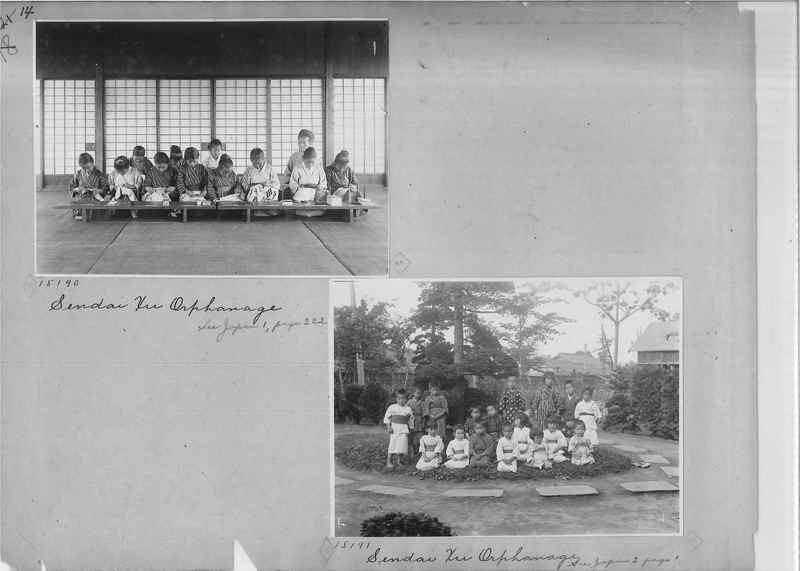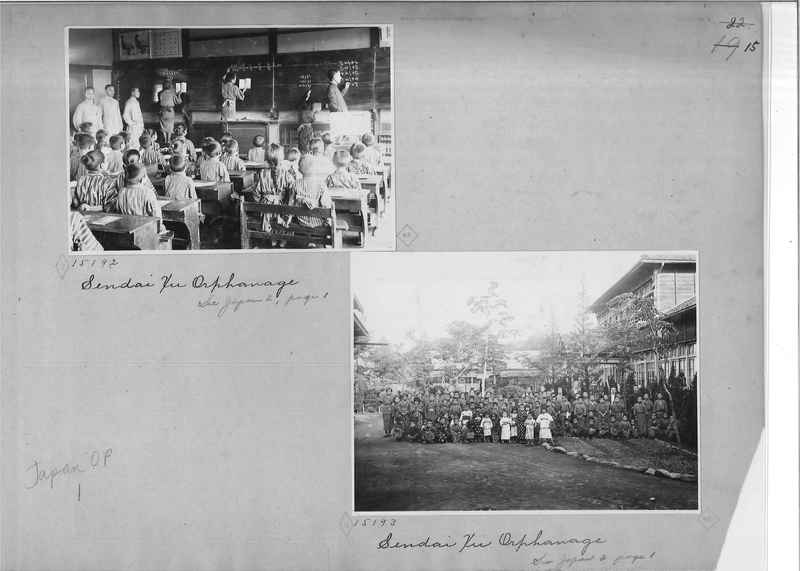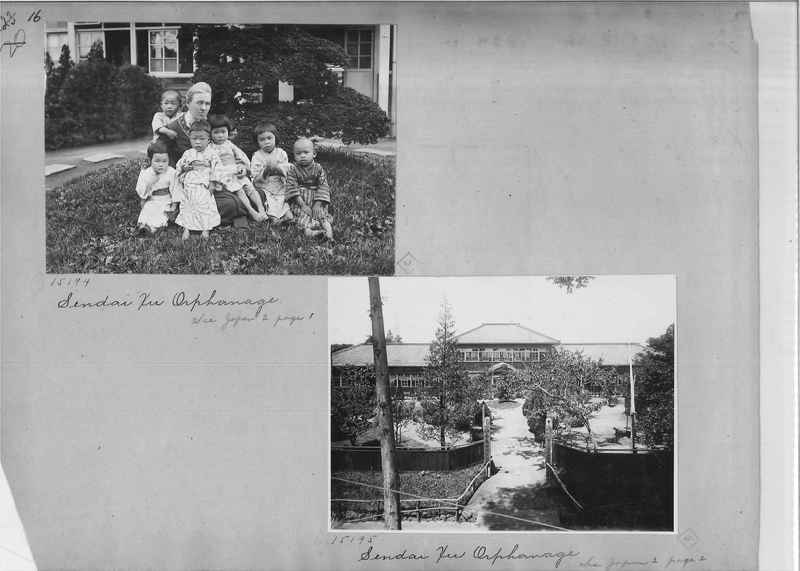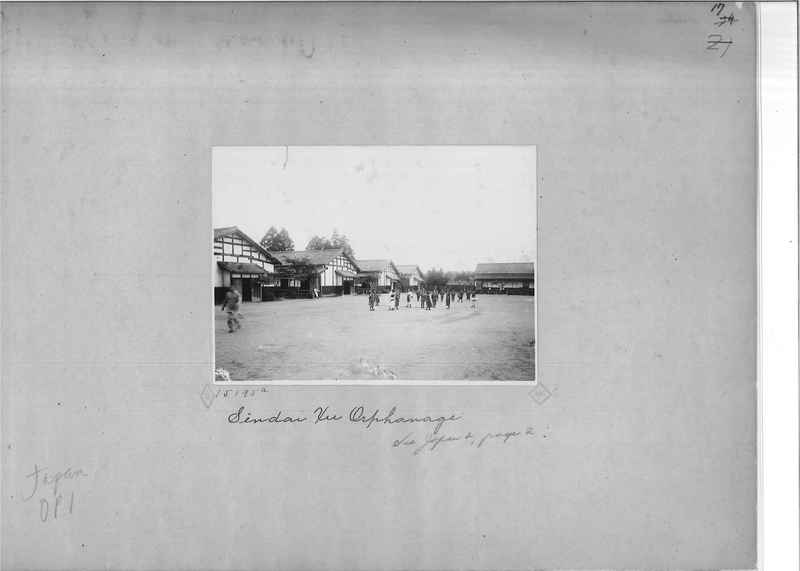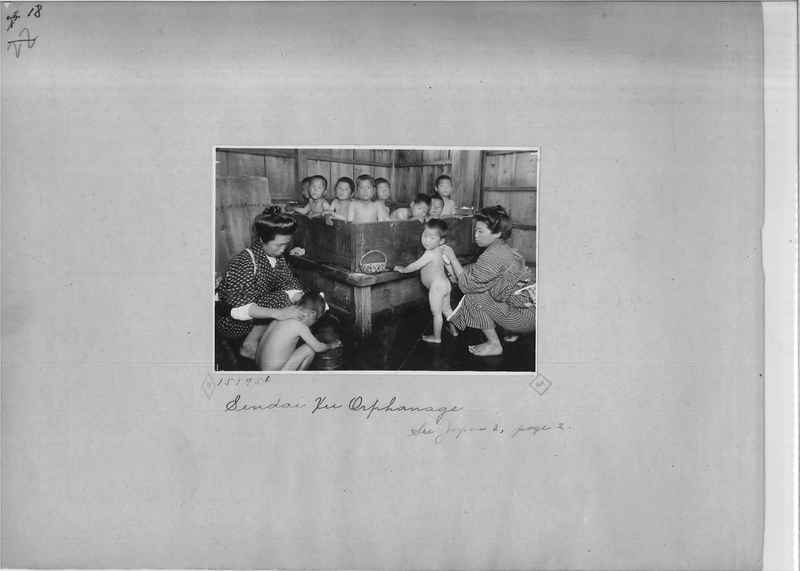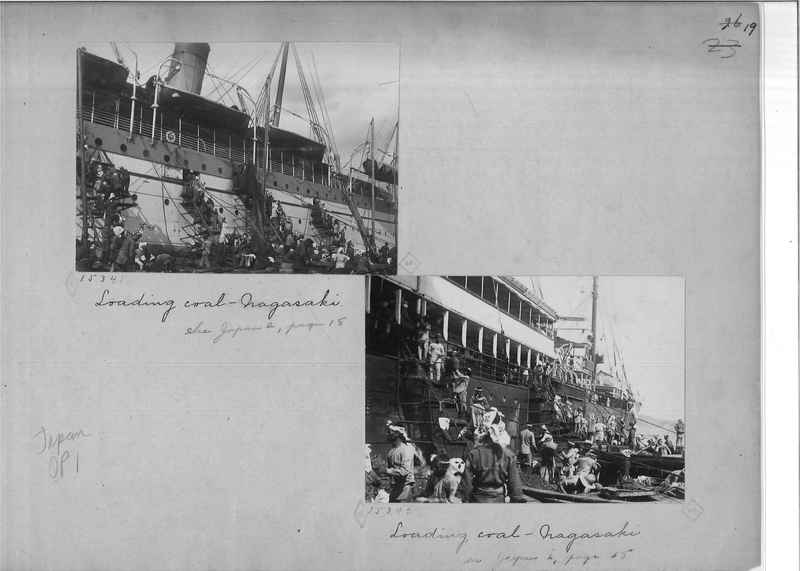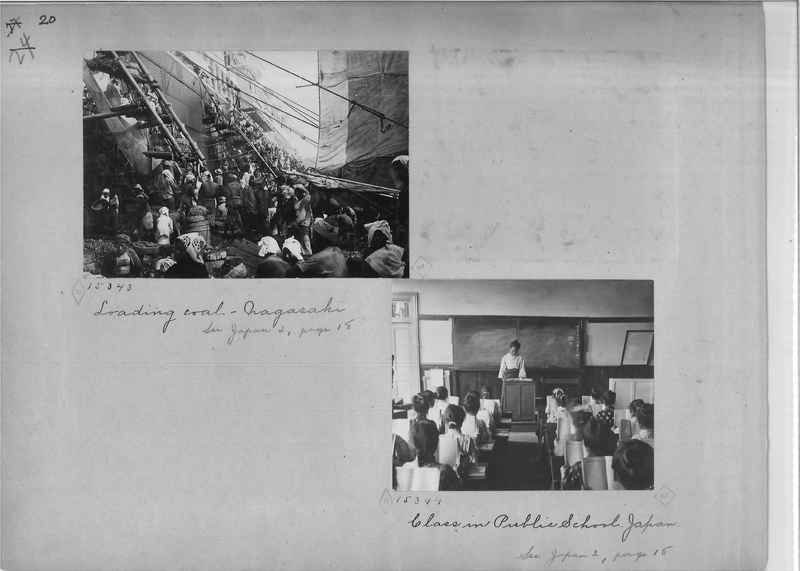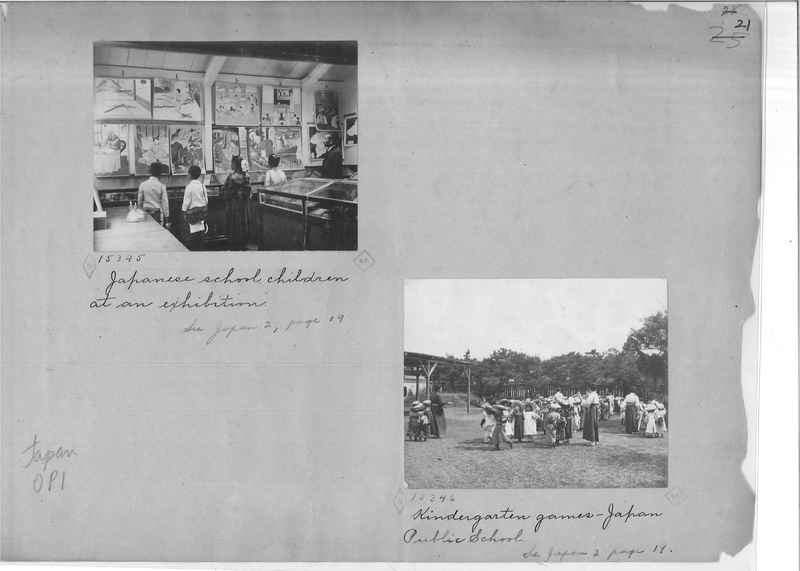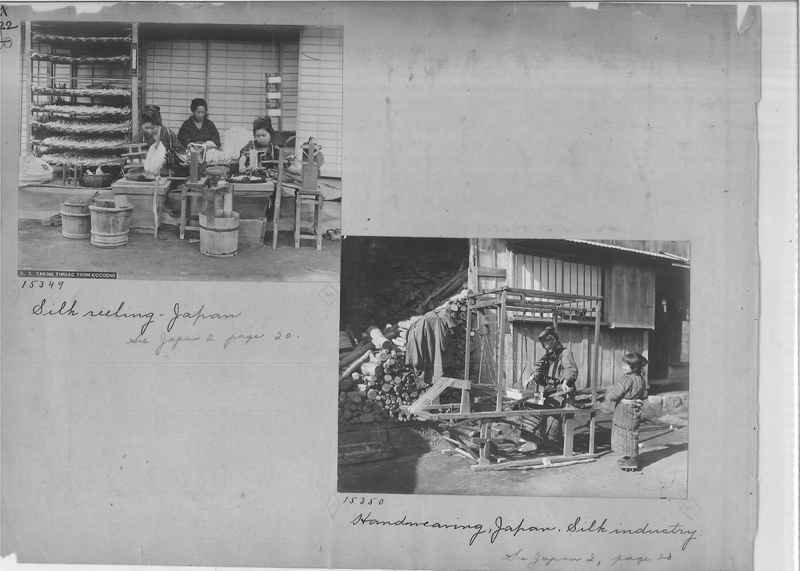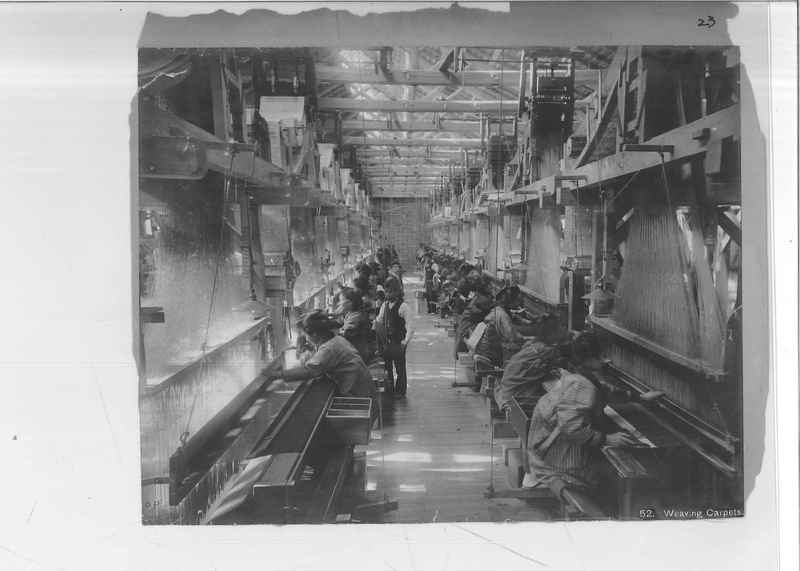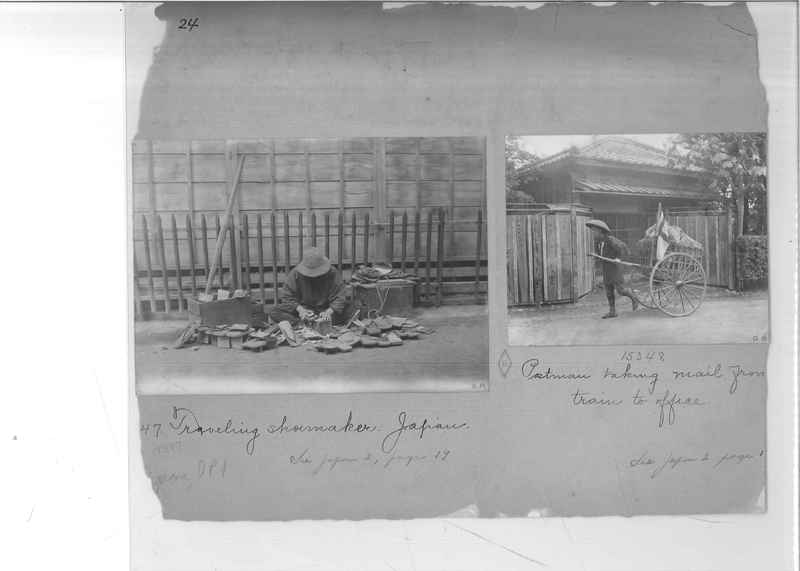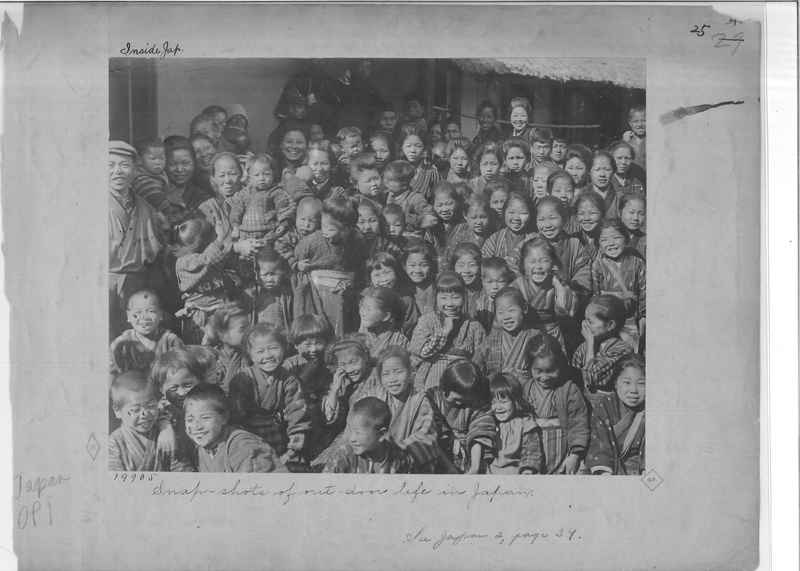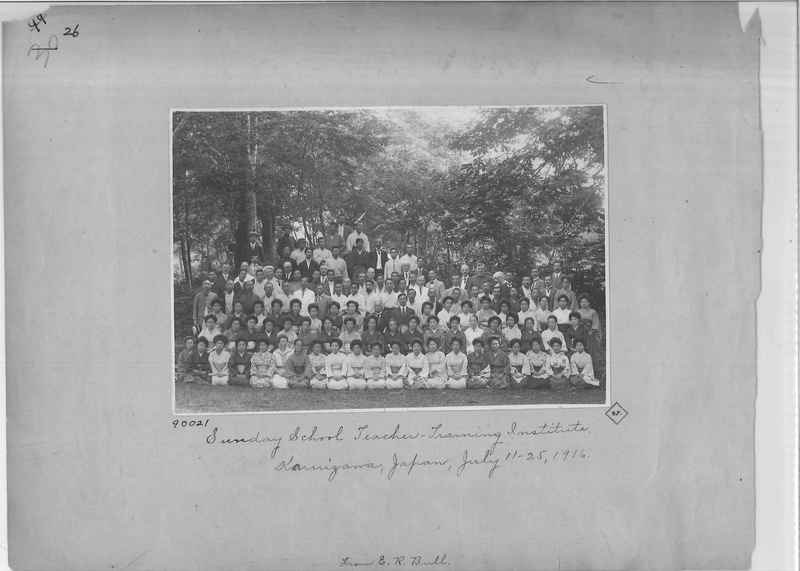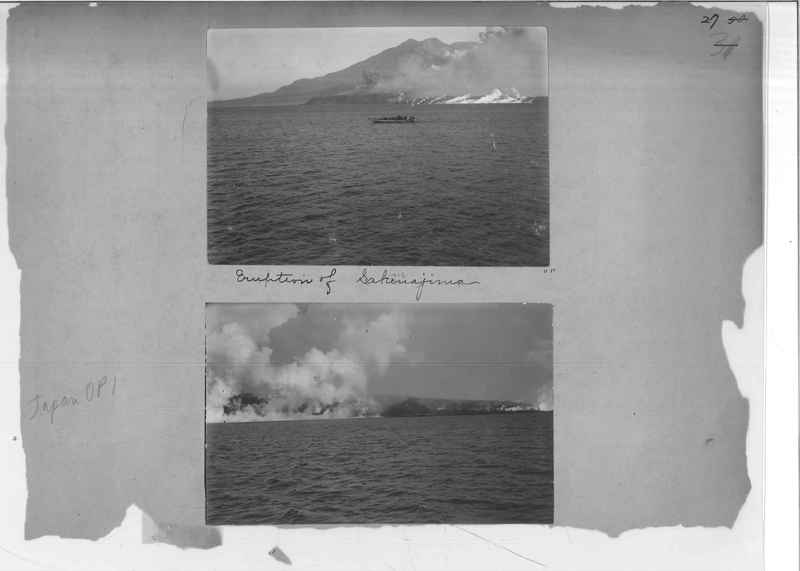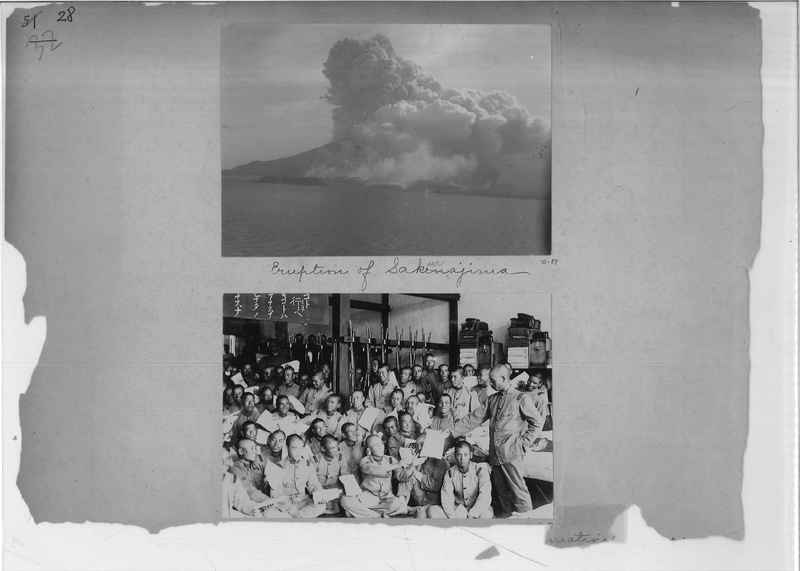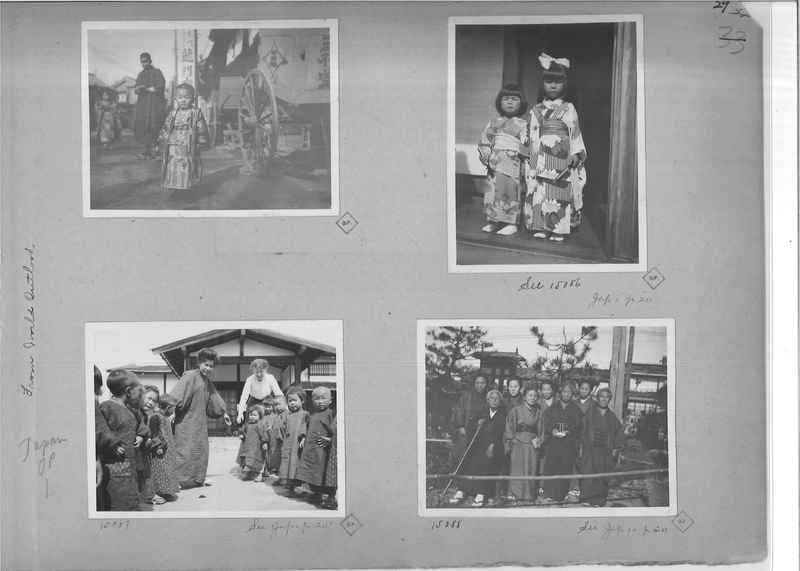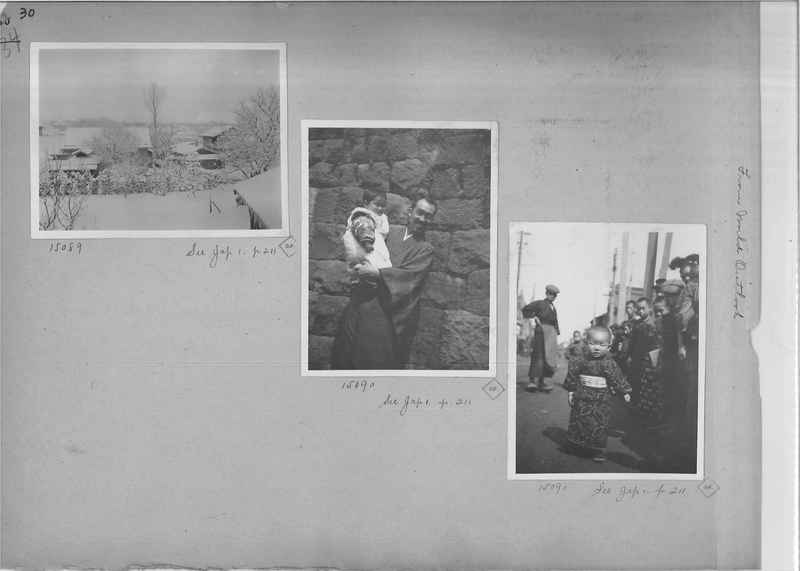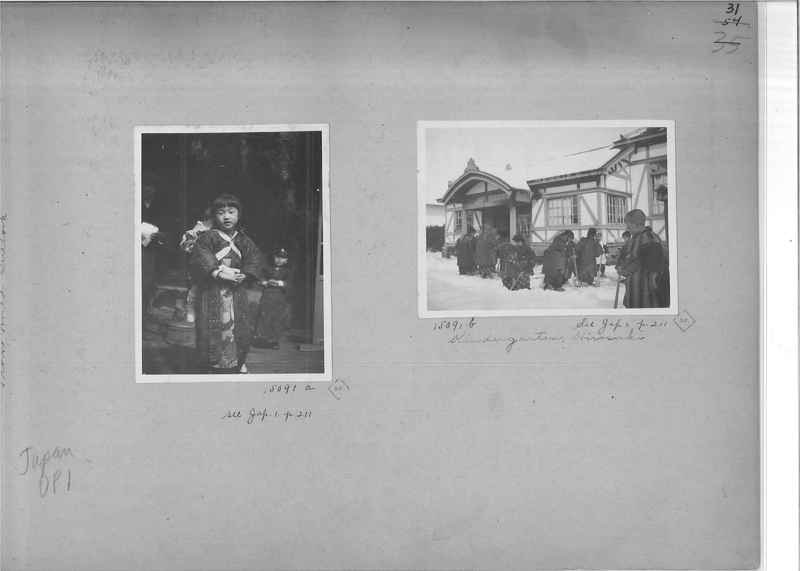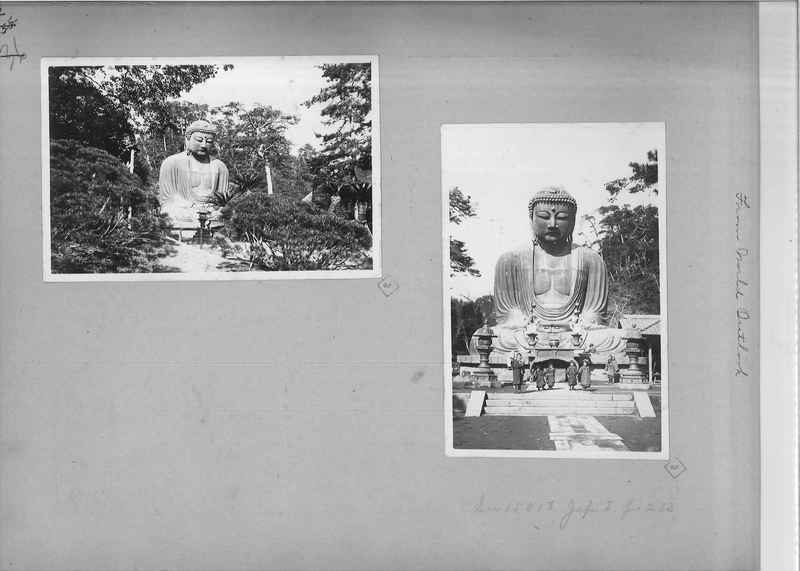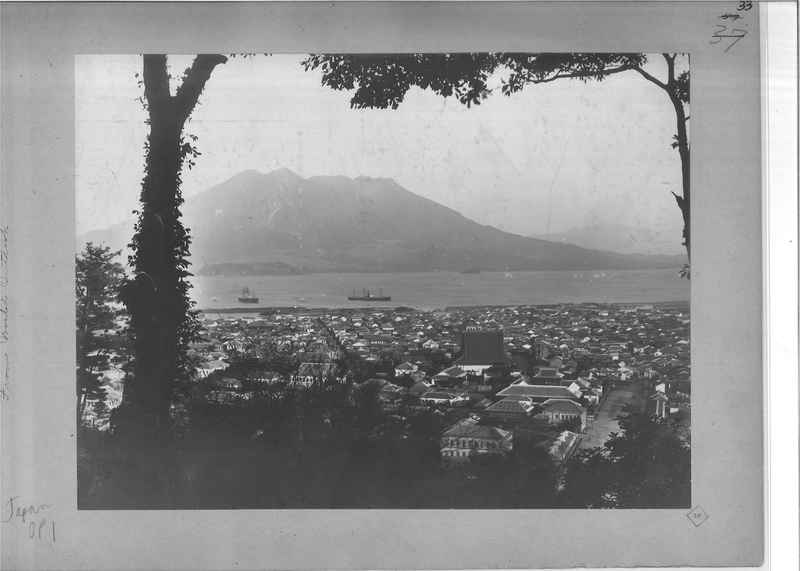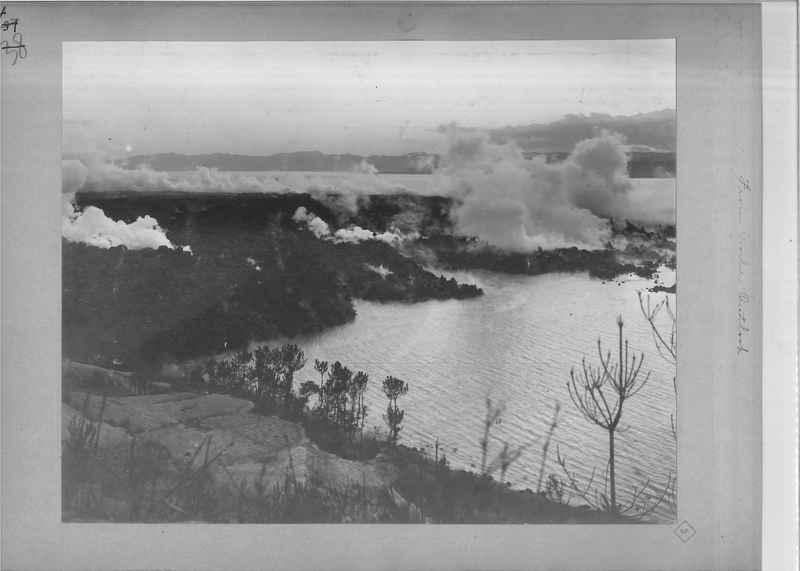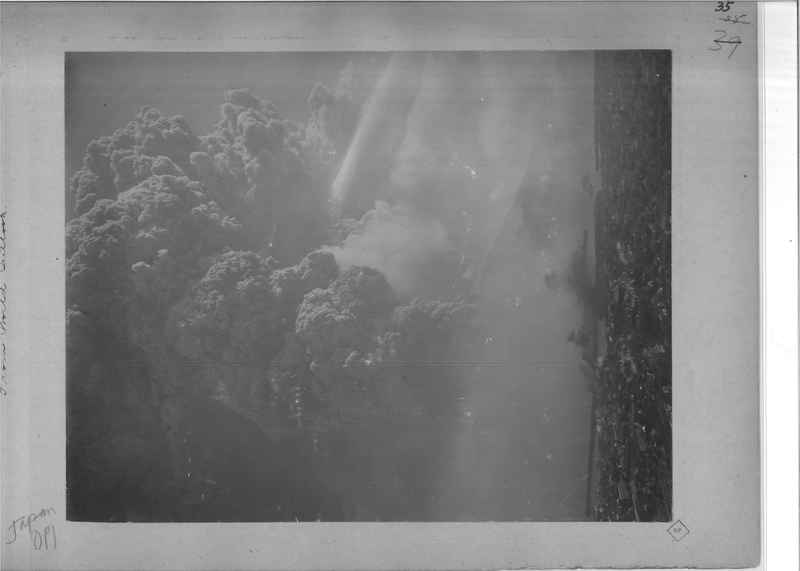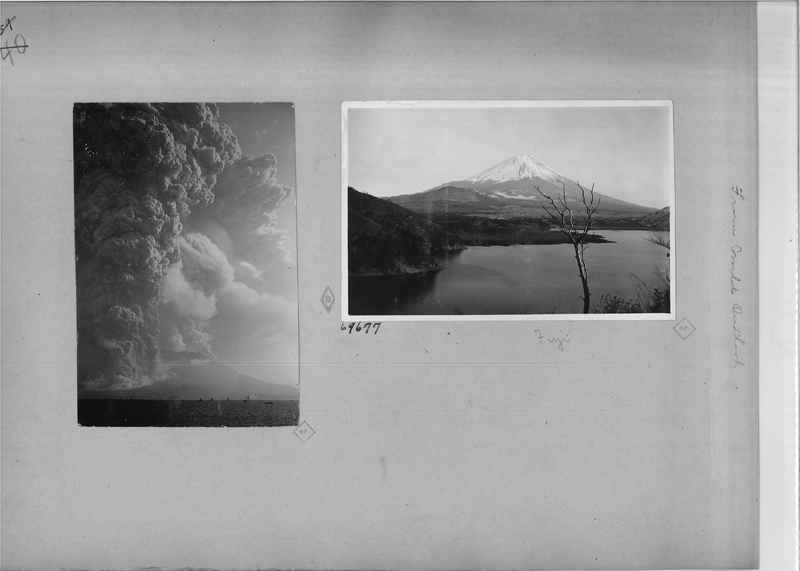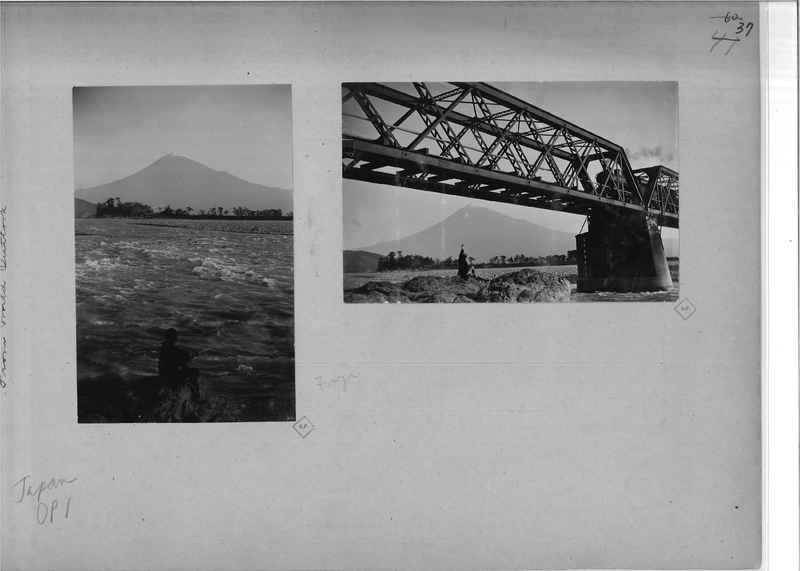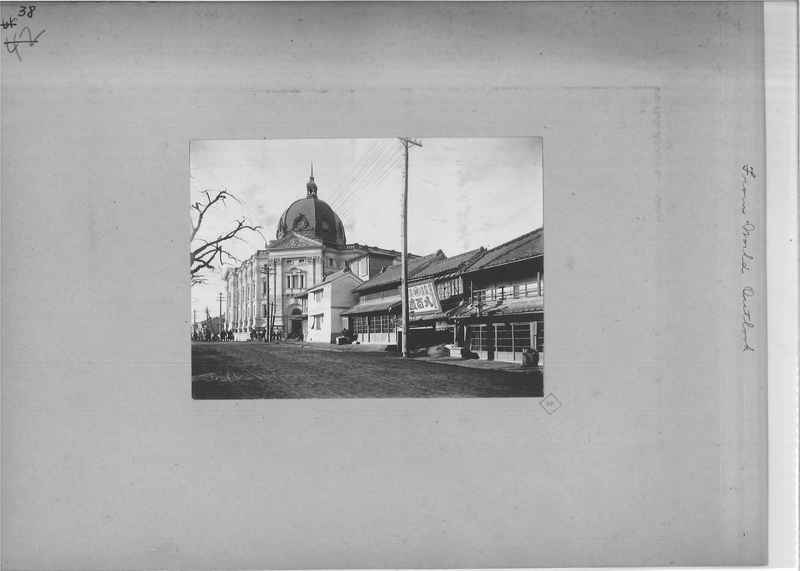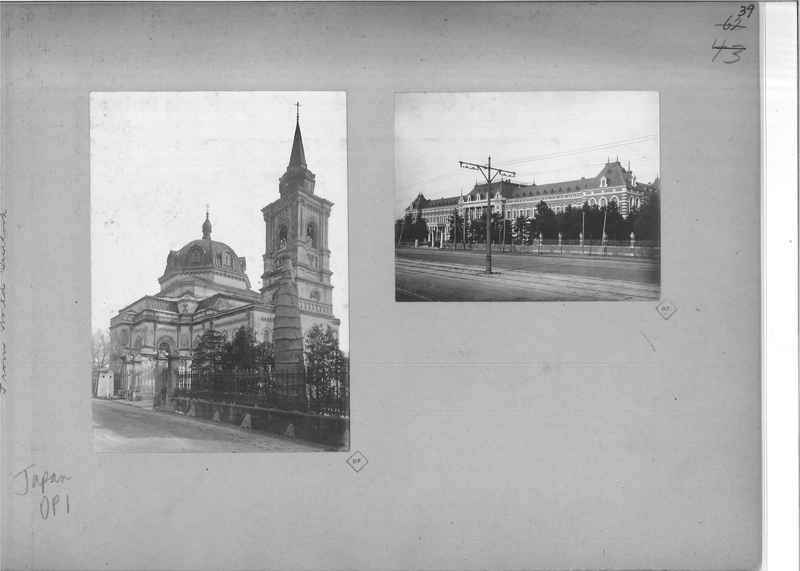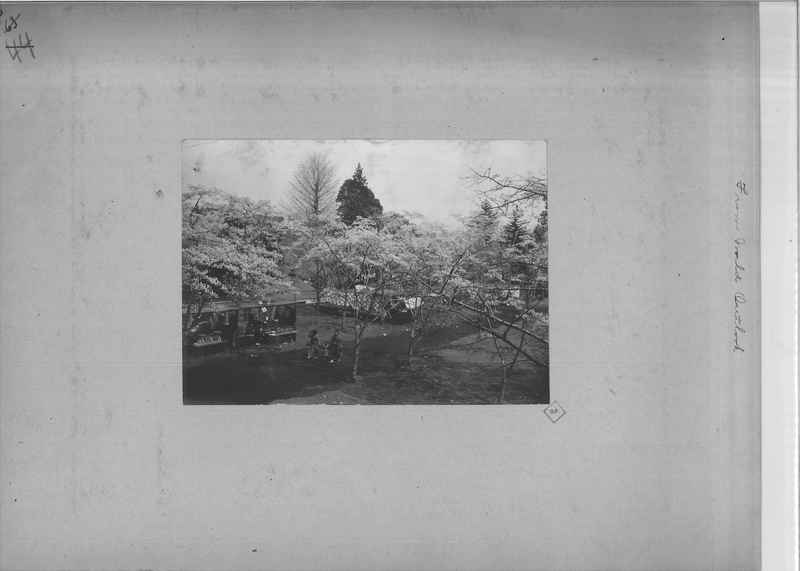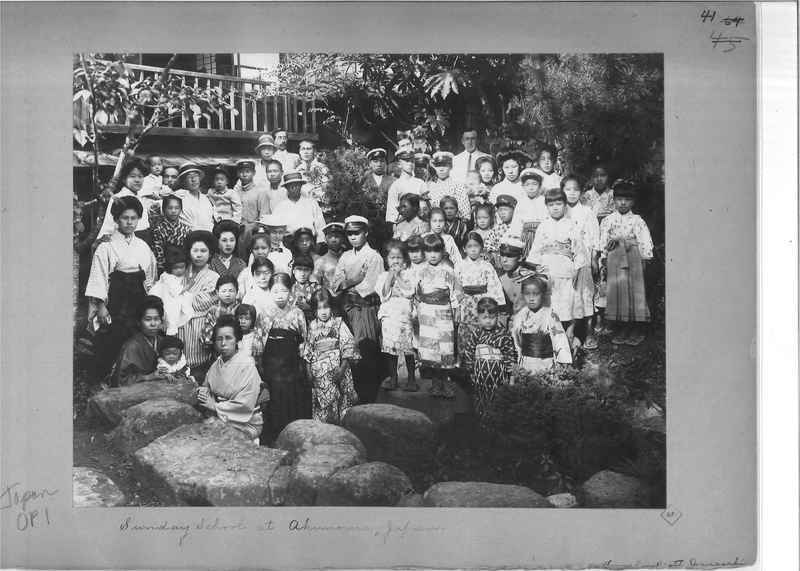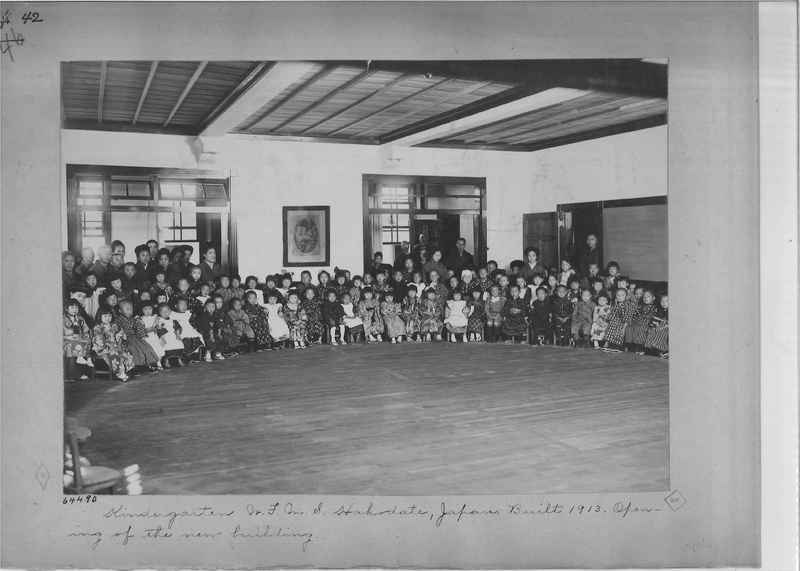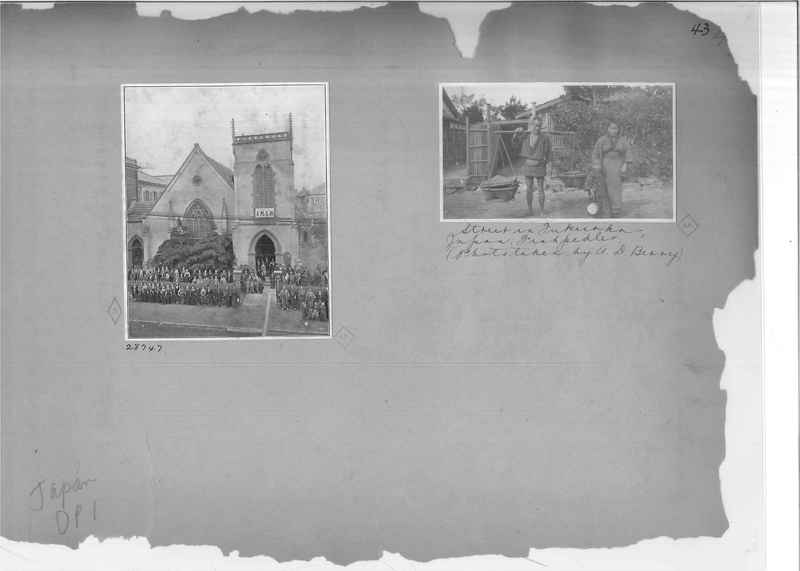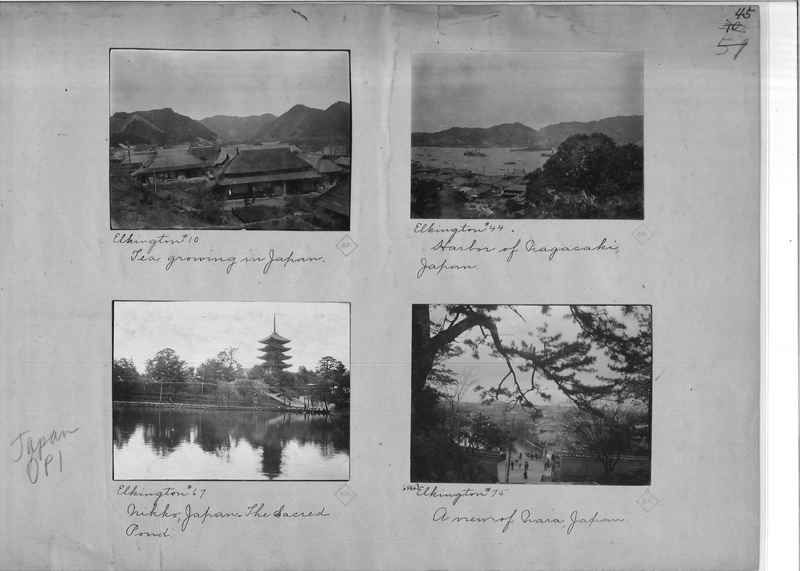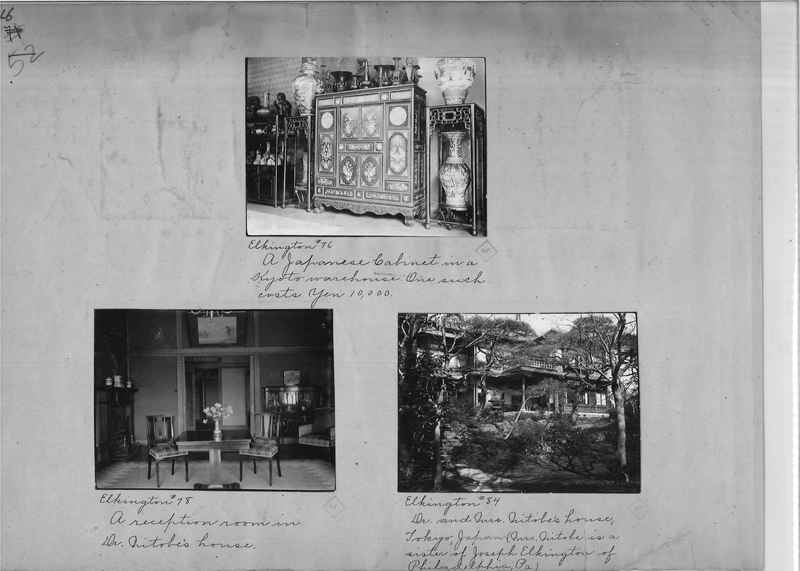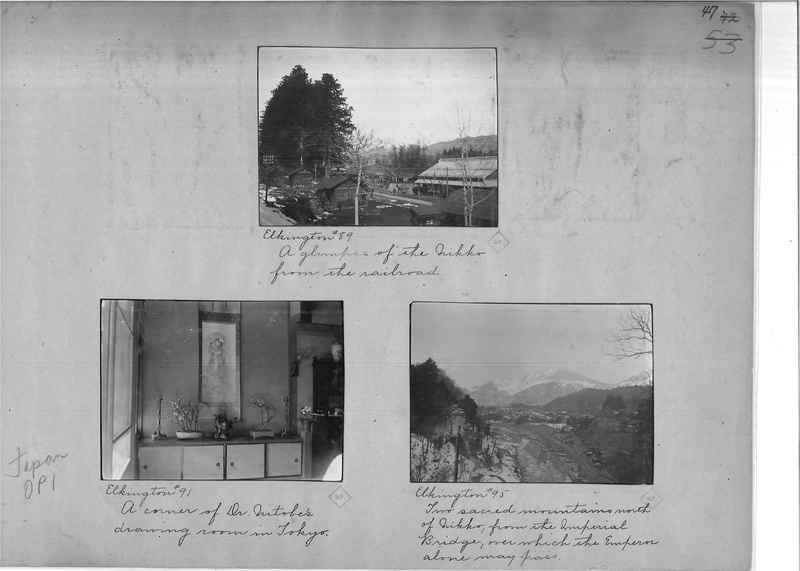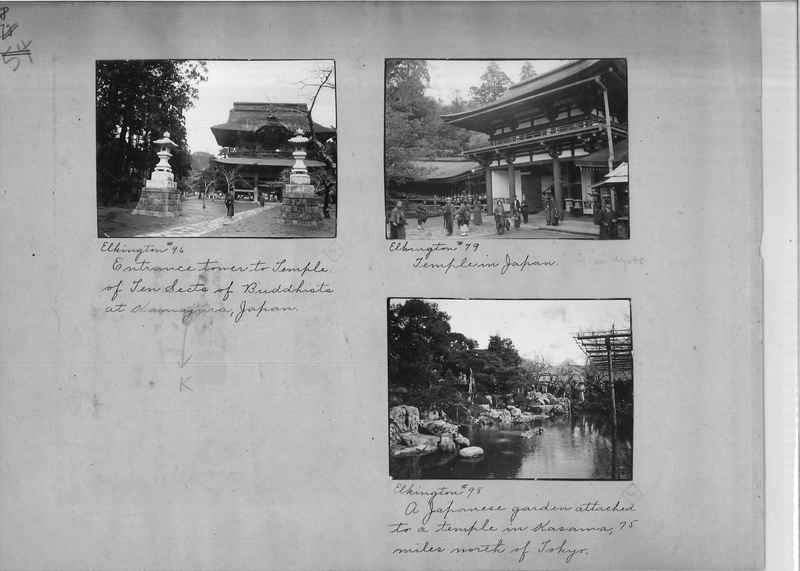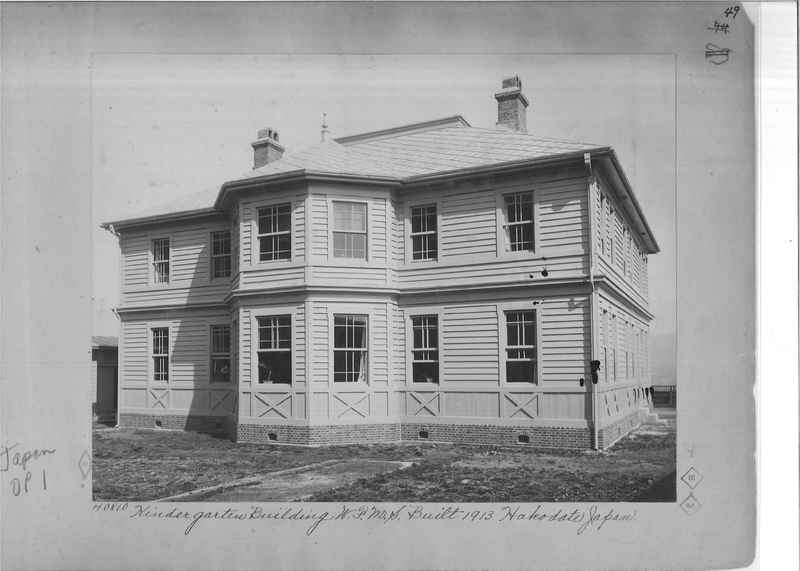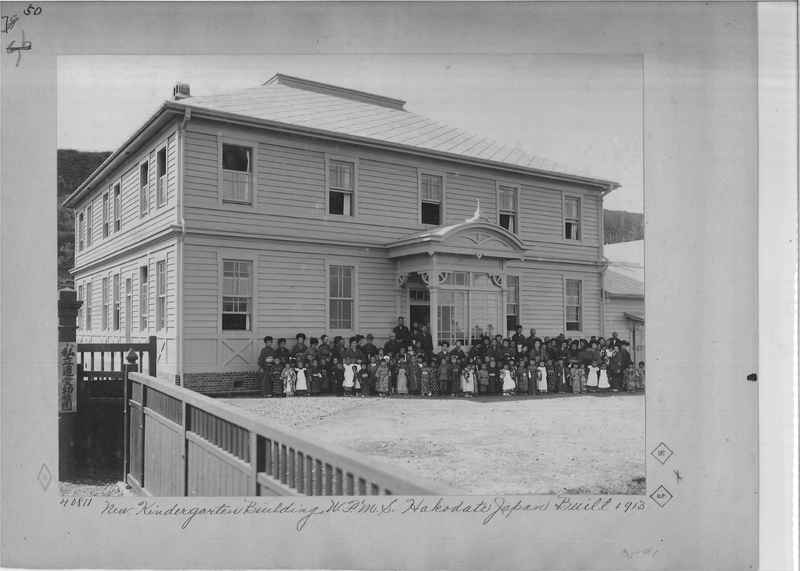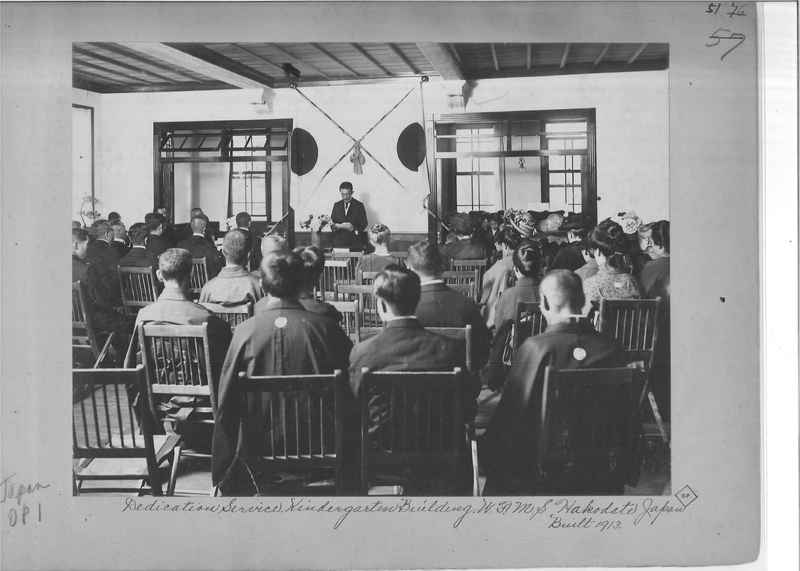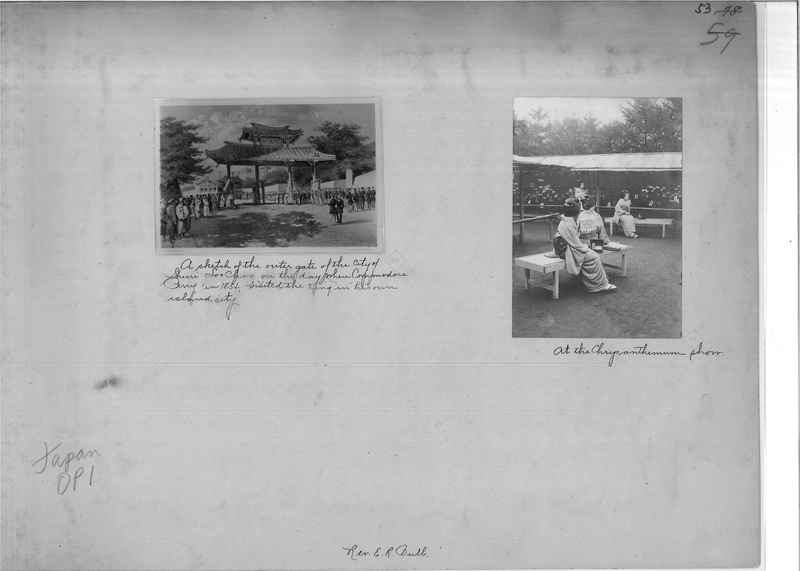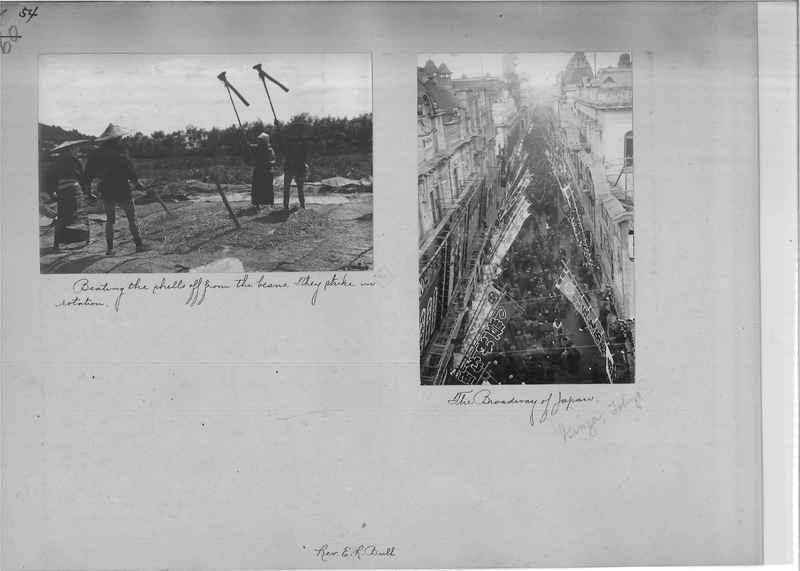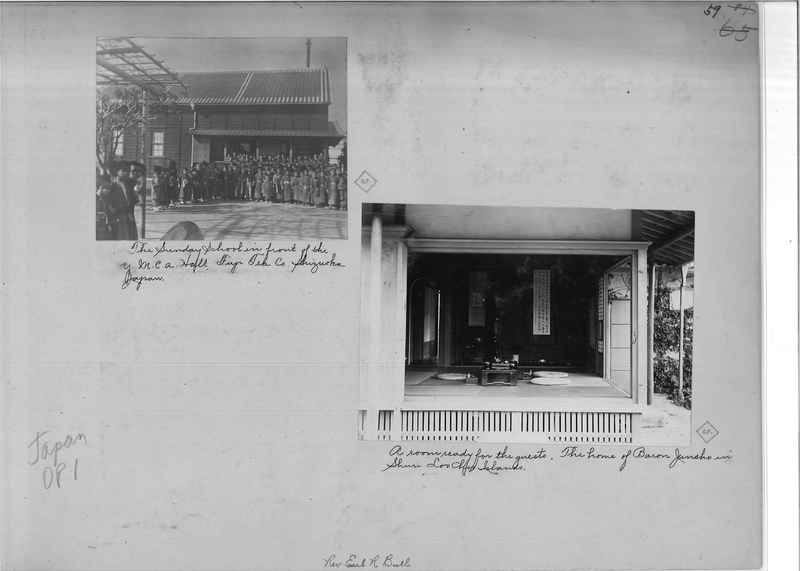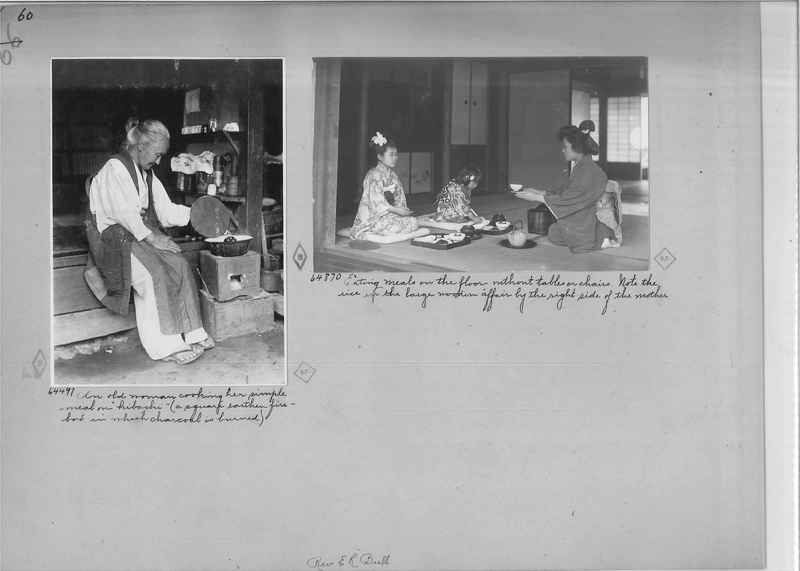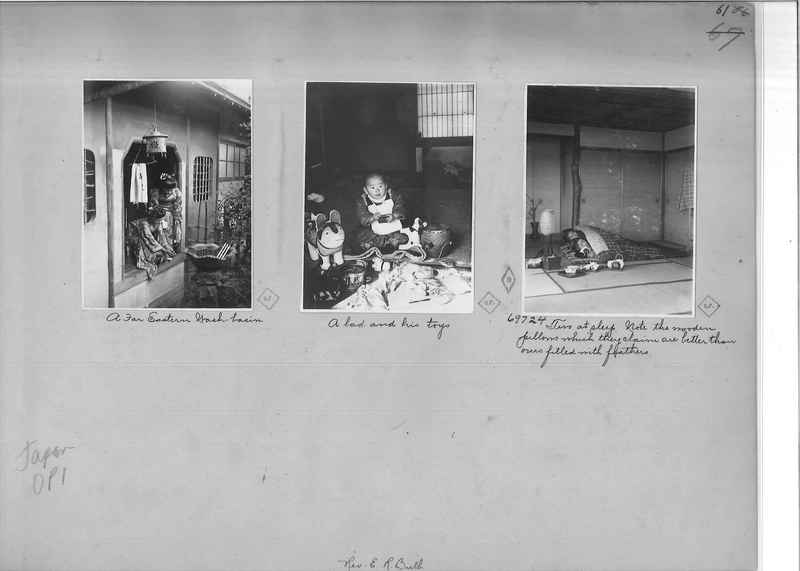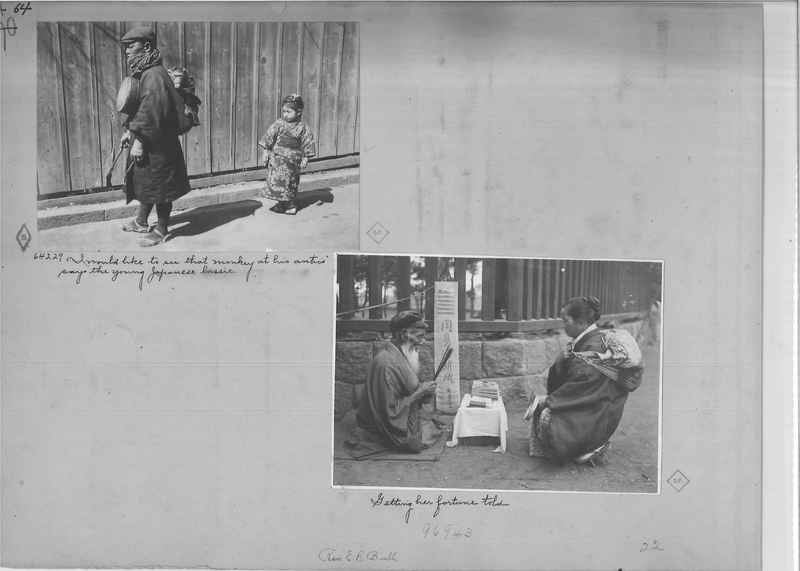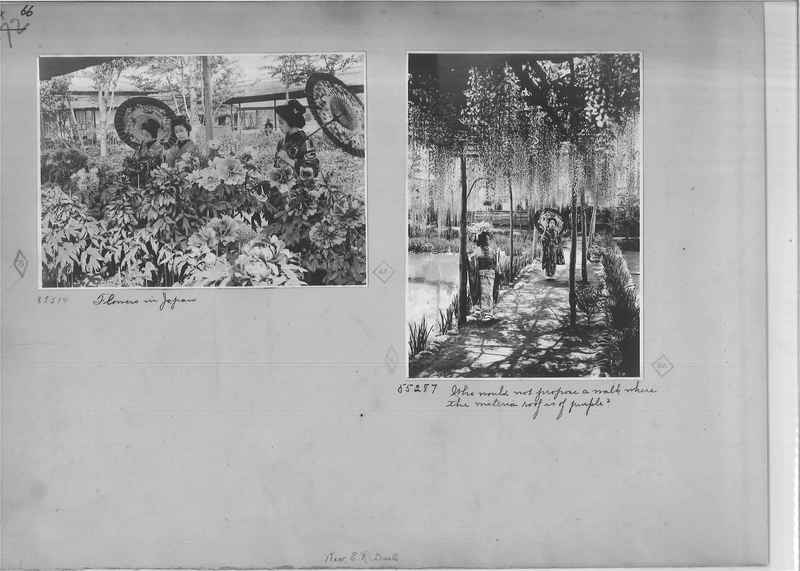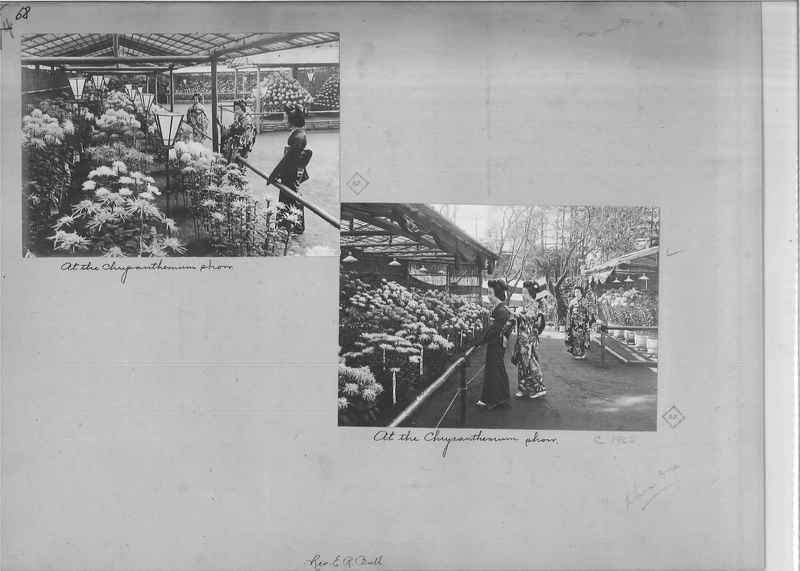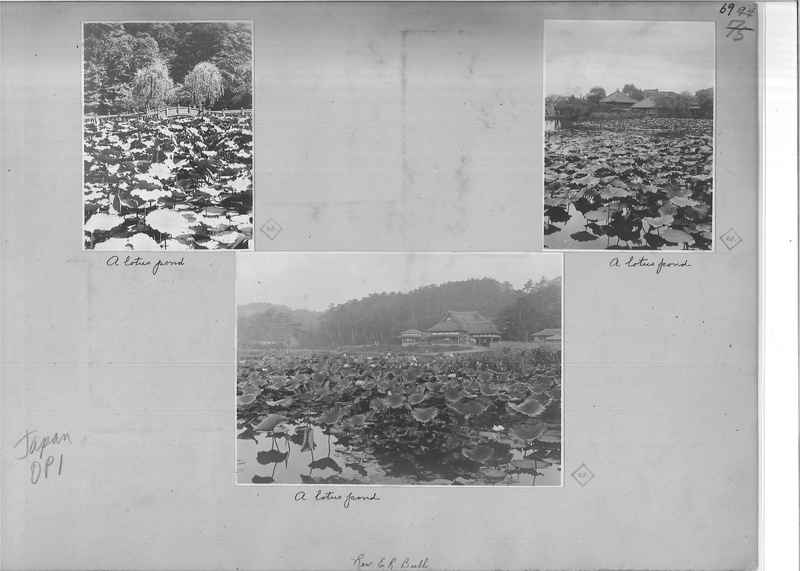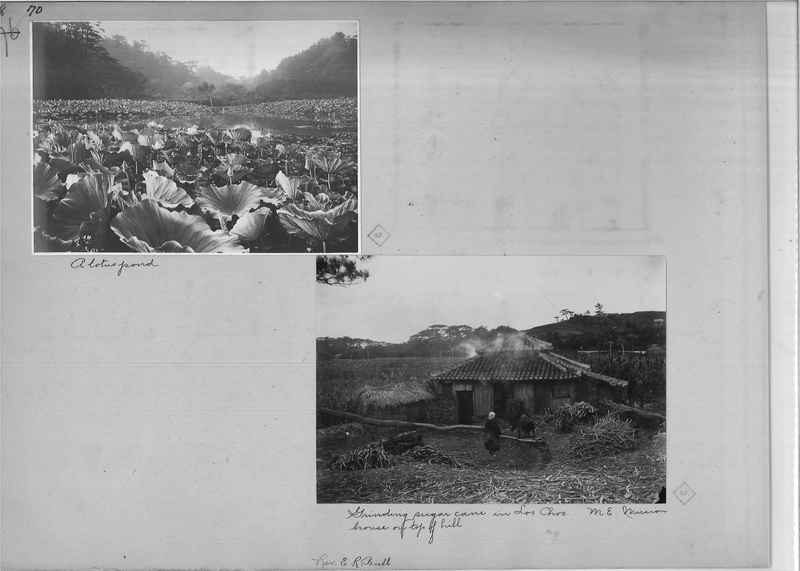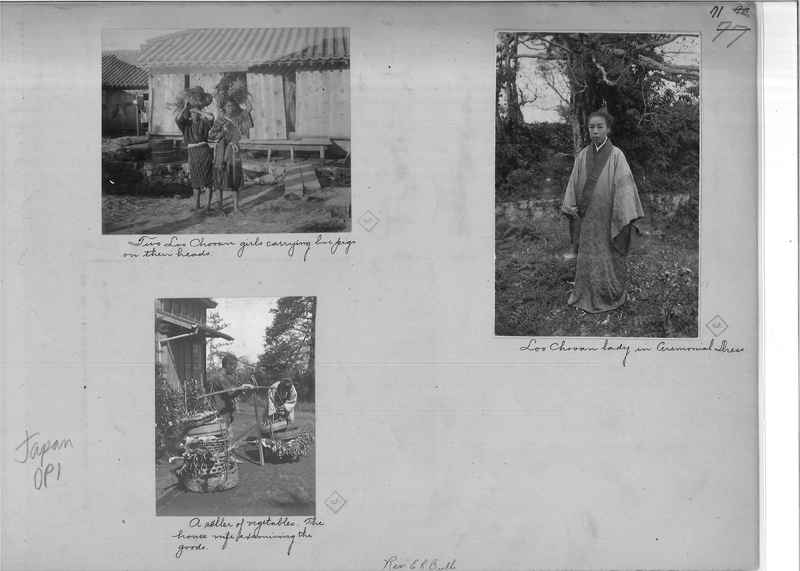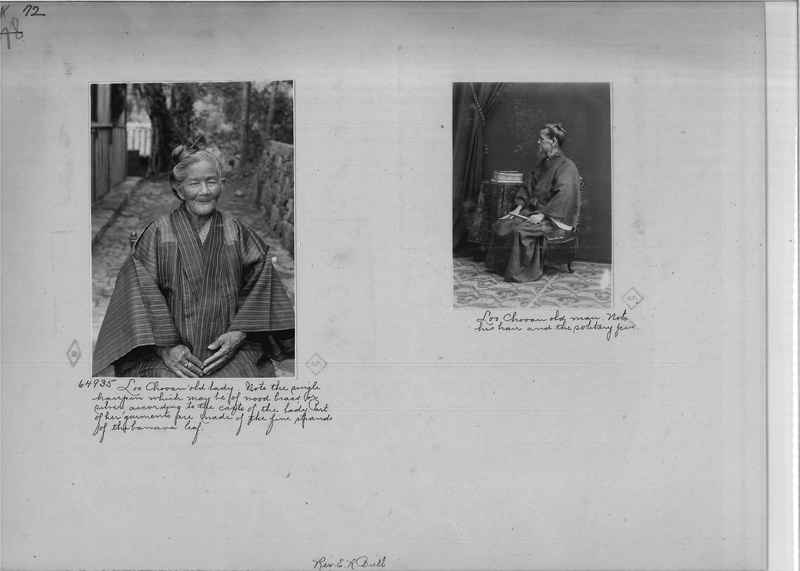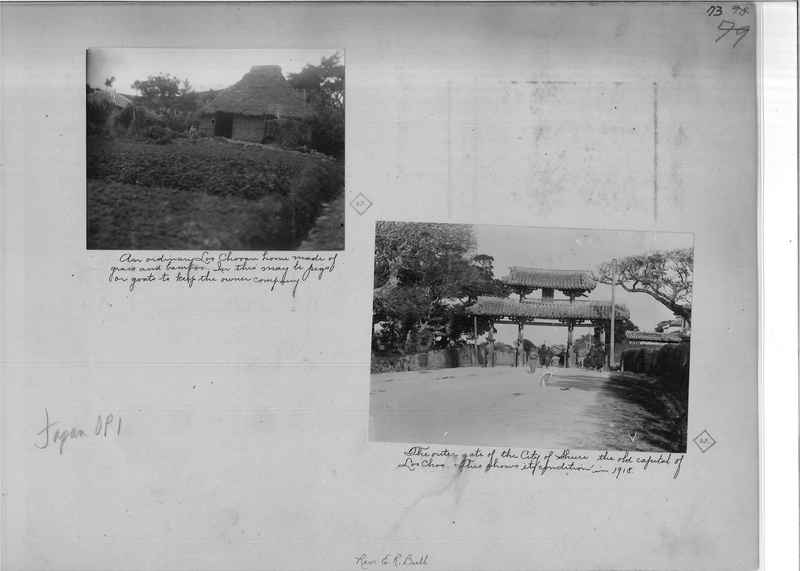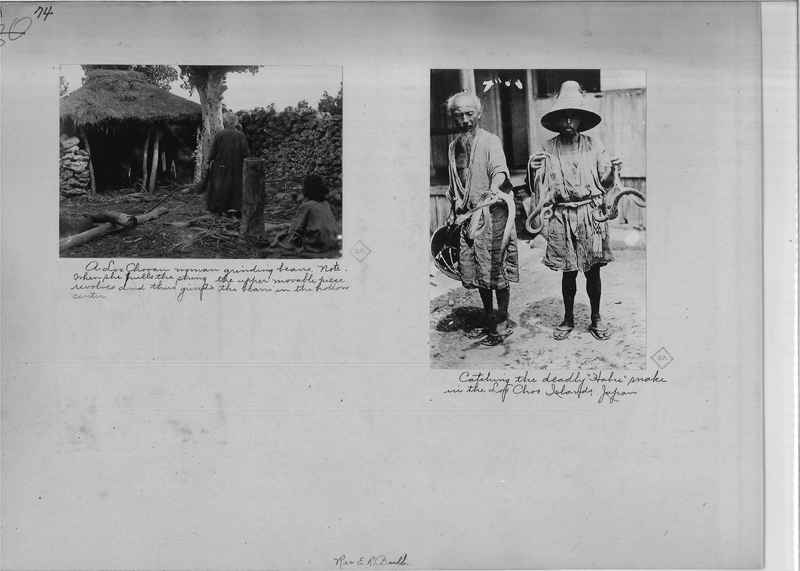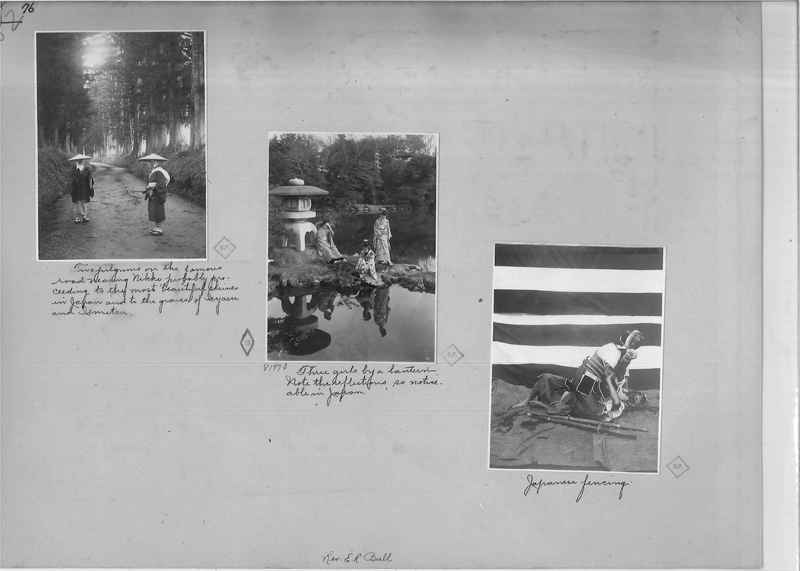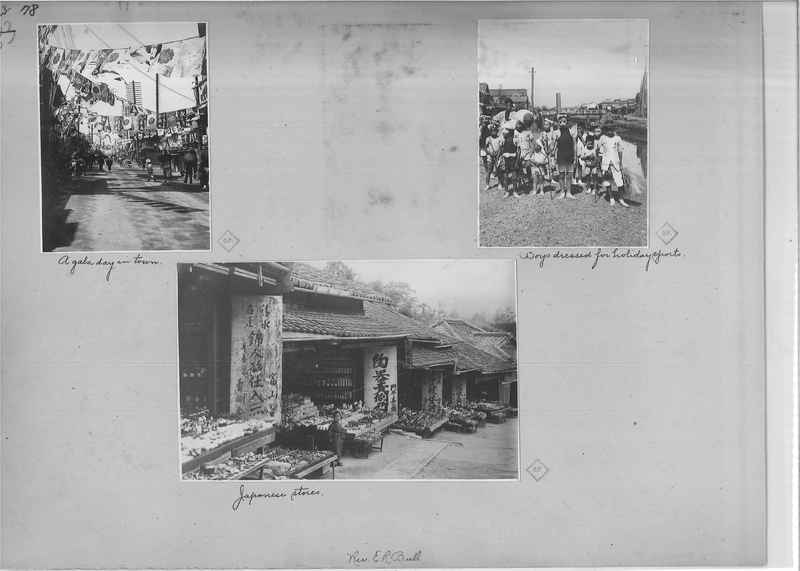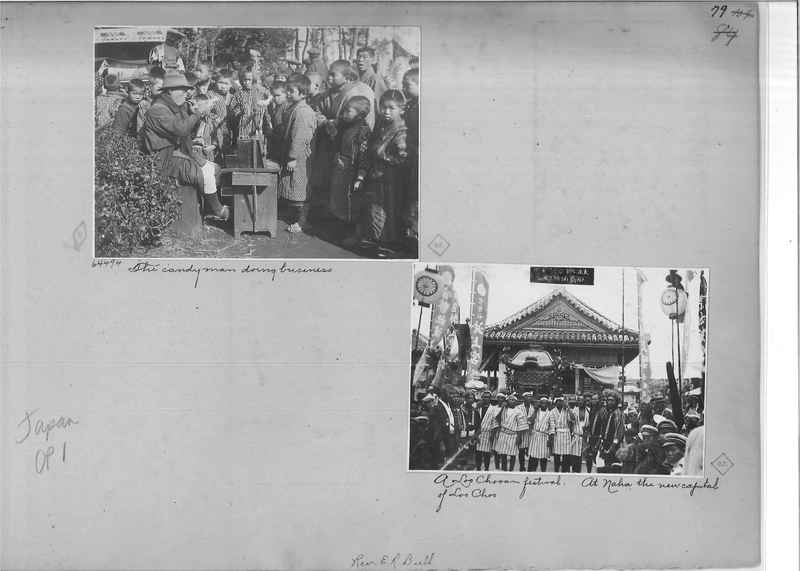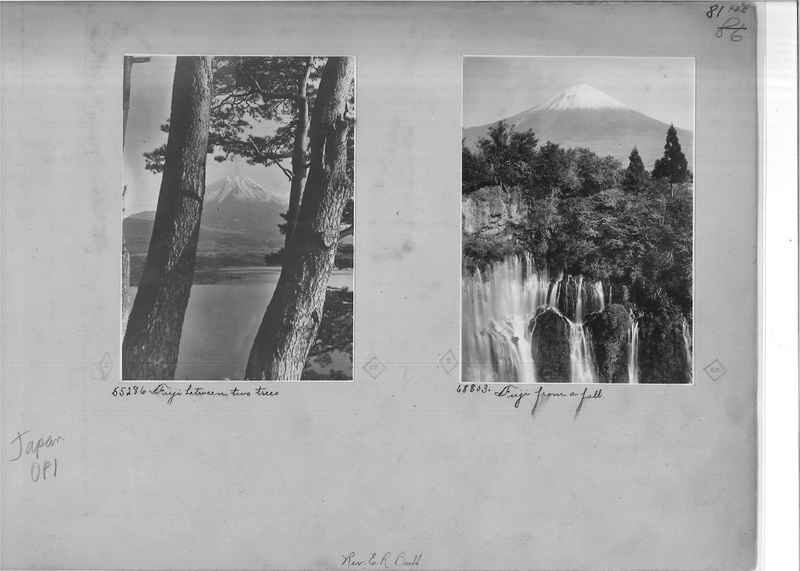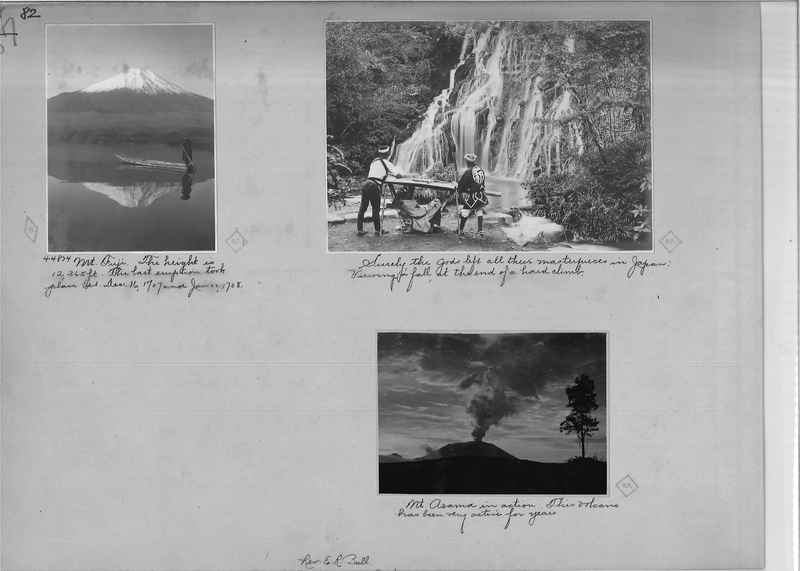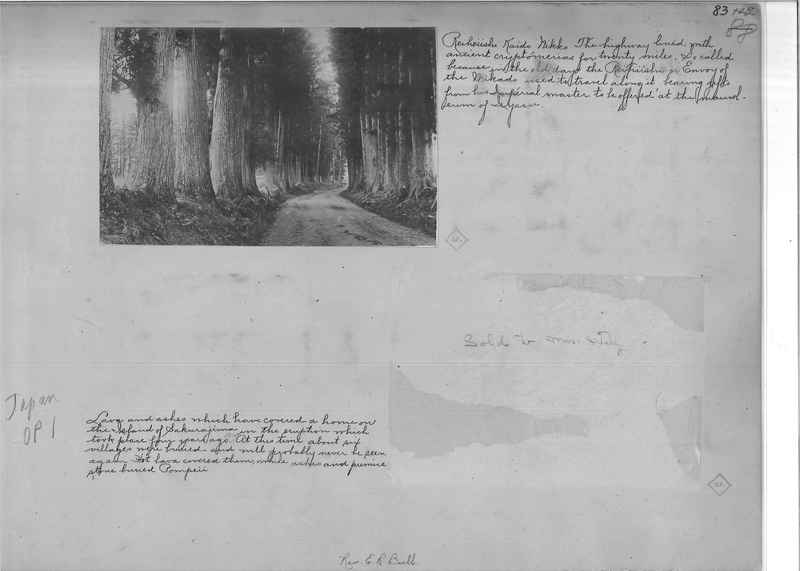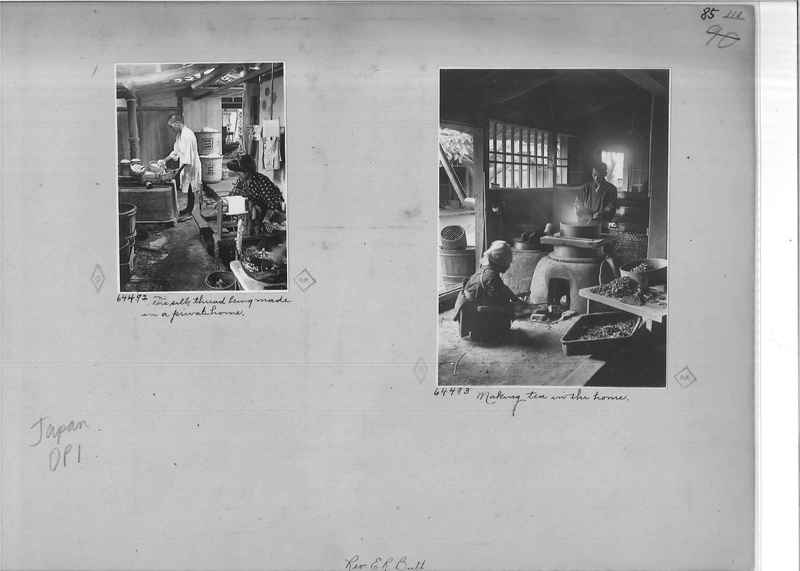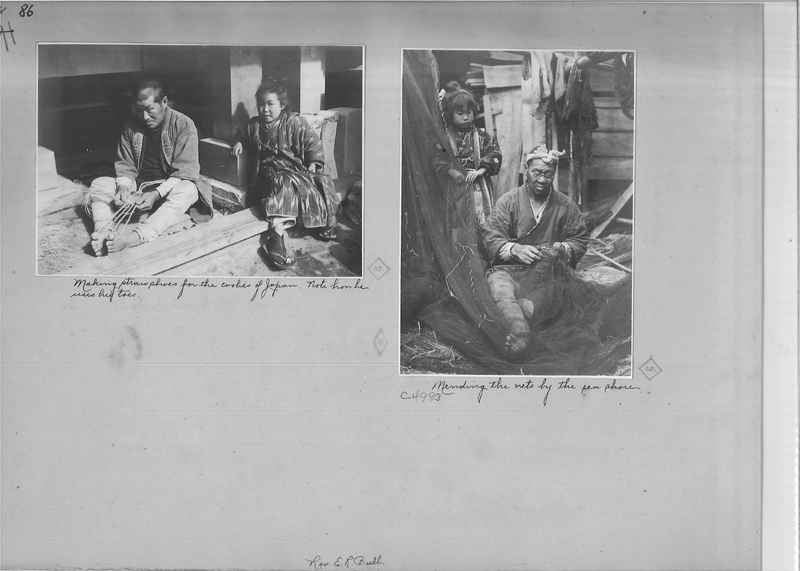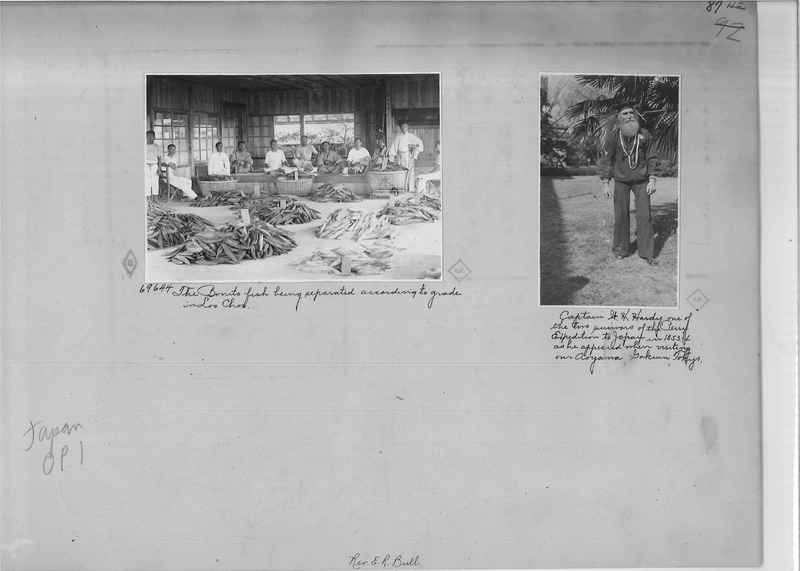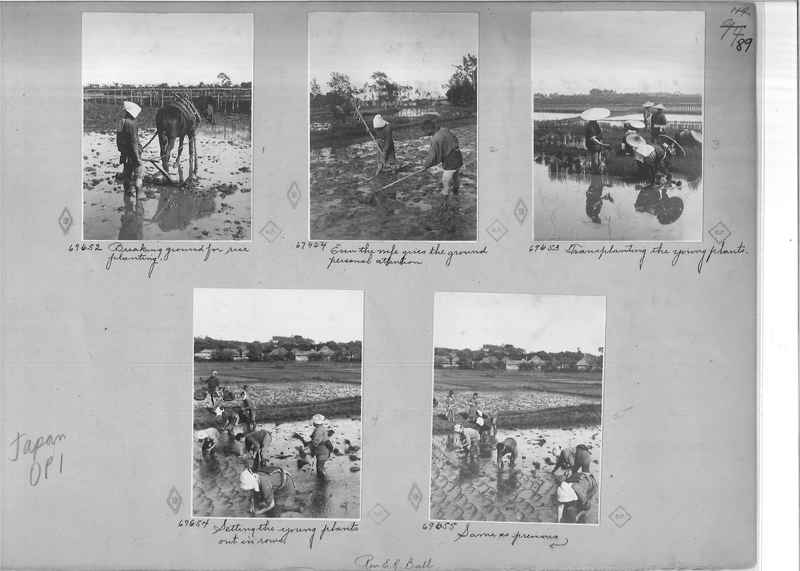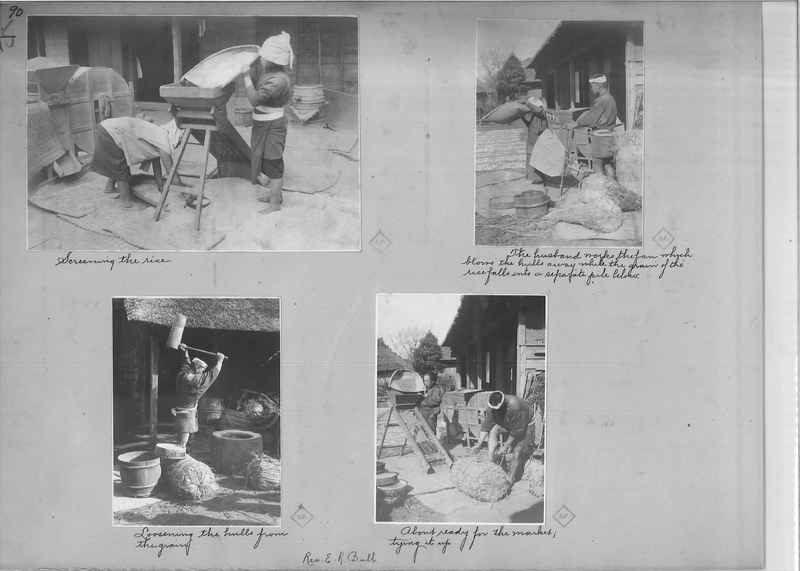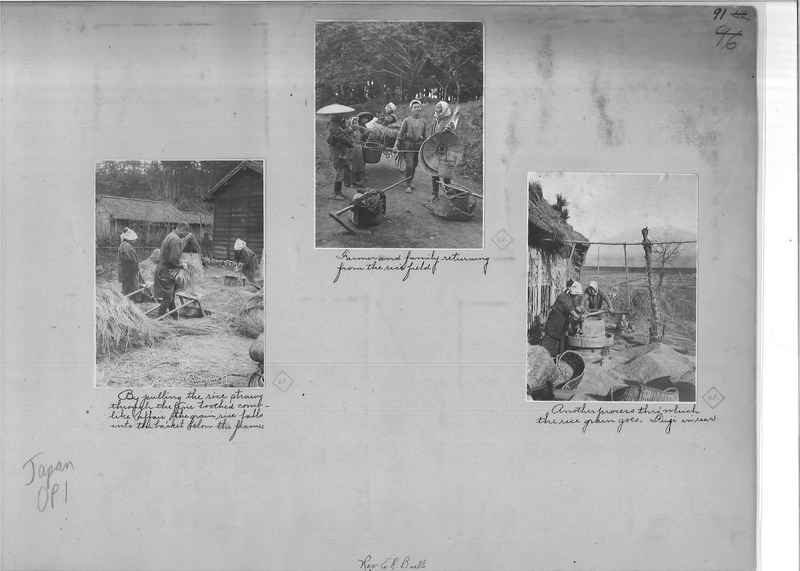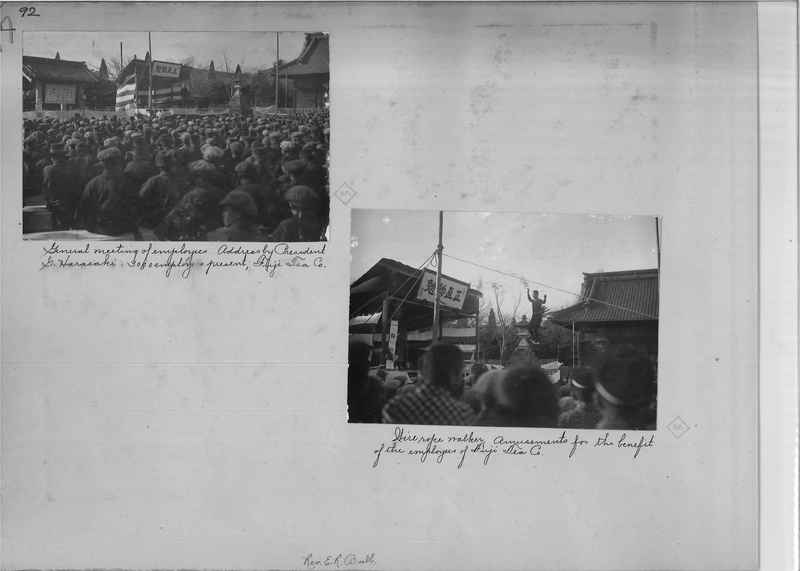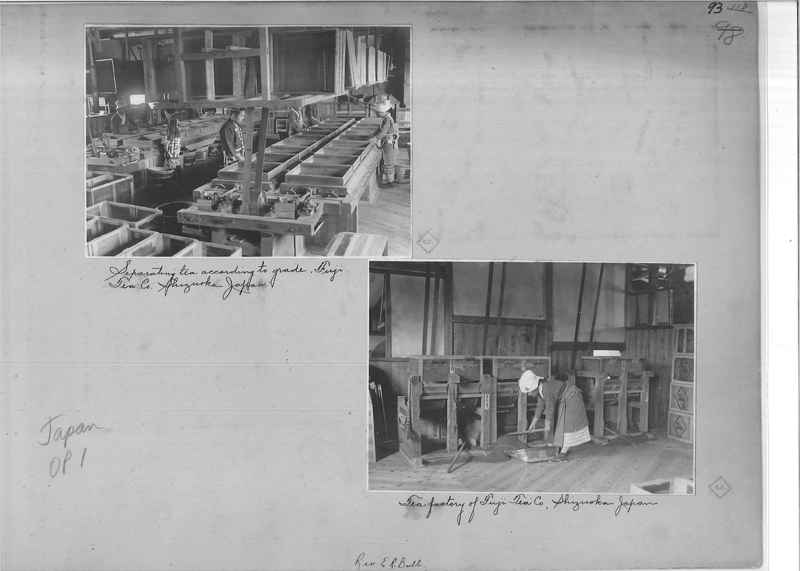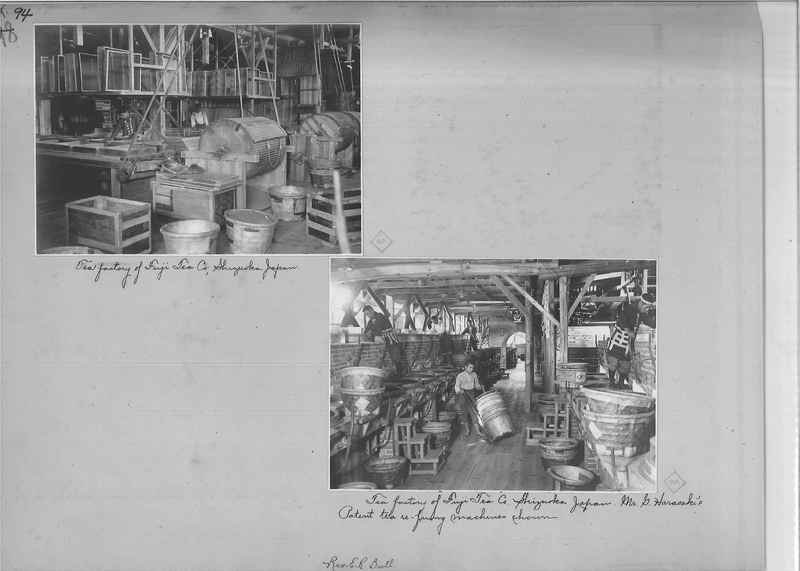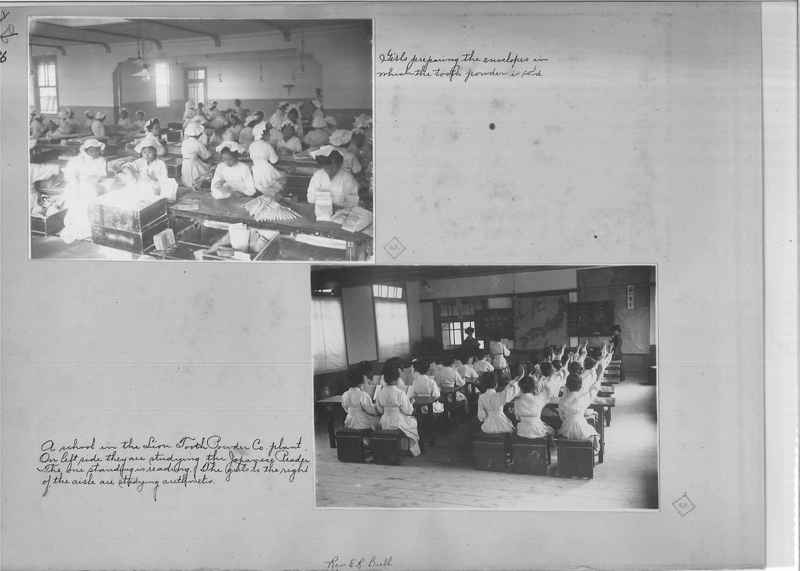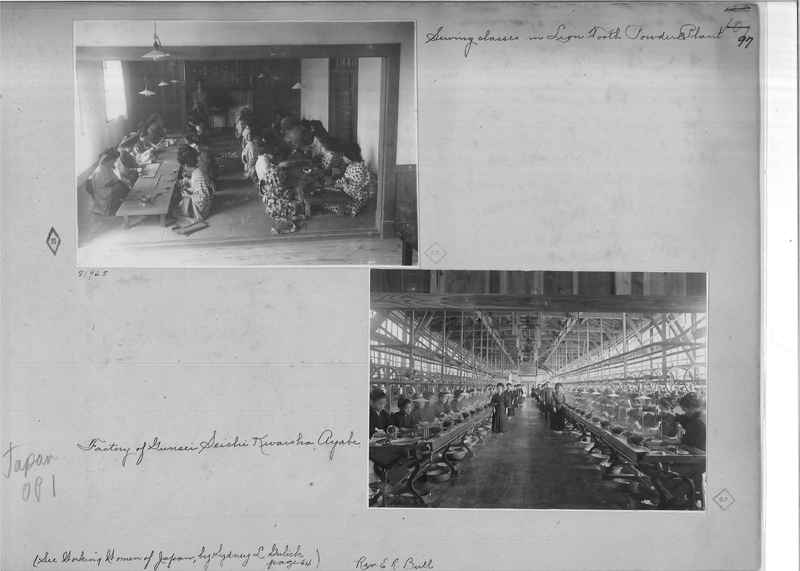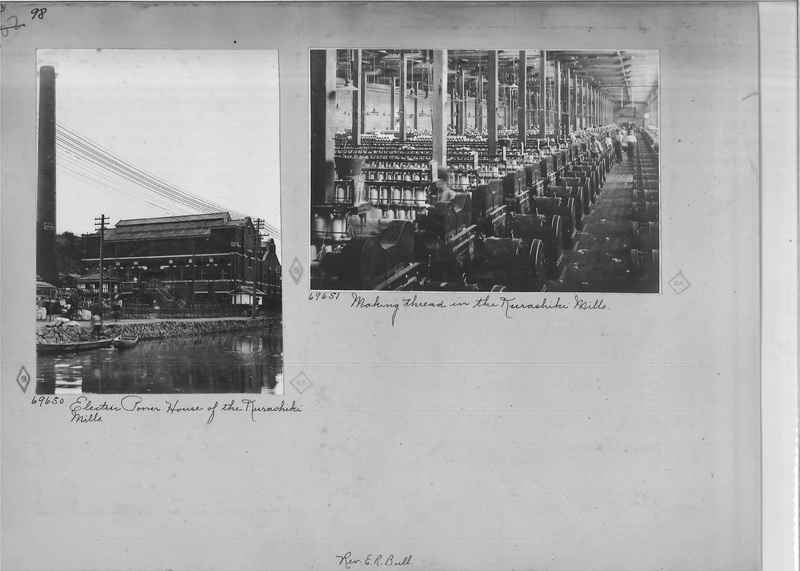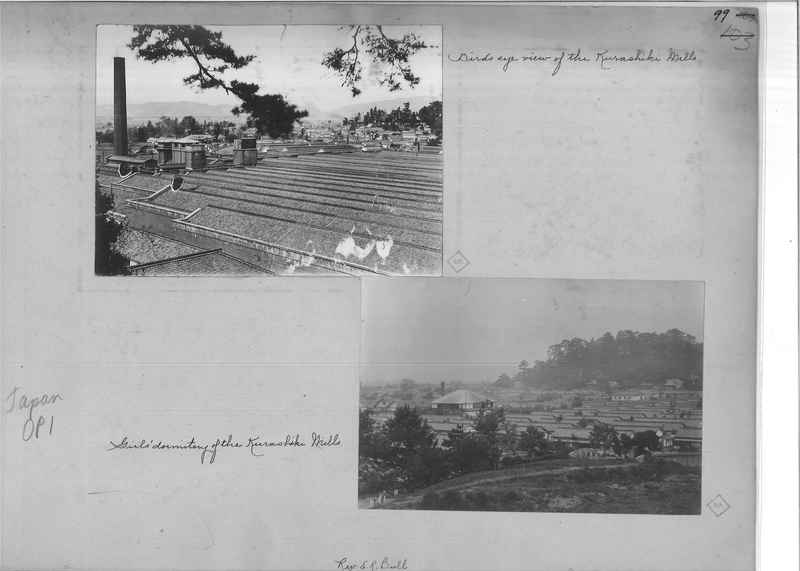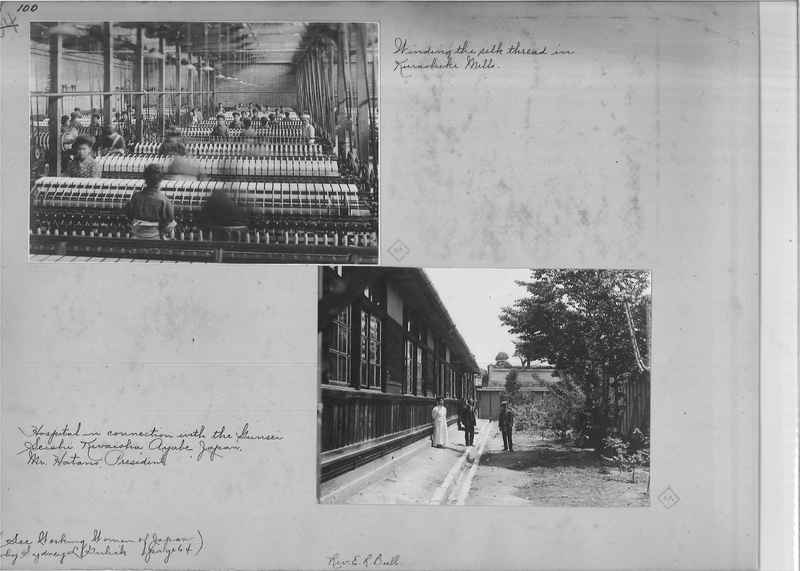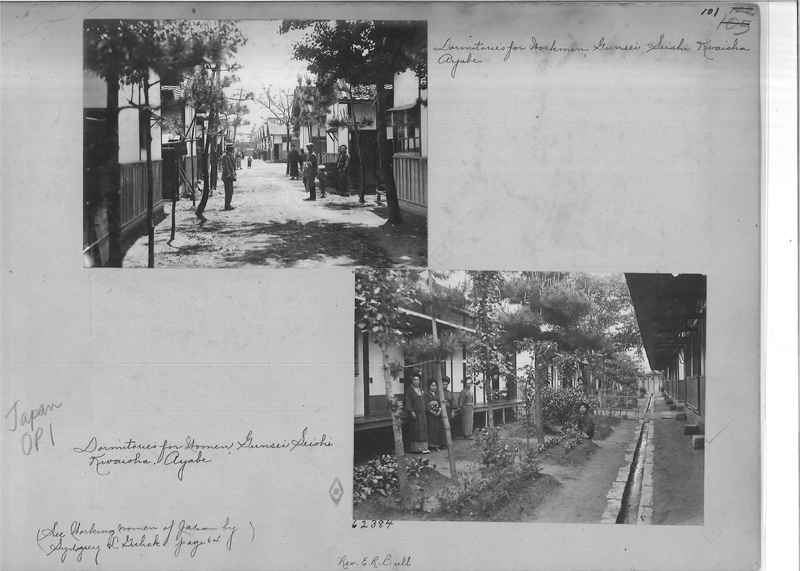Browse Items (44099 total)
Sort by:
Mission Photograph Album - Japan #06 Page 0027
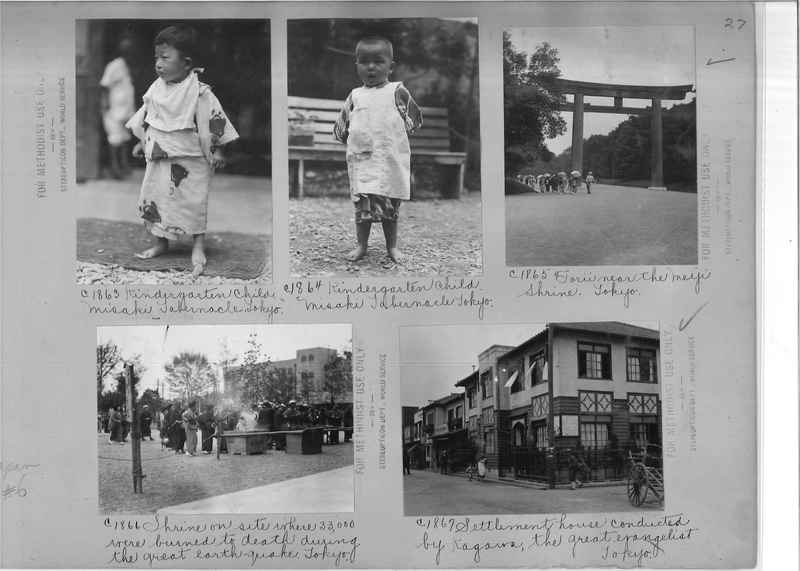
C1863 Kindergarten child. Misaki Tabernacle, Tokyo.
C1864 Kindergarten child. Misaki Tabernacle, Tokyo.
C1865 Torii near the Meiji Shrine, Tokyo.
C1866 Shrine on site where 33,000 were burned to death during the great
earth-quake, Tokyo.
C1867 Settlement house conducted by Kagawa, the great evangelist, Tokyo.
Mission Photograph Album - Japan #06 Page 0054
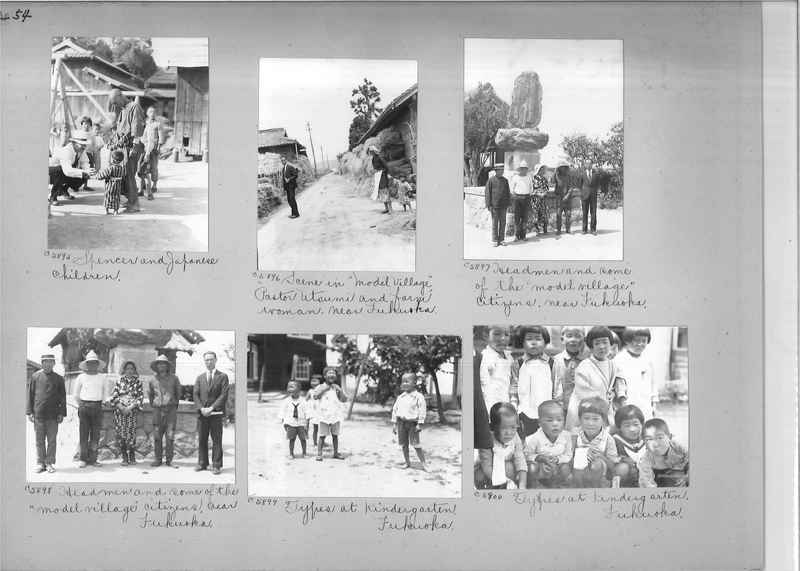
C5895 Spencer and Japanese children.
C5896 Scene in "Model Village," Pastor Utsumi and farm woman near Fukuoka.
C5897 Headmen and some of the "Model Village" citizens, near Fukuoka.
C5898 Headmen and some of the "Model Village" citizens, near Fukuoka.
C5899 Types at kindergarten, Fukuoka.
C5900 Types at kindergarten, Fukuoka.
Mission Photograph Album - Japan #06 Page 0057
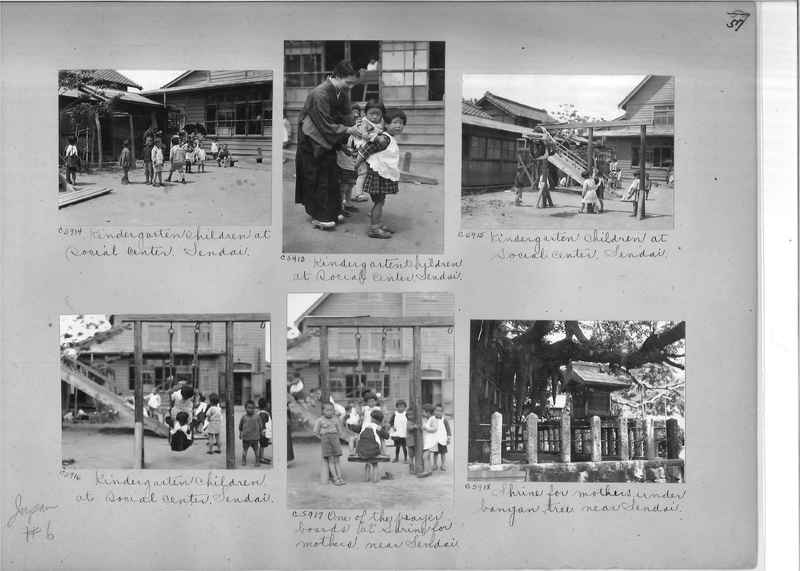
C5914 Kindergarten children at Social Center, Sendai.
C5913 Kindergarten children at Social Center, Sendai.
C5915 Kindergarten children at Social Center, Sendai.
C5916 Kindergarten children at Social Center, Sendai.
C5917 One of the prayer boards at Shrine for mothers near Sendai.
C5918 Shrine for mothers under banyan tree near Sendai.
Mission Photograph Album - Japan #06 Page 0058
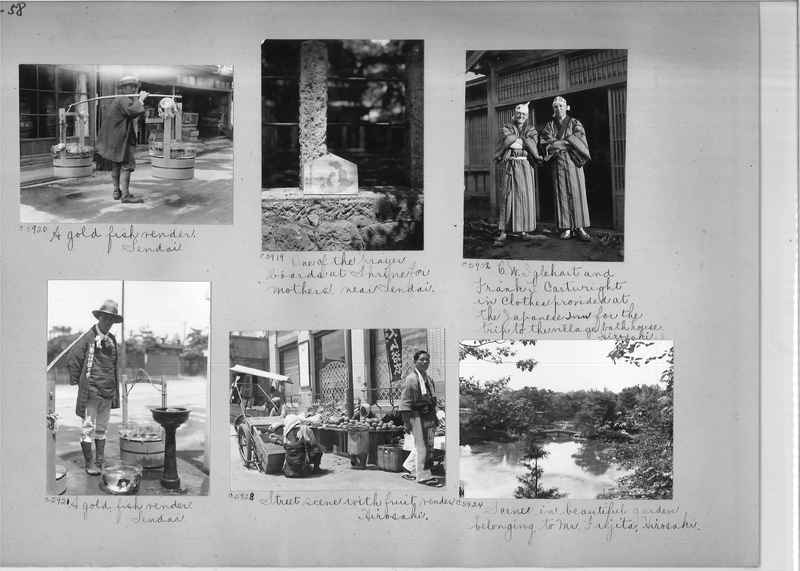
C5920 A gold fish vender, Sendai.
C5919 One of the prayer boards at Shrine for mothers near Sendai.
C5922 C.W. Iglehart and Frank T. Cartwright in clothes provided at the
Japanese inn for the trip to the village bath house, Hirosaki.
C5921 A gold fish vendor, Sendai.
C5923 Street scene with fruit vendor, Hirosaki.
C5924 Scene in beautiful garden belonging to Mr. Fujita, Hirosaki.
Mission Photograph Album - Japan #06 Page 0059
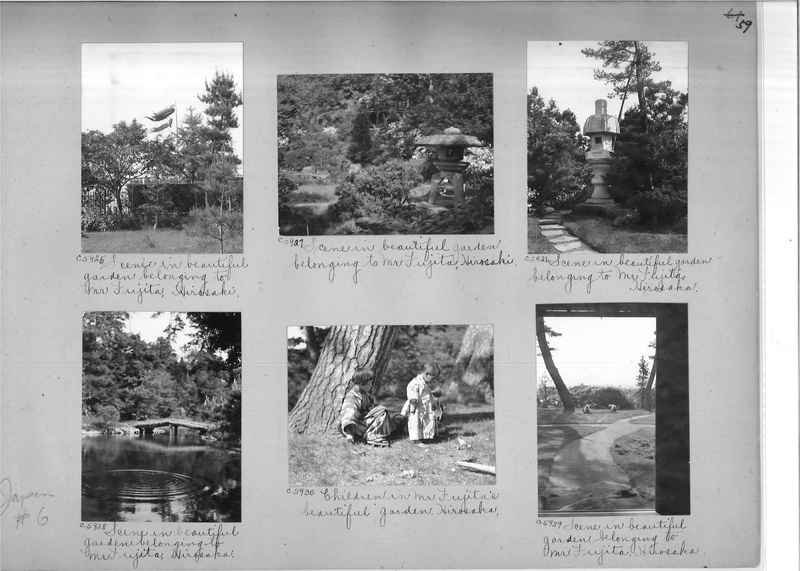
C5925 Scene in beautiful garden belonging to Mr. Fujita, Hirosaki.
C5927 Scene in beautiful garden belonging to Mr. Fujita, Hirosaki.
C5926 Scene in beautiful garden belonging to Mr. Fujita, Hirosaki.
C5928 Scene in beautiful garden belonging to Mr. Fujita, Hirosaki.
C5930 Children in Mr. Fujita's beautiful garden, Hirosaki.
C5929 Scene in beautiful garden belonging to Mr. Fujita, Hirosaki.
Mission Photograph Album - Japan #06 Page 0060
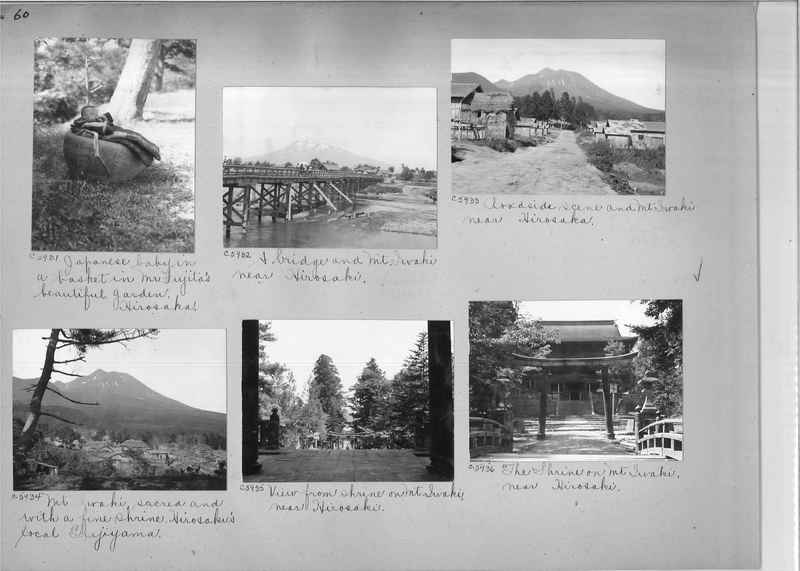
C5931 Japanese baby in a basket in Mr. Fujita's beautiful garden, Hirosaki.
C5932 A bridge and Mt. Iwaki near Hirosaki.
C5933 Roadside scene and Mt. Iwaki near Hirosaki.
C5934 Mt. Iwaki sacred and with a fine shrine. Hirosaki's local Fujiyama.
C5935 View from shrine on Mt. Iwaki near Hirosaki.
C5936 The shrine on Mt. Iwaki near Hirosaki.
Mission Photograph Album - Japan #06 Page 0061
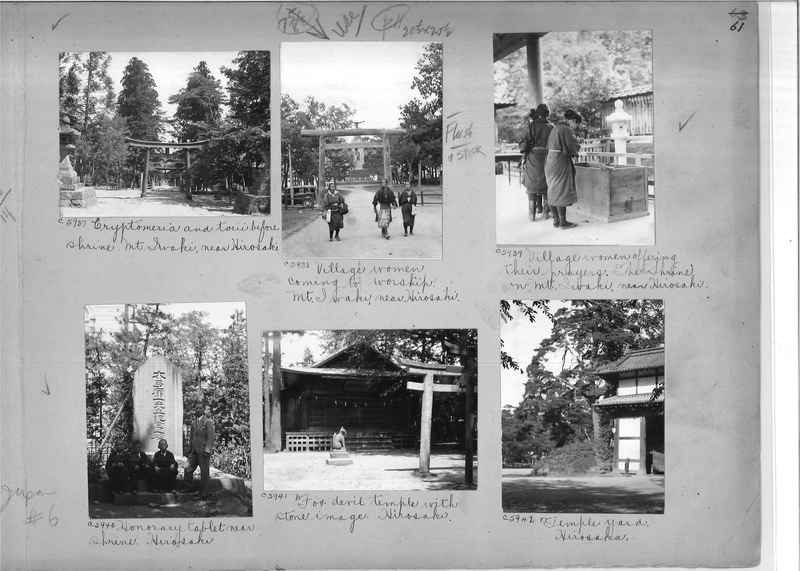
C5937 Cryptomeria and Torii before shrine, Mt. Iwaki near Hirosaki.
C5938 Village women coming to worship, Mt. Iwaki near Hirosaki.
C5939 Village women offering their prayers. The shrine on Mt. Iwaki near
Hirosaki.
C5940 Honorary tablet near shrine, Hirosaki.
C5941 Fox devil temple with stone image, Hirosaki.
C5942 Temple yard, Hirosaki.
Mission Photograph Album - Japan #06 Page 0062
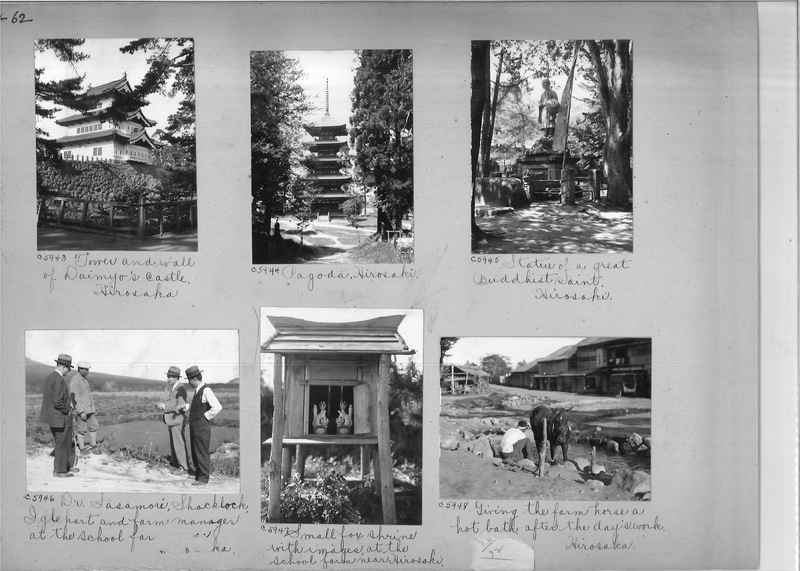
C5943 Tower and wall of Daimyo's Castle, Hirosaki.
C5944 Pagoda, Hirosaki.
C5945 Statue of a great Buddhist saint, Hirosaki.
C5946 Dr. Sasamori, Shacklock, Iglehart and farm manager at the school
farm near Hirosaki.
C5947 Small fox Shrine with images at the school farm near Hirosaki.
C5948 Giving the farm horse a hot bath after the day's work, Hirosaki.
Mission Photograph Album - Japan #06 Page 0063
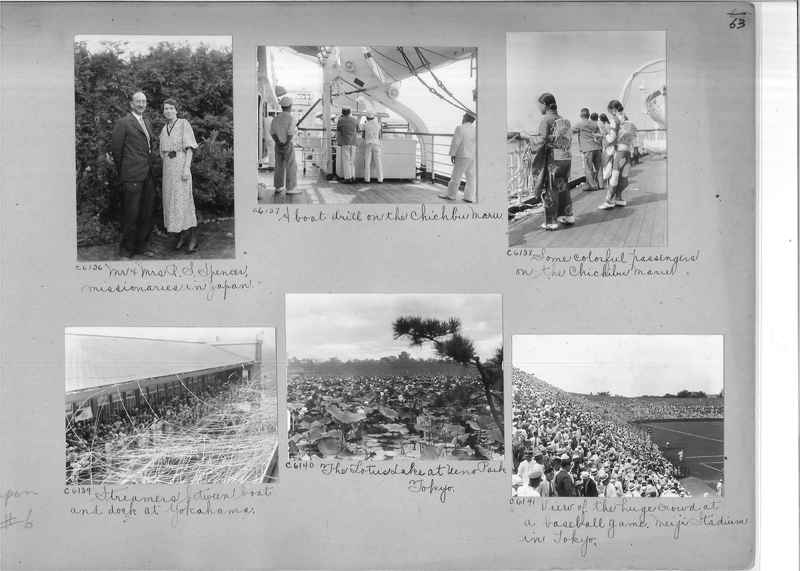
C6136 Mr. and Mrs. R.S. Spencer, missionaries in Japan.
C6137 A boat drill on the Chichibu Maru.
C6138 Some colorful passengers on the Chichibu Maru.
C6139 Streamers between boat and dock at Yokohama.
C6140 The lotus lake at Ueno Park, Tokyo.
C6141 View of the huge crowd at a baseball game, Meiji Stadium in Tokyo.
Mission Photograph Album - Japan #06 Page 0064
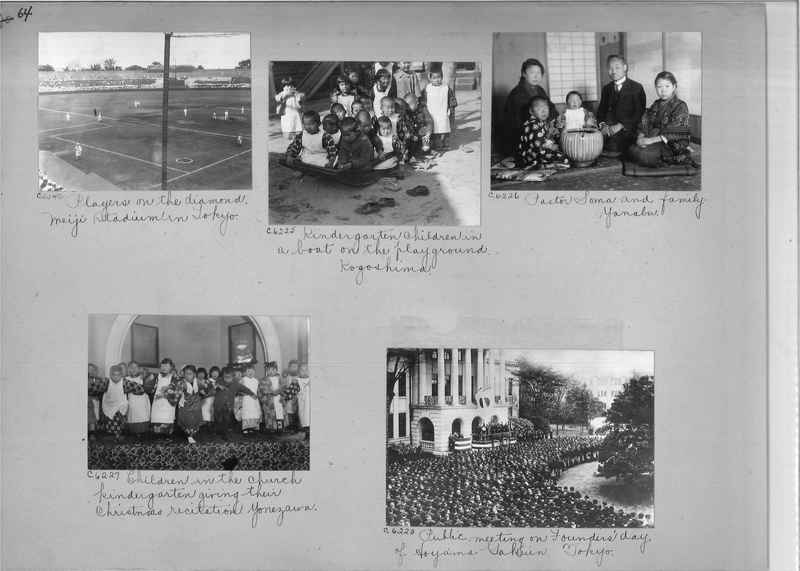
C6140 Players on the diamond, Meiji Stadium in Tokyo.
C6225 Kindergarten children in a boat on the playground, Kagoshima.
C6226 Pastor Soma and family, Yanabu.
C6227 Children in the church kindergarten giving their Christmas
recitation, Yonezawa.
C6223 Public meeting on Founder's Day of Aoyama Gakuin, Tokyo.
Mission Photograph Album - Japan #06 Page 0070
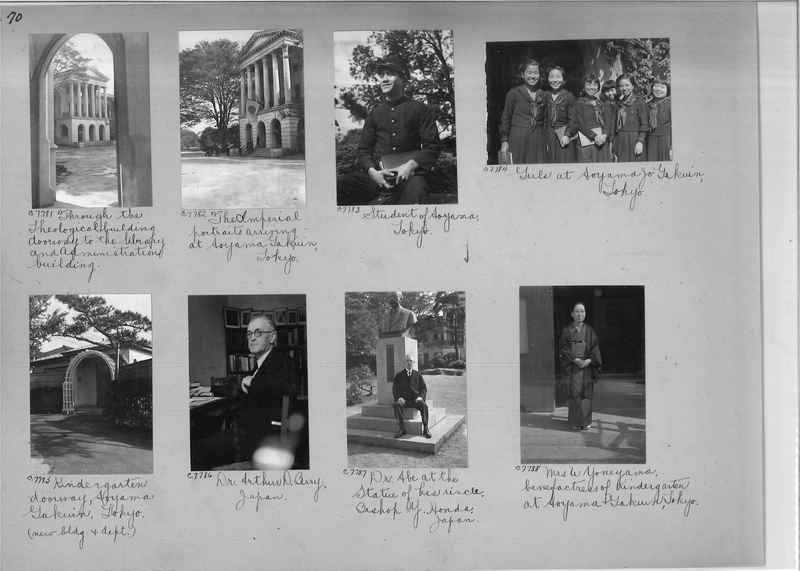
C7781 Through the theological building doorway to the library and
administration building.
C7782 The Imperial portraits arriving at Aoyama Gakuin, Tokyo.
C7783 Student of Aoyama, Tokyo.
C7784 Girls at Aoyama Jo Gakuin, Tokyo.
C7785 Kindergarten doorway, Aoyama Gakuin, Tokyo. (new bldg and dept.)
C7786 Dr. Arthur D. Berry, Japan.
C7787 Dr. Abe at the statue of his uncle Bishop Y. Honda, Japan.
C7788 Mrs. W. Yoneyama, benefactress of Kindergarten at Aoyama Gakuin,
Tokyo.
Mission Photograph Album - Japan #06 Page 0075
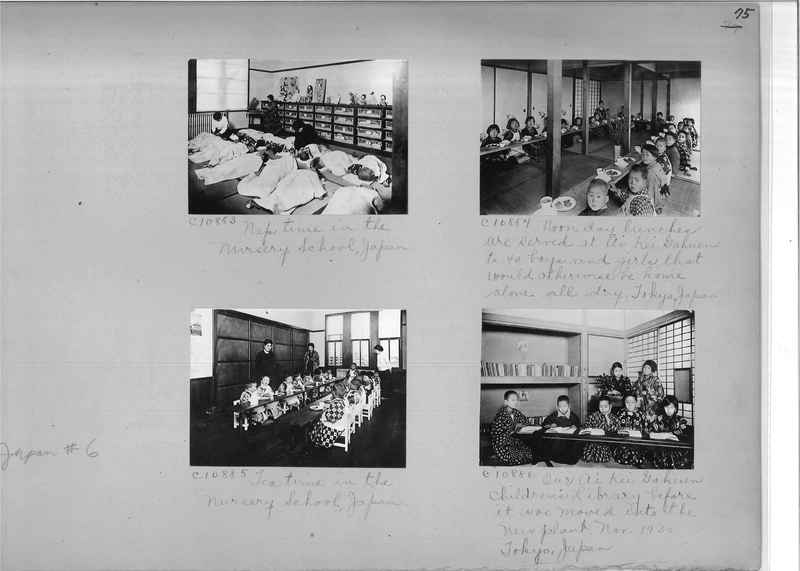
C10883 Nap time in the nursery school, Japan.
C10884 Noon day lunches are served at Ai Kei Gakuen to 40 boys and girls
that would otherswise be home alone all day, Tokyo, Japan.
C10885 Tea time in the nursery school, Japan.
C10886 Our Aikei Gakuen children's library before it was moved into the
new plant, Nov. 1930. Tokyo, Japan.
Mission Photograph Album - Japan #06 Page 0076
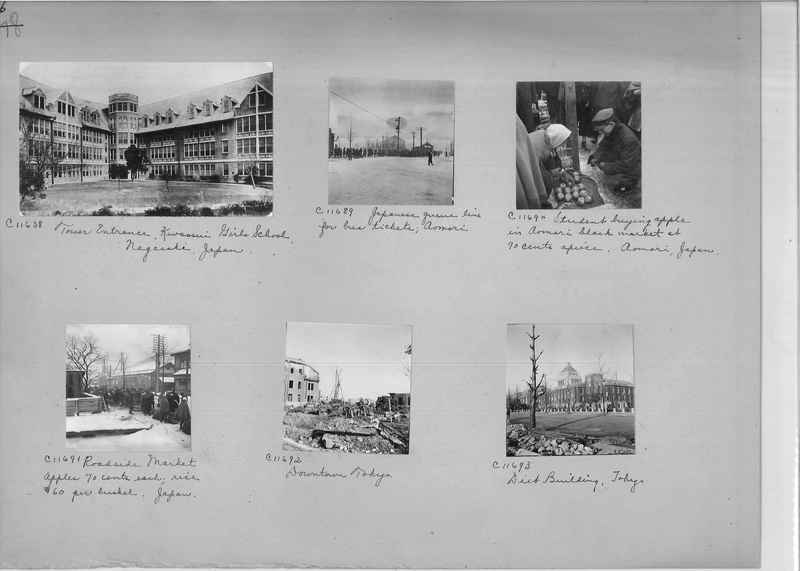
C11638 Tower entrance, Kwassui Girls School, Nagasaki, Japan.
C11689 Japanese queue line for bus tickets, Aomori.
C11690 Student buying apple in Aomori black market at 70 cents apiece.
Aomori, Japan.
C11691 Roadside market apples 70 cents each; rice $60 per bushel. Japan.
C11692 Downtown, Tokyo.
C11693 Diet Building, Tokyo.
Mission Photograph Album - Japan #06 Page 0077
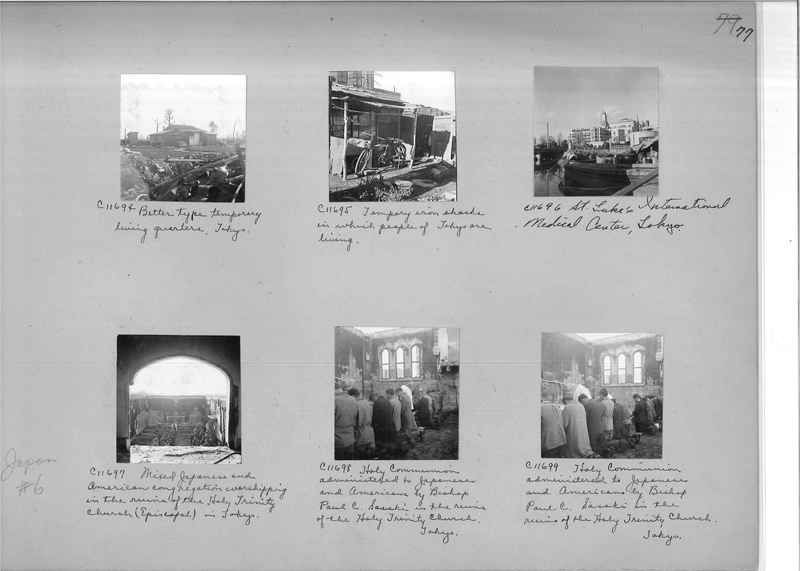
C11694 Better type temporary living quarters, Tokyo.
C11695 Temporary iron shacks in which people of Tokyo are living.
C11696 St. Luke's International Medical Center, Tokyo.
C11697 Mixed Japanese and American congregation worshipping in the ruins
of the Holy Trinity Church (Episcopal) in Tokyo.
C11698 Holy Communion administration to Japanese and American by Bishop
Paul C. Sasaki in the ruins of the Holy Trinity Church. Tokyo.
C10 Holy Communion administration to Japanese and American by Bishop Paul
C. Sasaki in the ruins of the Holy Trinity Church. Tokyo.
Mission Photograph Album - Japan #06 Page 0078
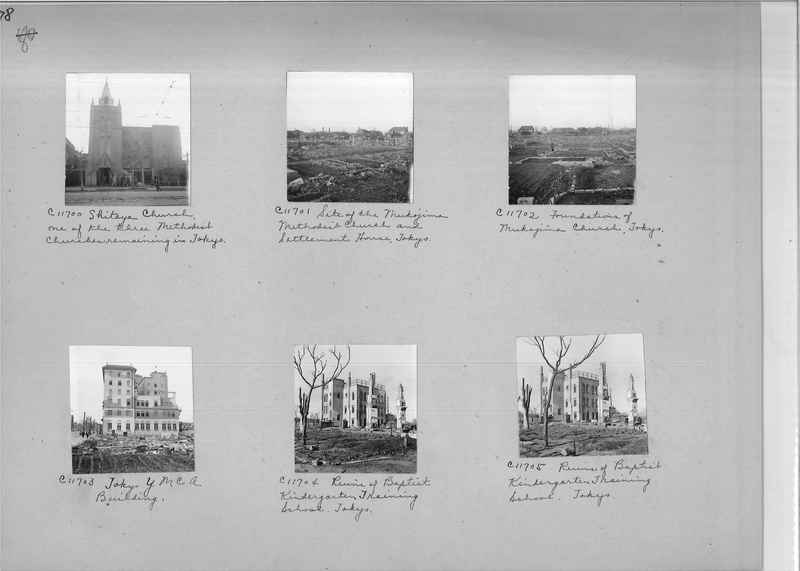
C11700 Shitaya Church, one of the three Methodist Churches remaining in
Tokyo.
C11701 Site of the Mukojima Methodist Church and Settlement House, Tokyo.
C11702 Foundation of Mukojima Church, Tokyo.
C11703 Tokyo Y.M.C.A. building.
C11704 Ruins of Baptist Kindergarten Training School, Tokyo.
C11705 Ruins of Baptist Kindergarten Training School, Tokyo.
Mission Photograph Album - Japan #06 Page 0079
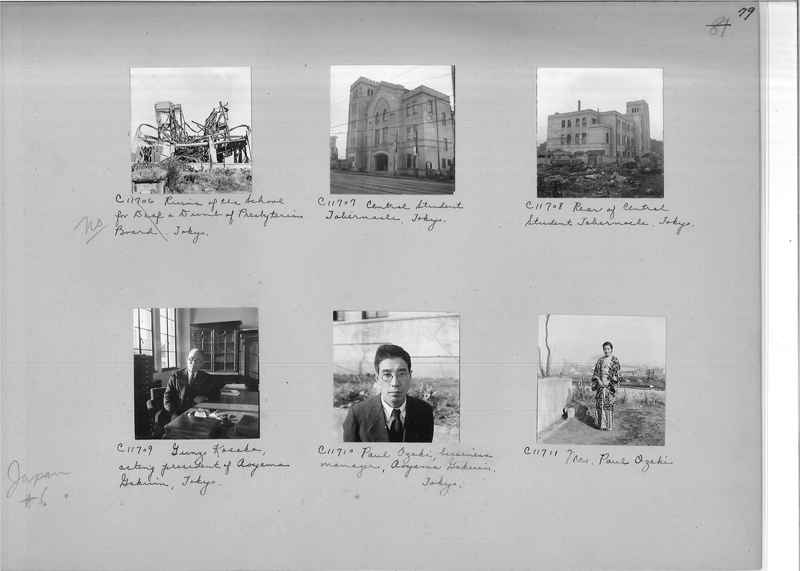
C11706 Ruins of the School for Deaf and Dumb of Presbyterian Board, Tokyo.
C11707 Central Student Tabernacle, Tokyo.
C11708 Rear of Central Student Tabernacle, Tokyo.
C11709 Gunzo Kosaka, Acting President of Aoyama Gakuin, Tokyo.
C11710 Paul Ozaki, business manager, Aoyama Gakuin, Tokyo.
C11711 Mrs. Paul Ozaki.
Mission Photograph Album - Japan #06 Page 0080
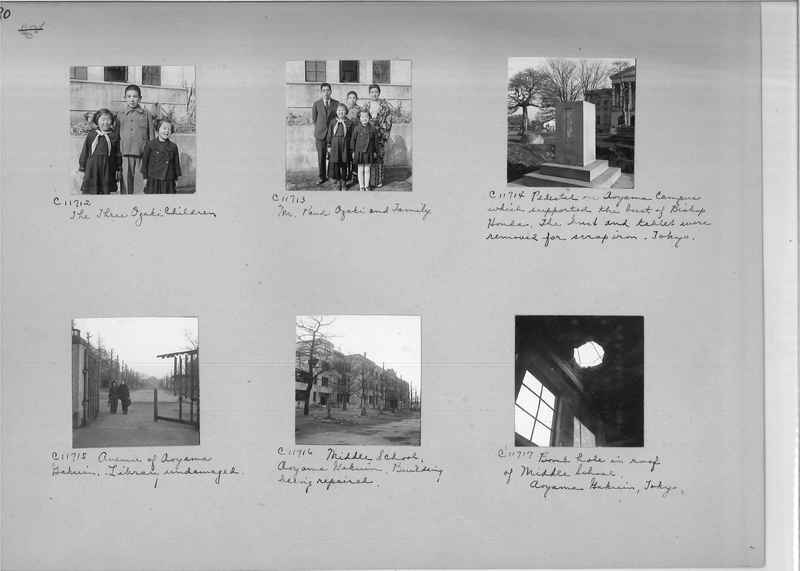
C11712 The three Ozaki children.
C11713 Mr. Paul Ozaki and family.
C11714 Pedestal on Aoyama campus which supported the bust of Bishop Honda.
The bust and tablet were removed for scrap iron, Tokyo.
C11715 Avenue of Aoyama Gakuin, library undamaged.
C11716 Middle school, Aoyama Gakuin, building being repaired.
C11717 Bomb hole in roof of middle school, Aoyama Gakuin, Tokyo.
Mission Photograph Album - Japan #06 Page 0081
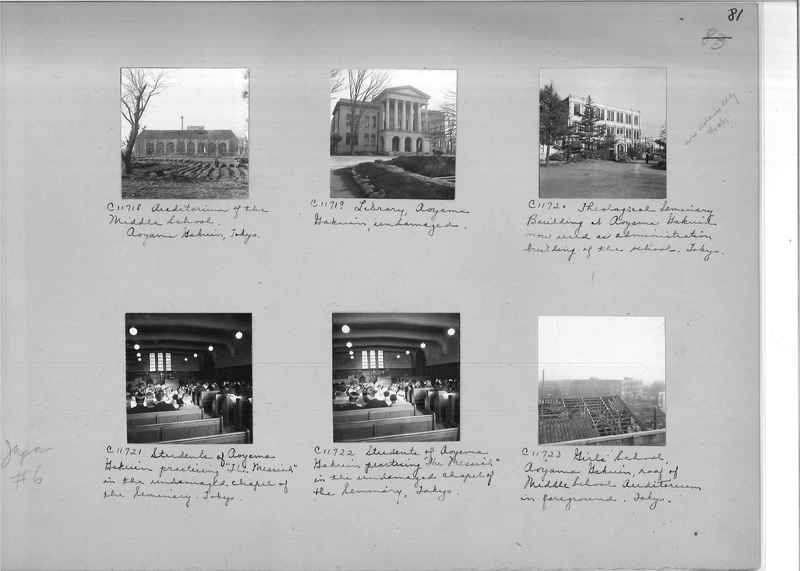
C11718 Auditorium of the middle school, Aoyama Gakuin, Tokyo.
C11719 Library, Aoyama Gakuin, undamaged.
C11720 Theological Seminary building at Aoyama Gakuin, now used as
administration building of the school. Tokyo.
C11721 Students of Aoyama Gakuin practicing " The Messiah" in the
undamaged chapel of the seminary. Tokyo.
C11722 Students of Aoyama Gakuin practicing " The Messiah" in the
undamaged chapel of the seminary. Tokyo.
C11723 Girls School, Aoyama Gakuin, roof of middle school auditorium in
foreground, Tokyo.
Mission Photograph Album - Japan #06 Page 0082
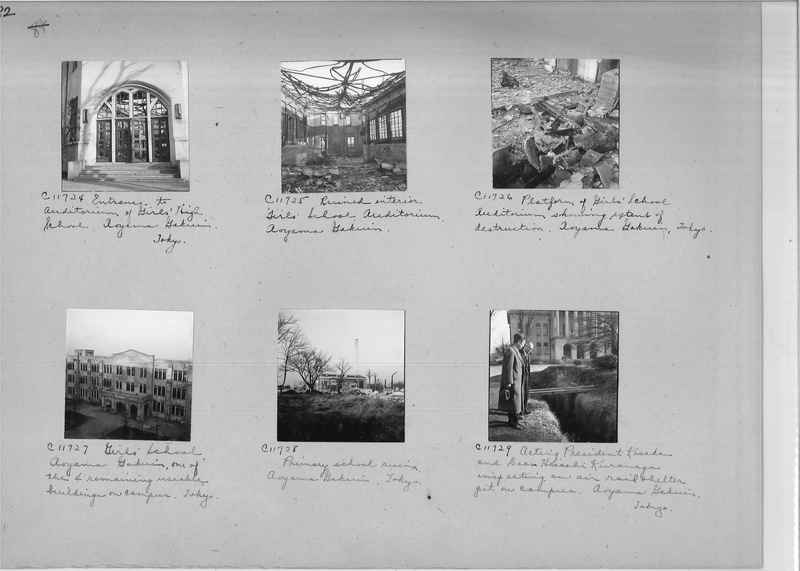
C11724 Entrance to auditorium of Girls High School, Aoyama Gakuin, Tokyo.
C11725 Ruins interior Girls School auditorium, Aoyama Gakuin.
C11726 Platform of Girls School auditorium showing extent of destruction.
Aoyama Gakuin, Tokyo.
C11727 Girls School, Aoyama Gokuin, one of the 4 remaining useable
building on campus, Tokyo.
C11728 Primary school ruined, Aoyama Gakuin, Tokyo.
C11729 Acting President Kosaka and Dean Hisashi Kuranoga inspecting an air
rail shelter pit on campus. Aoyama Gakuin, Tokyo.
Mission Photograph Album - Japan #06 Page 0083
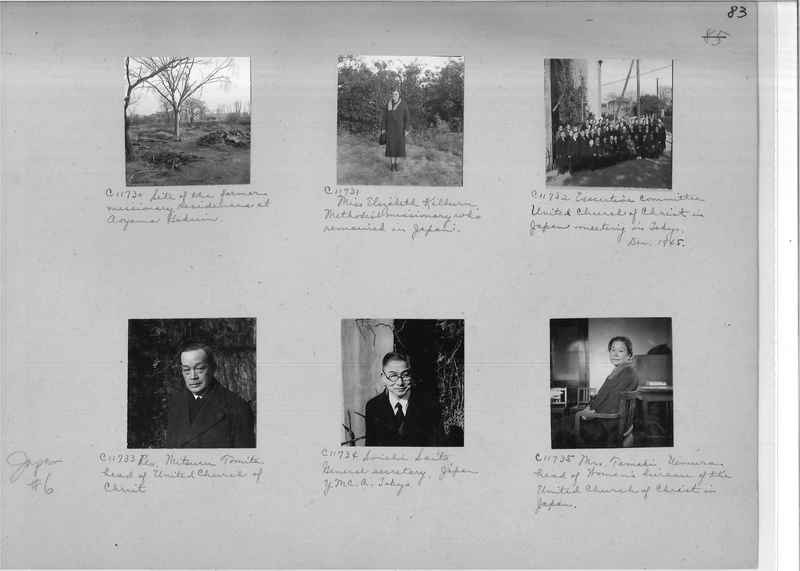
C11730 Site of the former missionary residences at Aoyama Gakuin.
C11731 Miss Elizabeth Kilburn, Methodist missionary who remained in Japan.
C11732 Executive Committee United Church Christ in Japan meeting in Tokyo.
Dec. 1945.
C11733 Rev. Mitsuru Tomita, head of United Church of Christ.
C11734 Soichi Saito, General Secretary, Japan Y.M.C.A., Tokyo.
C11735 Mrs. Tamaki Uemura, head of Women's Bureau of the United Church of
Christ in Japan.
Mission Photograph Album - Japan #06 Page 0084
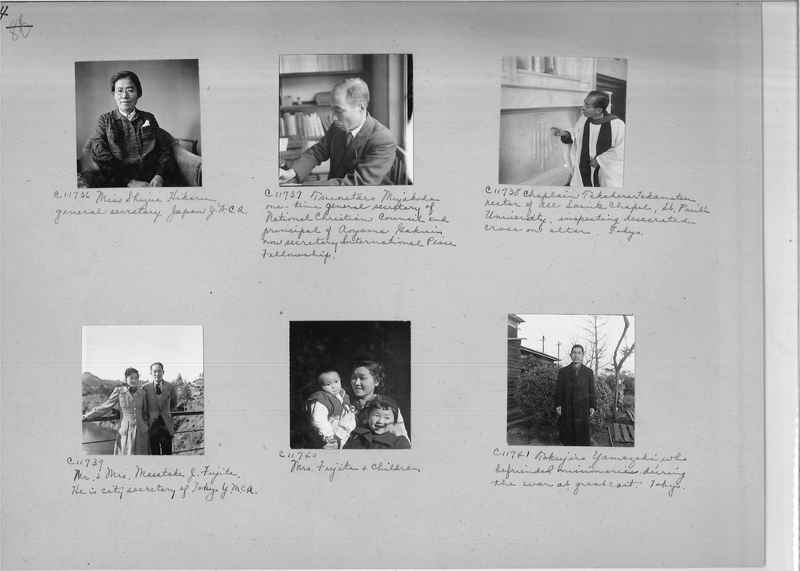
C11736 Miss Shizue Hikoru, General Secretary, Japan Y.W.C.A.
C11737 Tsunetoro Miyakoda, one-time General Secretary of National
Christian Council and Principal of Aoyama Gakuin, now Secretary (of)
International Peace Fellowship.
C11738 Chaplain Takahara Tokamatsu, rector of All Saints Chapel, St.
Paul's University, inspecting destructed cross on altar, Tokyo.
C11739 Mr. and Mrs. Masatoke J. Fujita. He is City Secretary of Tokyo
Y.M.C.A.
C11740 Mrs. Fujita and children.
C11741 Tokujiro Yamazaki, who befriended missionaries during the war at
great cost, Tokyo.
Mission Photograph Album - Japan #06 Page 0085
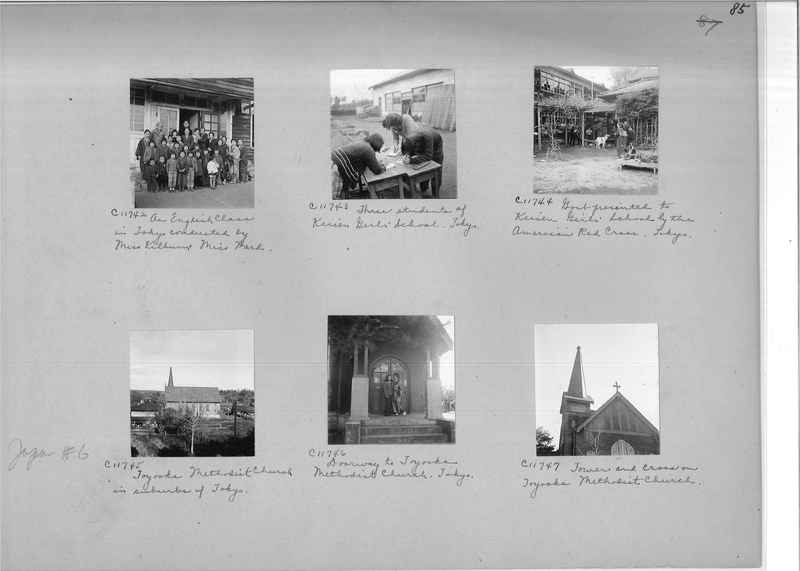
C11742 An English class in Tokyo conducted by Miss Kilburn and Miss Ward.
C11743 Three students of Keisen Girls School, Tokyo.
C11744 Goat presented to Keisen Girls School by the American Red Cross,
Tokyo.
C11745 Toyooka Methodist Church in suburbs of Tokyo.
C11746 Doorway to Toyooka Methodist Church, Tokyo.
C11747 Tower and cross on Toyooka Methodist Church
Mission Photograph Album - Japan #06 Page 0087
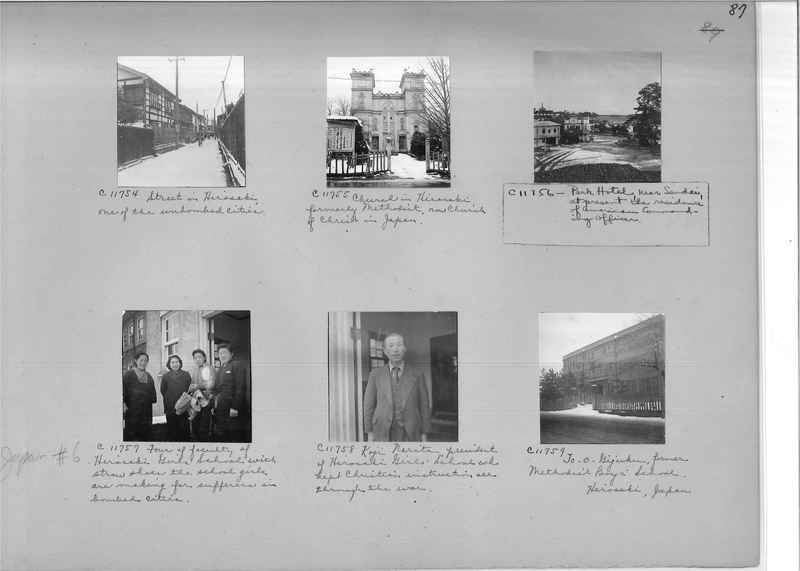
C11754 Street in Hirosaki, one of the unbombed cities.
C11755 Church in Hirosaki, formerly Methodist, now Church of Christ in
Japan.
C11756 Park Hotel, near Sendai, at present the residence of American
Commanding Officer.
C11757 Four of faculty of Hirosaki Girls School with straw shoes the
school girls are making for sufferers in bombed cities.
C11758 Koji Narita, President of Hirosaki Girls School who kept Christian
Instruction all through the war.
C11759 To-O-Gijuku, former Methodist Boys School. Hirosaki, Japan.
Mission Photograph Album - Japan #06 Page 0088
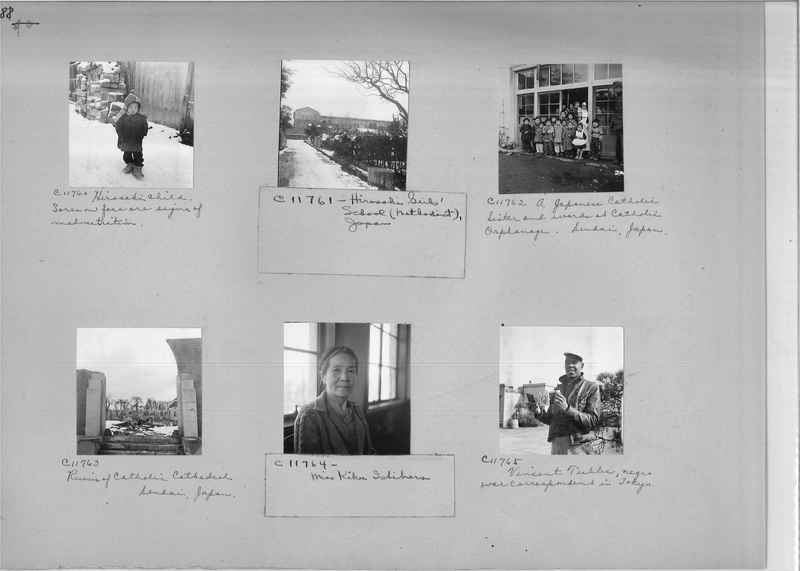
C11760 Hirosaki child. Sores on face are signs of malnutrition.
C11761 Hirosaki Girls School (Methodist), Japan.
C11762 A Japanese Catholic Sister and words at Catholic Orphanage,
Sendai, Japan.
C11763 Ruins of Catholic Cathedral. Sendai, Japan.
C11764 Miss Kiku Ishibara.
C11765 Vincent Tubbs, negro war correspondent in Tokyo.
Mission Photograph Album - Japan #06 Page 0089
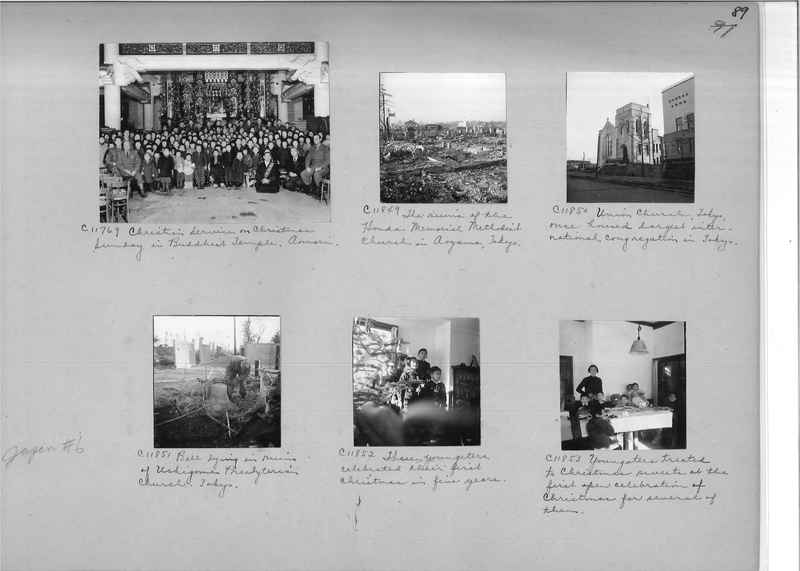
C11769 Christian Service on Christmas Sunday in Buddhist Temple, Aomori.
C11849 The ruins of the Honda Memorial Methodist Church in Aoyama, Tokyo.
C11850 Union Church, Tokyo, once housed largest international Congregation
in Tokyo.
C11851 Bell lying in ruin of Ushigome Presbyterian Church, Tokyo.
C11852 These youngsters celebrated their first Christmas in five years.
C11853 Youngsters treated to Christmas sweets at the first open
celebration of Christmas for several of them.
Mission Photograph Album - Japan #06 Page 0090
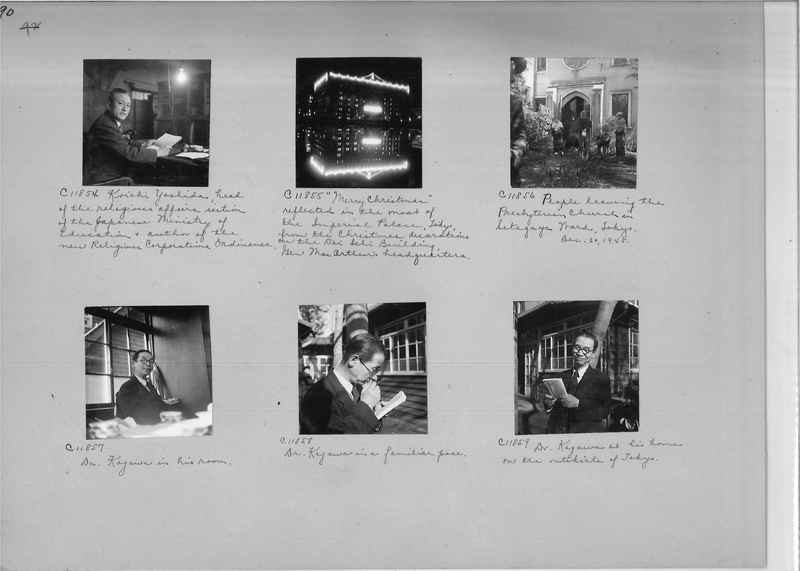
C11854 Koishi Yoshida, head of the Religious Affairs Section of the
Japanese Ministry of Education and Author of the new Religious Corporations
Ordinance.
C11855 "Merry Christmas," reflected in the moat of the Imperial Palace,
Tokyo, from the Christmas decorations on the Doi Ichi Building, Gen.
MacArthur's headquarters.
C11856 People leaving the Presbyterian Church in Setagaya Word, Tokyo.
Dec. 30, 1945.
C11857 Dr. Kagawa in his room.
C11858 Dr. Kagawa in a familiar pose.
C11859 Dr. Kagawa at his home on the outskirts of Tokyo.
Mission Photograph Album - Japan #06 Page 0091
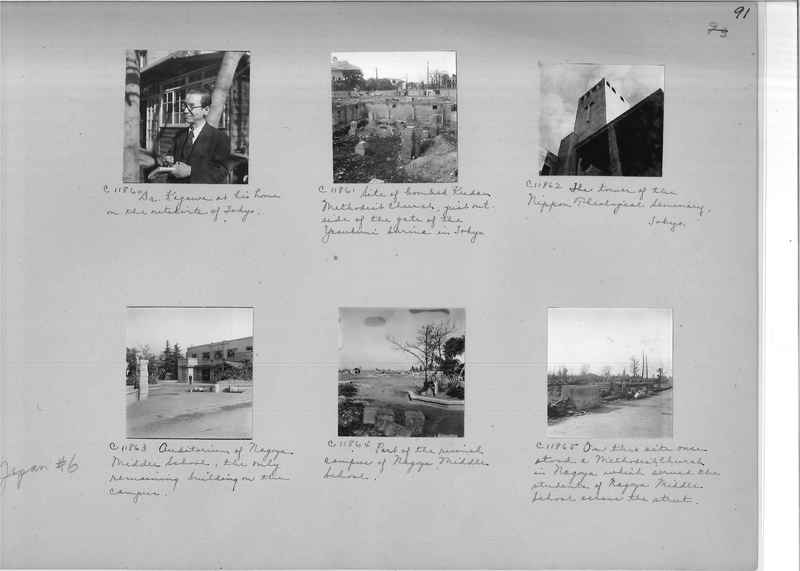
C11860 Dr. Kagawa at his home on the outskirts of Tokyo.
C11861 Site of bombed Methodist Church, just outside of the gate of the
Yosukuni Shrine in Tokyo.
C11862 The tower of the Nippon Theological Seminary, Tokyo.
C11863 Auditorium of Nagoya Middle School, the only remaining building on
the campus.
C11864 Part of the ruined campus of Nagoya Middle School.
C11865 On this site once stood a Methodist Church in Nagoya which served
the students of Nagoya Middle School across the street.
Mission Photograph Album - Japan #06 Page 0092
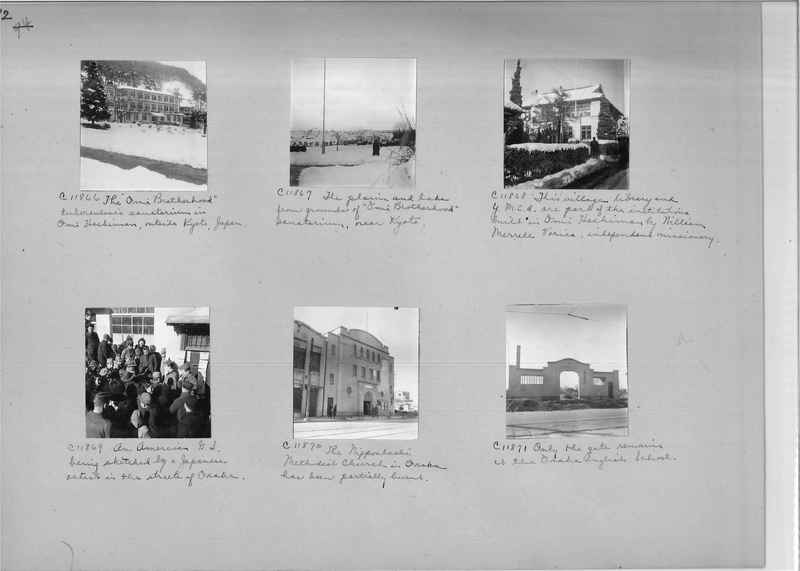
C11866 The "Omi Brotherhood" tuberculosis sanatorium in Omi Hachiman,
outside Kyoto, Japan.
C11867 The plains and lake from grounds of "Omi Brotherhood" sanatorium,
near Kyoto.
C11868 This village library and Y.M.C.A. are part of the institutions
built in Omi Hachman by William Merrell Vories, independent missionary.
C11869 An American S.I. being sketched by a Japanese artist in the streets
of Osaka.
C11870 The Nipponbaslic Methodist Church in Osaka has been partially
burned.
C11871 Only the gate remains at the Osaka English School.
Mission Photograph Album - Japan #06 Page 0093
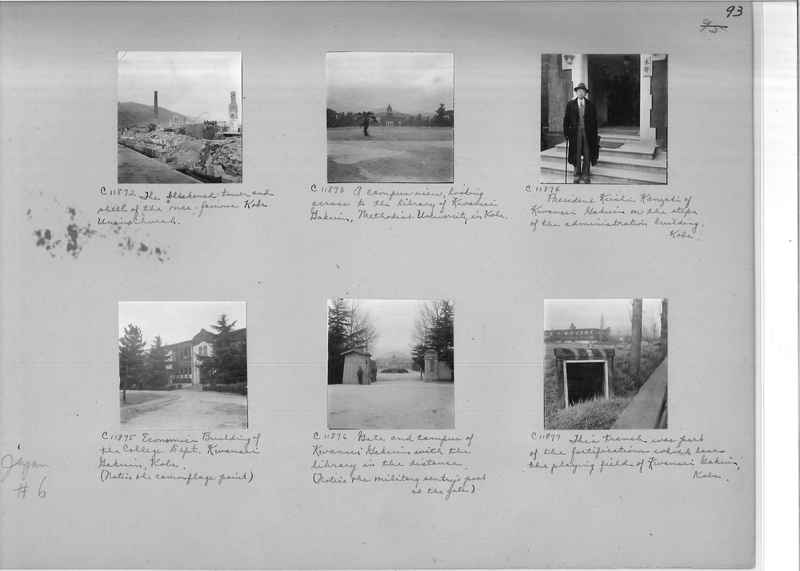
C11872 The blackened tower and shell of the once famous Kobe Union Church.
C11873 A campus view, looking across to the library of Kwansei Gakuin,
Methodist University in Kobe.
C11874 President Kiichi Kanzshi of Kwansei Gakuin on the steps of the
administration building, Kobe.
C11875 Economic building of the college Dept. Kwansei Gakuin, Kobe.
(Notice the camouflage paint)
C11876 Gate and campus of Kwansei Gakuin with the library in the distance.
(Notice the military sentry's post at the gate)
C11877 This trench was part of the fortifications which lace the playing
field of Kwansei Gakuin, Kobe.
Mission Photograph Album - Japan #06 Page 0094
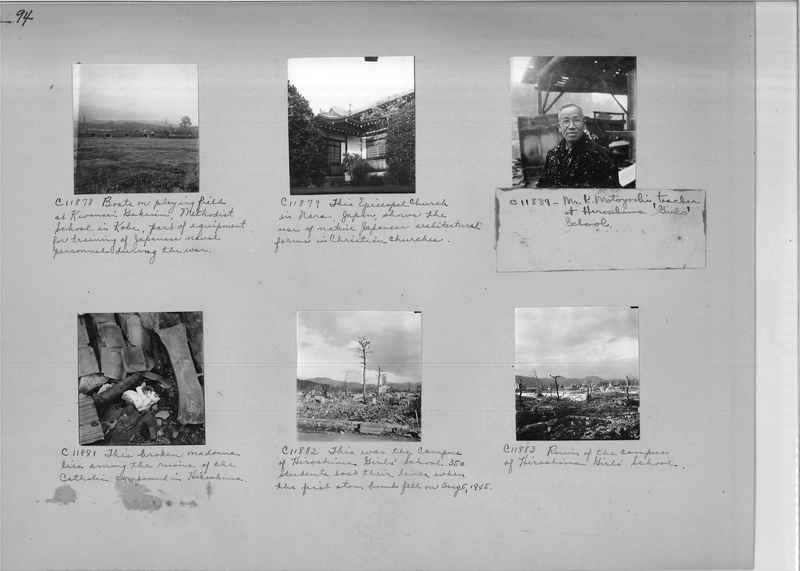
C11878 Boots on playing field at Kwansei Gakuin, Methodist School in Kobe,
part of equipment for training of Japanese naval personnel during the war.
C11879 This Episcopal Church in Nara, Japan, shows the use of native
Japanese architectural forms in Christian churches.
C11889 Mr. K. Motoyoshi, teacher at Hiroshima Girls School.
C11881 This broken Madonna lies among the ruins of the Catholic compound
in Hiroshima.
C11882 This was the campus of Hiroshima Girls School. 350 students lost
their lives when the first atom bomb fell on Aug. 5, 1945.
C11883 Ruins of the campus of Hiroshima Girls School.
Mission Photograph Album - Japan #06 Page 0095
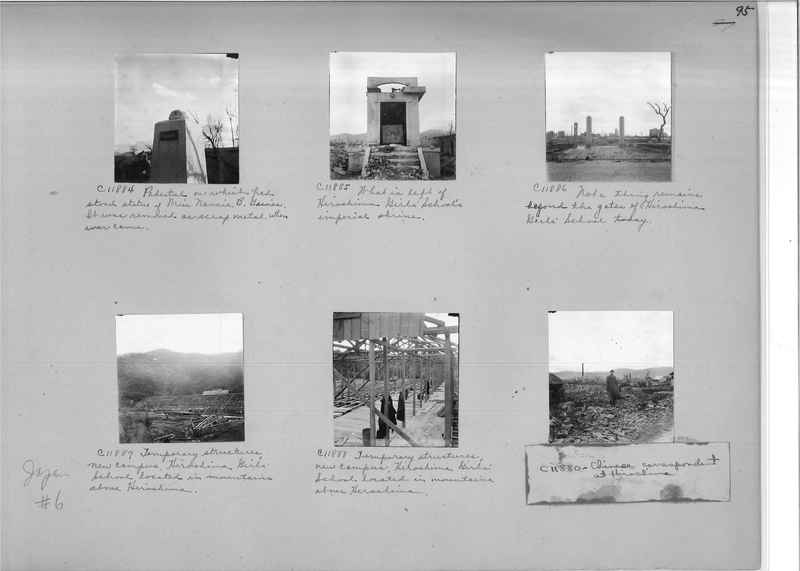
C11884 Pedestal on which had stood statue of Miss Nannie B. Gaines. It
was removed as scrap metal when war came.
C11885 What is left of Hiroshima Girls School's imperial shrine.
C11886 Not a thing remians beyond the gates of Hiroshima Girls School
today.
C11887 Temporary structures new campus. Hiroshima Girls School located in
mountains above Hiroshima.
C11888 Temporary structures, new campus, Hiroshima Girls School, located
in mountains above Hiroshima.
C11880 Chinese correspondent at Hiroshima.
Mission Photograph Album - Japan #06 Page 0096
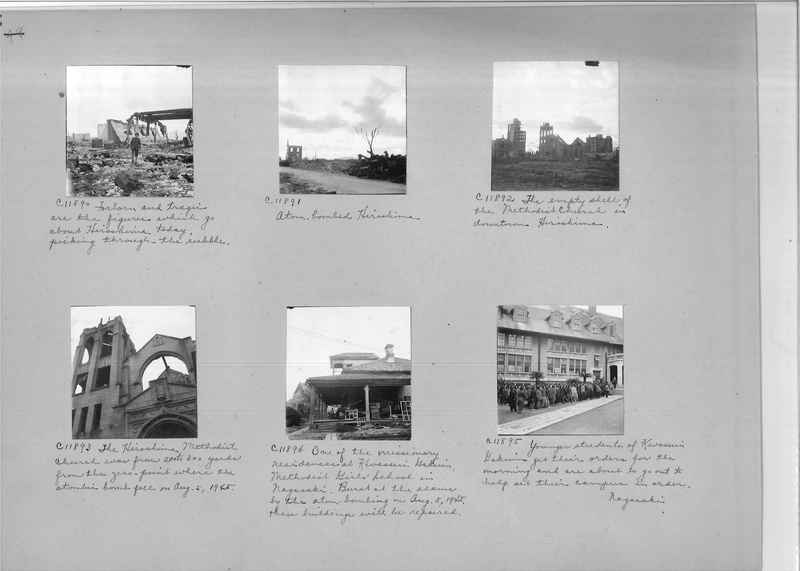
C11890 Forlorn and tragic are the figures which go about Hiroshima today,
picking through the rubble.
C11891 Atom bombed Hiroshima.
C11892 The empty shell of the Methodist Church in downtown, Hiroshima.
C11893 The Hiroshima Methodist Church was from 200 to 300 yards from the
zero-point where the atomic bomb on Aug. 5, 1945.
C11894 One of the missionary residences at Kwansei Gakuin, Methodist Girls
School in Nagasaki. Burst at the seams by the atom-bombing on Aug. 5,
1945, these buildings will be repaired.
C11895 Younger students of Kwassui Gakuin get their orders for the morning
and are about to go out to help set their campus in order, Nagasaki.
Mission Photograph Album - Japan #06 Page 0097
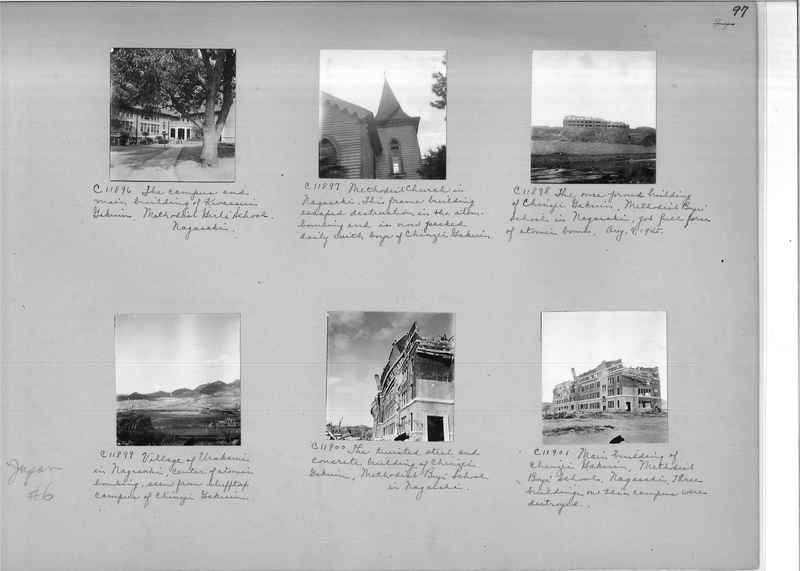
C11896 The campus and main building of Kwassui Gakuin, Methodist Girls
School, Nagasaki.
C11897 Methodist Church in Nagasaki. This frame building escaped
destruction in the atom-bombing and is now packed daily with boys of
Chinzei Gakuin.
C11898 The once proud building of Chinzei Gakuin, Methodist Boys School in
Nagasaki, got full force of atomic bomb. Aug. 9, 1945.
C11899 Village of Urakami in Nagasaki, center of atomic bombing, seen from
blufftop campus of Chinzei Gakuin.
C11900 The twisted steel and concrete building of Chinzei Gakuin,
Methodist Boys School in Nagasaki.
C11901 Main building of Chinzei Gakuin, Methodist Boys School, Nagasaki.
Three buildings on this campus were destroyed.
Mission Photograph Album - Japan #06 Page 0098
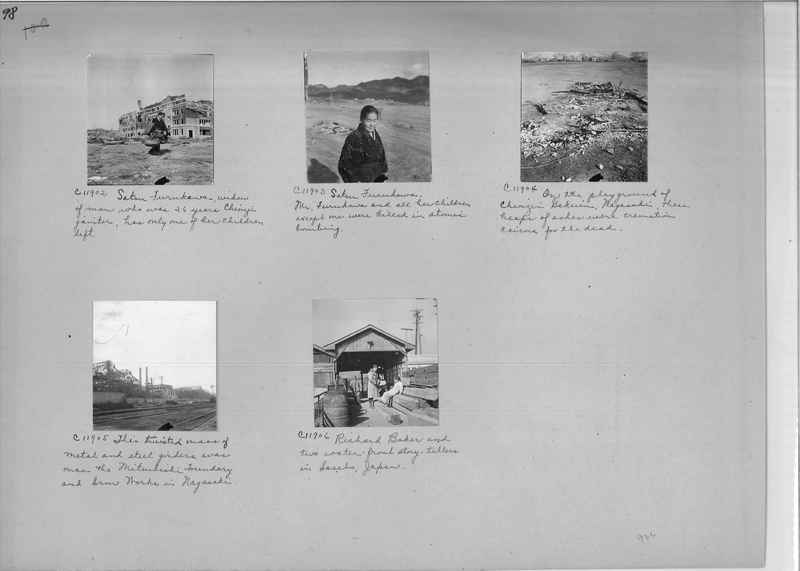
C11902 Satsu Furukawa, widow of man who was 26 years Chinzei janitor, has
only one of her children left.
C11903 Satsu Furukawa, Mr. Furukawa and all her children except one were
killed in atomic bombing.
C11904 On the playground of Chinzei Gakuin, Nagasaki, these heaps of ashes
were cremation cairns for the dead.
C11905 This twisted mass of metal and steel girders was once the
Mitsubishi Foundary and Iron Works in Nagasaki.
C11906 Richard Baker and two water-front story-tellers in Sosebo, Japan.
Mission Photograph Album - Japan #06 Page 0099
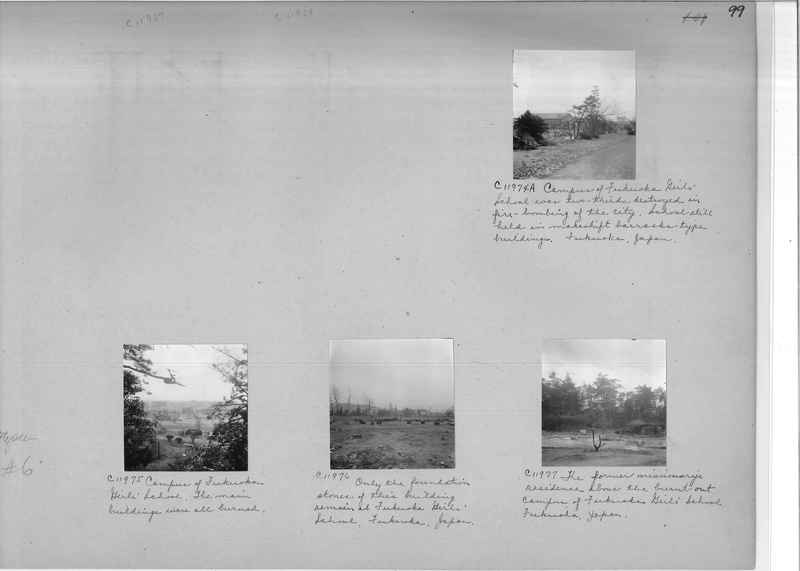
C11974A Campus of Fukuoka Girls School was two-thirds destroyed in fire-
bombing of the city. School still held in makeshift barracks-type
buildings. Fukuoka, Japan.
C11975 Campus of Fukuoka Girls School. The main building were all burned.
C11976 Only the foundation stones of this building remain at Fukuoka Girls
School, Fukuoka, Japan.
C11977 The former missionary's residence above the burnt-out campus of
Fukuoka Girls School, Fukuoka, Japan.
Mission Photograph Album - Japan #06 Page 0100
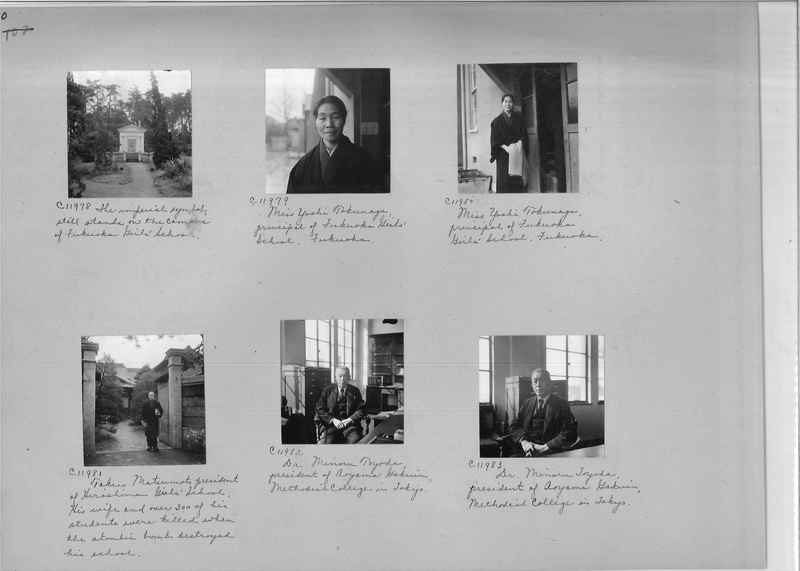
C11978 The imperial symbol still stands on the campus of Fukuoka Girls
School.
C11979 Miss Yoshi Tokunaga, Principal of Fukuoka Girls School, Fukuoka.
C11980 Miss Yoshi Togunaga, Principal of Fukuoka Girls School, Fukuoka.
C11981 Takuo Matsumoto, President of Hiroshima Girls School. His wife and
over 300 of his students were killed when the atomic bomb destroyed his
school.
C11982 Dr. Minoru Toyoda, President of Aoyama Gakuin, Methodist College in
Tokyo.
C11983 Dr. Minoru Toyoda, President of Aoyama Gakuin, Methodist College in
Tokyo.
Mission Photograph Album - Japan #06 Page 0101
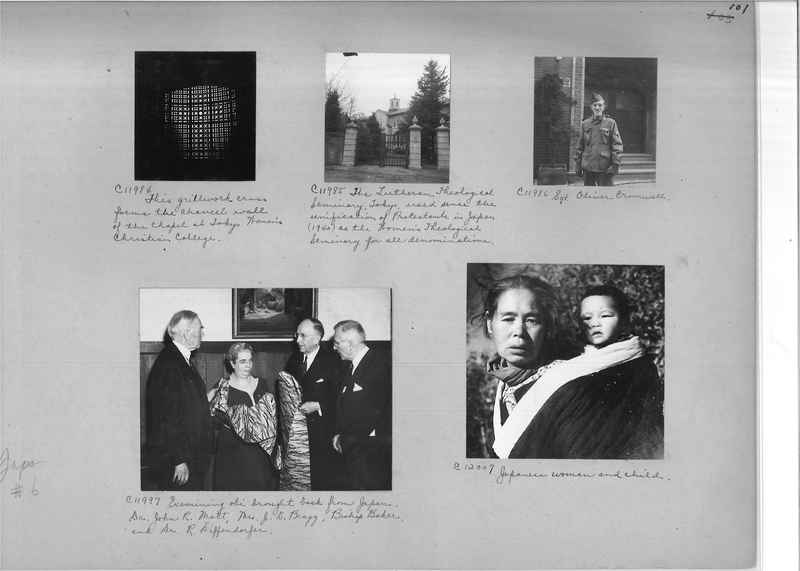
C11984 This grillwork cross forms the chancel wall of the chapel at Tokyo
Women's Christian College.
C11985 The Lutheran Theological Seminary, Tokyo, used since the
unification of Protestants in Japan (1940) as the Women's Theological
Seminary for all denominations.
C11986 Sgt. Oliver Cromwell.
C11997 Examining obi brought back from Japan. Dr. John R. Mott, Mrs. J.D.
Bragg, Bishop Baker, and Dr. R. Diffendorfer.
C12007 Japanese woman and child.
Mission Photograph Album - Japan #06 Page 0107
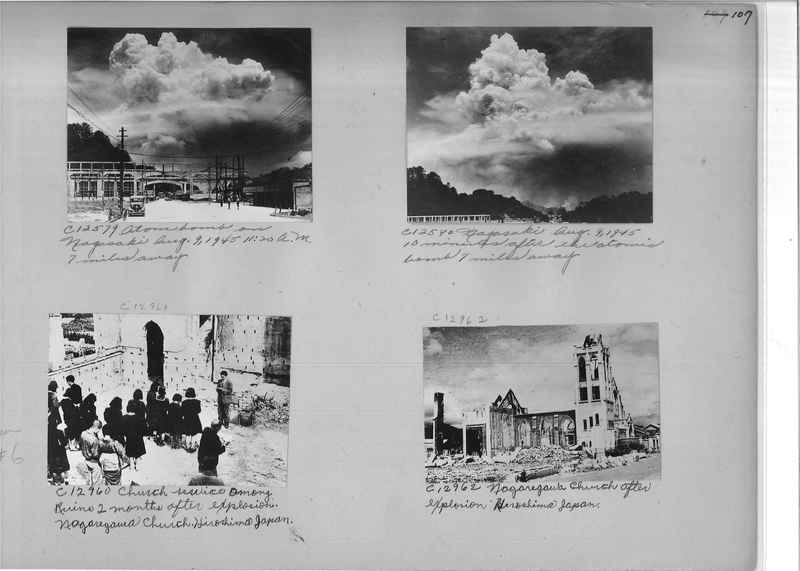
C12579 Atom bomb on Nagasaki Aug. 9, 1945. 11:20 a.m. 7 miles away.
C12580 Nagasaki Aug. 9, 1945. 10 minutes after the atomic bomb. 7 miles
away.
C12960 Church service among ruins 2 months after explosion. Nagaregawa
Church, Hiroshima, Japan.
C12962 Nagaregawa Church after explosion, Hiroshima, Japan.
Mission Photograph Album - Japan #06 Page 0108
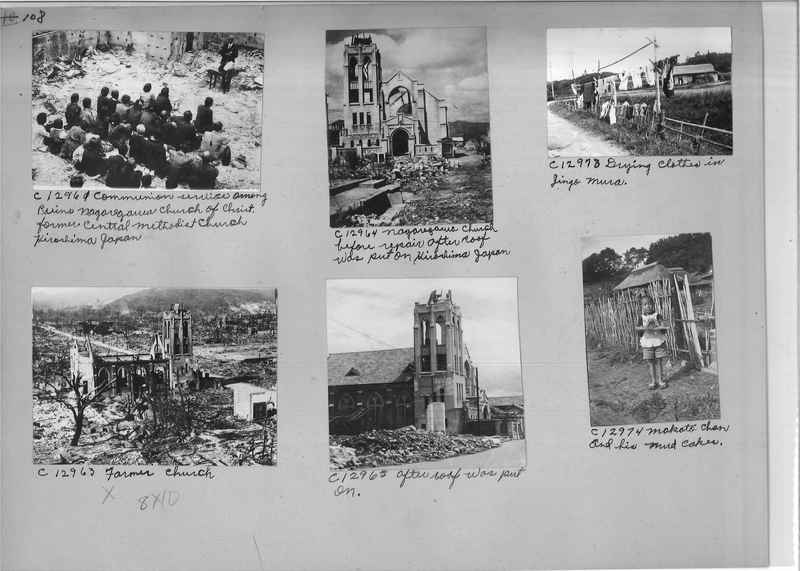
C12961 Communion service among ruins,Nagarefawa Church of Christ, former
Central Methodist Church, Hiroshima, Japan.
C12964 Nagaregawa Church before repair after roof was put on, Hiroshima,
Japan.
C12973 Drying clothes in Jingo Mura.
C12963 Former church.
C12965 After roof was put on.
C12974 Makato Chan and his mud cakes.
Mission Photograph Album - Japan #06 Page 0111
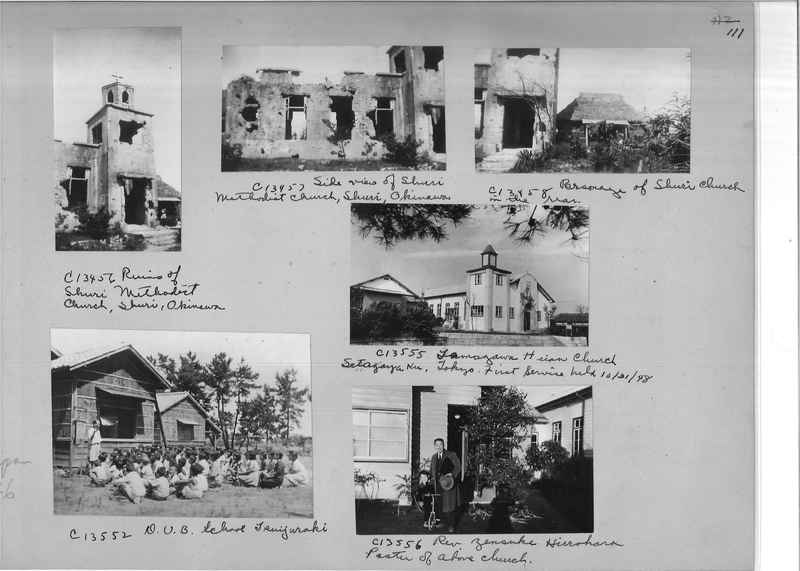
C13456 Ruins of Shuri Methodist Church, Shuri, Okinawa.
C13457 Side view of Shuri Methodist Church, Shuri, Okinawa.
C13458 Parsonage of Shuri Church in the rear.
C13555 Tamagawa Heian Church Setagaya Ku, Tokyo. First servie held
10/31/48.
C13552 D.U.B. School Tsuijuraki.
C13556 Rev. Zensuke Hirohara, Pastor of above church.
Mission Photograph Album - Japan #07 Page 0003
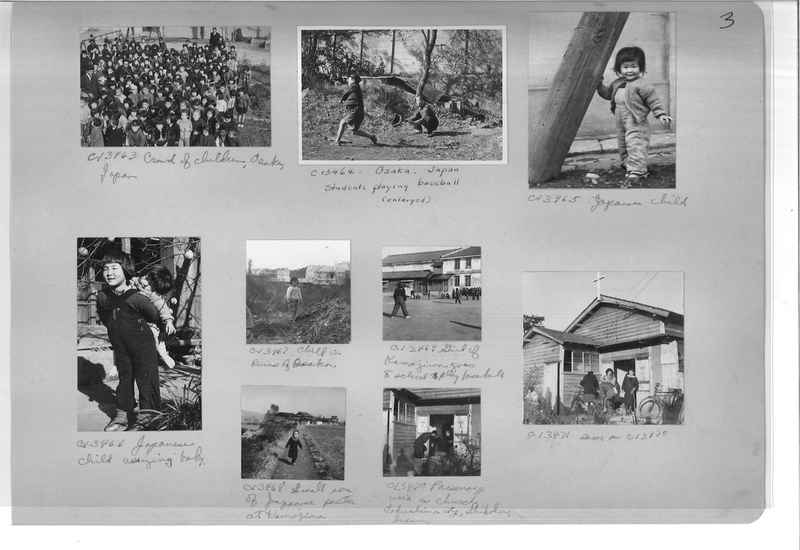
C13463 Crowd of children, Osaka, Japan.
C13464 Osaka, Japan. students playing baseball.
C13465 Japanese child.
C13466 Japanese child carrying baby.
C13467 Child in ruines of Osaka, Japan.
C13469 Girl of Kamojima goes to school to play baseball.
C13468 Small son of Japanese pastor at Kamojima.
C13470 Parsonage used as church Tokushima city, Shikokus, Japan.
C13471 Same as C13470
Mission Photograph Album - Japan #07 Page 0004
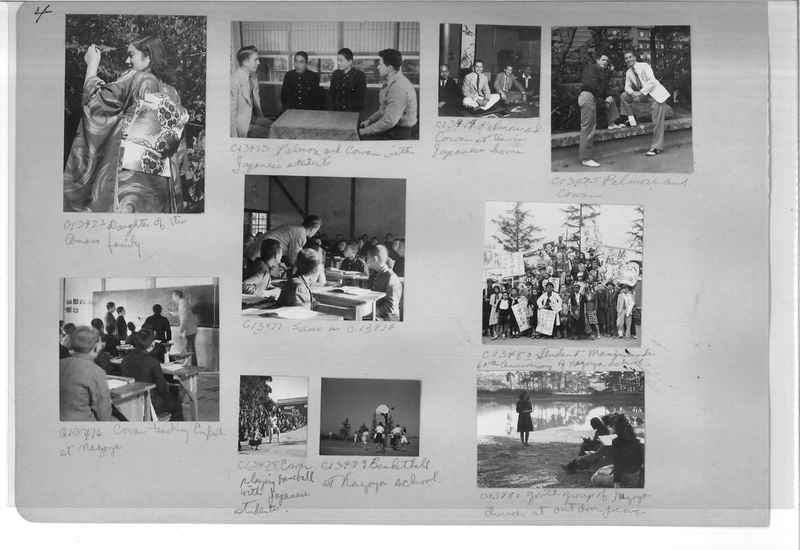
C13472 Doughter of the Amano family.
C13473 Palmore and Cowan with Japanese students.
C13474 Palmaore and Cowan at tea in Japanese home.
C13475 Palmore and Cowan.
C13477 Same as C13476
C13480 Student Masquerade 60th Anniversary of Nagoya school.
C13476 Cowan teaching English at Nagoya.
C13478 Cowan playing baseball with Japanese students.
C13481 Youth group of Nagoya church at outdoor picnic.
Mission Photograph Album - Japan #07 Page 0009
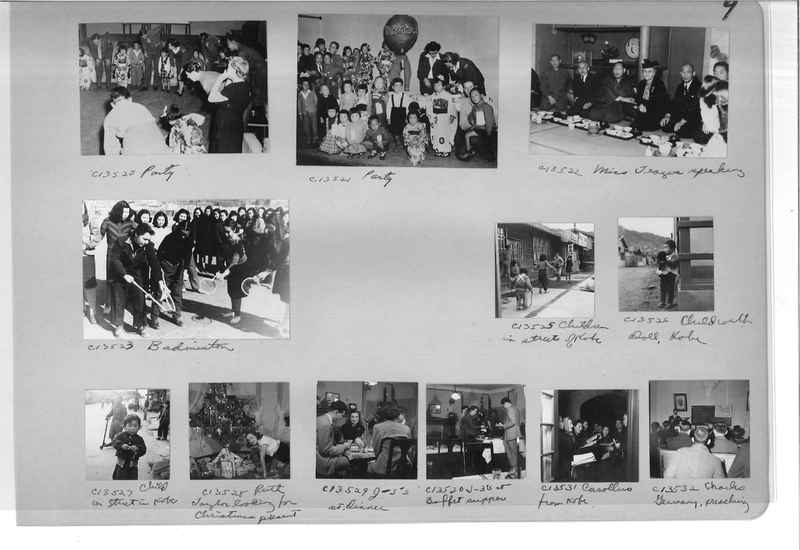
C13520 Party.
C13521 Party.
C13522 Miss Teagus speaking.
C13523 Badminton.
C13525 Children in street of Kobe.
C13526 Child with Doll, Kobe.
C13527 Child on street Kobe.
C13528 Ruth Taylor looking for Christmas present.
C13529 J-3's at dinner.
C13530 J-3's at Buffet supper.
C13531 Carollus from Kobe.
C13532 Charles Germany, preaching.
Mission Photograph Album - Japan #07 Page 0010
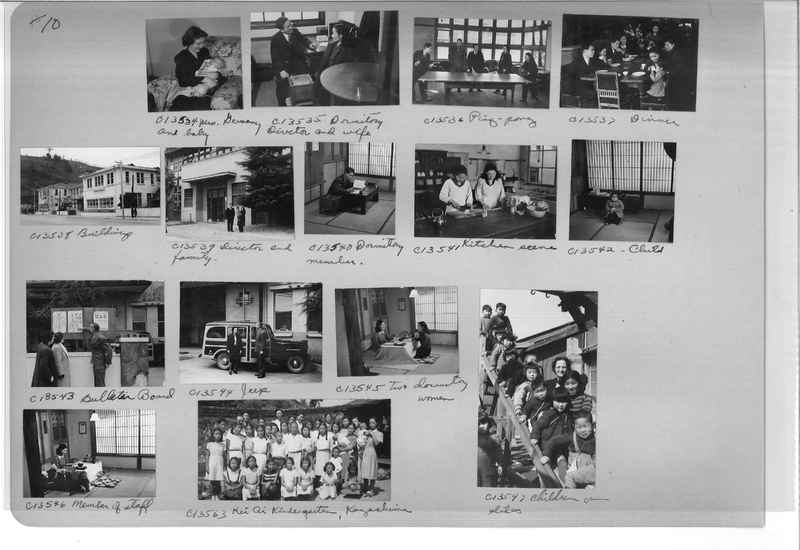
C13534 Mrs. Germany and baby.
C13535 Dormitory director and wife.
C13536 Ping pong.
C13537 Dinner.
C13538 Building.
C13539 Director and family.
C13540 Dormitory member.
C13541 Kitchen scene.
C13542 Child.
C13543 Bulletin board.
C13544 Jeep.
C13545 Two dormitory women.
C13546 Member of staff.
C13563 Kei Ai Kindergarten, Kazasbima.
C13547 Children on slides.
Mission Photograph Album - Japan #07 Page 0011
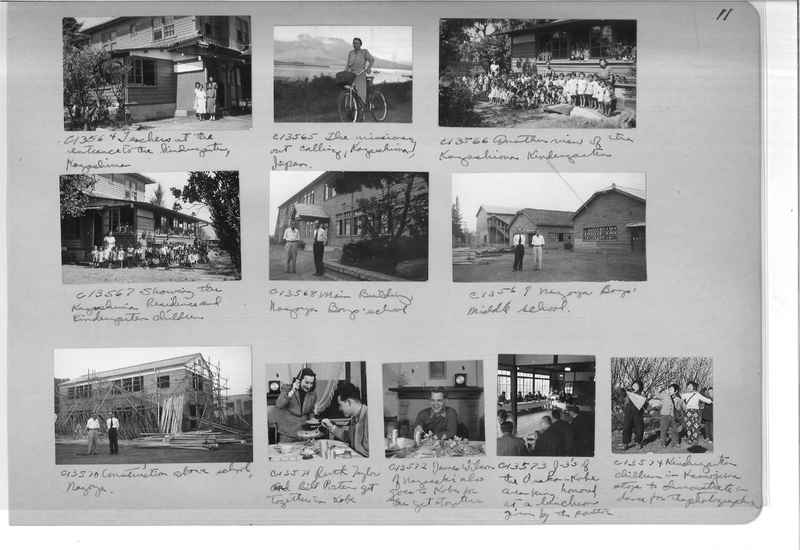
C13564 Teachers at the entrance to the kindergarten, Kazashima
C13565 The missionary out calling, Kazashima, Japan.
C13566 Another view of the Kazashima Kindergarten.
C13567 Showing the Kazashima residence and kindergarten children.
C13568 Main Building Nagoya Boy's school.
C13569 Nagoya Boys' middlle school.
C13570 Construction above school, Nagoya.
C13571 Ruth Taylor and Bill Porter get together in Kobe.
C13572 James Wilson of Nagasaki also goes to Kobe for the get-together.
C13573 J-3's of the Osaka-Kobe area being honored at a lunchoen given by
the pastor.
C13574 Kindergarten children in Kamojima stop to demonstrate a dance for
the photographer.
C13565 The missionary out calling, Kazashima, Japan.
C13566 Another view of the Kazashima Kindergarten.
C13567 Showing the Kazashima residence and kindergarten children.
C13568 Main Building Nagoya Boy's school.
C13569 Nagoya Boys' middlle school.
C13570 Construction above school, Nagoya.
C13571 Ruth Taylor and Bill Porter get together in Kobe.
C13572 James Wilson of Nagasaki also goes to Kobe for the get-together.
C13573 J-3's of the Osaka-Kobe area being honored at a lunchoen given by
the pastor.
C13574 Kindergarten children in Kamojima stop to demonstrate a dance for
the photographer.
Mission Photograph Album - Japan #07 Page 0012
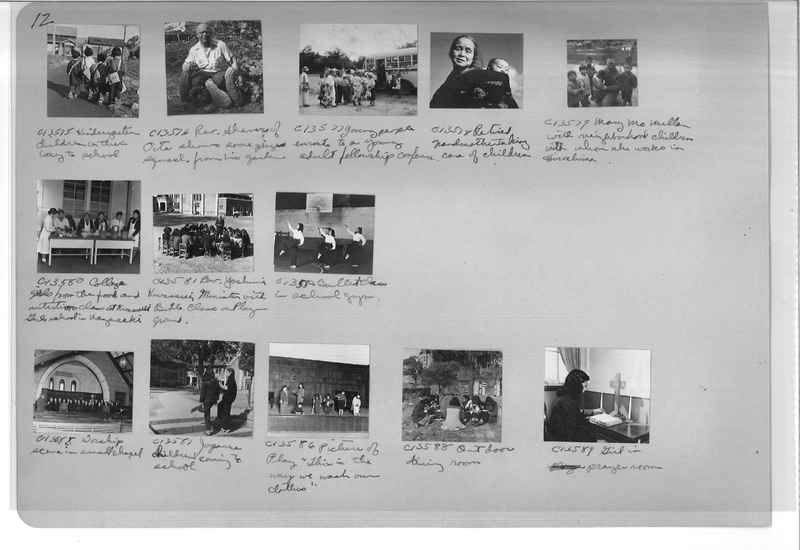
C13575 Kindergarten children on their way to school.
C13576 Rev. Shaver of Octa shows some prizes squash from his garden.
C13577 Young people enroute to a young adult fellowship conference.
C13578 Retired grandmother taking care of children.
C13579 Macy MacMillan with neighborhood children with whom she works in
Hiroshima.
C13580 College girls from the food and nutritions class at Kwassui girls
school in Nagasaki.
C13581 Rev. Yoshimi Kwassui, Minister with Bible class on playground.
C13582 Ballet class in school gym.
C13565 Woship scene in small chapel.
C13587 Japanese children coming to school.
C13586 Picture of Play "this is the way we wash our clothes."
C13588 Outdoor dining room.
C13589 Girl in prayer room.
Mission Photograph Album - Japan #07 Page 0013
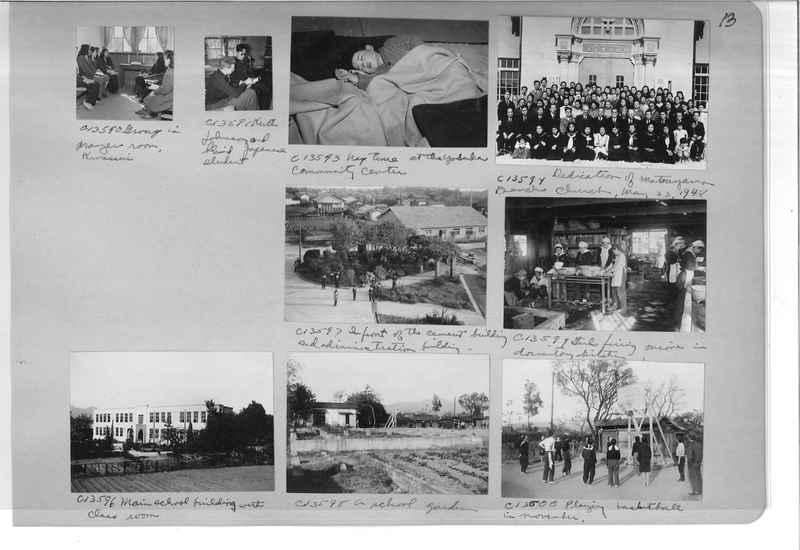
C13590 Group in prayer room, Kwassui.
C13591 Kerth Lahnson and blind Japanese student.
C13593 Nap time at the Yosuka community center.
C13594 Dedication of Matouyama Banchs Church, May 23, 1948.
C13597 In front of the cement building and administration building.
C13359 Girls firing onions in dormitory kitchen.
C13596 Main school buidling with class room.
C13598 A school garden.
C13500 Playing basketball in November.
Mission Photograph Album - Japan #07 Page 0014
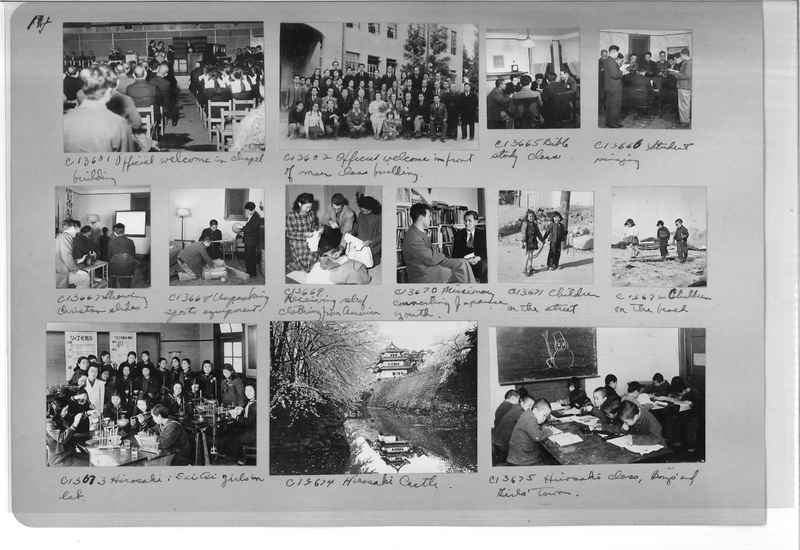
C13601 Official welcome in chapel building.
C13602 Official welcome in front of man class building.
C13665 Bible study class.
C13666 Student singing.
C13667 Showing christian study.
C13668 Unpacking sports equipment.
C13669 Receiving relief clothing from America.
C13670 Missionary concerning Japanese youth.
C13671 Children in the street.
C13672 Children on the beach.
C13673 Hiroshima Sei Ai girls in lab.
C13674 Hiroshima Castle.
C13675 Hiroshima class, Boys' and Girls' town.
Mission Photograph Album - Japan #07 Page 0015
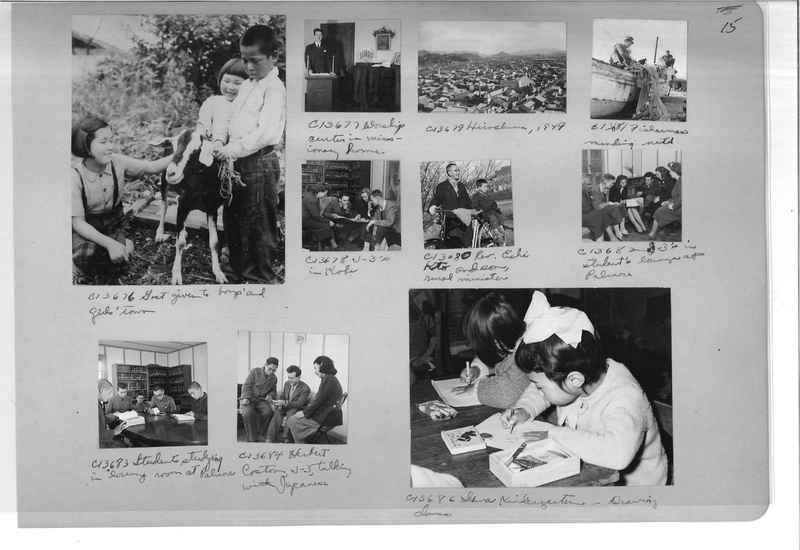
C13676 Goat given to boys' and girl's town.
C13677 Worship center in missionary home.
C13679 Hiroshima, 1949.
C13681 Fisherman mending nets.
C13678 J-3's In Kobe.
C13680 Rev. Eichi Kto and son, rural minister.
C13682 J-3's in student's longer at Palmore.
C13683 Students studying in room at Palmore.
C13684 Herbert Costor J-3, talking with Japanese.
C13686 Seiwa Kindergarten - drawing class.
Mission Photograph Album - Japan #07 Page 0016
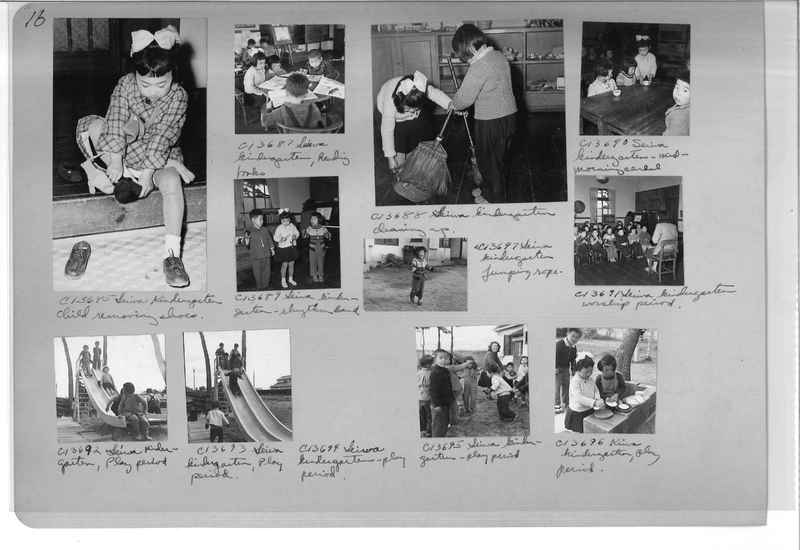
C13685 Seiwa Kindergarten child removing shoes.
C13687 Seiwa kindergarten, reading books.
C13688 Seiwa kindergarten cleaning up.
C13690 Seiwa kindergarteen - mid-morning cereal.
C13689 Seiwa kindergarten - rythm band.
C13697 Seiwa kindergarten jumping rope.
C13691 Seiwa kindergarten worship period.
C13692 Seiwa kindergarten, play period.
C13693 Seiwa kindergarten, play period.
C13695 Seiwa kindergarten - play period.
C13696 Seiwa kindergarten, play period.
Mission Photograph Album - Japan #07 Page 0017
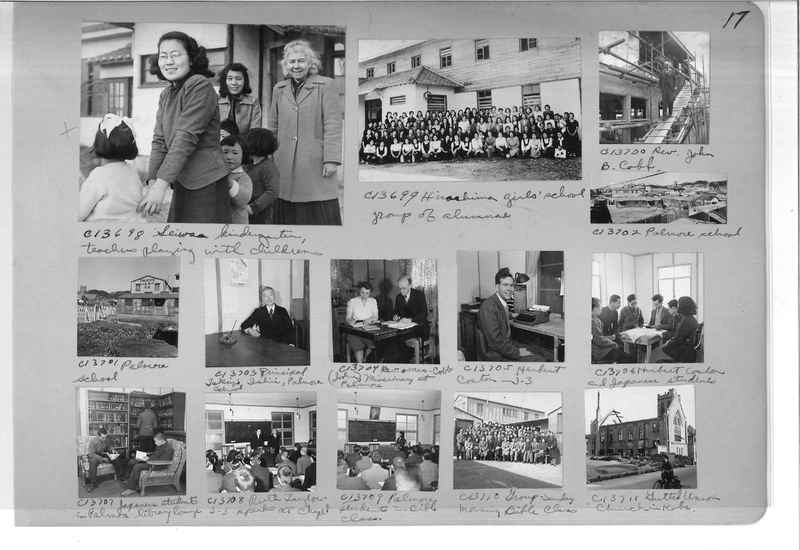
C13698 Seiwa kindergarten, teaches playing with children.
C13699 Hiroshima girls' school group of alumnae.
C13700 Rev. John B. Coff.
C13702 Palmore school.
C13701 Palmore school.
C13703 Principal Takiyi Isliri.
C13704 Rev. and Mrs. Cobb missionary at Palmore.
C13705 Herbert Coston - J-3.
C13706 Herbert Coston and Japanese students.
C13707 Japanese students in Palmore library lounge.
C13708 Ruth Talyor J-3 speaks at Chapel.
C13709 Palmore students in Bible class.
C13710 Group-Sunday morning Bible class.
C13711 Gutted Union Church in Kobe.
Mission Photograph Album - Japan #07 Page 0018
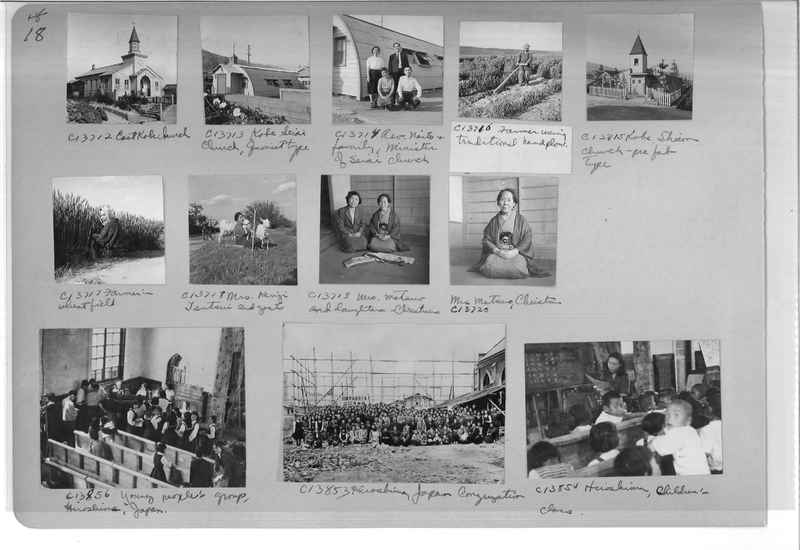
C13712 Eastt Kobe Church.
C13713 Kobe Seiai Church, Quonset type.
C13714 Rev. Naito and family, minister of Seiai Church.
C13716 Farmer using traditional had plow.
C13715 Kobe Sheion Church - pre fab type.
C13717 Farmer in wheat field.
C13718 Mrs, Kenji Tsutsui and goat.
C13719 Mrs. Matsuo and laghters - Christians.
C13720 Mrs. Matsuo, Christian.
C13856 Young people's group, Hiroshima, Japan.
C13853 Hiroshima, Japan congregation.
C13854 Hiroshima, children's class.
Mission Photograph Album - Japan #07 Page 0030
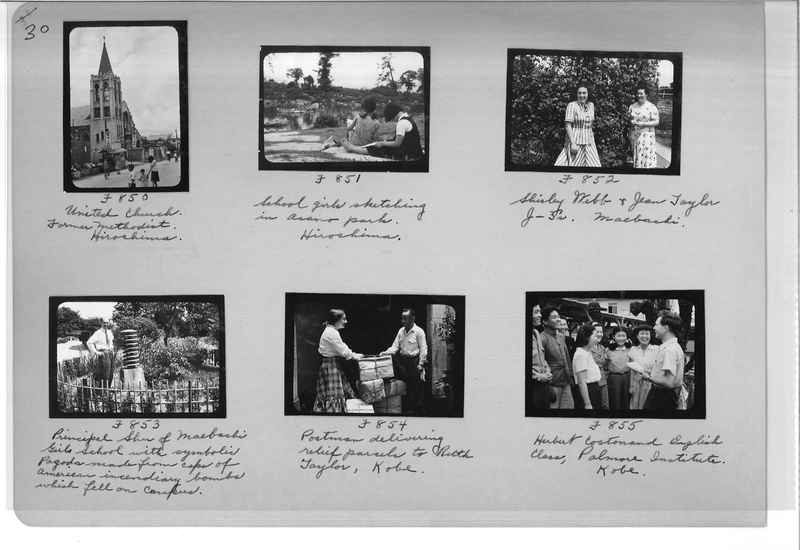
J850 United church. Farmer Methodist Hiroshima.
J851 School girls sketching in Asano park. Hiroshima.
J852 Shirley Webb and Jean Taylor J-3's. Maebashi.
J853 Principal Shu of Maebashi girls school with symbolic Pagoda made from
caps of American incendiary bombs which fell on campus.
J854 Postman delivering relief parcels to Ruth Taylor, Kobe.
J855 Herbert Costonand English class, Palmore Institute. Kobe.
Mission Photograph Album - Japan #07 Page 0031
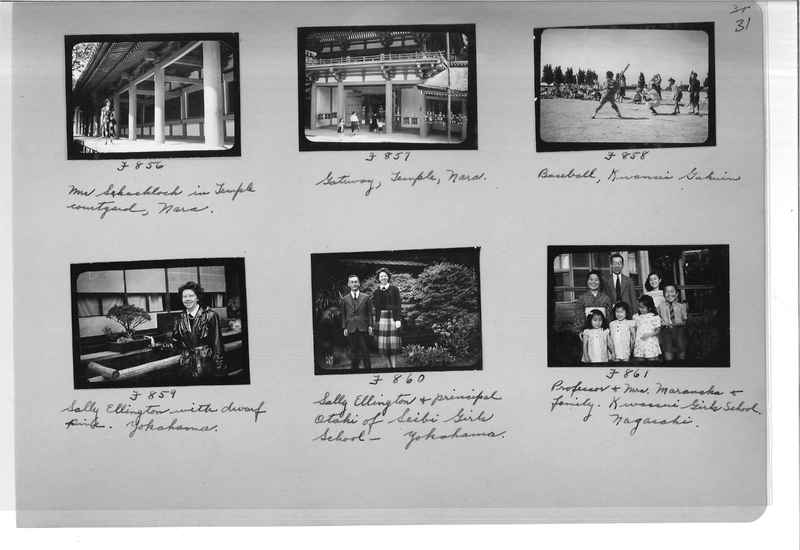
J856 Mrs. Shacklock in Temple courtyard, Nara.
J857 Gateway, Temple, Nara.
J858 Baseball, Kwansei Gakuin.
J859 Sally Ellington with dwarf pine. Yokohama.
J860 Sally Ellington and principal Otaki of Seibi Girls School - Yokohama.
J861 Professor and Mrs. Maranoka and family. Kwassui Girls School, Nagasaki.
Mission Photograph Album - Japan #07 Page 0032
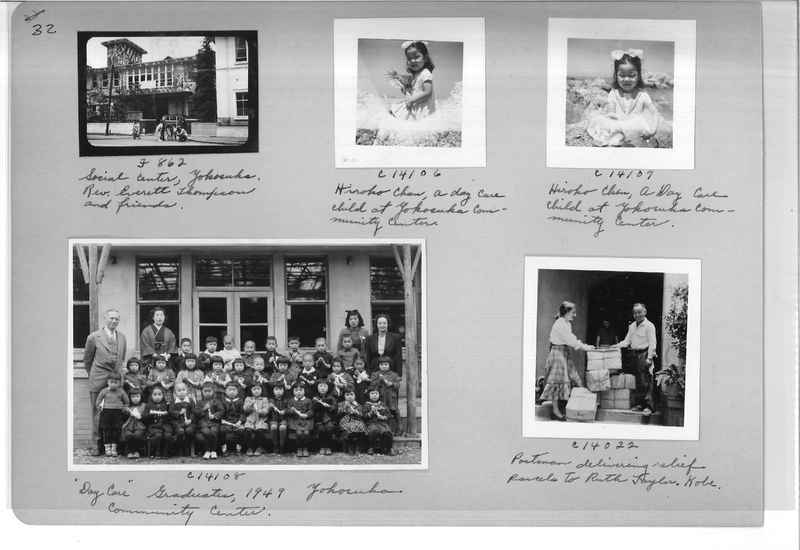
J862 Social center, Yokosuka, Rev. Everett Thompson and friends.
C14106 Hiroko Chan, a day cure child at Yokosuka Community Center.
C14107 Hiroko Chan, A day care child at Yokosuka Community Center.
C14108 "Day Care" graduates, 1949 Yokosuka Community Center.
C14022 Postman delivering relief parcel to Ruth Tayler, Kobe.
Mission Photograph Album - Japan #07 Page 0033
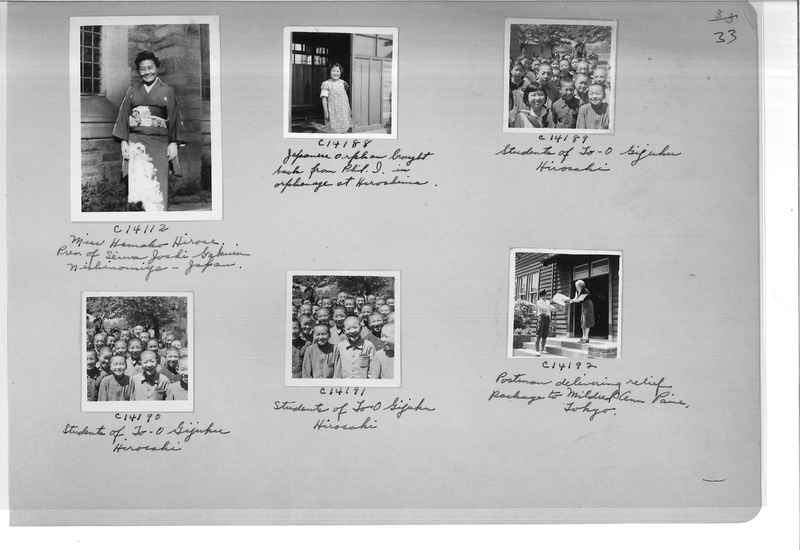
C14112 Miss Mamako Hirose. Pres. of Seiwa Joski Gkuin Nishinomniga -
Japan.
C14188 Japanese orphan brought back from Phil. I. in orphanage at
Hiroshima.
C14189 Students of Jo-O Gizku Hiroshima.
C14190 Students of To-O Gijuku Hirosaki.
C14191 Students of To-O Gijuku Hirosaki.
C14192 Poatman delivering relief package to Mildred Ann Paine, Tokyo.
Mission Photograph Album - Japan #07 Page 0034
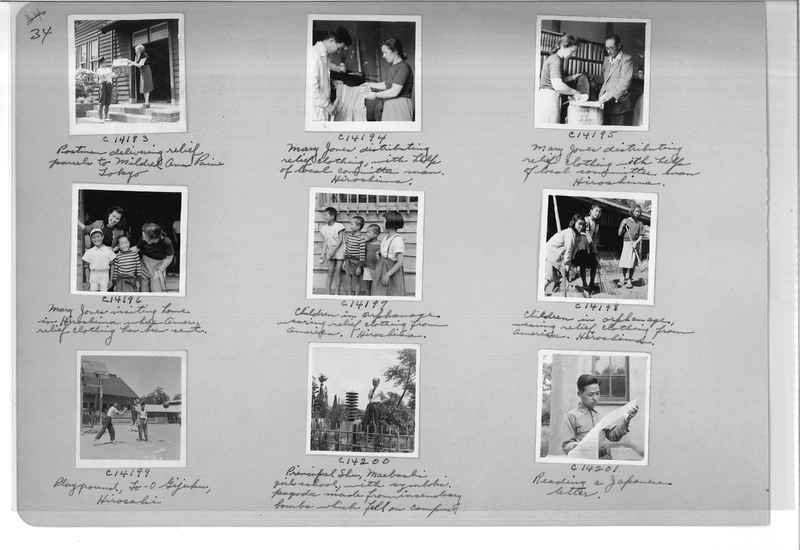
C14194 Mary Jones distributing relief clothing, with help of local
committee man, Hirosaki.
C14195 Mary Jones distributing relief clothing with help of local
committee man. Hirosaki.
C14196 Mary Jones visiting home in Hiroshima where arena relief clothing
has been sent.
C14197 Children in orphanage wearing relief clothing from America.
Hiroshima.
C14198 Children in orphanage wearing relief clothing from America.
Hiroshima.
C14199 Playgournd, To-O Gijuku, Hiroshima.
C14200 Principal Shu, Maebashi girl school, with symbolic pagoda made from
increasing bomb which fell on campus.
C14201 Reading a Japanese letter.
Mission Photograph Album - Japan #07 Page 0035
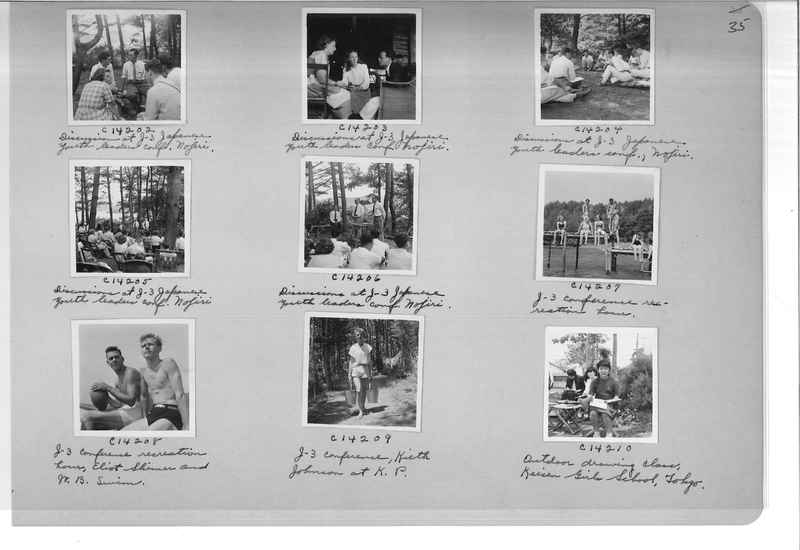
C14202 Discussion att J-3 Japanese youth leaders camp. Nojiri.
C14203 Discussion at J-3 Japanese youth leaders conf. Nojiri.
C14204 Discussion at J-3 Japanese youth leaders conf. Nojiri.
C14205 Discussion at J-3 Japanese youth leaders conf. Jojiri.
C14206 Discussion at J-3 Japanese youth leaders conf. Nojiri.
C14207 J-3 conference recreation hour.
C14208 J-3 conference recreation hour, Eliot Shimer and W.B. Swim.
C14209 J-3 conference, Kieth Johnson at K.P.
C14210 Outdoor drawing class, Keisen Girls school, Tokyo.
Mission Photograph Album - Japan #07 Page 0036
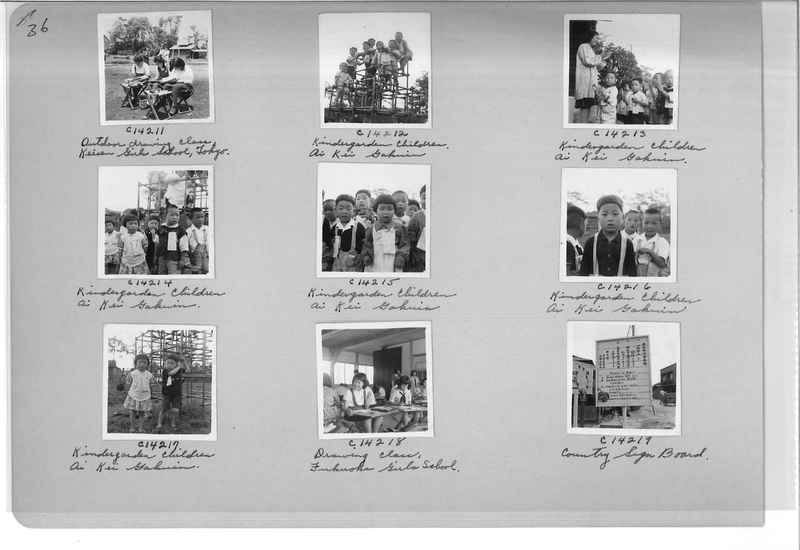
C14211 Outdoor drawing class Keisen Girls School, Tokyo.
C14212 Kindergarten children, Ai Kei Gakuin.
C14213 Kindergarten children Ai Kei Gakuin.
C14214 Kindergarten Children Ai Kei Gakuin.
C14215 Kindergarten Children Ai Kei Gakuin.
C14216 Kindergarten Children Ai Kei Gakuin.
C14217 Kindergarten Children Ai Kei Gakuin.
C14218 Drawing class, Fukuoka Girls school.
C14219 Country sign board.
Mission Photograph Album - Japan #07 Page 0037
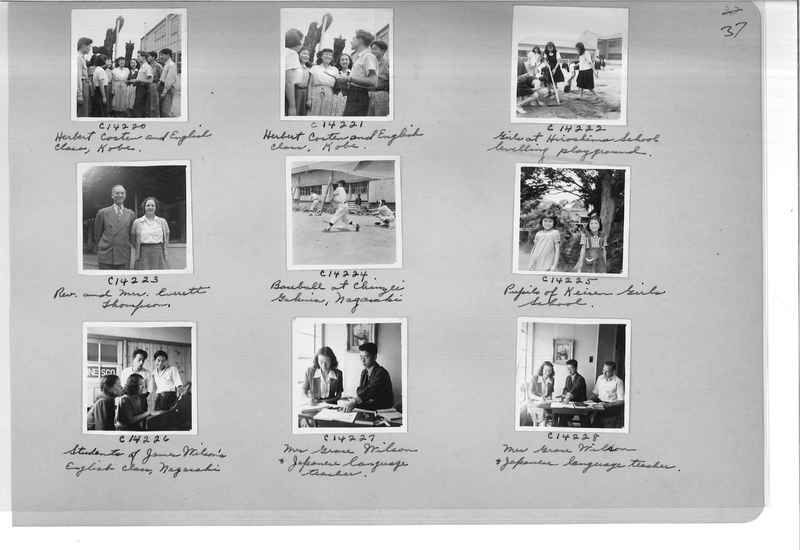
C14220 Herbert Costen English Class, Kobe.
C14221 Herbert Costen and English class, Kobe.
C14222 Girls Hiroshima school levelling playground.
C14223 Rrev. and Mrs. Leverett Thompson.
C14224 Baseball at Chinyei Gakuin, Nagasaki.
C14225 Pupils of Keisen Girls school.
C14226 Students of James Wilson's English class, Nagasaki.
C14227 Mrs. Grace Wilson and Japanese language teacher.
C14228 Mrs. Grace Wilson and Japanese language teacher.
Mission Photograph Album - Japan #07 Page 0038
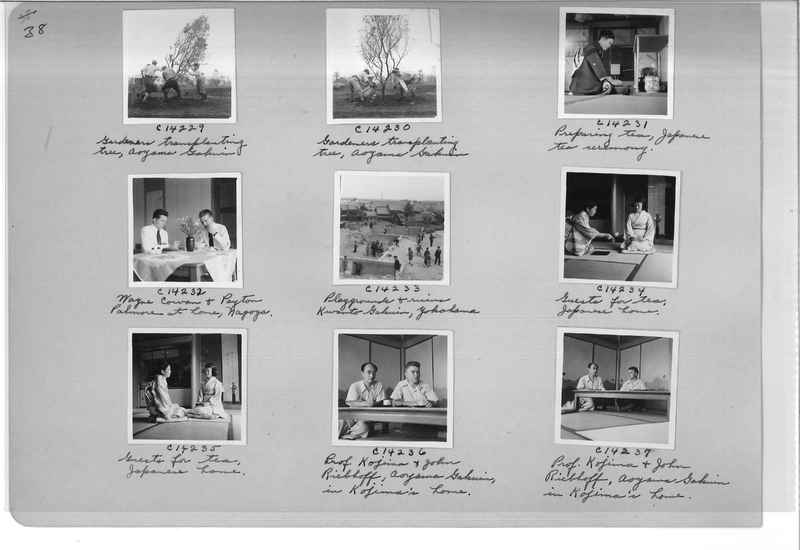
C14229 Gardnener transplanting tree, Aoyama Gakuin.
C142230 Gardeners transplanting tree, Aoyama Gakuin.
C14231 Preparing tea, Japanese tea ceremony.
C14232 Wayne Cowan and Payton Palmore at home, Nagoya.
C14233 Playgrounds and ruins Kwanto Gakuin, Yokohama.
C14234 Guests for tea, Japanese home.
C14235 Guests for tea, Japanese home.
C14236 Prof. Kojima and John Riebhoff, Aoyama Gakuin, in Kojima's home.
C14237 Prof. Kojima and John Riebhoff, Aoyama Gakuin in Kojima's home.
C14325 Sally Ellington, John Reibhoff and Bessie Howell.
Mission Photograph Album - Japan #07 Page 0039
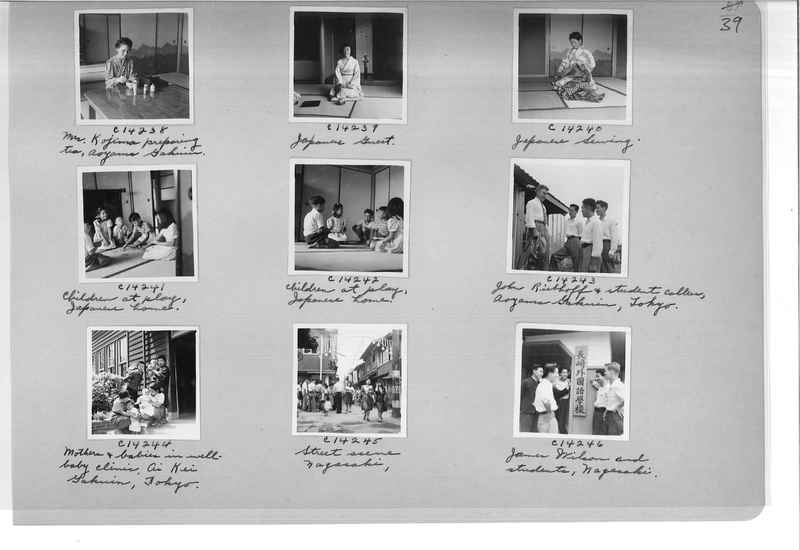
C14238 Mrs. Kojima preparing tea, Aoyama Gakuin.
C14239 Japanese guest.
C14240 Japanese sewing.
C14241 Children at play, Japanese home.
C14242 Children at play, Japanese home.
C14243 John Riebhoff and student callers, Aoyama Gakuin, Tokyo.
C14244 Mother and babies in well-baby clinic, Ai Kei Gakuin, Tokyo.
C14245 Street scene Nagasaki.
C14246 James Wilson and students, Nagasaki.
Mission Photograph Album - Japan #07 Page 0040
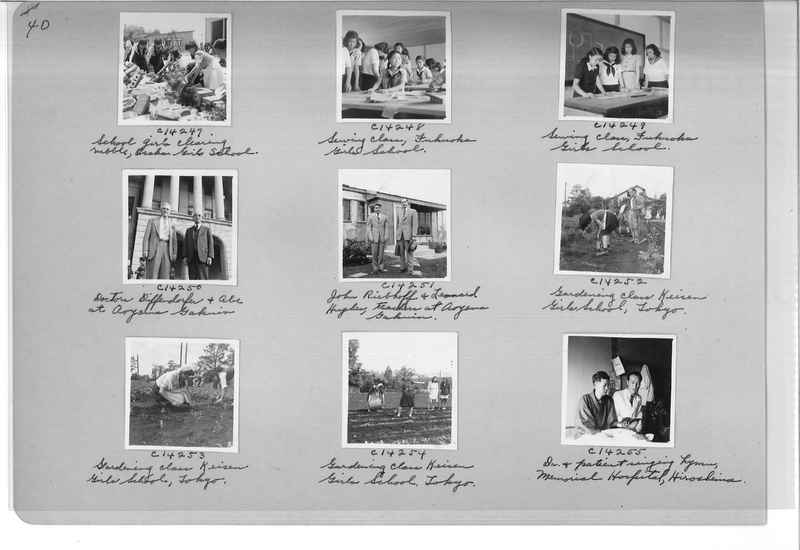
C14247 School girls clearing rubble, Osaka. Girls School.
C14248 Sewing class, Fukuoka Girls School.
C14249 Sewing class, Fukuoka Girls School.
C14250 Doctor Diffendorfer and Abe at Aoyama Gakuin.
C14251 John Rriebhoff and Leonard Hughes, teachers at Aoyama Gakuin.
C14252 Gardening class Keisen Girls School, Tokyo.
C14253 Gardening class Keisen Girls School, Tokyo.
C14254 Gardening class Keisen Girls School, Tokyo.
C14255 Dr. and patient singing hymn, Momorial Hospital, Hiroshima.
Mission Photograph Album - Japan #07 Page 0041
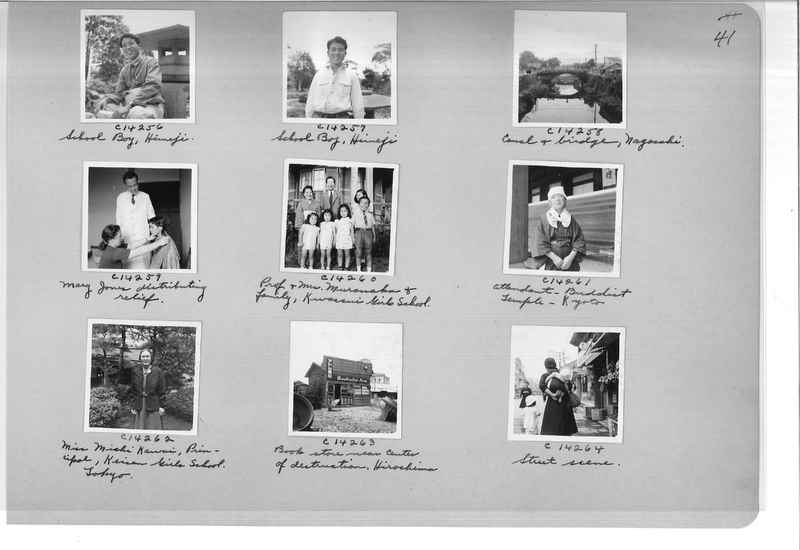
C14256 School Boy, Himeji.
C14257 School Boy, Himeji.
C14258 Canal and bridge, Nagasaki.
C14259 Mary Jones distributing relief.
C14260 Prof. and Mrs. Muranaka and family, Kwassui girl school.
C14261 Attendant - Buddhist Temple - Kyoto.
C14262 Miss Michi Kawai, Principal, Keisen Girls School Tokyo.
C14263 Book store near center of destruction, Hiroshima.
C14264 Street scene.
Mission Photograph Album - Japan #07 Page 0042
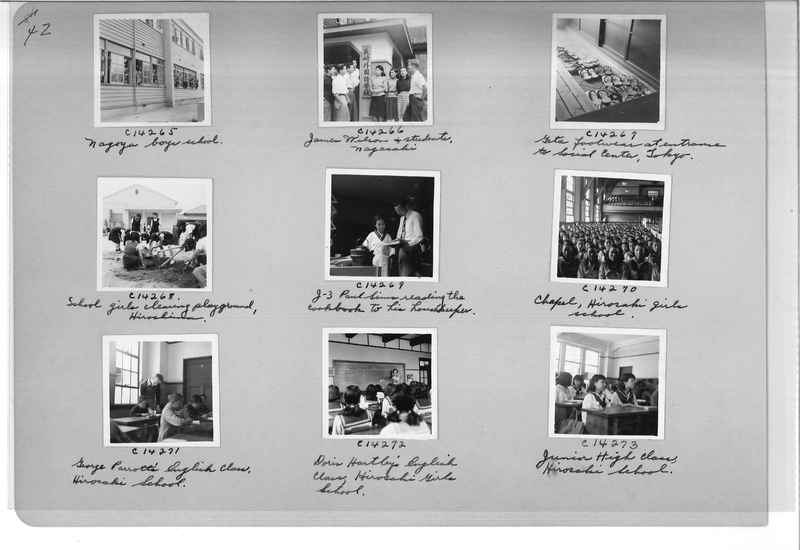
C14266 James Wilson and students, Nagasaki.
C14267 Geta footwear at entrance at social center, Tokyo.
C14268 School girls clearing playground, Hiroshima.
C14269 J-3 Paul Sims reading the cookbook to his housekeeper.
C14270 Chapel, Hiroshima girls school.
C14271 George Parrott's English class, Hiroshima School.
C14272 Doris hartley's English class, Hiroshima girls school.
C14273 Junior High class, Hiroshima school.
Mission Photograph Album - Japan #07 Page 0043
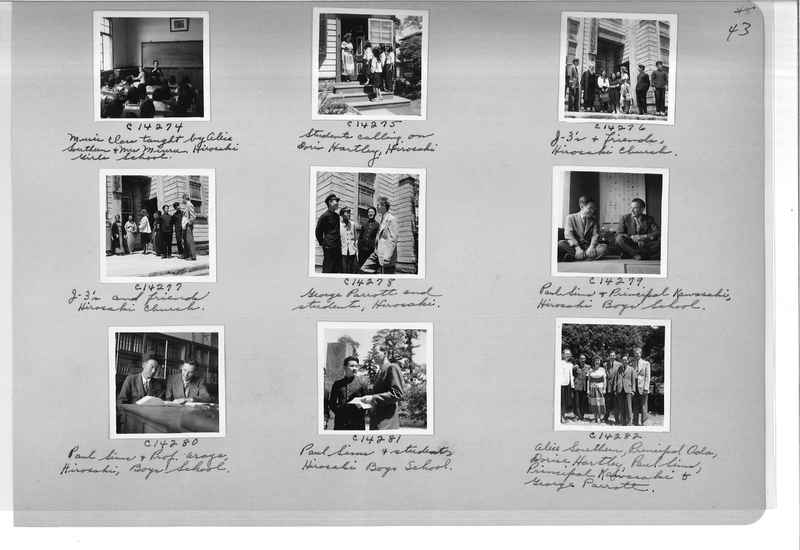
C14274 Music class taught by Alice Southern and Mrs. Miura. Hirosaki girls
school.
C14275 Students calling, on Doris Hartley, Hirosaki.
C14276 J-3's and friends, Hirosaki church.
C14277 J-3's and friends Hirosaki church.
C14278 George Parrott and students, Hirosaki.
C14279 Paul Sims and Principal Kawasaki, Hirosaki Boys school.
C14280 Paul Sims and Prof. Araya Hirosaki, Boys School.
C14281 Paul Sims and students Hirosaki Boys School.
C14282 Alice Southern Principal Ada, Dorise Hartley, Paul Sims, Principal
Kawasaki and George Parrott.
Mission Photograph Album - Japan #07 Page 0044
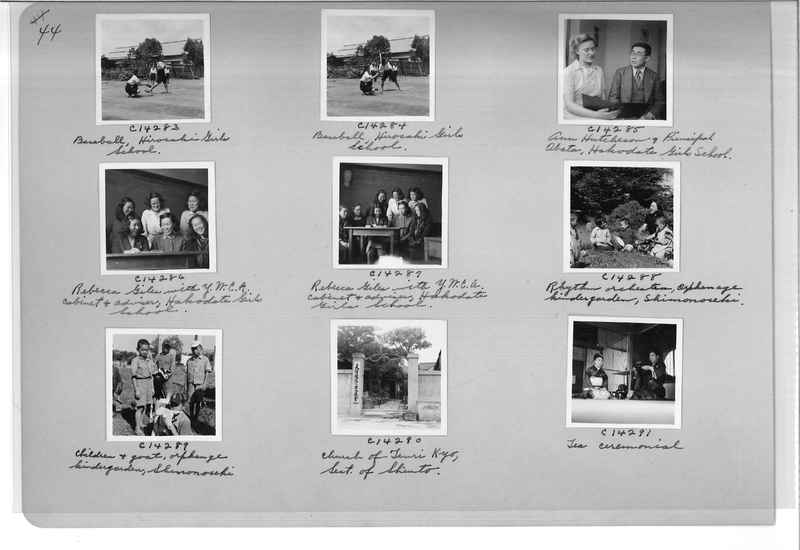
C14283 Baseball, Hirosaki Girls school.
C14284 Baseball, Hirosaki Girls School.
C14285 Ann Hutcheson and Principal Abota, Hakodate Girls School.
C14286 Rebecca Giles with Y.M.C.A. cabinet andd advisor, Hakodate girls
school.
C14287 Rebecca Giles with Y.M.C.A. cabinet and advisor, Hakodate Girls
School.
C14288 Rythm orchestra, Orphanage kindergarten, Shimonoseki.
C14289 Children and goat, orphanage kindergarten, Shimonoseki.
C14290 Church of Tenri Kyo, Sect.of Shinto.
C14291 Tea ceremonial.
Mission Photograph Album - Japan #07 Page 0045
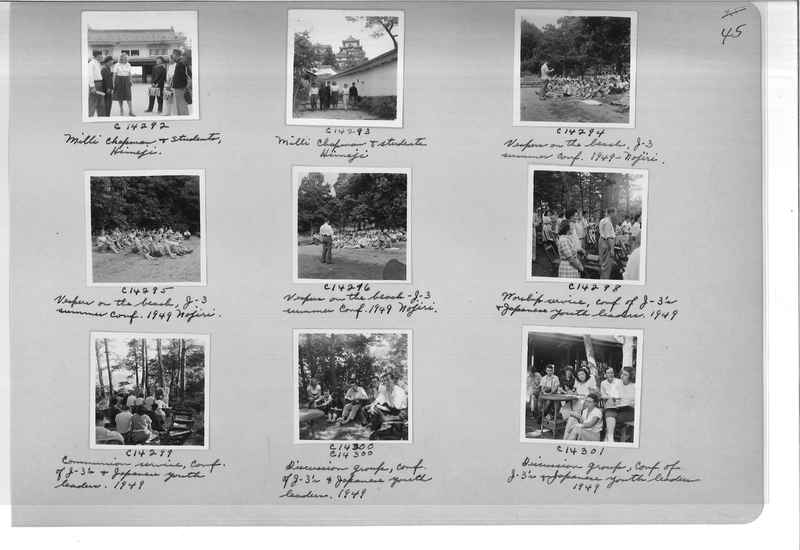
C14292 Milli Chapman and students, Himeji.
C14293 Milli Chapman and students, Himeji.
C14294 Vespers on the beach, J-3 summer conf. 1949 - Jojiri.
C14295 Vespers on the beach, J-3 summer conf. 1949 Nojiri.
C14296 Vespers on the beach J-3 summer conf. 1949 Nojiri.
C14298 Worship service, conf. of J-3's and Japanese youth leaders. 1949.
C14299 Communion service, conf. of J-3's and Japanese youth leader. 1949.
C14300 Discussion group, conf. of J-3's and Japanese youth leaders. 1949.
C14301 Discussion group, conf. of J-3's and Japanese youth leaders, 1949.
Mission Photograph Album - Japan #07 Page 0046
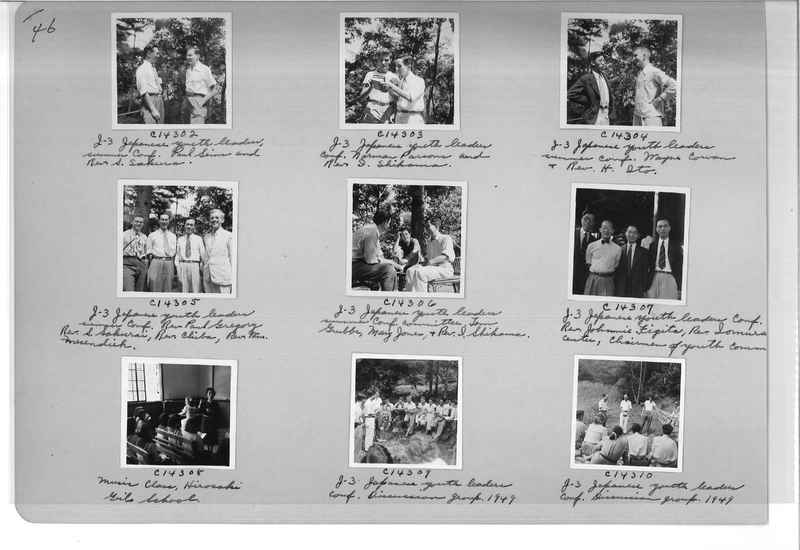
C14302 J-3's Japanese youth leaders, summer conf. Paul Sims and Rev. S.
Sakira.
C14303 J-3's Japanese youth leaders, summer conf. Norman Parsons and Rev.
I. Shikoma.
C14304 J-3's Japanese youth leaders, summer conf. Wayne Cowan and Rev. H.
Ito.
C14305 J-3's Japanese youth leaders, summer conf. Rev. Paul Gregory Rev.
S. Sakurai, Rev. Chiba, Rev. Wm. Mesendiek.
C14306 J-3's Japanese youth leaders, summer conf. committee. Tom Grubbs,
Mary Jones and Rev. I. Shikoma.
C14307 J-3's Japanese youth leaders, summer conf. Rev. Johnnie Figita,
Rev. Jomura center, Chairman of youth committee.
C14308 Music class, Hirosaki Girls School.
C14309 J-3's Japanese youth leaders, summer conf. Discussion group. 1949.
C14310 J-3's Japanese youth leaders, summer conf. Discussion group. 1949.
Mission Photograph Album - Japan #07 Page 0047
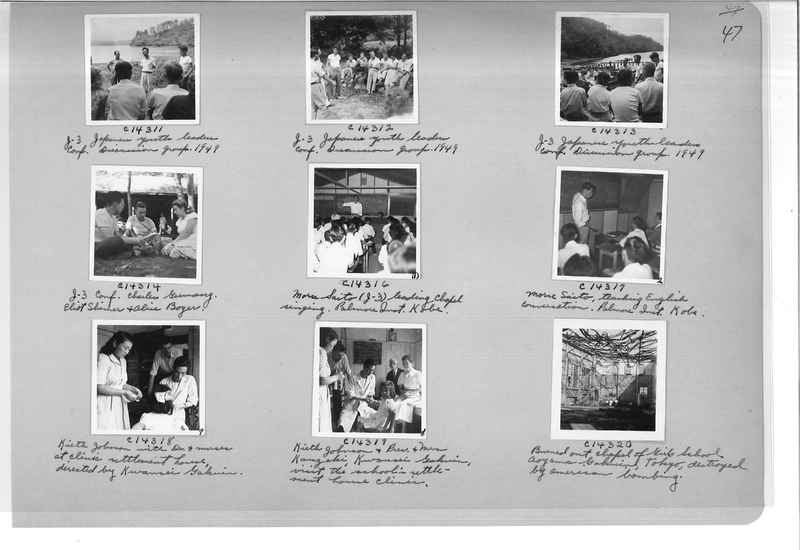
C14311 J-3's Japanese youth leaders, summer conf. Discussion group. 1949.
C14312 J-3's Japanese youth leaders, summer conf. Discussion group. 1949.
C14313 J-3's Japanese youth leaders, summer conf. Discussion group. 1949.
C14314 J-3 Conf. Charles Germany. Eliot Shimer and Alice Boyer.
C14316 Morse Saito (J-3) leading chapel singing. Palmore Inst. Kobe.
C14317 Morse Saito, teaching English conversation, Palmore Inst. Kobe.
C14318 Kieth Johnson with Dr. and nurses at clinic settlement house,
directed by Kwansei Gakuin.
C14319 Kieth Johnson and Mrs. Kanzaki, Kwansei Gakuin, visit the school's
settlement house clinic.
C14320 Burned out chapel of girls school Aoyama Gakuin, Tokyo, destroyed
by Americal bombing.
Mission Photograph Album - Japan #07 Page 0048
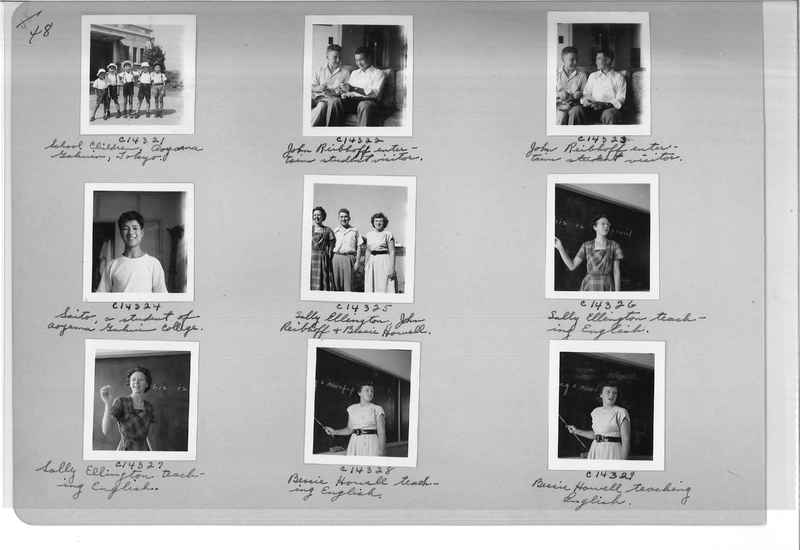
C14321 School children, Aoyama Gakuin. Tokyo.
C14321 School Children, Aoyama Gakuin, Tokyo.
C14322 John Reibhoff entertain student visitor.
C14323 John Reibhoff entertain student visitors.
C14324 Saito, a student of Aoyama Gakuin college.
C14326 Sally Ellington teaching English.
C14327 Sally Ellington teaching English.
C14328 Bessie Howell teaching English.
C14329 Bessie Howell teaching English.
Mission Photograph Album - Japan #07 Page 0049
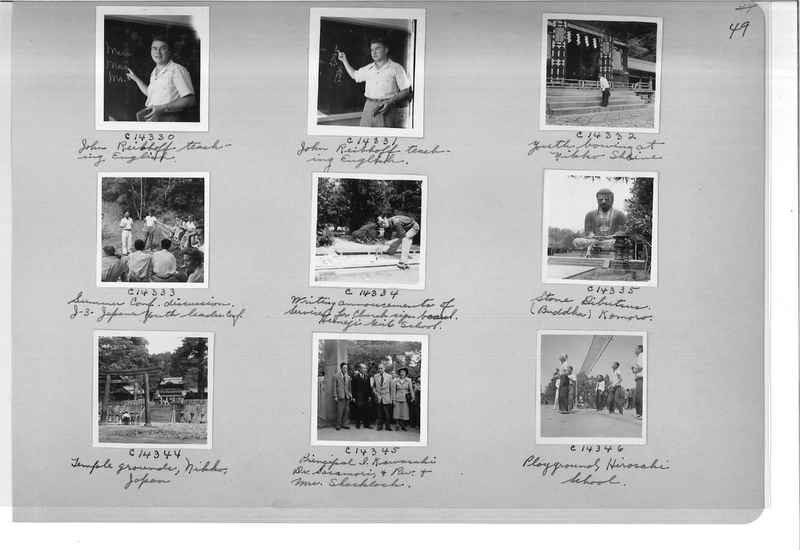
C14330 John Reibhoff teaching English.
C14331 John Reibhoff teaching English.
C14332 Youth bowing at Nikko Shinto.
C14333 Summer conf. discussion. J-3's Japanese youth leader conf.
C14334 Writing announcements of Service fro Church sign board Hemji Girl
School.
C14335 Stone Dibutsus [Buddha] Komoro.
C14344 Temple grounds, Nikko Japan.
C14345 Principal I. Kawasaki Dr. Sasamori and Rev. and Mrs. Shacklock.
C14346 Playgrounds Hirosaki School.
Mission Photograph Album - Japan #07 Page 0050
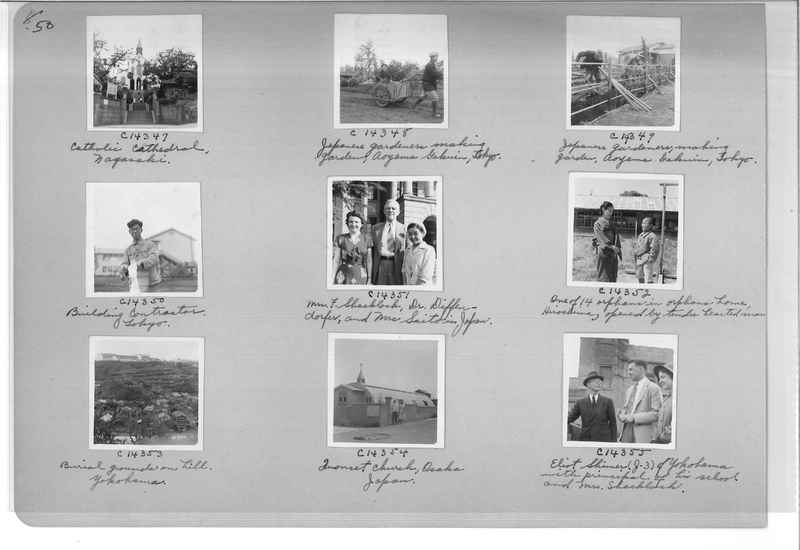
C14347 Catholic cathedral, Nagasaki.
C14348 Japanese gardeners making garden, Aoyama Gakuin, Tokyo.
C14349 Japanese gardeners, making garden, Aoyama Gakuin, Tokyo.
C14350 Building Costractor Tokyo.
C14351 Mrs. F. Shacklock, Dr. Diffendorfer, and Mrs. Saito in Japan.
C14352 One of 14 orphans in orphans home Hiroshima, opened by tender
hearted mom.
C14353 Burial grounds on hill. Yokohama.
C14354 Inonset church, Osaka Japan.
C14355 Eliot Shimer (J-3) of Yokohama with principal of his school and
Mrs. Schaklock.
Mission Photograph Album - Japan #07 Page 0051
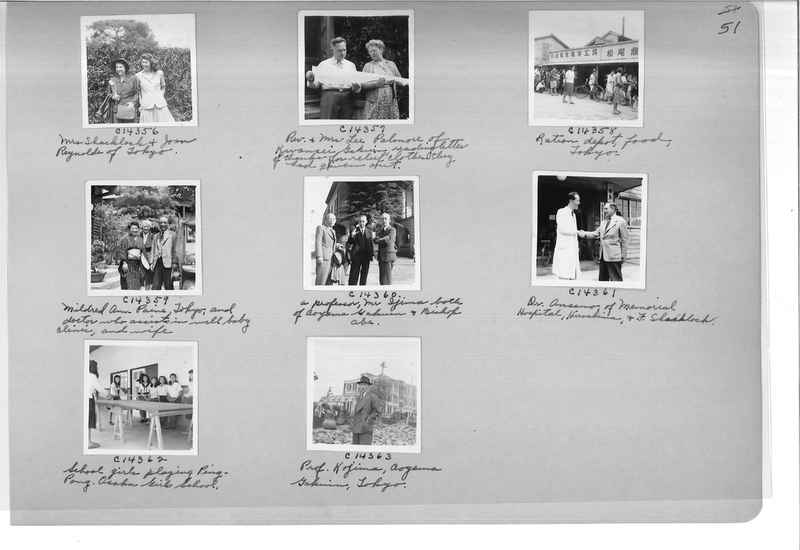
C14356 Mrs. Shacklock and Joan Reynold of Tokyo.
C14357 Rev. and Mrs. Lee Palmore of Kwasaki Gakuin, reading letter of
thanks for relief clothes they had given out.
C14358 Ration depot, food, Tokyo.
C14359 Mildred Ann Paine, Tokyo, and doctor who assists in well baby
clinic, and wife.
C14360 A professor, Mr. Ijima both of Aoyama Gakuin and Bishop Abe.
C14361 Dr. Ansano of Memorial Hospital, Hiroshima, and F. Shacklock.
C14362 School girls playing Ping Pong. Osaka girls school.
C14363 Prof. Kojima, Aoyoma Gakuin, Tokyo.
Mission Photograph Album - Japan #07 Page 0053
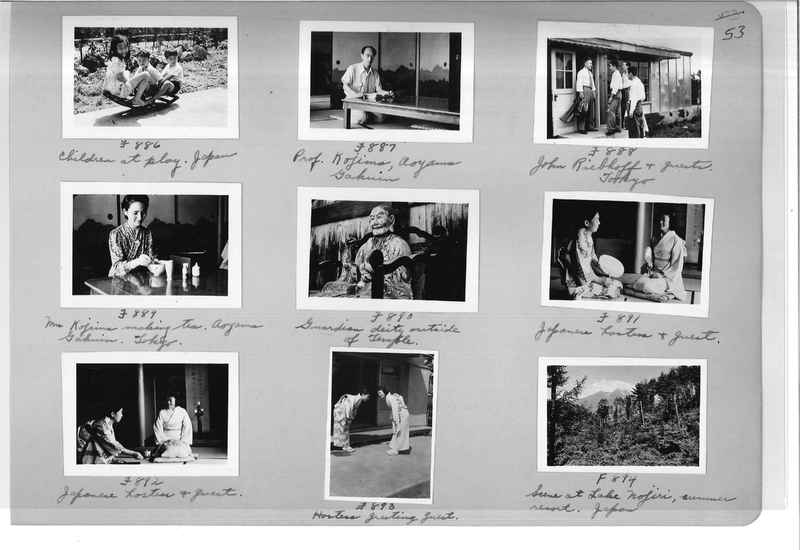
F886 Chilren at play, Japan.
F887 Prof. Kojima, Aoyoma Gakuin.
F888 John Reibhoff and guests. Tokyo.
F889 Mrs. Kojima making tea. Aoyoma Gakuin. Tokyo.
F890 Gardian Deity outside of Temple.
F891 Japanese hostess and guest.
F892 Japanese hostess and guest.
F893 Hostess greeting guest.
F894 Scene at Lake Nojiri, Summer resort. Japan.
Mission Photograph Album - Japan #07 Page 0054
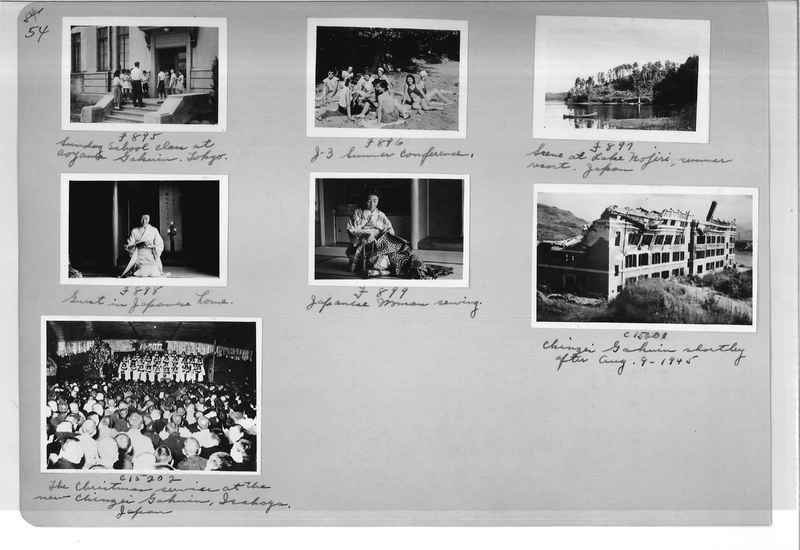
F895 Sunday School class at Aoyama Gakuin. Tokyo.
F896 J-3 Summer conference.
F897 Scene at Lake Jojiri, Summer resort. Japan.
F898 Guest in Japanese home.
F899 Japanese Women sewing.
C15201 Chinzei Gakuin shortley after Aug. 9, 1945.
C15202 The Christmas service at the new Chinzei Gakuin, Isahoga. Japan.
Mission Photograph Album - Japan #07 Page 0055
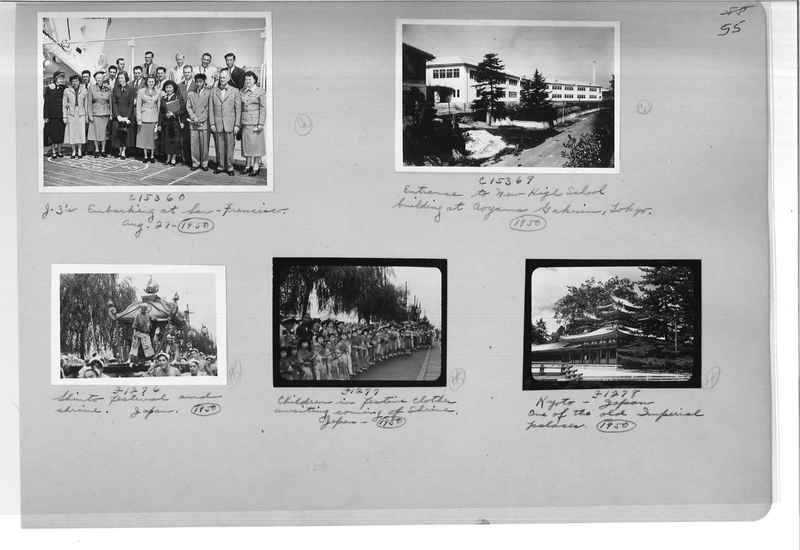
C15360 J-3's Embarking at San-Francisco. Aug. 27, 1950.
C15369 Entrance to new high school building at Aoyama Gakuin, Tokyo. 1950.
F1276 Shinto festival and shrine. Japan.
F1277 Children in Festival clothes awaiting coming of Shrine. Japan. 1950.
F1278 Kyoto - Japan. One of the old Imperial Palace. 1950.
Mission Photograph Album - Japan #07 Page 0056
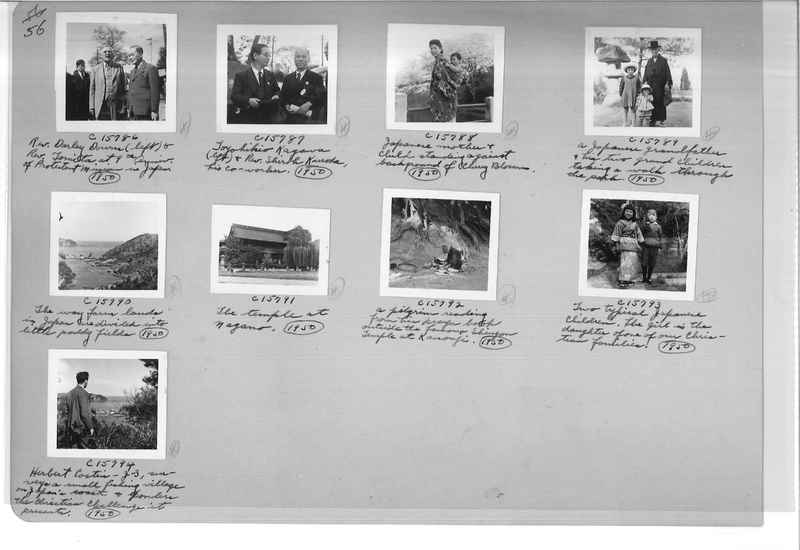
C15786 Rev. Darley Downs (left) and Rev. Tomita at 9th Anniversay of
Protestant Missionary in Japan. 1950.
C15787 Tohohikio Kagawa (left) and Rev. Shiroh Kwada, his co-worker. 1950.
C15788 Japanese mother and child standing against background of cherry
blossom. 1950.
C15789 A Japaense grandfather and his two grand children taking a walk
through the park, 1950.
C15790 The way farm lands in Japan are divided into little paddy fields.
1950.
C15791 The temple at Nagano, 1950.
C15792 A pilgrim reading from his prayer book outside the famous Shingon
temple at Kanonji. 1950.
C15793 Two typical Japanese Children. The girl is the daughter of one of
our Christian families. 1950.
C15794 Herbert Costin - J-3, Surveys a small fishing village on Japan's
coast and ponders the Christian challenge it presents.
Mission Photograph Album - Japan #07 Page 0057
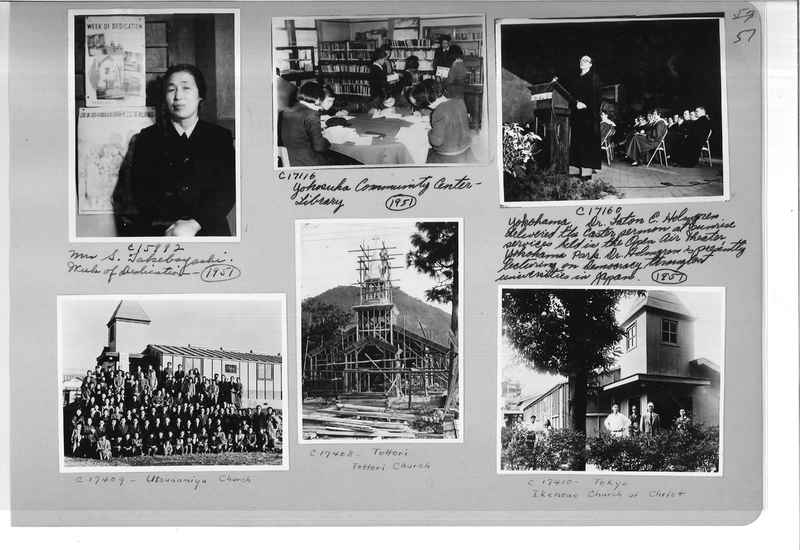
C15992 Mrs. S. Takeboyashi. Week of Dedication. 1951.
C17116 Yohosuka Community Center Library. 1951.
C17160 Yokohama, Dr. Laton E. Holmgren delivered the Easter sermon at
sunrise services held in the Open Air Theater Yokohama Park. Dr. Holmgren
is presently lecturing on Democracy throughout universities in Japan. 1951.
C17409 Utsunomiya church.
C17408 Tottori Chruch.
C17410 Tokyo, Ikehoue Church of Christ.
Mission Photograph Album - Japan #07 Page 0058
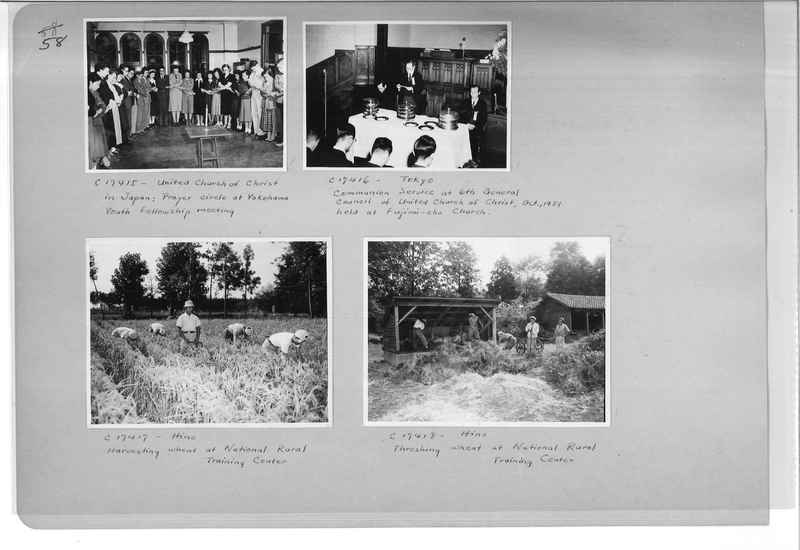
C17415 United Church of Christ in Japan: Prayer circle at Yokohama Youth
Fellowship meeting.
C17416 Tokyo. Communion Service at 6th General Council of United Church of
Christ, Oct. 1951 held at Fujimi - cho Church.
C17417 Hino. Harvesting wheat at National Rural Training Center.
C17418 Hino. Threshing wheat at National Rural Training Center.
Mission Photograph Album - Japan #07 Page 0061
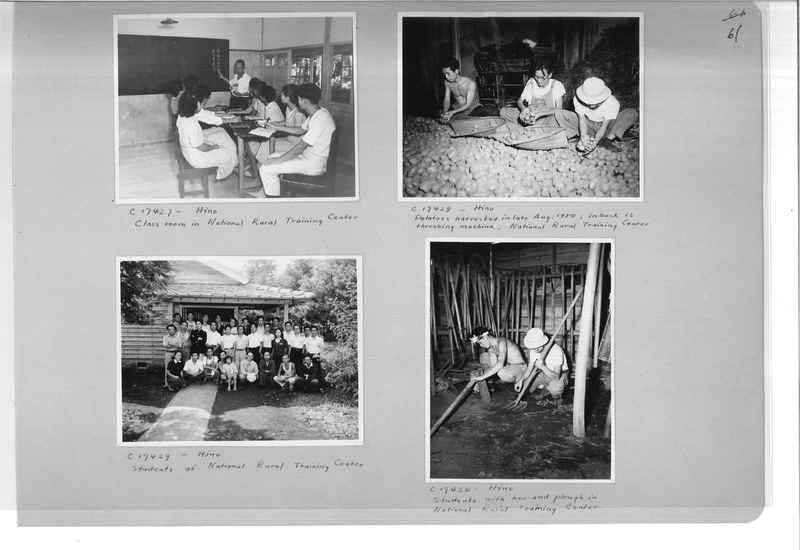
C17427 Hino. Class room at National Rural Training Center.
C17428 Hino. Potatoes harvested in late Aug. 1950; in back is threshing
machines, at National Rural Training Center.
C17429 Hino. Students of National Rural Training Center.
C17430 Hino. Students with hoe and plough at National Rural Training
Center.
Mission Photograph Album - Japan #07 Page 0063
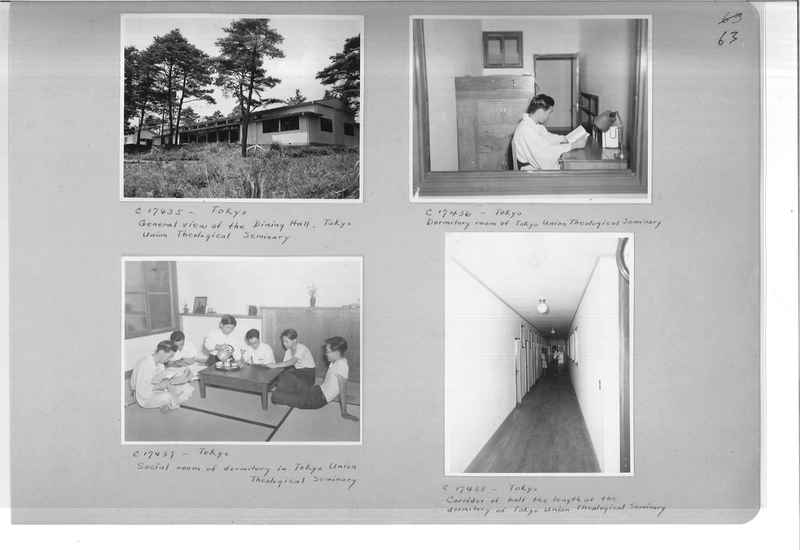
C17435 Tokyo. General view of the Dining Hall of Tokyo Union Theological
Seminary.
C17436 Tokyo. Dormitory room of Tokyo Union Theological Seminary.
C17437 Tokyo. Social room of dormitory in Tokyo Union Theological Seminary.
C17438 Tokyo. Corridor of half the length of the dormitory of Tokyo Union
Theological Seminary.
Mission Photograph Album - Japan #07 Page 0066
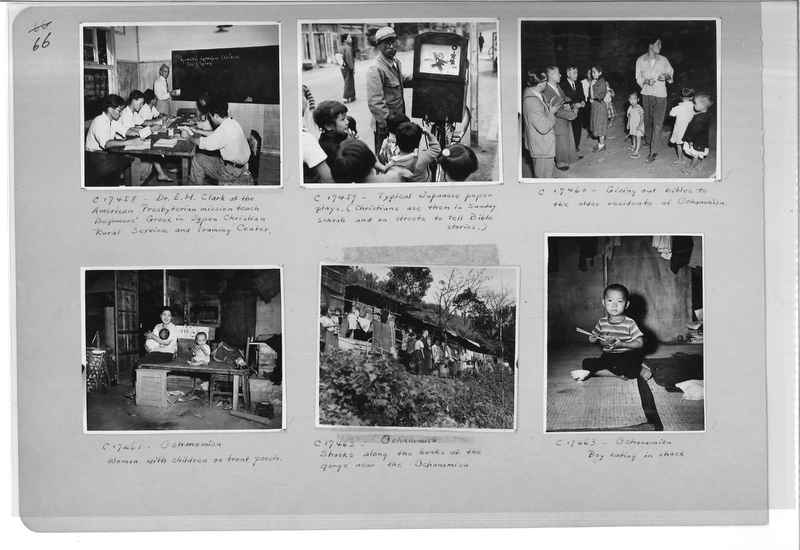
C17458 Dr. E. M. Clark of the American Presbyterian mission teach
beginners' Greek in Japan Christian Rural service and training center.
C17459 Typical Japanese paper plays. (Christians use them in Sunday school
and on streets to tell Bible stories.)
C17460 Giving out bibles to the older residents of Ochanomizu.
C17461 Ochanomizu. Woman with children on front porch.
C17462 Ochanomizu. Shacks along the banks of the gorge near the Ochanomizu.
C17463 Ochanomizu. Boy eating in shack.
Mission Photograph Album - Japan #07 Page 0067
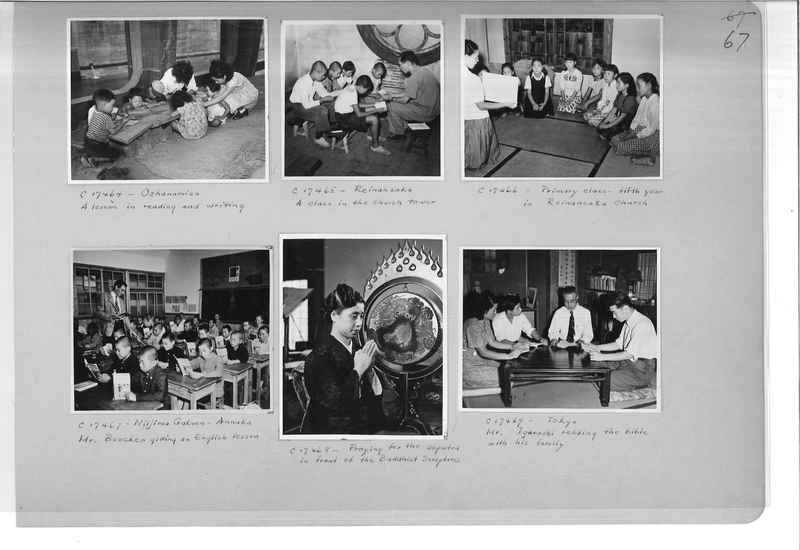
C17464 Ochanomizu. A lesson in reading and writing.
C17465 Reinanzaka. A class in the church tower.
C17466 Primary class fifth year in Reinanzaka Church.
C17467 Niijima Gakuin - Annaka Mr. Beecken giving an English lesson.
C17468 Praying fro the departed in front of the Buddhist Scriptures.
C17469 Tokyo. Mr. Igarashi reading the bible with his family.
Mission Photograph Album - Japan #07 Page 0068
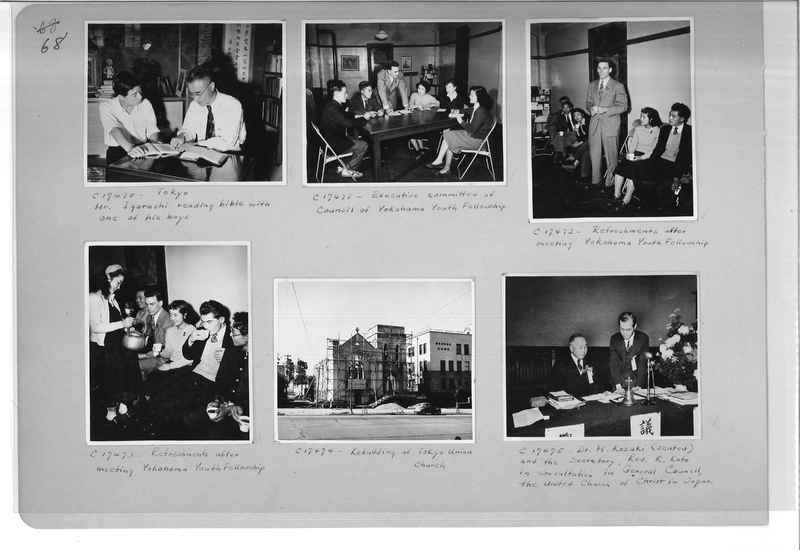
C17470 Tokyo. Mr. Igarashi reading bible with one of his boys.
C17471 Executive committee of council of Yokohama youth fellowhip.
C17472 Refreshments after meeting Yokohama Youth Fellowship.
C17473 Refreshments after meeting Yokohama Youth Fellowship.
C17474 Rebuilding of Tokyo Union Church.
C17475 Dr. M. Kozaki (seated) and the secretary, Rev. R. Kato in
consultation in General Council the United Church of Christ in Japan.
Mission Photograph Album - Japan #07 Page 0069
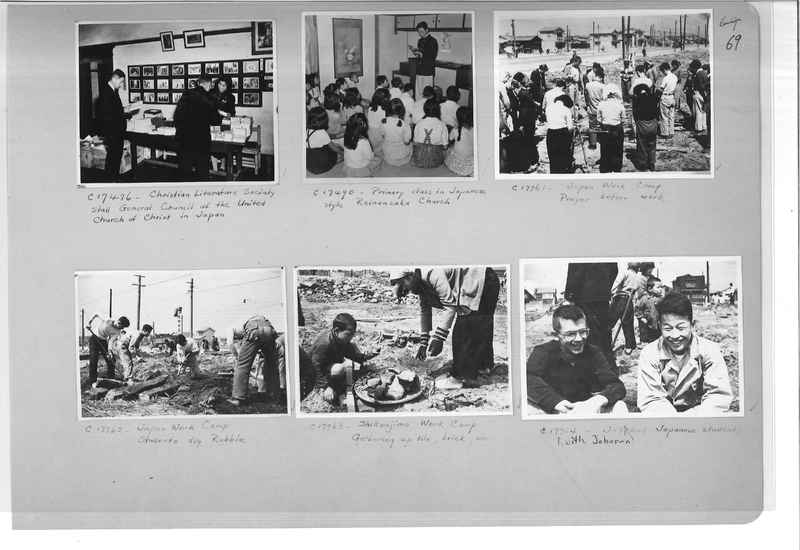
C17476 Christian Literature Society stall General Council of the United
Church of Christ in Japan.
C17490 Primary class in Japanese style Reinanzaka Church.
C17761 Japan work camp. Prayer before work.
C17762 Japan work camp. students dig rubble.
C17763 Shikanjima work camp. Gathering up tile, brick, etc.
C17764 J-3 and Japanese students. Keith Johnson.
Mission Photograph Album - Japan #07 Page 0070
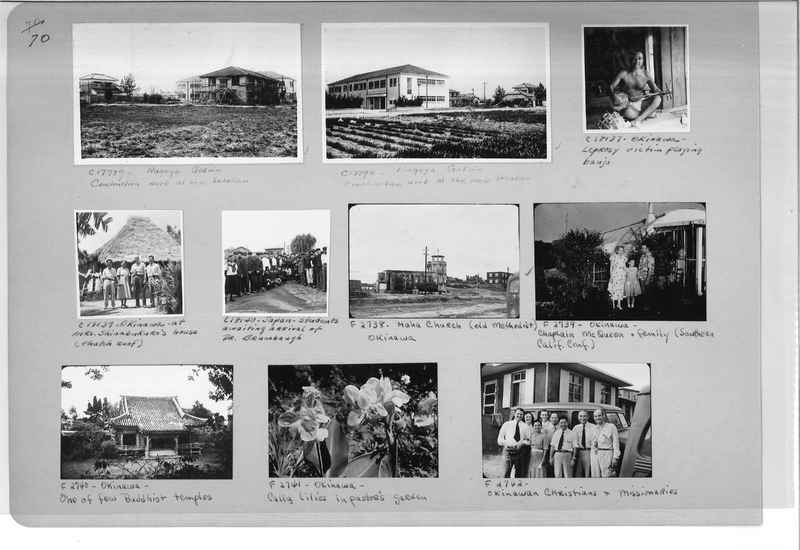
C17789 Nagoya Gahuin. Construction work at new location.
C17790 Nagoya Gakuin. Construction work at the new location.
C18137 Okinawa - Leprosy victim playing banjo.
C18139 Okinawa at Mrs. Shinabukuro's house (thatch roof).
C18140 Japan students awaiting arriving of Dr. Brumbaugh.
F2738 Naha church (old Methodist) Okinawa.
F2739 Okinawa - Chaplain McQueen and family (Southern Calif. Conf.)
F2740 Okinawa - One of few Buddhist temples.
F2741 Okinawa - Calla lilies in pastor's garden.
F2742 Okinawa Christian and missionaries.
Mission Photograph Album - Japan #07 Page 0071
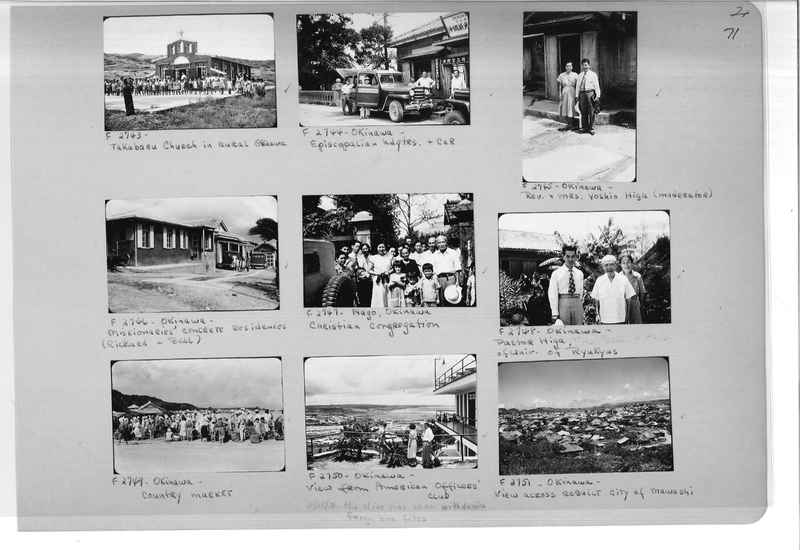
F2743 Takabaru Church in rural Okinawa.
F2744 Episcopalian hdqtrs and car.
F2745 Okinawa - Rev. and Mrs. Yoshio Higa (moderator)
F2746 Okinawa - Missionaries' concrete residences (Rickaed and Bell)
C172747 Nago, Okinawa Christian congregation.
F2748 Okinawa - Pastor Higa of Univ. of Ryukyus.
F2749 Okinawa - country market.
F2750 Okinawa - View from American officers' club.
F2751 Okinawa - view across rebuilt city of Mawashi.
Mission Photograph Album - Japan #07 Page 0072
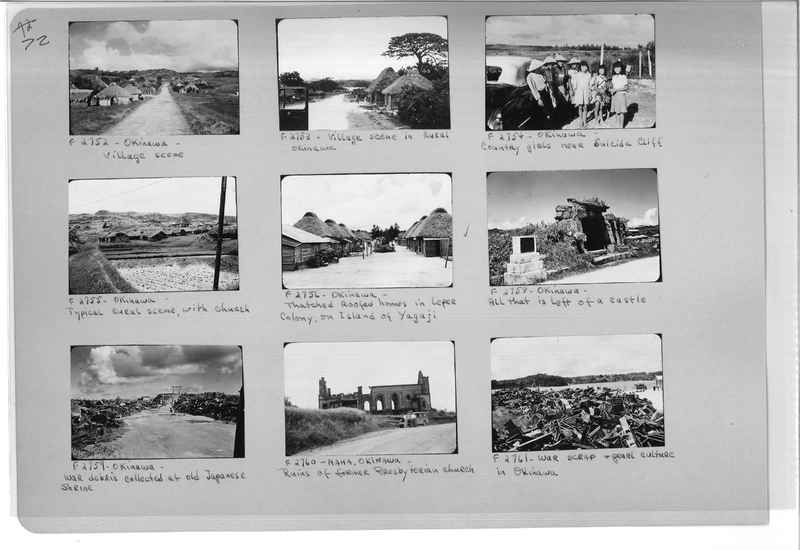
F2752 Okinawa - village scene.
F2753 Village scene in rural Okinawa
F2754 Okinawa - country girls near Suicide Cliff.
F2755 Okinawa - Typical rural scene with church.
F2756 Okinawa - Thatched roofed homes in Leper Colony, on Island of Yagaji.
F2758 Okinawa - All that is left of a castle.
F2759 Okinawa - war debris collected at old Japanese Scrine.
F2760 Naha, Okinawa - Ruins of former Presbyterian church.
F2761 War scrap and pearl culture in Okinawa.
Mission Photograph Album - Japan #07 Page 0073
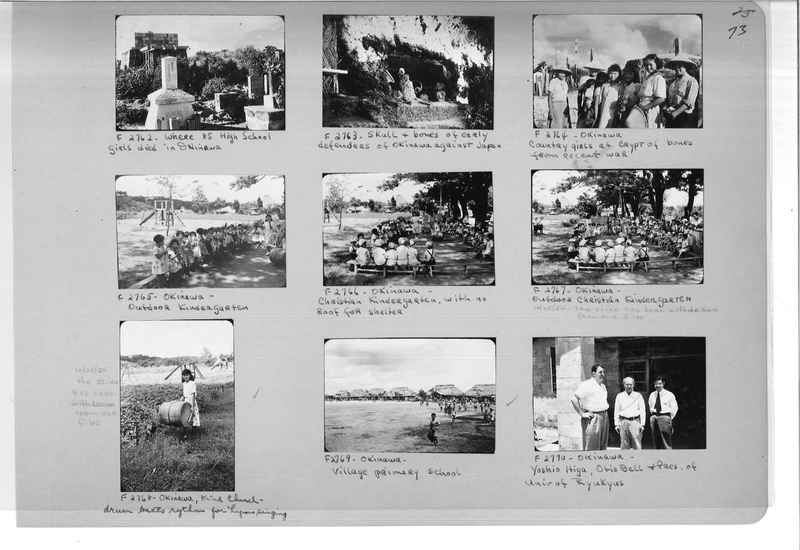
F2762 Where 85 high school girls died in Okinawa.
F2763 Skull and bones of early defendees of Okinawa against Japan.
F2764 Okinawa - Country girls at crypt of bones from recent war.
F2765 Okinawa - Outdoor Kindergarten.
F2766 Okinawa - Christian Kindergarten, with no roof for shelter.
F2767 Okinawa - OUtdoor Christian Kindergarten.
F2768 Okinawa, Kind church drum beats rythm for hymn singing.
F2769 Okinawa - Village primary school.
F2770 Okinawa - Yoshio Higa, Otis Bell and Pres. of Univ. of Ryukyus.
Mission Photograph Album - Japan #07 Page 0074
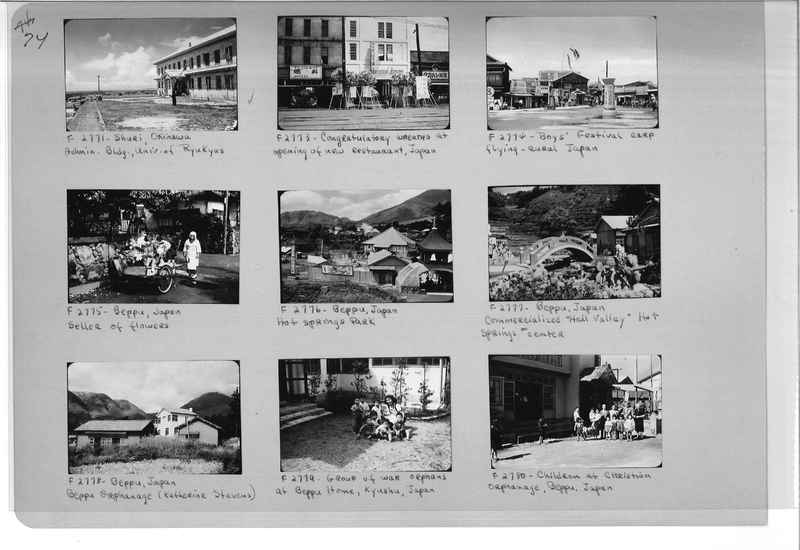
F2771 Shuri, Okinawa Admin. Bldg. Univ. of Ryukyus.
F2773 Congratulatory wreaths at opening of new restaurant, Japan.
F2774 Boys' festival carp flying - rural Japan.
F2775 Beppu, Japan seller of flowers.
F2776 Beppu, Japan hot springs park.
F2777 Beppu Japan. Commercialized "Hell Valley" Hot Springs center.
F2778 Beppu, Japan. Beppu Orphanage (Katherine Stevens)
F2780 Children at Christian orphanage, Beppu, Japan.
Mission Photograph Album - Japan #07 Page 0075
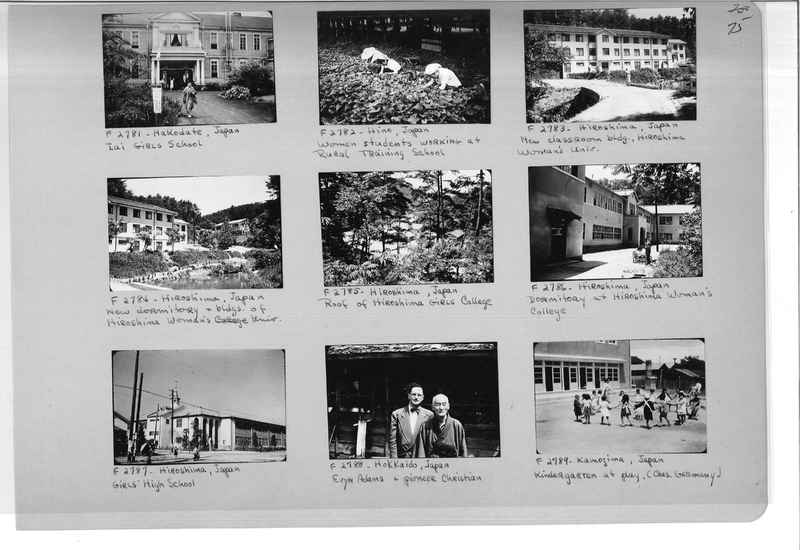
F2522 Nikko. Boy in Religious Festival parade.
F2781 Hakodate, Japan. Iai Girls School.
F2782 Hino, Japan. Women students working at Rural Training School.
F2783 Hiroshima, Japan New Classroom bldg. Hiroshima Woman's Univ.
F2784 Hiroshima, Japan - New dormitory and Bldg. of Hiroshima Woman's Univ.
F2785 Hiroshima, Japan - Roof of Hiroshima Girls College.
F2786 Hiroshima, Japan. Dormitory at Hiroshima Woman's College.
F2787 Hiroshima, Japan. GIrls' High School.
F2788 Hokkaido, Japan. Evyn Adams and pioneer Christian.
F2788 Kamojima, Japan. Kindergarten at play (Chas. Germany)
Mission Photograph Album - Japan #07 Page 0076
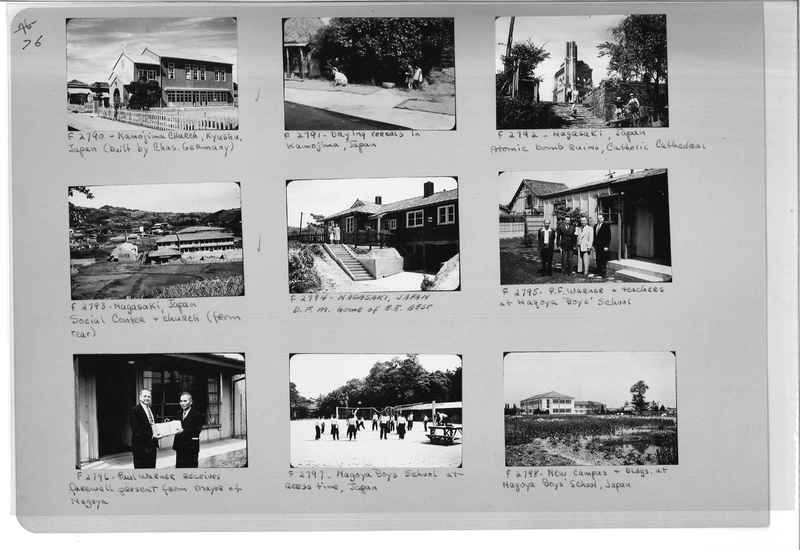
F2790 Komojima Church, Kyushu, Japan (built by Chas. Germany)
F2791 Drying cereals in Kamojima, Japan.
F2792 Nagasaki, Japan. Atomic bomb ruins, Catholic Catheral.
F2793 Nagasaki, Japan. Social Center and Church (from rear)
F2794 Nagasaki, Japan D.F.M. home of E.E. Best.
F2795 P.F. Warner and teachers at Nagoya Boy's School.
F2796 Paul Warner recieves farewell present from mayor of Nagoya.
F2797 Nagoya Boys School at recess time, Japan.
F2798 New Campus and Bldg. at Nagoya Boy's School, Japan.
Mission Photograph Album - Japan #07 Page 0077
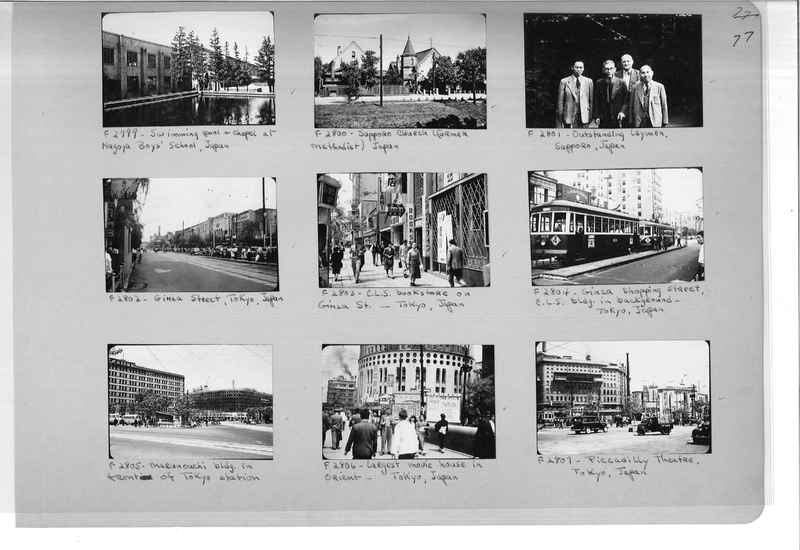
F2799 Swimming pool and chapel at Nagoya Boys' School, Japan.
F2800 Sapporo church (former Methodist) Japan.
F2801 Outstanding laymen, Sapporo, Japan.
F2802 Ginza street, Tokyo, Japan.
F2803 C.L.S. Bookstore on Ginza st. - Tokyo, Japan.
F2804 Ginza shopping street. C.L.S. Bldg. in background - Tokyo, Japan.
F2895 Marunouchi Bldg. in front of Tokyo station.
F2806 Largest movie house in Orient - Tokyo, Japan.
F2807 Piccadilly Theater, Tokyo, Japan.
Mission Photograph Album - Japan #07 Page 0078
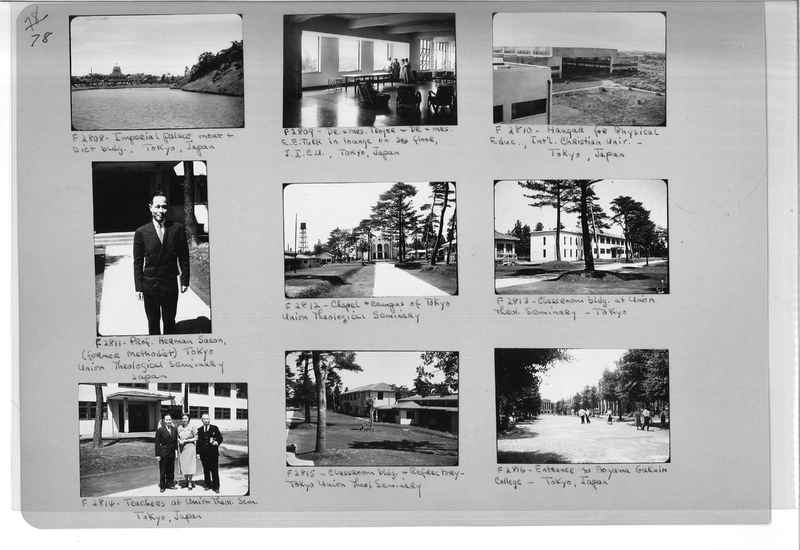
F2808 Imperial Palace moat and Diet Bldg. Tokyo, Japan.
F2809 Dr. and Mrs. Troyer and Dr. and Mrs. E.E. Tuck in lounge on 3rd
floor. J.I.C.U. Tokyo, Japan.
F2810 Hangar for Physical Educ. Int'l Christian Univ. Tokyo, Japan.
F2811 Prof. Herman Sacon, (former Methodist) Tokyo Union Theological
Seminary, Japan.
F2812 Chapel and campus of Tokyo Union Theologica Seminary.
F2813 Classroom Bldg. at Union Theol. Seminary - Tokyo, Japan.
F2814 Teachers of Union Theol. Sem. Tokyo, Japan.
F2815 Classroom Bldg. and Refrectory - Tokyo Union Theol. Seminary.
F2816 Entrance to Aoyama Gakuin College - Tokyo, Japan.
Mission Photograph Album - Japan #07 Page 0079
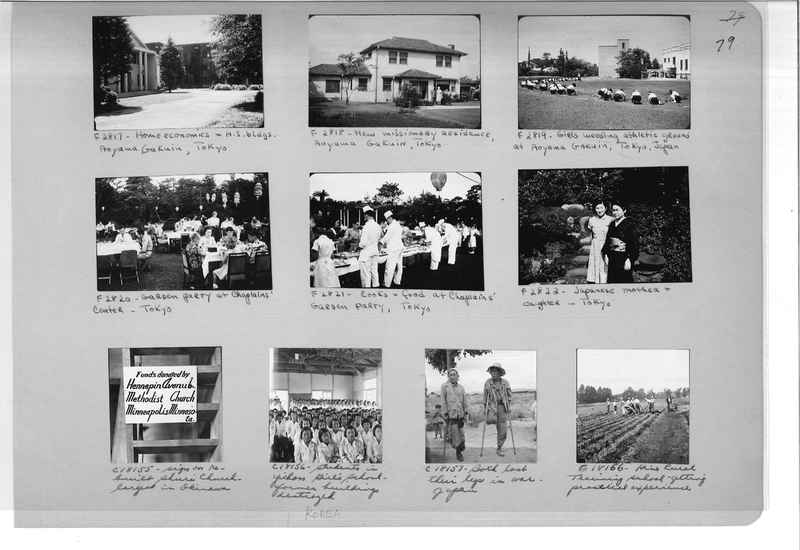
F2817 Home economics and H.S. Bldgs. Aoyama Gakyuin, Tokyo, Japan.
F2818 New missionary residence, Aoyama Gakuin, Tokyo, Japan.
F2819 Girls weeding athletic ground at Aoyama Gakuin, Tokyo, Japan.
F2820 Garden party at Chaplain's center - Tokyo, Japan.
F2821 Cooks and food at Chaplains' Garden party, Tokyo, Japan.
F2822 Japanese mother and daughter - Tokyo, Japan.
C18155 Sign on rebuilt Shuri Church larged in Okinawa.
F18156 Students in Yichon Girl's School former buildings destroyed.
C18157 Both lost their legs in war - Japan.
C18166 Hino Rural Training school - getting practical experience.
Mission Photograph Album - Japan #07 Page 0080
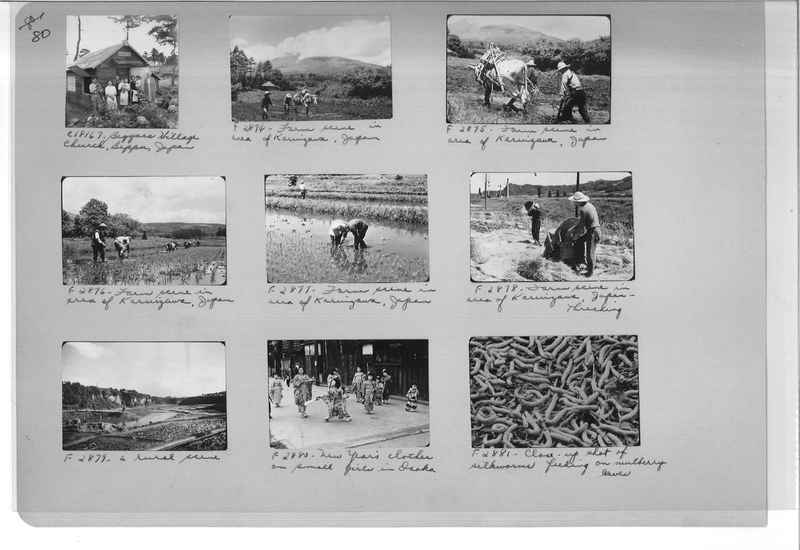
C18167 Beggars Village Church, Beppu, Japan.
F2874 Farm scene in area of Kariuzawa, Japan.
F2875 Farm scene in area of Kariuzawa, Japan.
F2876 Farm scene in area of Karuizawa, Japan.
F2877 Farm scene in area of Karuizawa, Japan.
F2878 Farm scene in area of Karuizawa, Japan - Threshing.
F2879 A rural scene.
F2880 New Year's clothes on small girls in Osaka.
F2881 Close-up shot of silkwarms feeding on mulberry leaves.
Mission Photograph Album - Japan #07 Page 0081
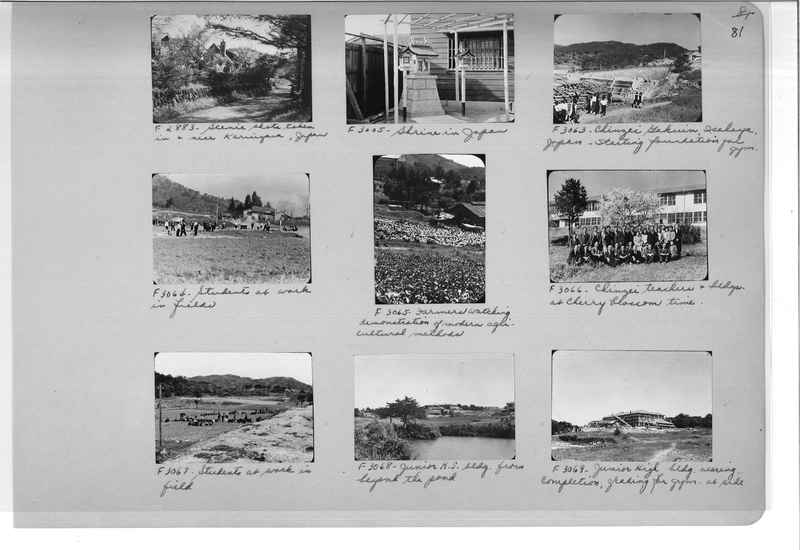
F2883 Scene shots taken in a near Karuizawa, Japan.
F3005 Shrine in Japan.
F3063 Chinzei Gakuin Isahaya, Japan - starting foundation for gym.
F3064 Students of work in fields.
F3065 Farmers watching demonstration of modern agricultral methods.
F3066 Chinzei teachers and Bldgs. at cherry blossom time.
F3067 Students at work in field.
F3068 Junior H.S. Bldg. from beyond the pond.
F3069 Junior High Bldg. wearing completion, grading fro gym. at side.
Mission Photograph Album - Japan #07 Page 0082
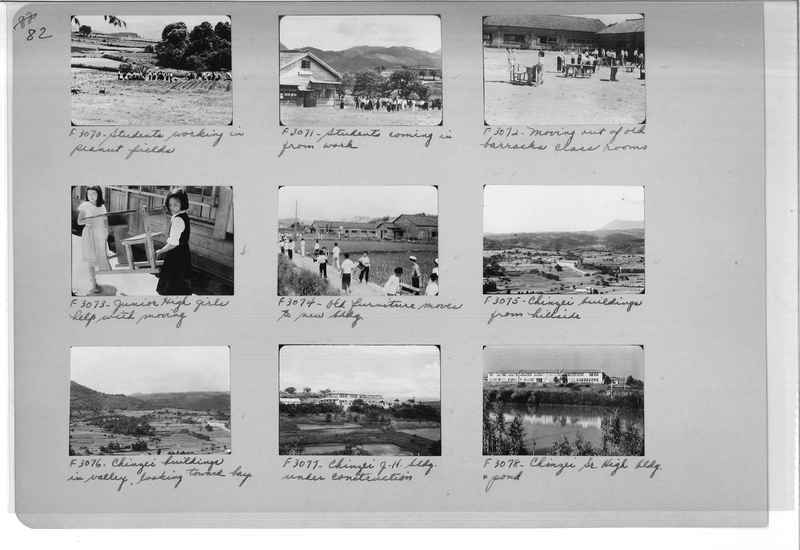
F3070 Students working in peanut fields.
F3071 Students coming in from work.
F3072 Moving out of old barracks class rooms.
F3073 Junior High girls help with moving.
F3074 Old funiture moves to new bldg.
F3075 Chinzei buildings from hillside.
F3076 Chinzei buildings in valley, looking toward bay.
F3077 Chinzei J.H. bldg. under construction.
F3078 Chinzei Sr. High bldg. and pond.
Mission Photograph Album - Japan #07 Page 0083
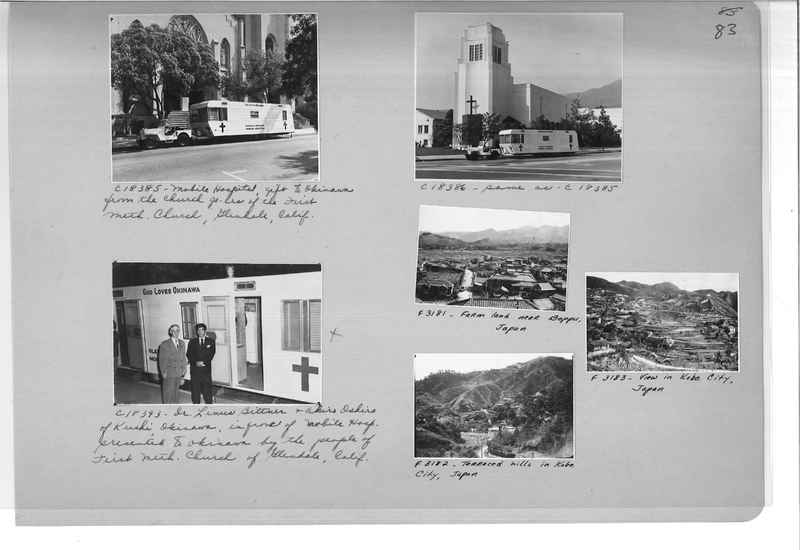
C18385 Mobile Hospital gift to Okinawa from the Church go-era of the First
Methodist Church, Glendale, Calif.
C18286 Same as C18385
C18393 Dr. Linus Bittner and Akiro Oshiro of Hushi, Okinawa, in front of
mobile hosp. presented to Okinawa by the people of First Methodist Church
of Glendale, Calf.
F3181 Farm land near Beppu, Japan.
F3182 Terraced hills in Kobe City, Japan.
F3183 View in Kobe city, Japan.
Mission Photograph Album - Japan #07 Page 0085
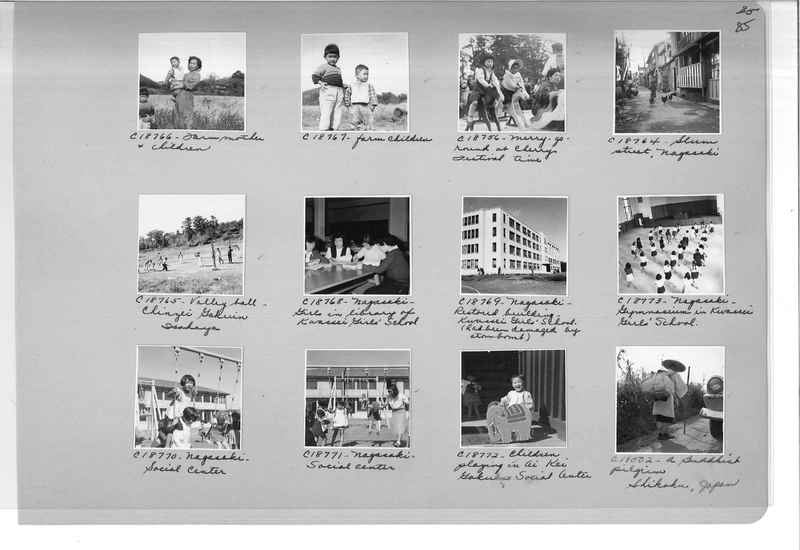
C18766 Farm mother and children.
C18767 Farm children.
C18756 Merry-go-round at cherry festival time.
C18764 Slum street, Nagoya.
C18765 Valley ball - Chinzei Gakuin Isahaya.
C18768 Nagasaki - girls in library of Kwassei Girls' School.
C18769 Nagasaki - Restored building Kwassei girls' school (had been
damaged by atom bomb.)
C18773 Nagasaki - Gymnasium in Kwassei Girls' School.
C18770 Nagasaki social center.
C18771 Nagasaki social center.
C18772 Children playing in Ai Kei Gakuin social center.
C19502 A Buddhist pilgrim Shikaku, Japan.
Mission Photograph Album - Japan #07 Page 0086
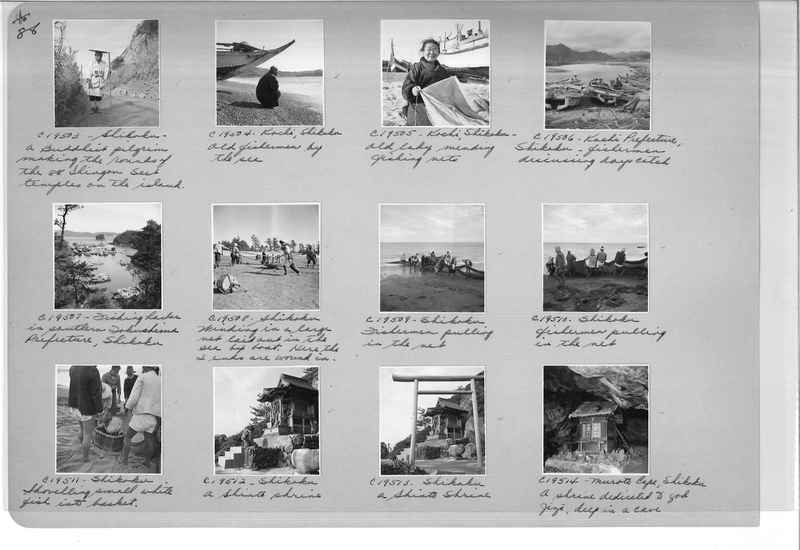
C19503 Shikaku - a Buddhist pilgrim making the rounds of the 88 Shingon
Sect temples on the island.
C19504 Kachi, Shikaku old fisherman by the see.
C19505 Kachi, Shikaku old lady mending fishing net.
C19506 kachi prefecture, Shikaku - fishermen discussing days catch.
C19507 Fishing harbor in southern Fakushima prefecture, Shikaku.
C19508 Shikaku winding in a large net laid out in the sea by boat. Here
the 2nds are wound in.
C19509 Shikaku Fishermen pulling in the net.
C19510 Shikaku pulling in the net.
C19511 Shikaku shovelling small white fish into basket.
C19512 Shikaku a Shinto shrine.
C19513 Shikaku a Shinto shrine.
C19514 Murato Cape, Shikaku a Shrine dedicated to god Jizo, deep in a cave.
Mission Photograph Album - Japan #07 Page 0087
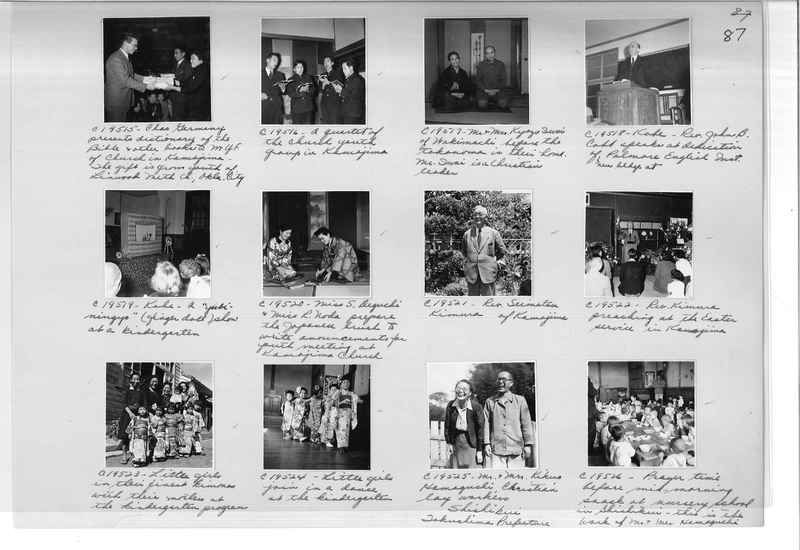
C19515 Chas. Germany presents dictionary of the Bible and other books to
M. Y. F. of Church in Kamojima - the gift is from youth of Linwood
Methodist Church, Okla. City.
C19516 A quartet of the Church youth group in Kamajima.
C19517 Mr. and Mrs. Kyozo Iwai of Wakimachi before the tokanoma in their
home Mr. Iwai is a Christian leader.
C19518 Kobe - Rev. John B. Cobb speaks of dedication of Palmore English
Inst. (at new bldg.)
C19519 Kobe - a "yubiningyo" (finger doll) show at a kindergarten.
C19520 Miss S. Deguchi and Miss R. Noda prepare the Japanese brush to
write anouncements fro youth meeting at Kamajima Church.
C19521 Rev. Seimatsu Kimura of Kamajima.
C19522 Rev. Kimura preaching at the Easter service in Kamajima.
C19523 Little girls in their finest Kimonos with their mothers at the
kindergarten program.
C19524 Little girls join in a dance at the kindergarten.
C19525 Mr. and Mrs. Kikus Hamaguchi, Christian lay workers Shishikui
Takushima Prefecture.
C19526 Prayer time before mid-morning snack at nursery school in Shishkui -
this is the work of Mr. and Mrs. Hamaguchi.
Mission Photograph Album - Japan #07 Page 0088
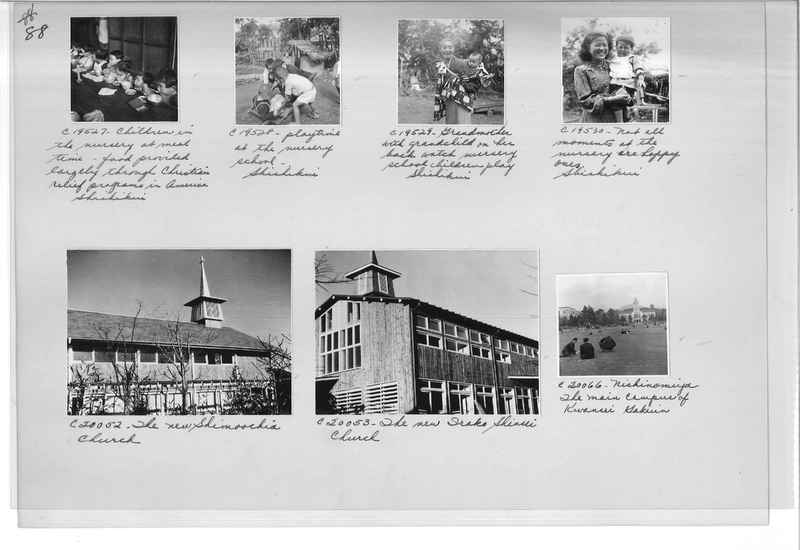
C19527 Children in the nursery at meal time - food provided largely
through Christian relief pragrams in America, Shichikui.
C19528 Playtime at the nursery school - Shishkui.
C19529 Grandmother with grandchild on her back watch nursery school
children play, Shishikui.
C19530 Not all moments at the nursery are happy ones. Shishikui.
C20052 The new Shishikui Church.
C20053 The new Iraks Shinsie Church.
C20066 Nishinomiya, The main campus of Kwansei Gakuin.
C20066 Nishinomiya The main Campus of Kwansei Gakuin.
Mission Photograph Album - Japan #07 Page 0089
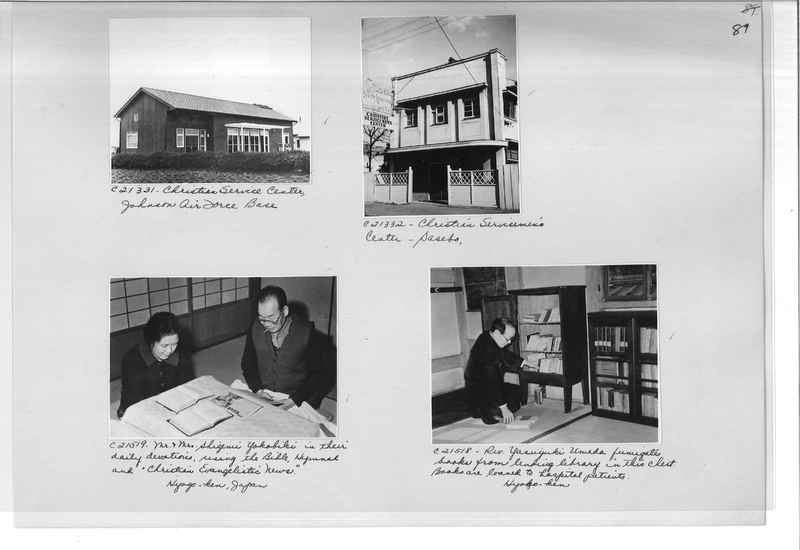
C21331 Christian service center, Jahuson Air Force base.
C21332 Christian sericemen's center - Sasebo.
C21519 Mr. and Mrs. Shigemi Yokobiki in their daily devotions, using the
Bible, Hymnal and "Christian Evangelistic News." Hyago-ken, Japan.
C21518 Rev. Yasuyuki Umeda fumigates books from lending library in this
chest books are loaned to hospital patients. Hyogo -ken.
Mission Photograph Album - Japan #07 Page 0091
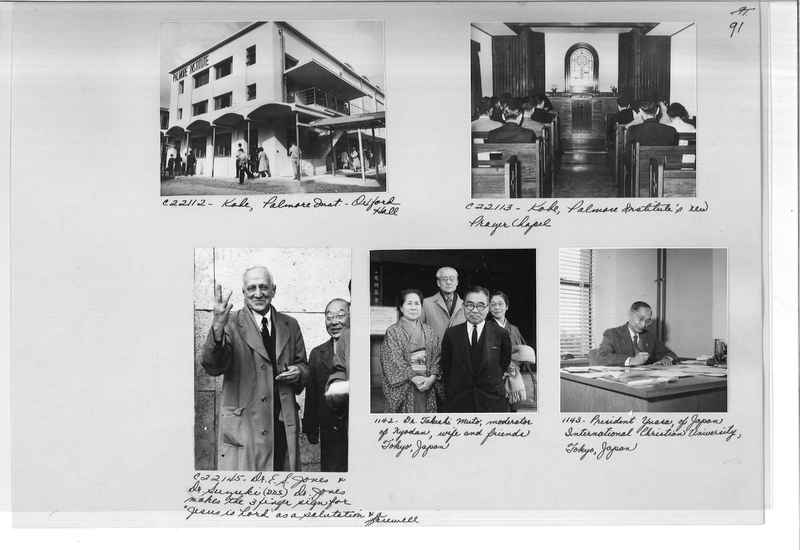
C22112 Kobe, Palmore Inst - Oxford Hall.
C22113 Kobe, Palmore Institute's new prayer chapel.
C22145 Dr. E.S. Jones and Dr. Suyuki (D.D.S.) Dr. Jones makes the 3
fingers sign for "Jesus is Lord" as a salvation and a farewell.
1142 Dr. Takuhi Muto, moderator of Kyodan, wife and friends Tokyo, Japan.
1143 President Yuasa, of Japan International Christian University, Tokyo,
Japan.
Mission Photograph Album - Japan #07 Page 0092
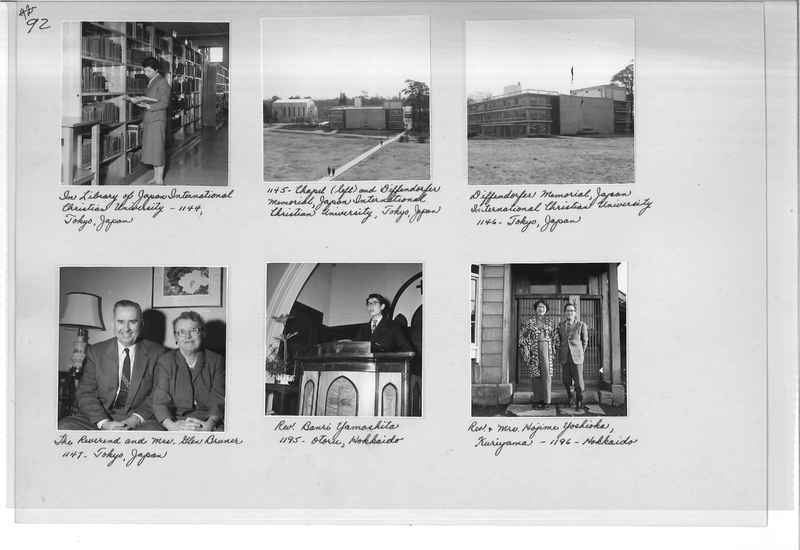
1144 In library of Japan International Christian University - Tokyo, Japan.
1145 Chapel (left) and Diffendorfer memorial, Japan International
Christian University, Tokyo, Japan.
1146 Diffendorfer Memorial, Japan International Christian University. -
Tokyo, Japan.
1147 The Reverend and Mrs. Glen Bruner - Tokyo, Japan.
1195 Rev. Banki Yamashita - Otoru, Hokkaido.
1196 Rev. and Mrs. Hojima Yoshioka Kuriyama, Hokkaido.
Mission Photograph Album - Japan #07 Page 0093
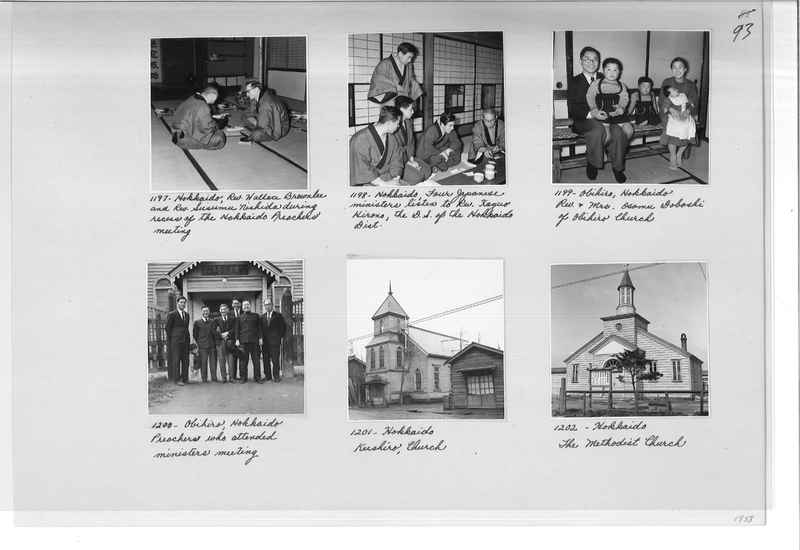
1198 Hokkaido, Four Japanese ministers listen to Rev. Kanuo Kirono, the
D.S. of the Hokkaido Dist.
1199 Obihiko, Hokkaido Rev. and Mrs. Osamu Doboshi of Obihiro Church.
1200 Obihiro, Hokkaido preachers who attended ministers meeting.
1201 Hokkaido Kushiro, Church.
1202 Hokkaido, The Methodist Church.
Mission Photograph Album - Japan #07 Page 0094
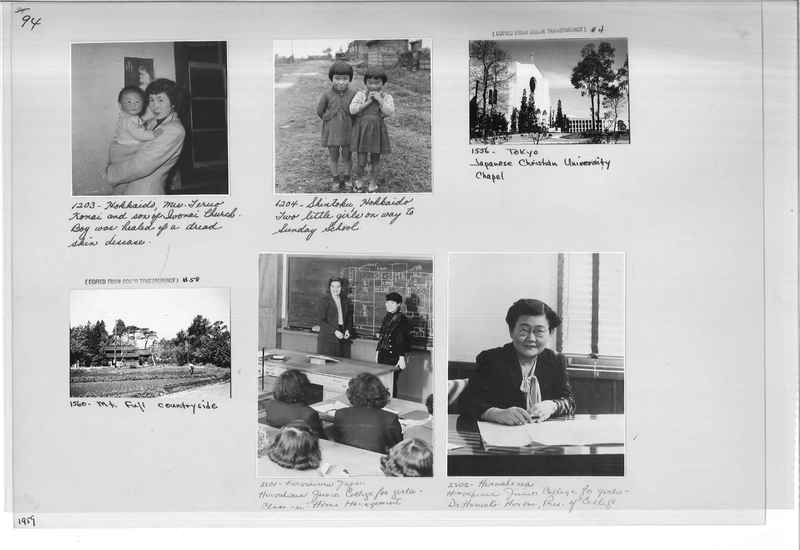
1203 Hokkaido, Mrs. Teruo Konai and son of Joonai Church. Boy was healed
of a dread skin disease.
1204 Shintoku Hokkaido two little girls on way to Sunday School.
1556 Tokyo Japanese Christian University Chapel.
1560 Mt. Fuji countryside.
2501 Hiroshima Japan. Hiroshima Junior College for girls class in Home
Management.
2502 Hiroshima Junior College for girls Dr. Hamako Hirosi, Pres. of
College.
Mission Photograph Album - Japan #07 Page 0095
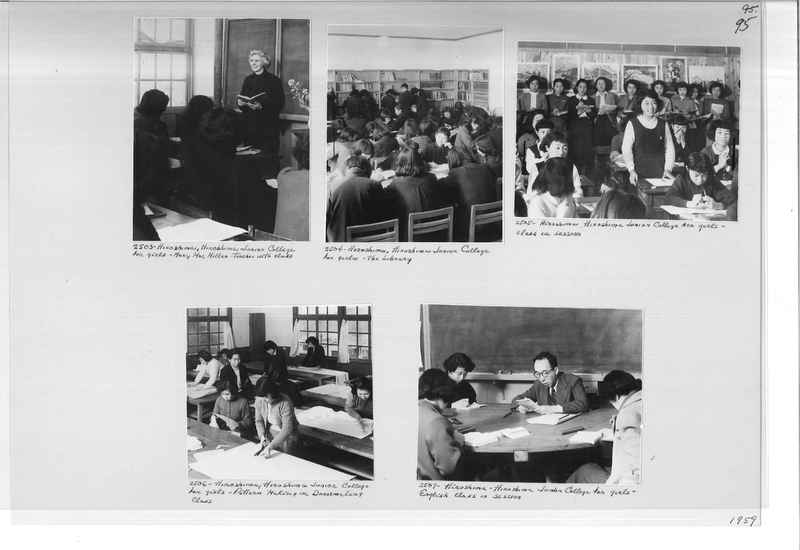
1197 Hokkaido, Rev. Wallace Brownlee and Rev. Susumu Nishida during recess
of the Hokkaido Preachers' meeting.
2503 Hiroshima Jonior College for girls - Mary Mae Millan teacher with
class.
2504 Hiroshima Junior College for girls - the Library.
2505 Hiroshima Junior College for girls - class in session.
2506 Hiroshima Junior College for girls - pattern making in dressmaking
class.
2507 Hiroshima Junior College for girls - English class in session.
Mission Photograph Album - Japan - O.P. #01 Page 0007
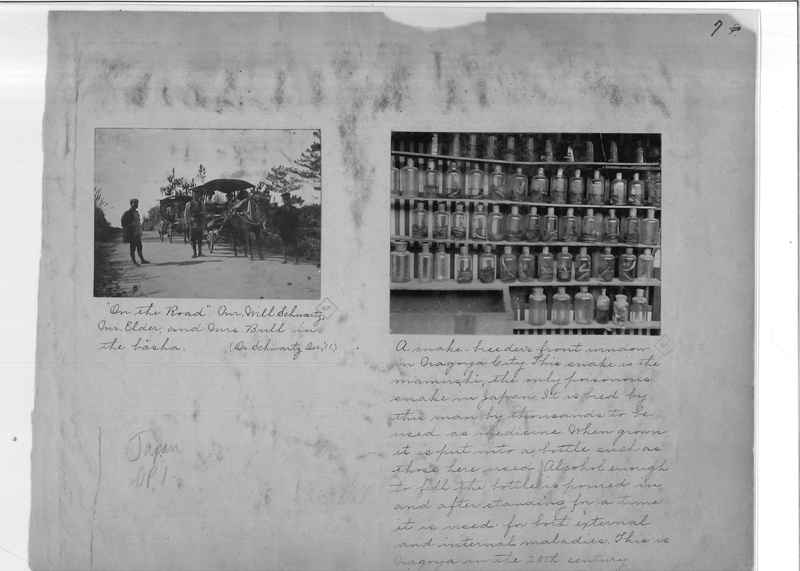
JapOP1-7:1 "On the Road," Mr. Will Schwarts, Mr. Elder, and Mrs. Bull in
the basha.
JapOP1-7:2 A snake-breeder's front window in Nagoya City. This snakes is
the mamushi, the only poisonous snake in Japan. It is bred by this man by
thousands to be used as medicine. When grown it is put into a bottle such
as those here used. Alcohol enough to fill the bottle is pured in and
after standing for a time it is used for both external and internal
maladies. This is Nagoya in the 20th century.
Mission Photograph Album - Japan - O.P. #01 Page 0055
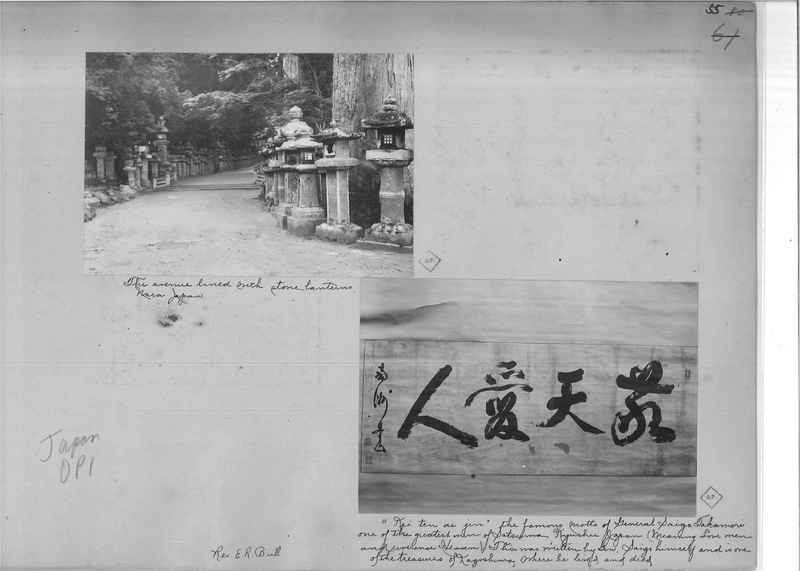
JapOP1-55:1 The avenue lined with stone lanterns, Nara, Japan.
JapOP1-55:2 "Kei ten ai jin," the famous motto of General Saigo Takamori,
one of the greatest men of Satsuma, Kyushu, Japan. (Meaning love men and
reverence Heaven) This was written by Gen. Saigo himself and is one of the
treasures of Kagoshima, where he lived and died.
Mission Photograph Album - Japan - O.P. #01 Page 0056
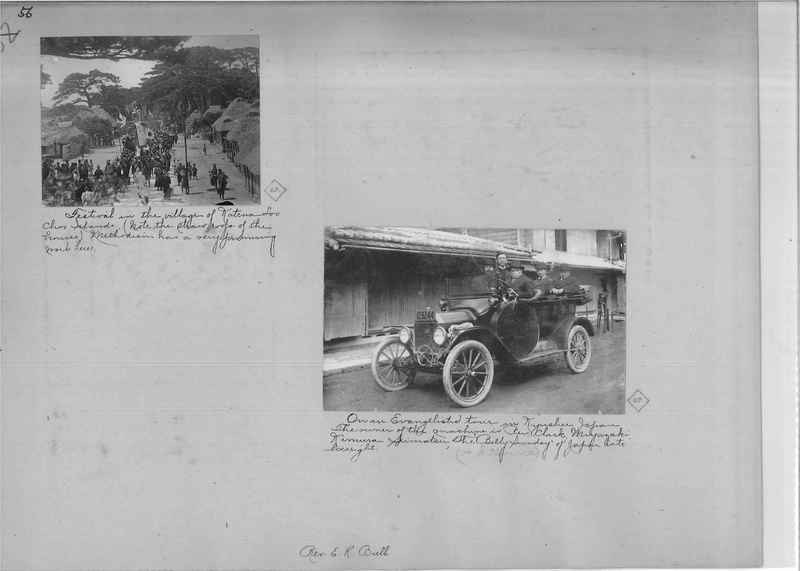
JapOP1-56:1 Festival in the village of Katena Loo Choo Islands. (Note the
straw roofs of the houses) Methodism has a very promising work here.
JapOP1-56:2 On an evangelistic tour in Kyushu, Japan. The owner of the
machine is Rev. Clark, Mryazaki, Kimura Seimatsu. "The Billy Sunday" of
Japan is to his right.
Mission Photograph Album - Japan - O.P. #01 Page 0057
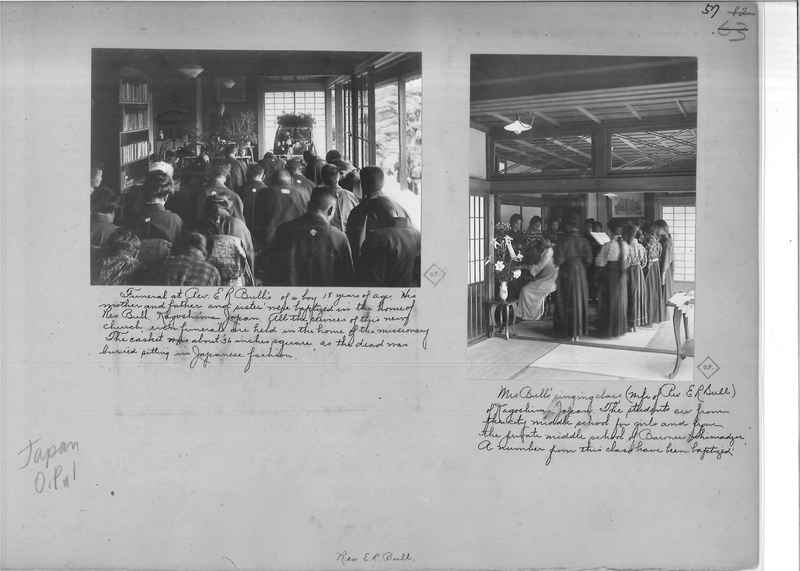
JapOP1-57:1 Funeral at Rev. E.R. Bull's of a boy 18 years of age. His
mother and father and sister were baptized in the home of Rev. Bull,
Kagoshima, Japan. All the services of this new church, even funerals are
held in the home of the missionary. The casket was about 36 inches square,
as the dead was buried sitting in Japanese fashion.
JapOP1-57:2 Mrs. Bull's singing class (wife of Rev. E.R. Bull) of
Kagoshima, Japan. The students are from the city middle school for girls
and from the private middle school of Baroness Shimadzu. A number from
this class have been baptized.
Mission Photograph Album - Japan - O.P. #01 Page 0058
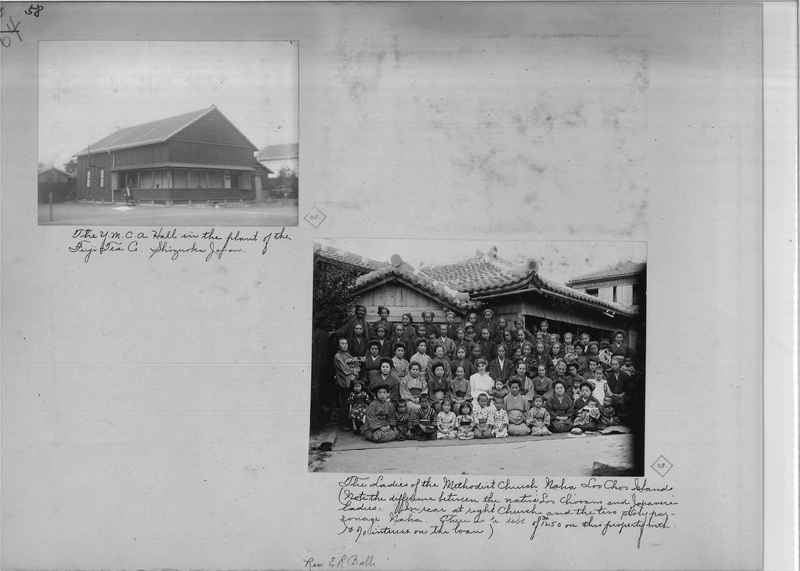
JapOP1-58:1 The Y.M.C.A. Hall in the plant of the Fuji Tea Co. Shizuoka,
Japan.
JapOP1-58:2 Teh ladies of the Methodist Church, Naha Loo Choo Islands
(Note the difference between the native Loo Chooans and Japanese ladise.
In rear at right Church and the two story parsonage, Naha. There is a debt
of $1,250 on this property with 10% interest on the loan.)
Mission Photograph Album - Japan - O.P. #01 Page 0062
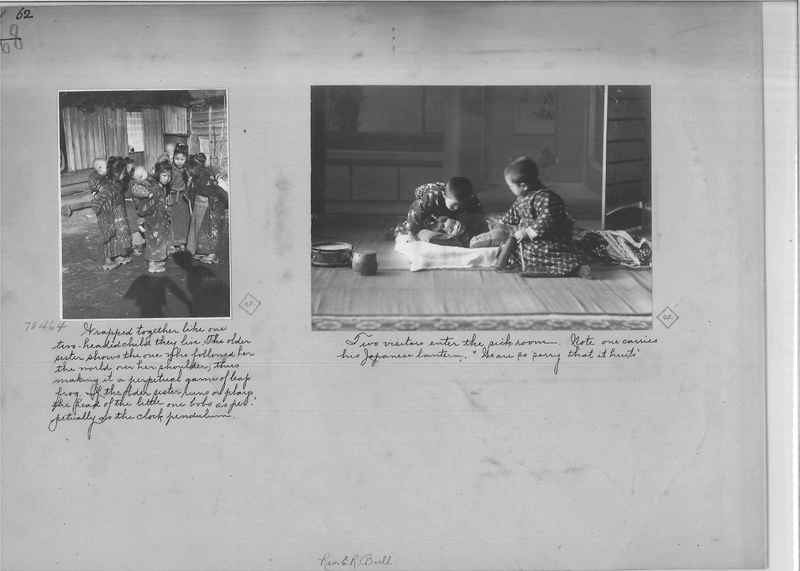
78464 Wrapped together like one two-headed child they live. The older
sister shows the one who followed her the world over her shoulder, thus
making it a perpetual game of leap frog. If the older sister runs on
plays, the head of the little one bobs as perpetually as the clock pendulum.
JapOP1-62:2 Two visitors enter the sick room. Note one carries his
Japanese lantern, "We are so sorry that it hurts."
Mission Photograph Album - Japan - O.P. #01 Page 0063
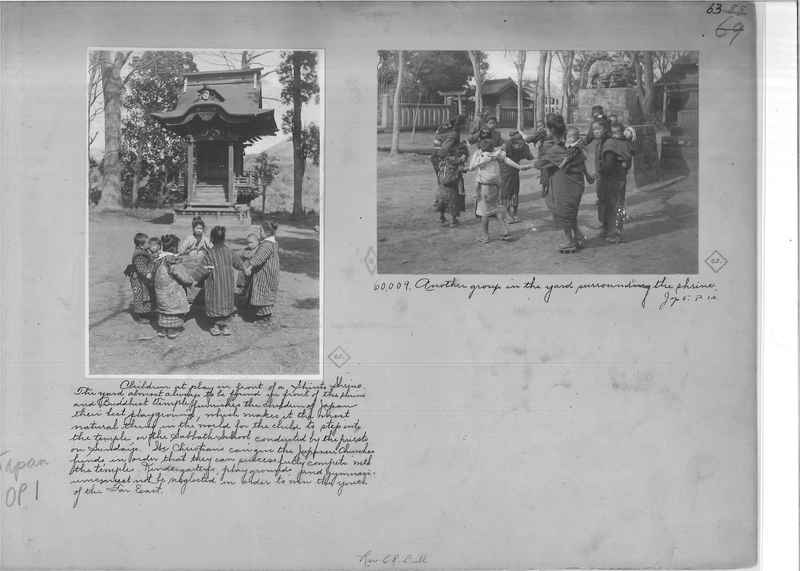
JapOP1-63:1 Children at play in front of a Shinto Shrine. The yard almost
always to be found in front of the Shrine and Buddhist Temple furnishes the
children of Japan their best palyground, which makes it the most natural
thing in the world for the child to step into the temple, or the Sabbath
School, conducted by the priests on Sundays. We Christians can give the
Japanese churches funds, in order that they can success fully complete with
the temples. Kindergartens, playgrounds, and gymnasiums must not be
neglected in order to win the youth of the Far East.
60009 Another group in the yard surrounding the shrine.
Mission Photograph Album - Japan - O.P. #01 Page 0065
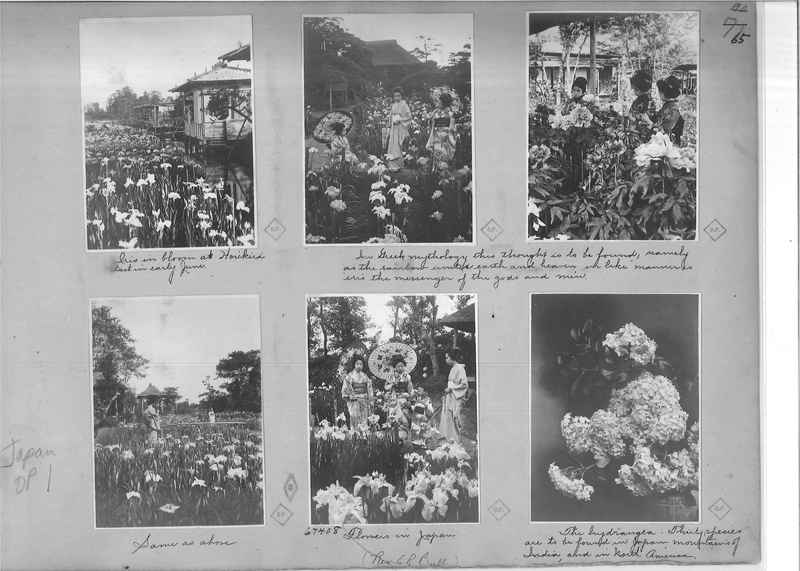
JapOP1-65:1 Iris in bloom at Horikiri. Best in early June.
JapOP1-65:2 In Greek mythology this thought is to be found, namely as the
rainbow unites earth and heaven, in like manner is iris the messenger of
the gods and men.
JapOP1-65:3 In Greek mythology this thought is to be found, namely as the
rainbow unites earth and heaven, in like manner is iris the messenger of
the gods and men.
JapOP1-65:4 Same as above.
67408 Flowers in Japan.
JapOP1-65:6 The hydrangea. Thirty species are to be found in Japan,
mountains of India, and in North America.
Mission Photograph Album - Japan - O.P. #01 Page 0067
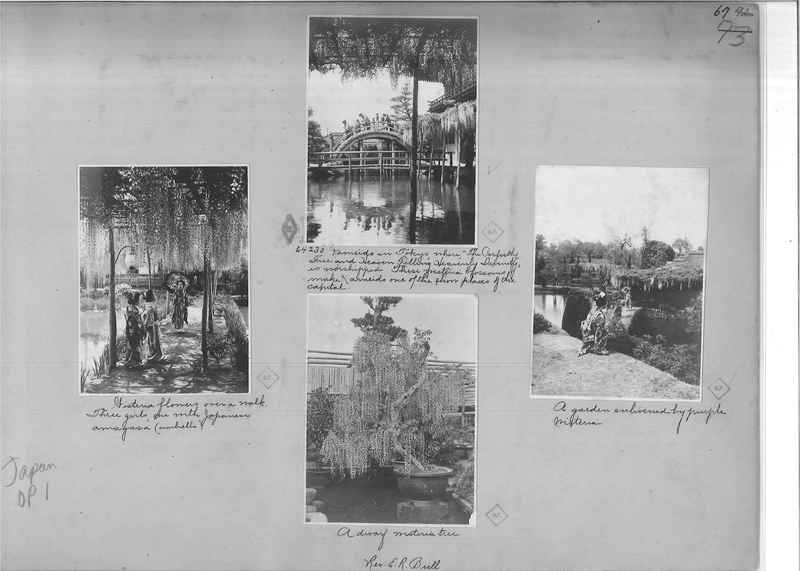
JapOP1-67:1 Wisteria flowers over a walk. Three girls, one with Japanese
amagasa (umbrella).
64230 Kameido in Tokyo, where, "The Perfectly Free and Heaven Filling
Heavenly Divinity," is worshipped. These wisteria blossoms make Kameido
one of the show places of the captital.
JapOP1-67:3 A garden enlivened by purple wisteria.
JapOP1-67:4 A dwarf wisteria tree.
Mission Photograph Album - Japan - O.P. #01 Page 0075
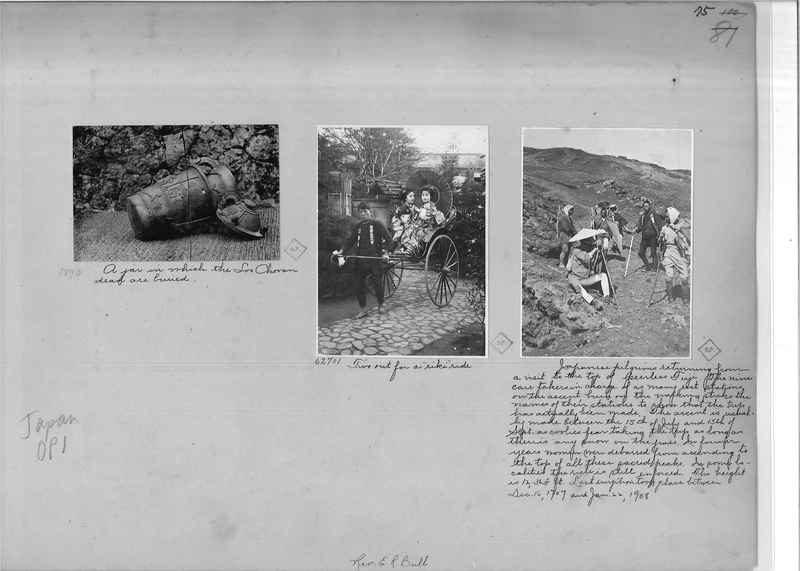
1870 A jar in which the Loo Chooan dead are buried.
62701 Two out for a "riki" ride.
JanOP1-75:3 Japanese pilgrim returning from a visit to the top of peerless
Fuji. The nine care takers in charge of as many rest stations on the
ascent, burn on the walking sticks the names of their stations to show that
the trip has actually been made. The ascent is usually made between the
15th of July and 15th of Sept. as c***s fear taking the trip as long as
there is any snow on the grass. In former years women were debarred from
ascending to the top of all these sacred peaks. In some localities the
rule is still enforced. The height is 12,365 ft. Last eruption took place
between Dec. 16, 1707 and Jan. 22, 1708.
Mission Photograph Album - Japan - O.P. #01 Page 0077
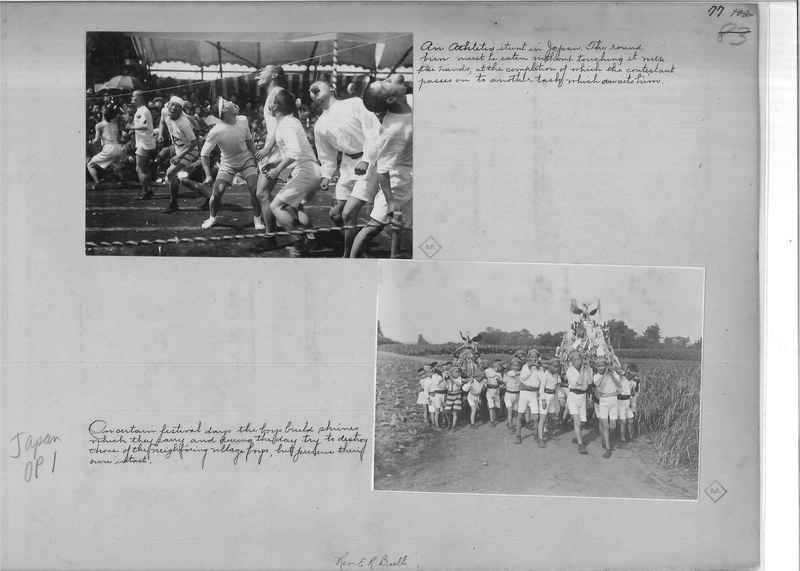
JanOP1-77:1 An athletic stunt in Japan. The round bun must be eaten
without touching it with the hands, at the completion of which the
contestant passes on to another task which awaits him.
JanOP1-77:2 On certain festival days the boys build shrines which they
carry and during the day try to destroy those of the neighboring village
boys, but preserve their own intact.
Mission Photograph Album - Japan - O.P. #01 Page 0080
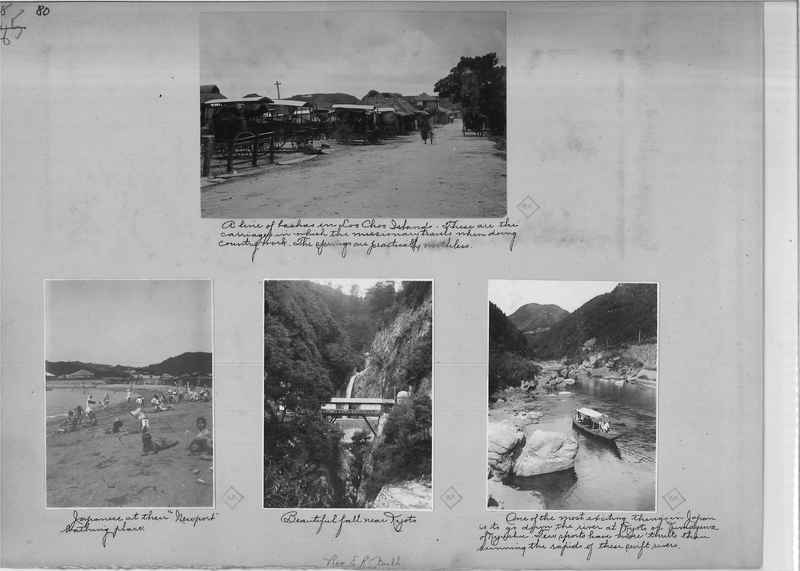
JanOP1-80:1 A line of bashas in Loo Choo Islands. These are the carriages
in which the missionary travels when doing country work. The springs are
practically worthless.
JanOP1-80:2 Japanese at their "Newport" bathing place.
JanOP1-80:3 Beautiful fall near Kyoto.
JanOP1-80:4 One of the most exciting things in Japan is to go down the
river at Kyoto or Kumagawa of Kyushu. Few sports have more thrills than
running the rapids of these swift river.
Mission Photograph Album - Japan - O.P. #01 Page 0084
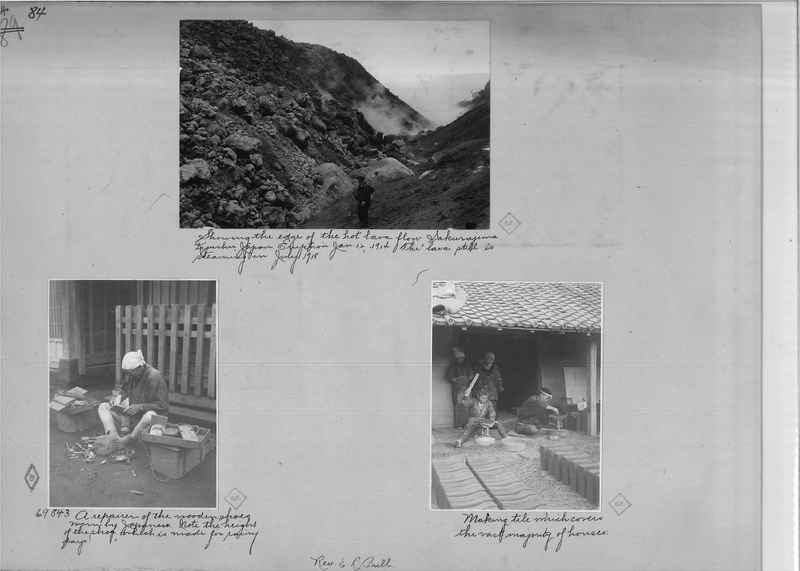
JanOP1-84:1 Showing the edge of the hot lava flow, Sakurajima Kyushu,
Japan. Eruption Jan. 12, 1914. The lava still is steaming in July 1918.
69543 A repair of the wooden shoes worn by Japanese. Note the height of
the shoe, which is made for raining days.
JanOP1-84:3 Making tile which covers the vast majority of houses.
Mission Photograph Album - Japan - O.P. #01 Page 0088
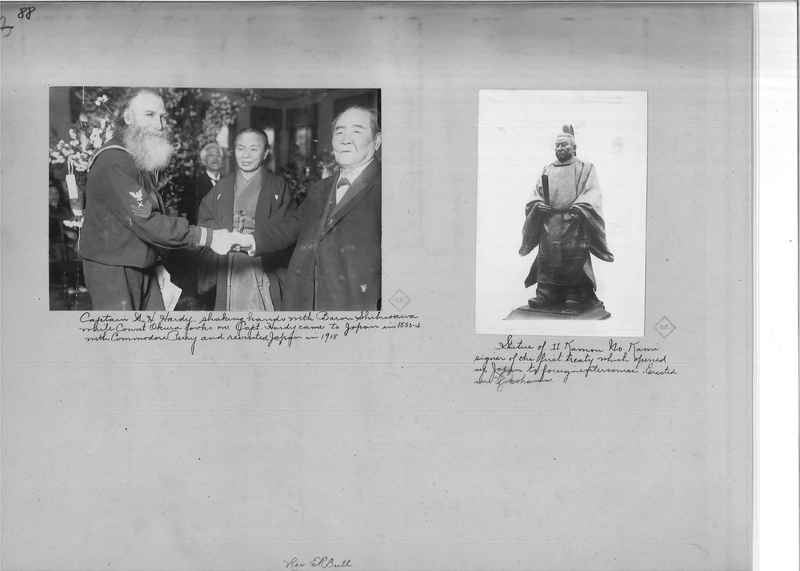
JanOP1-88:1 Captain W.H. Hardy shaking hands with Baron Shibusawa while
Count Okura looks on. Capt. Hardy came to Japan in 1853-4 with Commodore
Perry and revisited Japan in 1918.
JanOP1-88:2 Statue of Il Kamon No Kami, signer of the first treaty which
opened up Japan to foreign intercourse. Erected in Yokohama.
Mission Photograph Album - Japan - O.P. #01 Page 0095
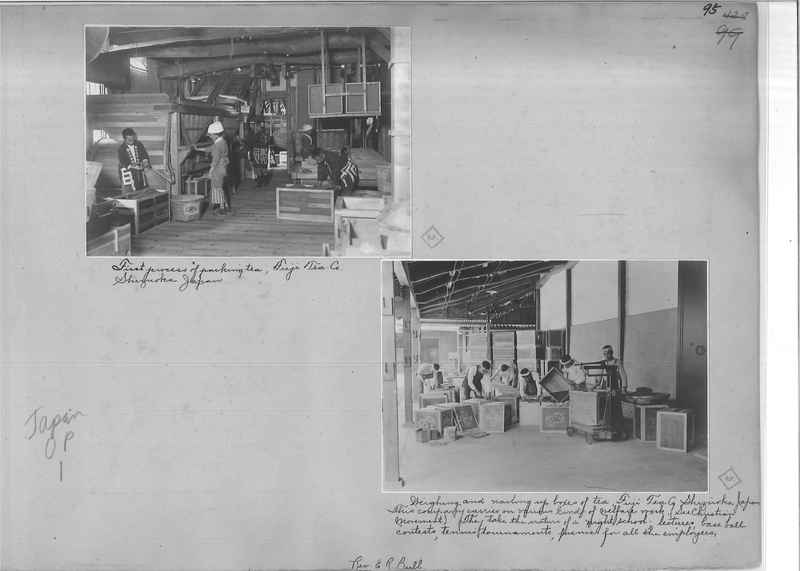
JanOP1-95:1 First process of packing tea, Fuji Tea Co., Shizuoka, Japan.
JanOP1-95:2 Weighing and nailing up boxes of tea, Fuji Tea Co., Shizuoka,
Japan. This company carries on various kind of welfare work. (See
Christian Movement) They take the nature of a night school, lectures base
ball contests, tennis tournaments, picnics for all the employees.
Mission Photograph Album - Japan - O.P. #01 Page 0102
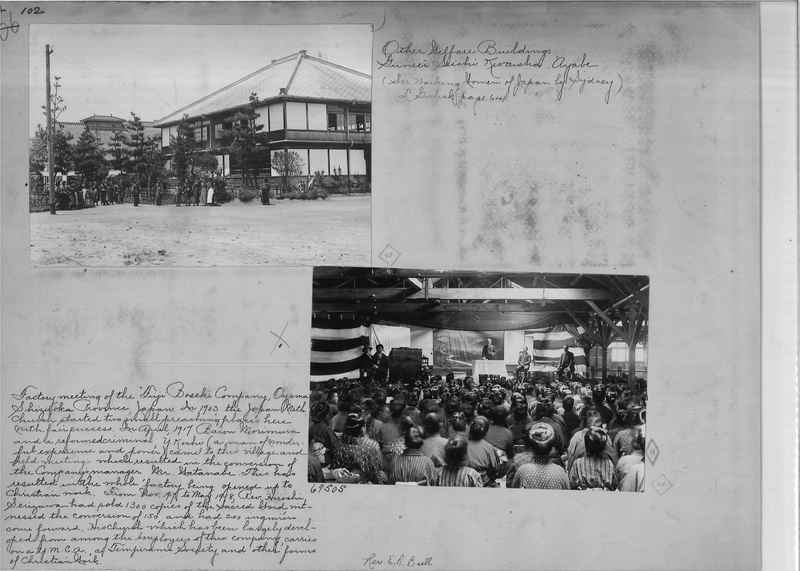
JanOP1-102:1 Other welfare buildings, Gunsei Seishi Kwaisha, Ayabe.
69505 Factory meeting of the Fuji Boseki Company, Oyama Shizuoka Province, Japan. In 1903, the Japan Meth. Church started two small preaching places here with fair success. In April, 1917 Baron Morimura and a reformed criminal, Y. Kochi (a man of wonderful experience and power) came to this village and held meetings which resulted in the conversion of the Company's
manager Mr. Watanabe. This has resulted in the whole factory being opened up to Christian work. From Nov. 1917 to May 1918, Rev. Hiroshi Serizawa had sold 1,300 copies of the Sacred Word, witnessed the conversion of 150, and had 200 inquirers come forward. His church which has been largely developed from among the employees of this company, carries on a Y.M.C.A.,
a Temperance Society and other forms of Christian Work.
69505 Factory meeting of the Fuji Boseki Company, Oyama Shizuoka Province, Japan. In 1903, the Japan Meth. Church started two small preaching places here with fair success. In April, 1917 Baron Morimura and a reformed criminal, Y. Kochi (a man of wonderful experience and power) came to this village and held meetings which resulted in the conversion of the Company's
manager Mr. Watanabe. This has resulted in the whole factory being opened up to Christian work. From Nov. 1917 to May 1918, Rev. Hiroshi Serizawa had sold 1,300 copies of the Sacred Word, witnessed the conversion of 150, and had 200 inquirers come forward. His church which has been largely developed from among the employees of this company, carries on a Y.M.C.A.,
a Temperance Society and other forms of Christian Work.
Mission Photograph Album - Japan - O.P. #01 Page 0103
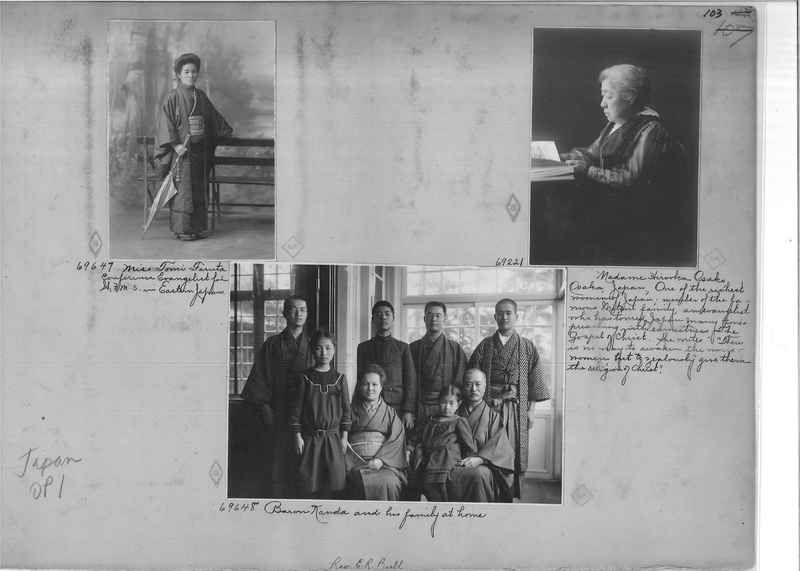
69647 Miss Tomi Faruta, Conference Evangelist for Women's Foreign Missionary Society in Eastern
Japan.
69221 Madame Hirooka Osako, Osaka, Japan. One of the richest women of
Japan; member of the famous Mitsui family, an evangelist who has toured
Japan many times preaching with earnestness the Gospel of Christ. She
writes, "There is no way to awaken the world of women, but to zealously
give them the religion of Christ."
69648 Baron Kanda and his family at home.
Mission Photograph Album - Japan - O.P. #01 Page 0104
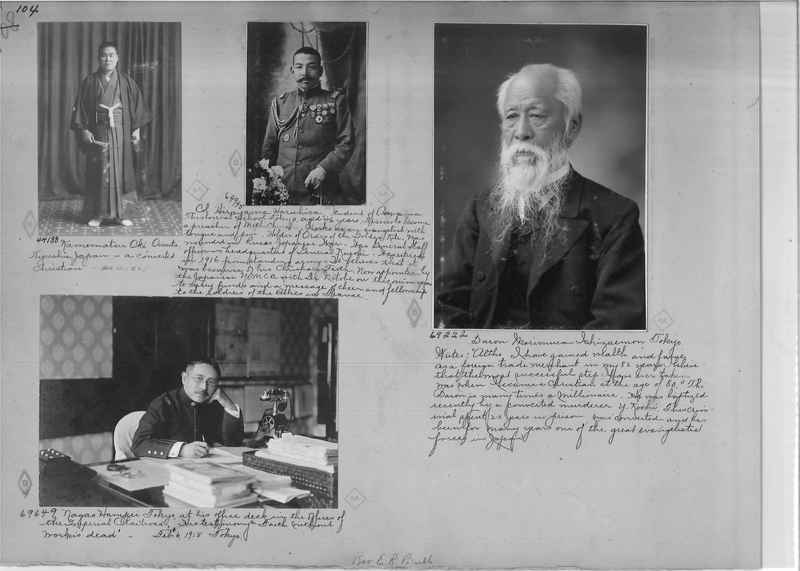
44133 Kamematsu Oki Omuta, Kyushu, Japan - a converted Christain.
64945 Col. Hirayama Haruhisa, Student of Aoyama Theological School, Tokyo,
aged 46 years. Desires to become a preacher of Meth. Church. Works as an
evangelist with tongue and pen. Holder of Order of the Golden Kite was
wounded in Russo-Japanes War. Was General Staff Officer in headquarters of
General Kuroki. Was retired in 1916 from standing army. He believes that
it was because of his Christian Faith. Now appointed by the Japanese
Y.M.C.A. with Dr. Nitobe on the commission to carry funds and a message of
cheer and fellowship to the soldiers of the Allies in France.
69222 Baron Morimura Ichizaemon, Tokyo. Writes, "Altho I have gained
wealth and fame as a foreign trade merchant in my 82 years, I believe that
the most successful step I have ever taken was when I became Christian at
the age of 80." The Baron in many times a millionaire. He was baptized
recently by a convered murderer Y. Kochi. This criminal spent 23 years in
prison, was converted and has been for many years one of the great
evangelistic forces in Japan.
69649 Nagao Hampei, Tokyo, at his office desk in the offices of the
Imperial Railroad. His testimony; "Faith without works is dead." - Feb. 6,
1918, Tokyo.
Mission Photograph Album - Japan - O.P. #01 Page 0105
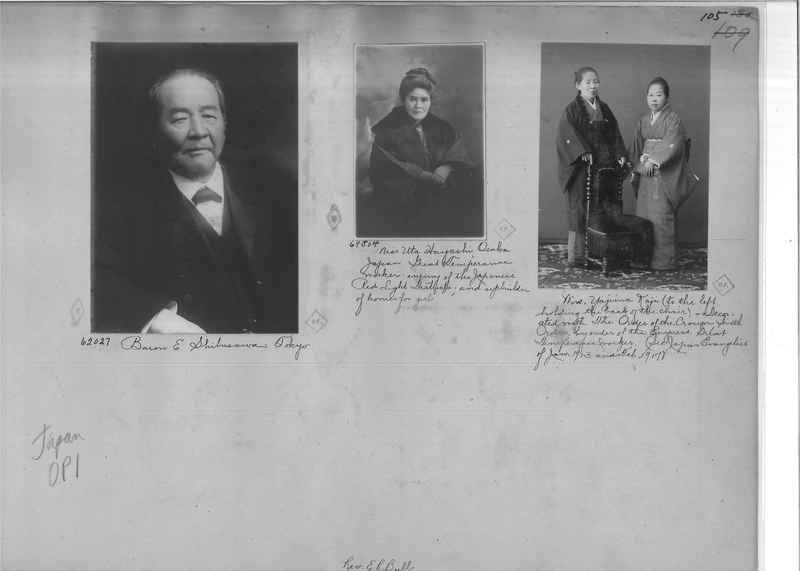
62027 Baron E. Shibusawa, Tokyo.
69504 Miss Uta Hayashi, Osaka, Japan. Great Temperance worker, enemy of
the Japanese Red Light Districts; and upbuilder of homes for girls.
JanOP1-105:3 Mrs. Yajima Kaji (to the left holding the back of the chair) -
Decorated with the Order of the Crown, Sixth Order, by order of the
Empress. Great Temperance worker.
Mission Photograph Album - Japan - O.P. #01 Page 0106
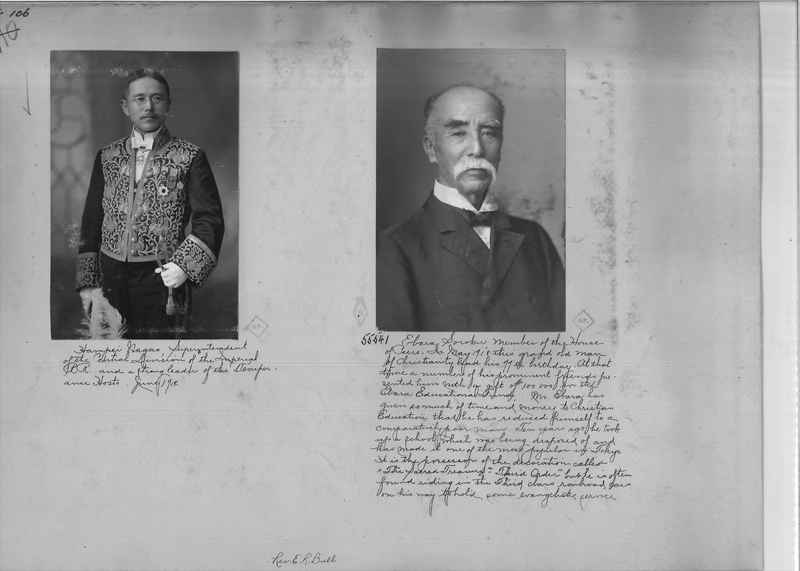
JanOP1-106:1 Hampei Nagao, Superintendent of the Central Division of the
Imperial R.R. and a strong leader of the Temperance Hosts. June 1918.
55541 Ebara Soroku, member of the House of Peers. In May 1918 this grand
old man of Christianity had his 77th birthday. At that time a number of
his prominent friends presented him with a gift of $100,000 for the Ebara
Educational Fund. Mr. Ebara has given so much of time and money to
Christian Education that he has reduced himself to a comparatively poor
man. Ten years ago he took up a school which was being disposed of and has
made it one of the most popular in Tokyo. He is the possession of the
decoration called " The Sacred Treasure: Third Order" but he is often found
riding in the third class railroad cars on his way to hold some
evangelistic service.
Mission Photograph Album - Japan - O.P. #01 Page 0107
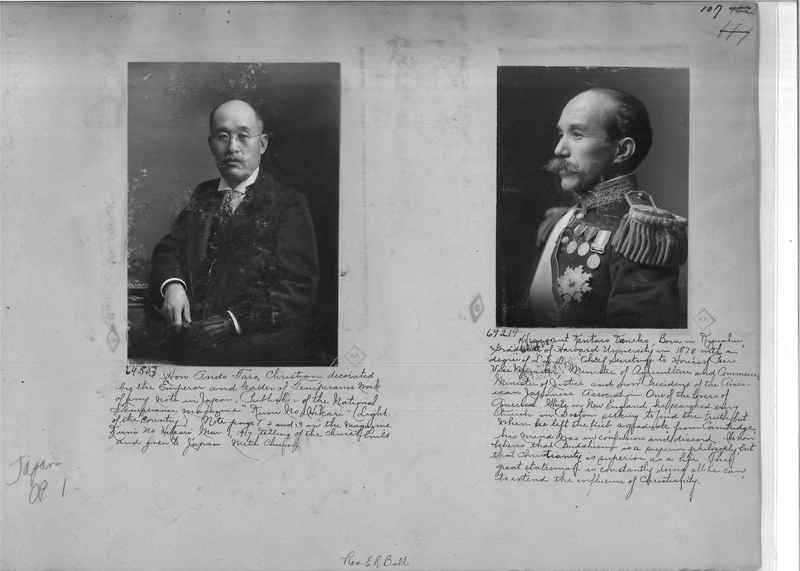
69503 Hon. Ando Taro, Christian, decorated by the Emperor and leader of
Temperance Work of any note in Japan. Publisher of the National Temperance
Magazine "Kuni No Hikari" (Light of the Country). Note page 1, 2, and 3 in
the magazine Kuni No Hikari, Mar. 1, 1917, telling of the church built and
given to Japan Meth. Church.
69219 Vioscount Kentaro Kaneko, born in Kyushu, graduate of Harvard
University in 1878, with a degree of L.L.D. Chief Secretary to House of
Peers, Vice Minister, Minister of Agriculture and Commerce, Minister of
Justice and now President of the American Japanese Association. One of the
lovers of America. While in New England he searched every church in Boston
seeking to find the truth but when he left the hub, a graduate from
Cambridge, his mind was in confusion and discord. He now believes that
Buddhism is a superior philosophy but that Christianity is superior as a
life. This great statesman is constantly doing all he can, to extent the
influence of Christianity.
Mission Photograph Album - Japan - O.P. #01 Page 0108
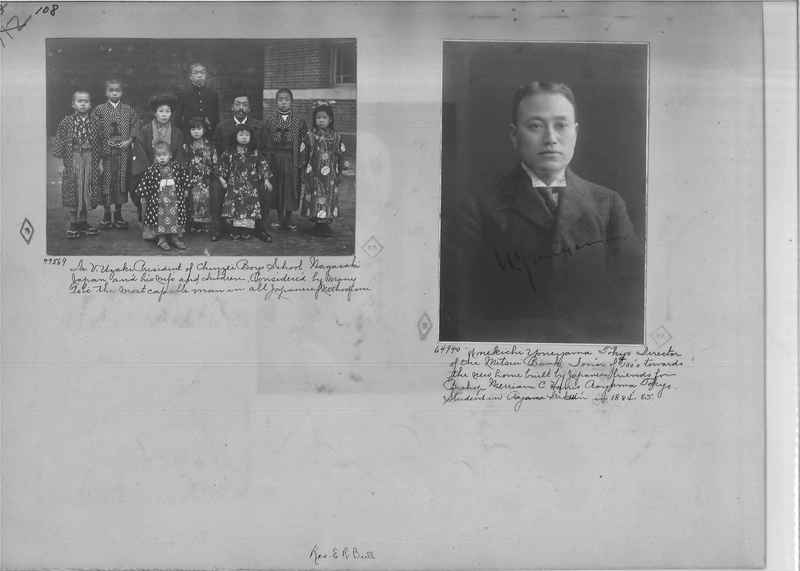
77569 Dr. V. Uzaki, President of Chinzei Boys School, Nagasaki, Japan and
his wife and children. Considered by Many to be the most capable man in
all Japanese Methodism.
64940 Umikichi Yoneyama, Tokyo Director of the Mitsui Bank. Donor of
$1,000 towards the new home built by Japanese friends for Bishop Merriam C.
Harris, Aoyama, Tokyo. Student in Aoyama Gakuin in 1884-85.
Mission Photograph Album - Japan - O.P. #01 Page 0109
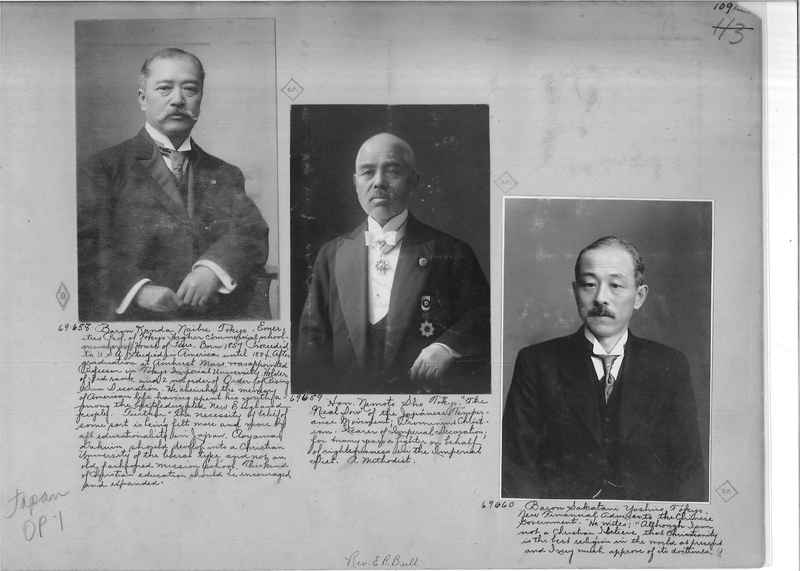
69658 Baron Kanda Naibu, Tokyo. Emeritus Prof. of Tokyo Higher Commercial
School, member of House of Peers. Born in 1857. Proceeded to U.S.A.
Studied in America until 1884. After graduation at Amherst Mass. was
appointed Professor in Tokyo Imperial University. Holder of 3rd rank and
2nd order of Order of Rising Sun Decoration. He cherishes the memory of
American life having spent his youth among the best of educated New England
people. Further, "The necessity of belief of some sort is being felt more
and more by all educationalists in Japan. Aoyama Gakuin should develop
into a Christian University of the liberal type, and not an old fashioned
mission school. This kind of Christian education should be encouraged and
expanded."
69659 Hon. Nemoto Sho, Tokyo. "The Neal Dow" of the Japanese Temperance
Movement; Prominent Christian. Wearer of Imperial Decoration; for many
years a fighter on behalf of righteousness in the Imperial Diet. A
Methodist.
69660 Baron Sakatani Yoshiro, Tokyo. New Financial Adviser to the Chinese
Government. He writes:"Although I am not a Christian, I believe that
Christianity is the best religion in the world at present and I very much
approve of its doctrines."
Mission Photograph Album - Japan - O.P. #01 Page 0110
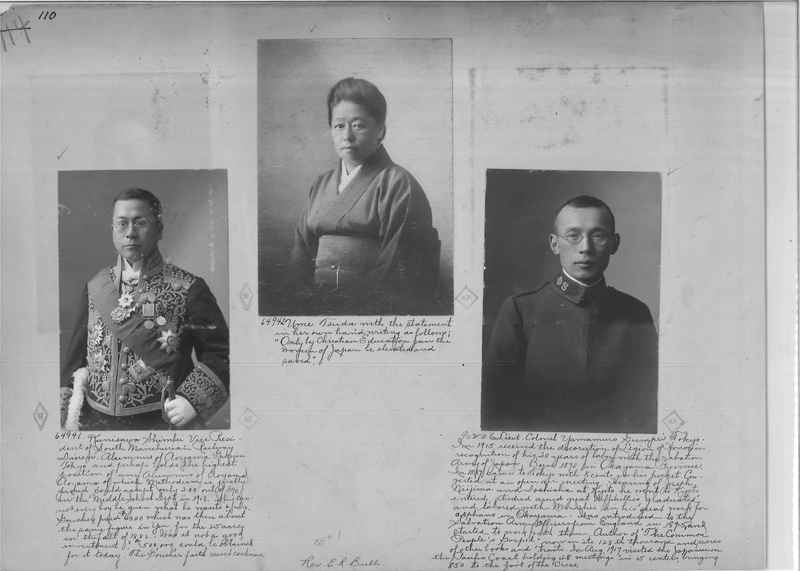
64941 Kunisawa Shimbei, Vice President of South Manchurian Railway,Dairen. Alumnus of Aoyama Gakuin, Tokyo, and perhaps holds the highest positon of any Alumnus of Aoyama. Aoyama, of which Methodism is justly proud, could accept only 200 out of 390 in the MIddle School Dept. in 1918. Why cannot every boy be given what he wants? Dr. Goucher paid $6,000 which was then about the same figure in Yen, for the 25 acres in the fall of 1882. Was it not a good investment? $500,000 could be obtained for it today. The Goucher faith much continue.
64942 Ume Tsuda with the statement in her own hand writing as follows;"Only by Christian Education can the women of Japan be elevated and saved."
90206 Liet. Colonel Yamamuro Gumpei, Tokyo. In 1915 received the decoration of Legion of Honor in recognition of his 20 years of labor with the Salvation Army of Japan. Born in 1872 in Okayama Province. In 1887 came to Tokyo with 8 cents in his pocket. Converted at an open air meeting. Hearing of Joseph Niijima and Doshisha at Kyoto, he went to Kyoto, entered, studied amid great difficulties, graduated and labored with Mr. Ishii in his great work for orphans in Okayama. Was introduced to the Salvation Army Officers from England in 1895, and started to work with them. Author of "The Common People's Gospel," now in its 128th thousand and scores of other books and tracks. In Aug. 1917 visited the Japanese on the Pacific Coast holding 48 meetings in 15 centers, bringing 850 to the foot of the Cross.
64942 Ume Tsuda with the statement in her own hand writing as follows;"Only by Christian Education can the women of Japan be elevated and saved."
90206 Liet. Colonel Yamamuro Gumpei, Tokyo. In 1915 received the decoration of Legion of Honor in recognition of his 20 years of labor with the Salvation Army of Japan. Born in 1872 in Okayama Province. In 1887 came to Tokyo with 8 cents in his pocket. Converted at an open air meeting. Hearing of Joseph Niijima and Doshisha at Kyoto, he went to Kyoto, entered, studied amid great difficulties, graduated and labored with Mr. Ishii in his great work for orphans in Okayama. Was introduced to the Salvation Army Officers from England in 1895, and started to work with them. Author of "The Common People's Gospel," now in its 128th thousand and scores of other books and tracks. In Aug. 1917 visited the Japanese on the Pacific Coast holding 48 meetings in 15 centers, bringing 850 to the foot of the Cross.
Mission Photograph Album - Japan - O.P. #01 Page 0111
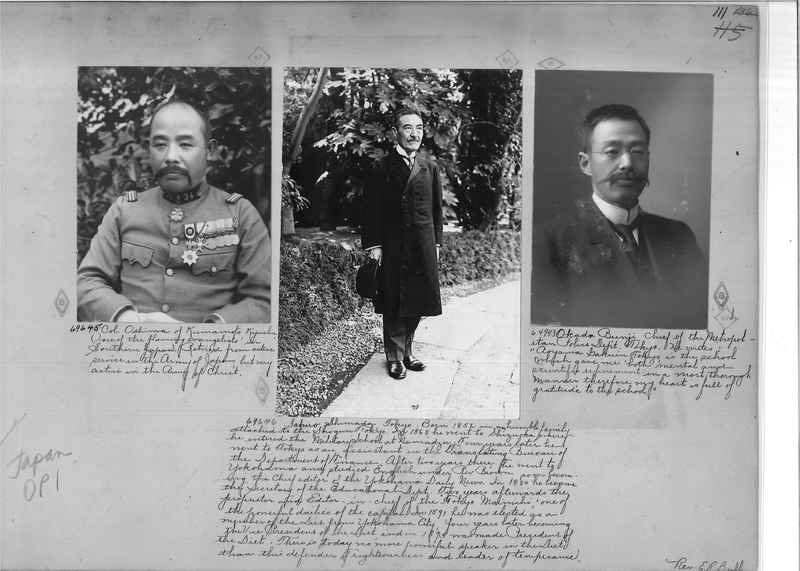
69645 Col. Oshima of Kumamoto, Kyushu. One of the flaming evangelists in
Southern Japan. Retired from active service in the Army of Japan, but very
active in the Army of Christ.
69646 Saburo Shimada, Tokyo. Born 1852 in a humble family attached to the
Shogun, Tokyo. In 1868 he went to Shizuoka where he entered the Military
School at Numanzu. Four years later he went to Tokyo as an assisstant in
the Translating Bureau of the Department of Finance. After two years
there, he went to Yokohama and studied English under Rev. Brown soon
becoming the Chief editor of the Yokohama Daily News. In 1880 he became
the Secretary of the Educational Dept. Two years afterwards the proprietor
and Editor-in-chief of the Tokyo Mainichi, one of the powerful dailies of
the capital. In 1891 he was elected as a member of the Diet from Yokohama
City, four years later becoming the Vice President of the Diet, and in 1895
was mede President of the Diet. There is today no more powreful speaker in
the Diet than this defender of righteousness and leader of Temperance.
64943 Okada Bunji, Chief of the Metropolitan Police Dept., Tokyo. He
writes:"Aoyama Gakuin, Tokyo, is the school which gave me both mental and
scientific refinement in a most thorough manner therefore my heart is full
of gratitude to the school."
Mission Photograph Album - Japan - O.P. #01 Page 0112
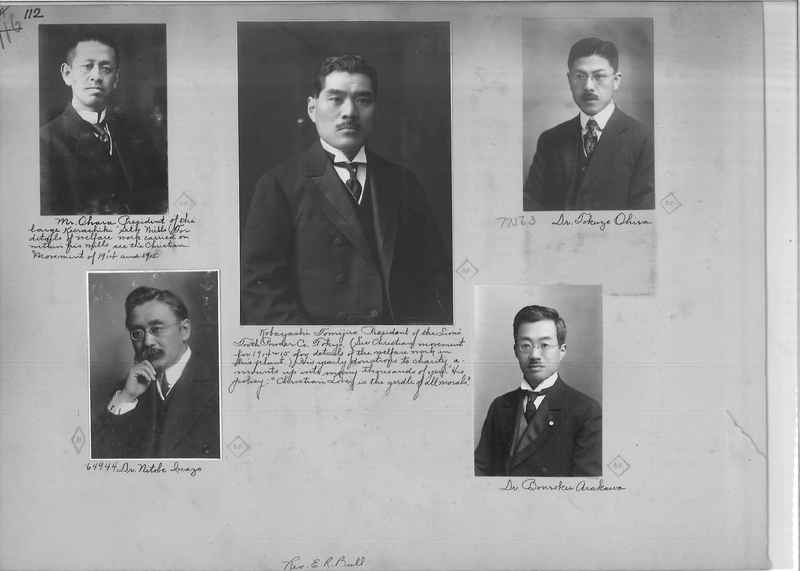
JanOP1-112:1 Mr. Ohara, President of the large Hurashiki Silk Mills. For
details of welfare work carried on within his mills, see the Christian
Movement of 1914 and 1915.
JanOP1-112:2 Kobayashi Tomijiro, President of the Lion's Tooth Powder Co.,
Tokyo. (See Christian mevement for 1914 and 15 for details of the welfare
work in his plant.) His yearly donations to charity, amounts up into many
thousands of Yen. His policy:"Christian Love is the girdle of all morals."
77563 Dr. Tokuzo Ohira.
64944 Dr. Nitobe Inazo.
JanOP1-112:5 Dr. Bonroku Arakawa.
Mission Photograph Album - Japan - O.P. #01 Page 0113
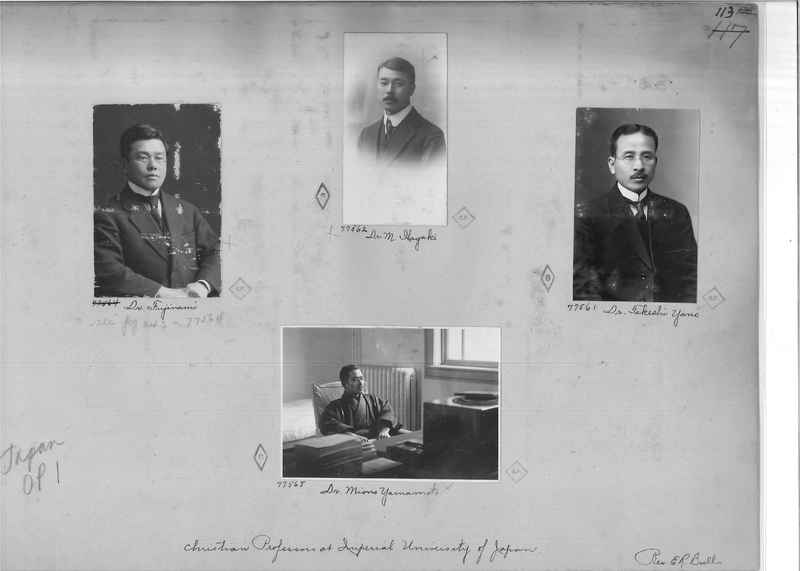
77564 Dr. Fujinami. Christian Professor at Imperial University of Japan.
77562 Dr. M. Itagaki. Christian Professor at Imperial University of Japan.
77561 Dr. Takeshi Yano. Christian Professor at Imperial University of
Japan.
77568 Dr. Miono Yamamoto. Christian Professor at Imperial University of
Japan.
